
Types of Sailboats: A Complete Guide

Last Updated by
Daniel Wade
June 15, 2022
Learning the different types of sailboats can help you identify vessels and choose the right boat.
In this article, we'll cover the most common kinds of sailboats, their origins, and what they're used for. We'll also go over the strengths and weaknesses of each design, along with when they're most useful.
The most common kind of sailboat is the sloop, as it's simple to operate and versatile. Other common sailboat types include the schooner, cutter, cat, ketch, schooner, catamaran, and trimaran. Other sailboat variations include pocket cruisers, motorsailers, displacement, and shoal-draft vessels.
The information found in this article is sourced from boat reference guides, including A Field Guide to Sailboats of North America by Richard M. Sherwood and trusted sources in the sailing community.
Table of contents

Distinguishing Types of Sailboats
In this article, we'll distinguish sailboats by traits such as their hull type, rig, and general configuration. Some sailboats share multiple characteristics with other boats but fall into a completely different category. For example, a sailboat with a Bermuda rig, a large engine, and a pilothouse could technically be called a sloop, but it's more likely a motorsailer.
When discerning sailboat type, the first most obvious place to look is the hull. If it has only one hull, you can immediately eliminate the trimaran and the catamaran. If it has two or more hulls, it's certainly not a typical monohull vessel.
The next trait to consider is the rig. You can tell a lot about a sailboat based on its rig, including what it's designed to be used for. For example, a long and slender sailboat with a tall triangular rig is likely designed for speed or racing, whereas a wide vessel with a complex gaff rig is probably built for offshore cruising.
Other factors that determine boat type include hull shape, overall length, cabin size, sail plan, and displacement. Hull material also plays a role, but every major type of sailboat has been built in both wood and fiberglass at some point.
Sailboat vs. Motorsailer
Most sailboats have motors, but most motorized sailboats are not motorsailers. A motorsailer is a specific kind of sailboat designed to run efficiently under sail and power, and sometimes both.
Most sailboats have an auxiliary engine, though these power plants are designed primarily for maneuvering. These vessels cannot achieve reasonable speed or fuel-efficiency. Motorsailers can operate like a powerboat.
Motorsailers provide great flexibility on short runs. They're great family boats, and they're popular in coastal communities with heavy boat traffic. However, these features come at a cost. Motorsailers aren't the fastest or most efficient powerboats, and they're also not the most agile sailboats. That said, they make an excellent general-purpose sailing craft.
Monohull vs. Multi-hull: Which is Better?
Multihull sailboats are increasingly popular, thanks to advances and lightweight materials, and sailboat design. But are they better than traditional sailboats? Monohulls are easier to maintain and less expensive, and they offer better interior layouts. Multihulls are more stable and comfortable, and they're significantly easier to control. Multihull sailboats also have a speed advantage.
Monohull Sailboats
A monohull sailboat is a traditionally-shaped vessel with a single hull. The vast majority of consumer sailboats are monohulls, as they're inexpensive to produce and easy to handle. Monohull sailboats are proven and easy to maintain, though they lack the initial stability and motion comfort of multi-hull vessels.
Monohull sailboats have a much greater rig variety than multi-hull sailboats. The vast majority of multihull sailboats have a single mast, whereas multi-masted vessels such as yawls and schooners are always monohulls. Some multi-hull sailboats have side-by-side masts, but these are the exception.
Catamaran Sailboats
The second most common sailboat configuration is the catamaran. A catamaran is a multihull sailboat that has two symmetrical hulls placed side-by-side and connected with a deck. This basic design has been used for hundreds of years, and it experienced a big resurgence in the fiberglass boat era.
Catamarans are fast, efficient, and comfortable. They don't heel very much, as this design has excellent initial stability. The primary drawback of the catamaran is below decks. The cabin of a catamaran is split between both hulls, which often leaves less space for the galley, head, and living areas.
Trimaran Sailboats
Trimarans are multi-hull sailboats similar to catamarans. Trimarans have three hulls arranged side-by-side. The profile of a trimaran is often indistinguishable from a catamaran.
Trimarans are increasingly popular, as they're faster than catamarans and monohulls and considerably easier to control. Trimarans suffer from the same spatial limitations as catamarans. The addition of an extra hull adds additional space, which is one reason why these multi-hull vessels are some of the best-selling sailboats on the market today.
Sailboat Rig Types
Rigging is another way to distinguish sailboat types. The rig of a sailboat refers to it's mast and sail configuration. Here are the most common types of sailboat rigs and what they're used for.
Sloops are the most common type of sailboat on the water today. A sloop is a simple single-mast rig that usually incorporates a tall triangular mainsail and headsail. The sloop rig is easy to control, fun to sail, and versatile. Sloops are common on racing sailboats as they can sail quite close to the wind. These maneuverable sailboats also have excellent windward performance.
The sloop rig is popular because it works well in almost any situation. That said, other more complex rigs offer finer control and superior performance for some hull types. Additionally, sloops spread their entire sail area over just to canvases, which is less flexible than multi-masted rigs. The sloop is ideal for general-purpose sailing, and it's proven itself inland and offshore.
Sloop Features:
- Most popular sailboat rig
- Single mast
- One mainsail and headsail
- Typically Bermuda-rigged
- Easy to handle
- Great windward performance
- Less precise control
- Easier to capsize
- Requires a tall mast
Suitable Uses:
- Offshore cruising
- Coastal cruising
Cat (Catboat)
The cat (or catboat) is a single-masted sailboat with a large, single mainsail. Catboats have a thick forward mast, no headsail, and an exceptionally long boom. These vessels are typically gaff-rigged, as this four-edged rig offers greater sail area with a shorter mast. Catboats were popular workboats in New England around the turn of the century, and they have a large following today.
Catboats are typically short and wide, which provides excellent stability in rough coastal conditions. They're hardy and seaworthy vessels, but they're slow and not ideal for offshore use. Catboats are simple and easy to control, as they only have a single gaff sail. Catboats are easy to spot thanks to their forward-mounted mast and enormous mainsail.
Catboat Features:
- Far forward-mounted single mast
- Large four-sided gaff sail
- Short and wide with a large cockpit
- Usually between 20 and 30 feet in length
- Excellent workboats
- Tough and useful design
- Great for fishing
- Large cockpit and cabin
- Not ideal for offshore sailing
- Single sail offers less precise control
- Slow compared to other rigs
- Inland cruising
At first glance, a cutter is difficult to distinguish from a sloop. Both vessels have a single mast located in roughly the same position, but the sail plan is dramatically different. The cutter uses two headsails and often incorporates a large spar that extends from the bow (called a bowsprit).
The additional headsail is called a staysail. A sloop only carries one headsail, which is typically a jib. Cutter headsails have a lower center of gravity which provides superior performance in rough weather. It's more difficult to capsize a cutter, and they offer more precise control than a sloop. Cutters have more complex rigging, which is a disadvantage for some people.
Cutter Features:
- Two headsails
- Long bowsprit
- Similar to sloop
- Gaff or Bermuda-rigged
- Fast and efficient
- Offers precise control
- Superior rough-weather performance
- More complex than the sloop rig
- Harder to handle than simpler rigs
Perhaps the most majestic type of sailboat rig, the schooner is a multi-masted vessel with plenty of history and rugged seaworthiness. The schooner is typically gaff-rigged with short masts and multiple sails. Schooners are fast and powerful vessels with a complex rig. These sailboats have excellent offshore handling characteristics.
Schooners have a minimum of two masts, but some have three or more. The aftermost large sail is the mainsail, and the nearly identical forward sail is called the foresail. Schooners can have one or more headsail, which includes a cutter-style staysail. Some schooners have an additional smaller sale aft of the mainsail called the mizzen.
Schooner Features:
- At least two masts
- Usually gaff-rigged
- One or more headsails
- Excellent offshore handling
- Precise control
- Numerous sail options (headsails, topsails, mizzen)
- Fast and powerful
- Complex and labor-intensive rig
- Difficult to adjust rig single-handed
- Offshore fishing
Picture a ketch as a sloop or a cutter with an extra mast behind the mainsail. These vessels are seaworthy, powerful, excellent for offshore cruising. A ketch is similar to a yawl, except its larger mizzen doesn't hang off the stern. The ketch is either gaff or Bermuda-rigged.
Ketch-rigged sailboats have smaller sails, and thus, shorter masts. This makes them more durable and controllable in rough weather. The mizzen can help the boat steer itself, which is advantageous on offshore voyages. A ketch is likely slower than a sloop or a cutter, which means you aren't likely to find one winning a race.
Ketch Features:
- Headsail (or headsails), mainsail, and mizzen
- Mizzen doesn't extend past the rudder post
- Good offshore handling
- Controllable and mild
- Shorter and stronger masts
- Easy self-steering
- Slower than sloops and cutters
- Less common on the used market
A dinghy is a general term for a small sailboat of fewer than 28 feet overall. Dinghys are often dual-power boats, which means they usually have oars or a small outboard in addition to a sail. These small boats are open-top and only suitable for cruising in protected waters. Many larger sailboats have a deployable dinghy on board to get to shore when at anchor.
Dinghy Features:
- One or two people maximum capacity
- Easy to sail
- Works with oars, sails, or an outboard
- Great auxiliary boat
- Small and exposed
- Not suitable for offshore use
- Going from anchor to shore
- Protected recreational sailing (lakes, rivers, and harbors)
Best Sailboat Type for Stability
Stability is a factor that varies widely between sailboat types. There are different types of stability, and some sailors prefer one over another. For initial stability, the trimaran wins with little contest. This is because these vessels have a very high beam-to-length ratio, which makes them much less prone to rolling. Next up is the catamaran, which enjoys the same benefit from a wide beam but lacks the additional support of a center hull section.
It's clear that in most conditions, multihull vessels have the greatest stability. But what about in rough weather? And what about capsizing? Multihull sailboats are impossible to right after a knockdown. This is where full-keel monohull sailboats excel.
Traditional vessels with deep displacement keels are the safest and most stable in rough weather. The shape, depth, and weight of their keels keep them from knocking over and rolling excessively. In many cases, these sailboats will suffer a dismasting long before a knockdown. The primary disadvantage of deep-keeled sailboats is their tendency to heel excessively. This characteristic isn't hazardous, though it can make novice sailors nervous and reduce cabin comfort while underway.
Best Sailboat Type for Offshore Cruising
The best sailboat type for offshore cruising is the schooner. These graceful aid robust vessels have proven themselves over centuries as durable and capable vessels. They typically use deep displacement keels, which makes them stable in rough weather and easy to keep on course.
That said, the full answer isn't quite so simple. Modern multihull designs are an attractive option, and they have also proven to be strong and safe designs. Multihull sailboats are an increasingly popular option for offshore sailors, and they offer comfort that was previously unknown in the sailing community.
Many sailors cross oceans in basic Bermuda-rigged monohulls and take full advantage of a fin-keel design speed. At the end of the day, the best offshore cruising sailboat is whatever you are comfortable handling and living aboard. There are physical limits to all sailboat designs, though almost any vessel can make it across an ocean if piloted by a competent skipper and crew.
Best Sailboat Type for Racing The modern lightweight Bermuda-rigged sailboat is the king of the regatta. When designed with the right kind of hull, these vessels are some of the fastest sailboats ever developed. Many boats constructed between the 1970s and today incorporate these design features due to their favorable coastal and inland handling characteristics. Even small sailboats, such as the Cal 20 and the Catalina 22, benefit from this design. These boats are renowned for their speed and handling characteristics.
Related Articles
I've personally had thousands of questions about sailing and sailboats over the years. As I learn and experience sailing, and the community, I share the answers that work and make sense to me, here on Life of Sailing.
by this author
Learn About Sailboats
Most Recent

What Does "Sailing By The Lee" Mean?
October 3, 2023

The Best Sailing Schools And Programs: Reviews & Ratings
September 26, 2023
Important Legal Info
Lifeofsailing.com is a participant in the Amazon Services LLC Associates Program, an affiliate advertising program designed to provide a means for sites to earn advertising fees by advertising and linking to Amazon. This site also participates in other affiliate programs and is compensated for referring traffic and business to these companies.
Similar Posts

Affordable Sailboats You Can Build at Home
September 13, 2023

Best Small Sailboat Ornaments
September 12, 2023

Discover the Magic of Hydrofoil Sailboats
December 11, 2023
Popular Posts

Best Liveaboard Catamaran Sailboats
December 28, 2023

Can a Novice Sail Around the World?
Elizabeth O'Malley

4 Best Electric Outboard Motors

How Long Did It Take The Vikings To Sail To England?

10 Best Sailboat Brands (And Why)
December 20, 2023

7 Best Places To Liveaboard A Sailboat
Get the best sailing content.
Top Rated Posts
Lifeofsailing.com is a participant in the Amazon Services LLC Associates Program, an affiliate advertising program designed to provide a means for sites to earn advertising fees by advertising and linking to Amazon. This site also participates in other affiliate programs and is compensated for referring traffic and business to these companies. (866) 342-SAIL
© 2024 Life of Sailing Email: [email protected] Address: 11816 Inwood Rd #3024 Dallas, TX 75244 Disclaimer Privacy Policy
- Types of Sailboats
- Parts of a Sailboat
- Cruising Boats
- Small Sailboats
- Design Basics
- Sailboats under 30'
- Sailboats 30'-35
- Sailboats 35'-40'
- Sailboats 40'-45'
- Sailboats 45'-50'
- Sailboats 50'-55'
- Sailboats over 55'
- Masts & Spars
- Knots, Bends & Hitches
- The 12v Energy Equation
- Electronics & Instrumentation
- Build Your Own Boat
- Buying a Used Boat
- Choosing Accessories
- Living on a Boat
- Cruising Offshore
- Sailing in the Caribbean
- Anchoring Skills
- Sailing Authors & Their Writings
- Mary's Journal
- Nautical Terms
- Cruising Sailboats for Sale
- List your Boat for Sale Here!
- Used Sailing Equipment for Sale
- Sell Your Unwanted Gear
- Sailing eBooks: Download them here!
- Your Sailboats
- Your Sailing Stories
- Your Fishing Stories
- Advertising
- What's New?
- Chartering a Sailboat
The Different Types of Sailboats
If you’re a sailboat fanatic like me, all types of sailboats will attract your attention. Some more so than others admittedly, but all will have something about them that catches your eye.
If you’re not a fanatic (not yet, that is) but just an interested observer, then the first thing you’ll notice about a sailboat will be how many masts it has and the configuration of its sails - in other words, its 'rig'.
This observation alone will enable you to identify the five main types of sailboats — sloops, cutters, ketches, yawls and schooners - all of which are described here.
But apart from the various rig types, you can describe types of sailboats from a different viewpoint - sailing dinghies, dayboats, motorsailors, monohulls, catamarans and trimarans.
Let's make a start with the various rig types...
A single-masted sailboat with just two sails — a foresail (aka headsail or jib) and a mainsail — is a sloop, the purest type of sailboat.
The sloop rig can also be described as a Bermuda rig, Bermudian rig or Marconi rig.
Read more about sloops...
Examples of Sloops
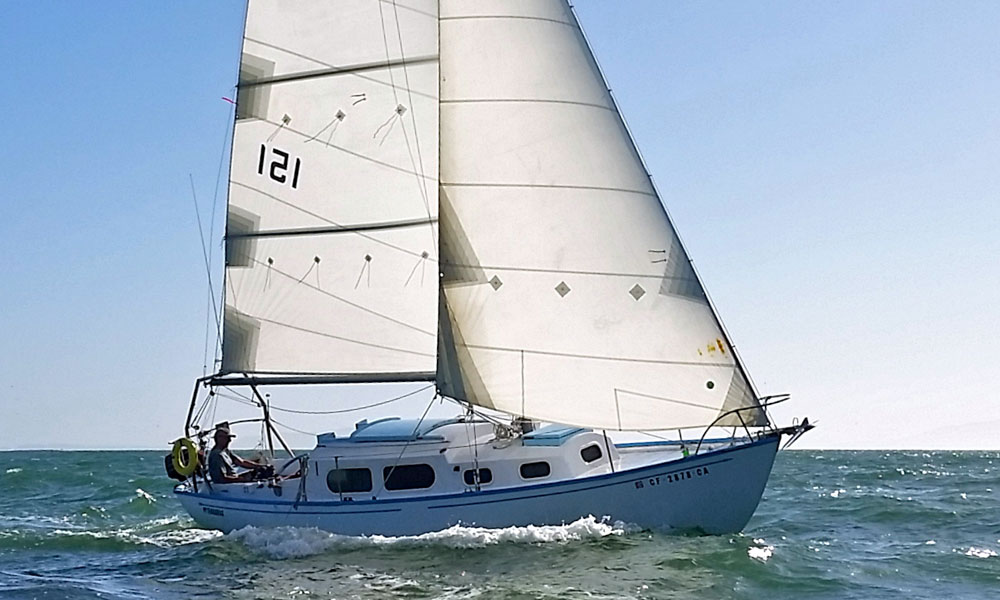
If a sloop has an additional sail between the headsail and the mainsail, then it's no longer a sloop - it's a cutter.
Some cutters - like the one shown here - have the foresail set forward on a bowsprit, with the inner forestay permanently rigged to the stemhead where the foresail otherwise would be, or to a central chainplate further aft on the foredeck.
Read more about cutters...
Examples of Cutters
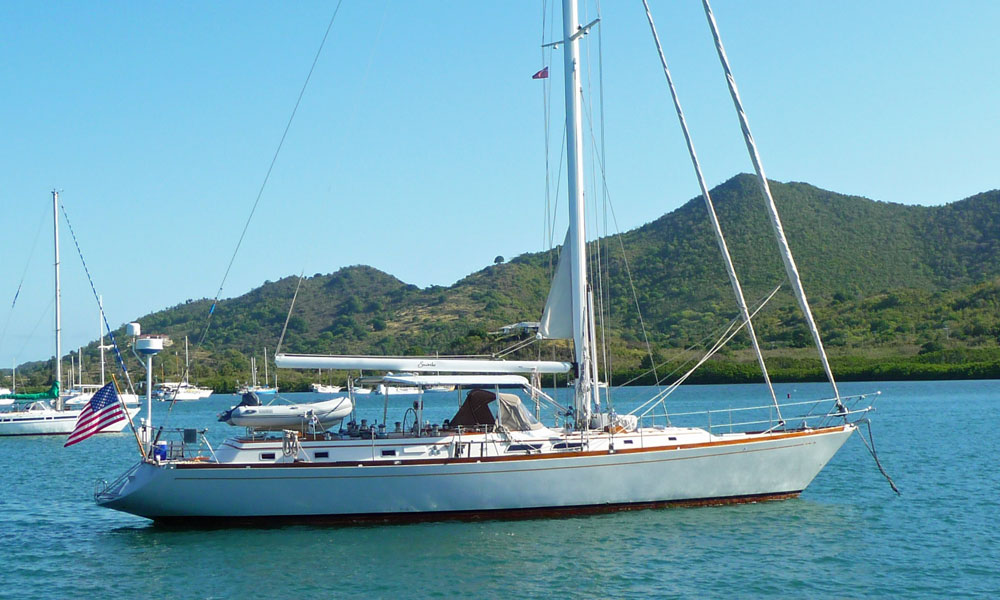
The following boats may look like cutters with their double headsails, but they're not cutters at all...
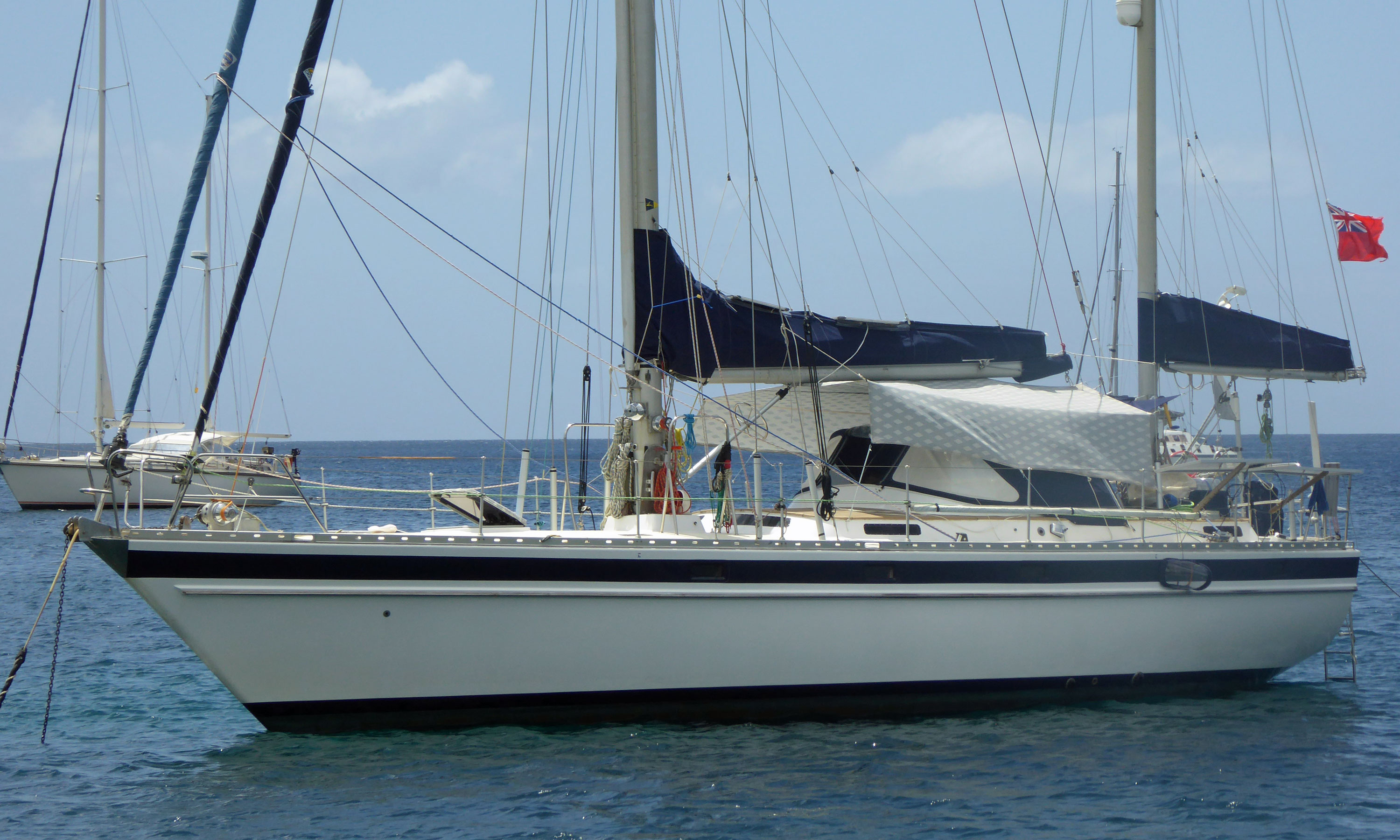
To find out why, click here...
A ketch is a two-masted sailboat, a main mast forward and a shorter mizzen mast aft.
But not all two-masted sailboats are ketches — they might be yawls (see below).
A ketch may also sport a staysail, with or without a bowsprit, in which case it would be known as a cutter-rigged or staysail ketch.
Read more about ketches...
Examples of Ketches
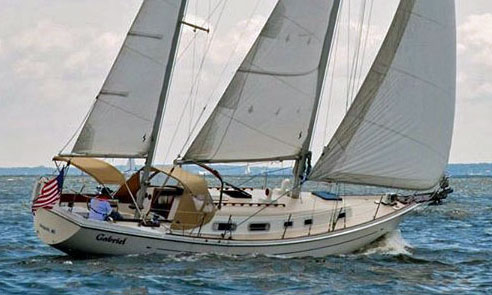
Note that the Ocean 71 and the Irwin 52 are cutter-rigged, and are traditionally referred to as Staysail Ketches .
Cat Ketches
Cat-ketches are recognised by the lack of any standing rigging to support their pair of unstayed masts.
And yes, if the after mast is taller than the foremast then it's called a cat- schooner sailboat.
Read more about cat-ketches...
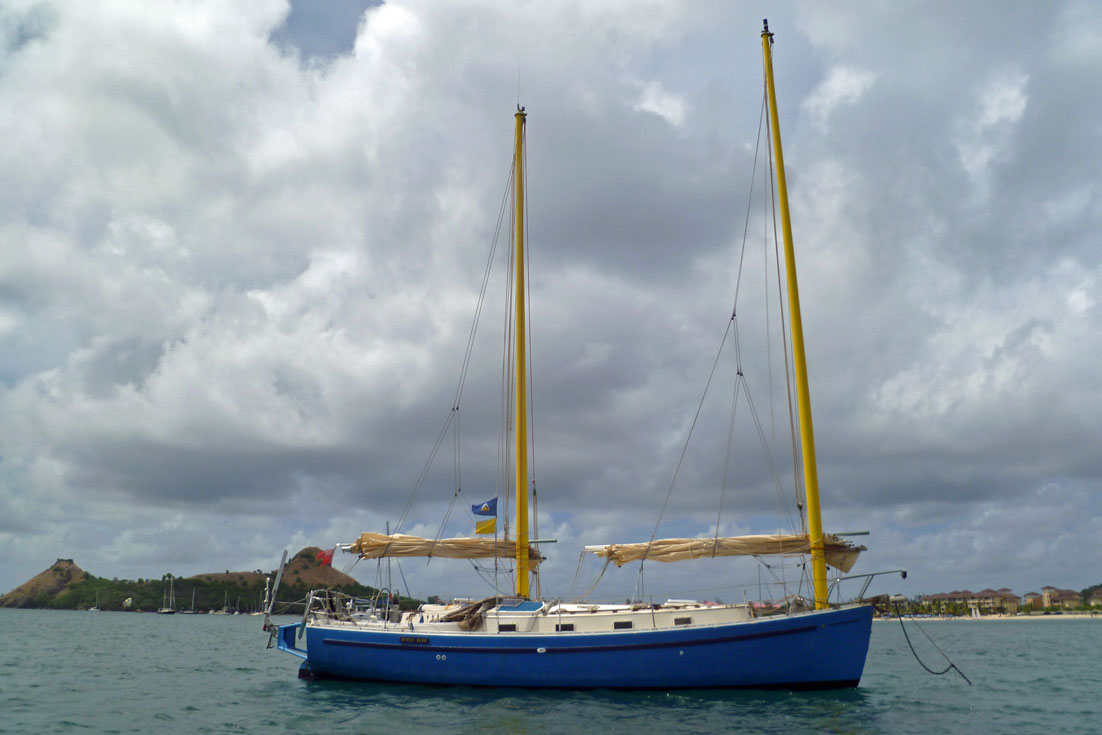
Yawls have their origins as old-time sail fishing boats, where the small mizzen sail was trimmed to keep the vessel steady when hauling the nets.
Much like a ketch, the difference being that the yawl has the mizzen mast positioned aft of the rudder post whereas the ketch has its mizzen mast ahead of the rudder post.
You’ll not be surprised to learn that a yawl with a staysail is known as cutter-rigged yawl.
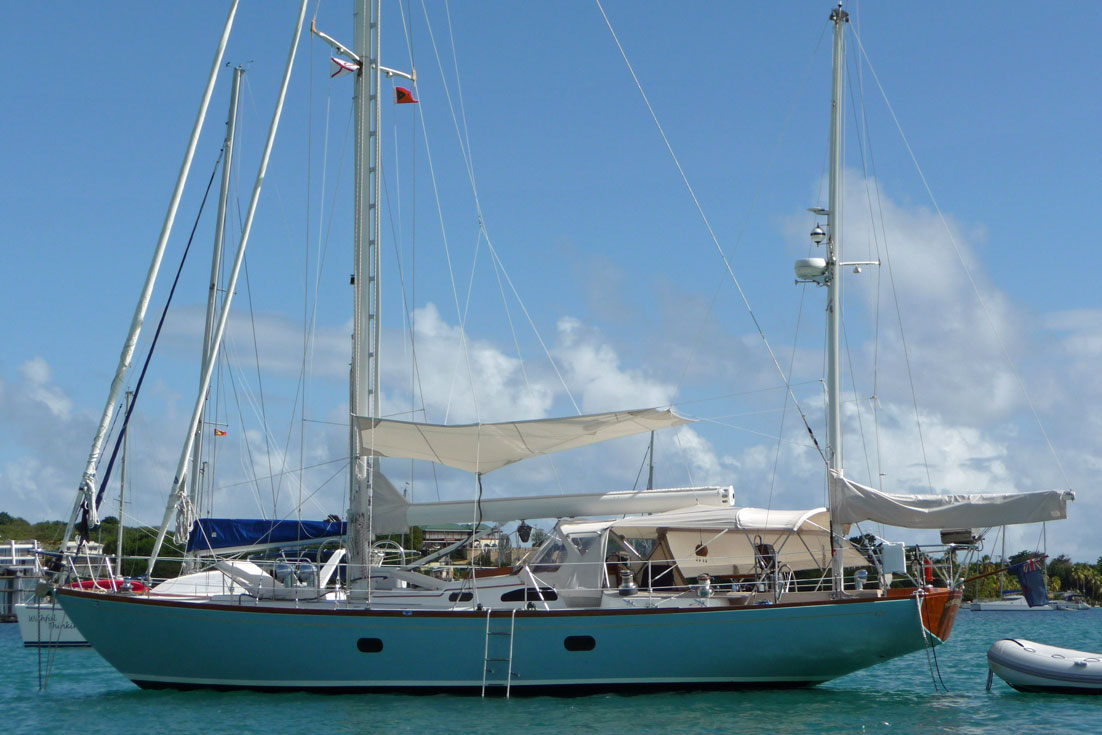
A schooner is a two-or-more masted sailboat, in which the aft-most mast - the mainmast - is the same height or taller than the foremast.
The one shown here is gaff cutter rigged, with a topsail set on the mainmast.
Many sailors agree that of all the different types of sailboats, a schooner under full sail is one of the most beautiful sights afloat.
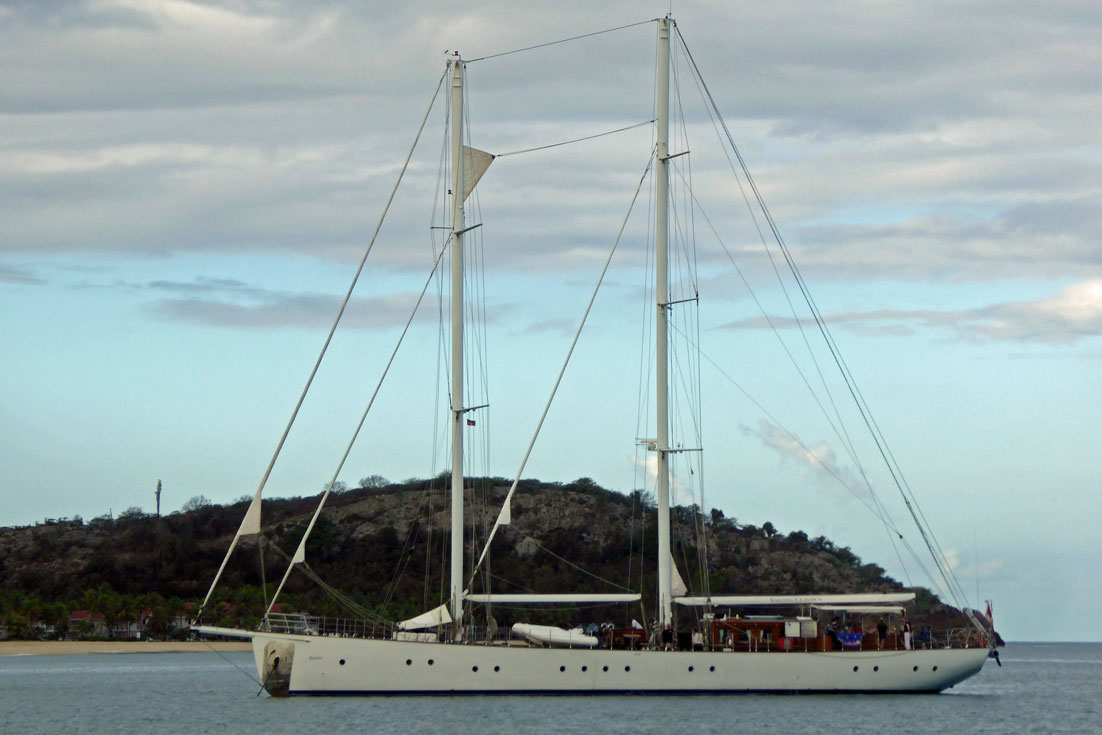
Gaffed-rigged sailboats, or 'gaffers', have their mainsail supported by a spar - the 'gaff' - which is hauled up mast by a separate halyard.
Often these types of sailboats are rigged with a topsail, as shown here and in the gaff schooner above, which really adds some grunt in light airs.
All this comes at a price of course, both in terms of material cost and weight aloft, which is why very few modern yachts are fitted with gaff rigs these days.
All artwork on this page is by Andrew Simpson
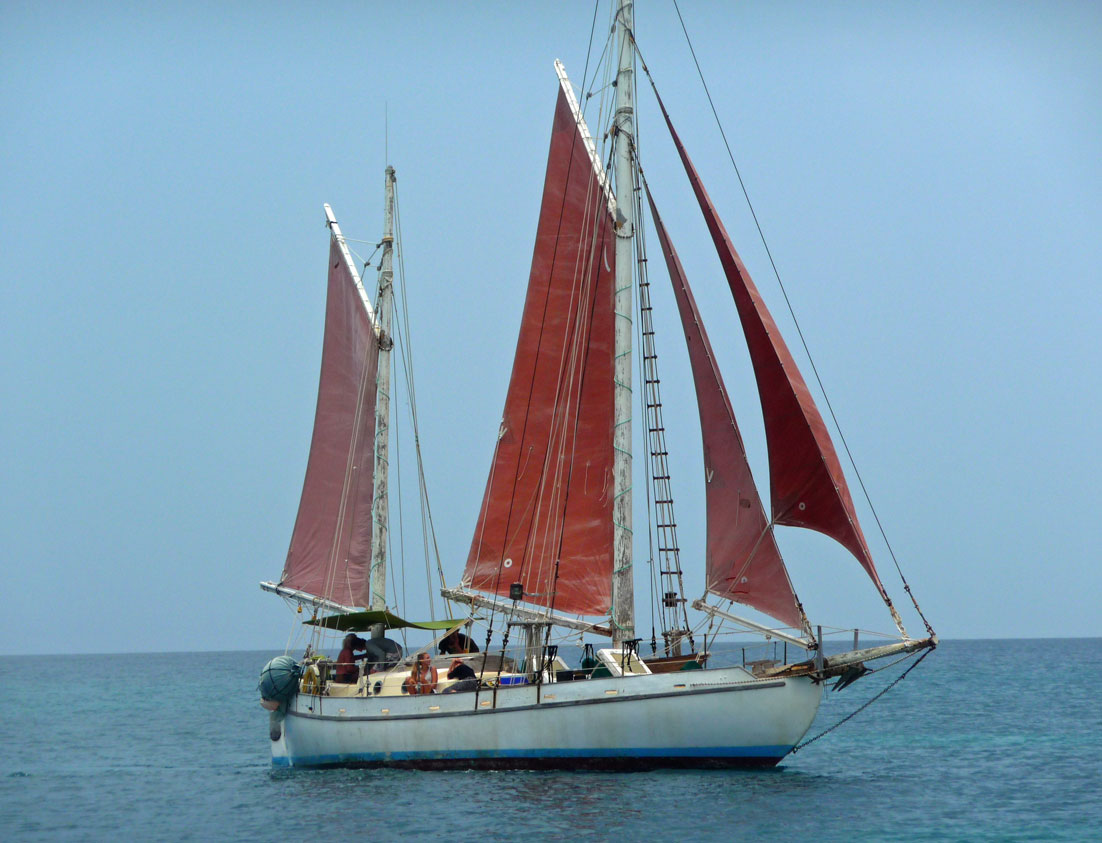
Examples of the Various Types of Sailboats...
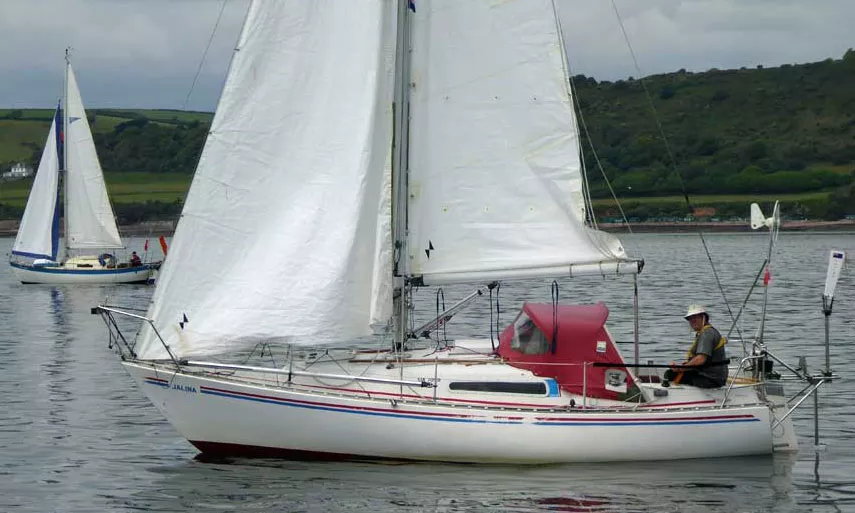
Other Types of Sailboats
The seven sailboat rig variations shown here are the most popular types of modern cruising boat rigs, but there are other rig versions which were once found on commercial, fishing, and naval sailing vessels.
They include:
- Full square-rigged sailing vessels
- Barkentines
- Brigantines
And you can see examples of them here ...
In this article I've said that ketches, yawls and schooners with two headsails can be called cutter rigged. This is a commonly used description but strictly speaking, there's only one rig that can accurately be called a cutter - and that's a single-masted sailboat with two headsails. My thanks to 'Old Salt' for drawing my attention to this!
Recent Articles
Westerly Discus 33 Sailboat Specs & Key Performance Indicators
Aug 28, 24 02:14 AM
Beneteau Oceanis 400 Specs & Key Performance Indicators
Aug 27, 24 05:09 AM
Grand Soleil 37 Sailboat Specs & Key Performance Indicators
Aug 27, 24 01:19 AM
Here's where to:
- Find Used Sailboats for Sale...
- Find Used Sailing Gear for Sale...
- List your Sailboat for Sale...
- List your Used Sailing Gear...
Our eBooks...

A few of our Most Popular Pages...

Copyright © 2024 Dick McClary Sailboat-Cruising.com
Types of Sailboats: Essential Guide for Every Sailor
Sailboats have been an essential part of human history, contributing to exploration, trade, and leisure. With a myriad of designs and sizes, these versatile vessels cater to various purposes and preferences. The defining characteristics of sailboats come from their rigging, sails, and hull design.
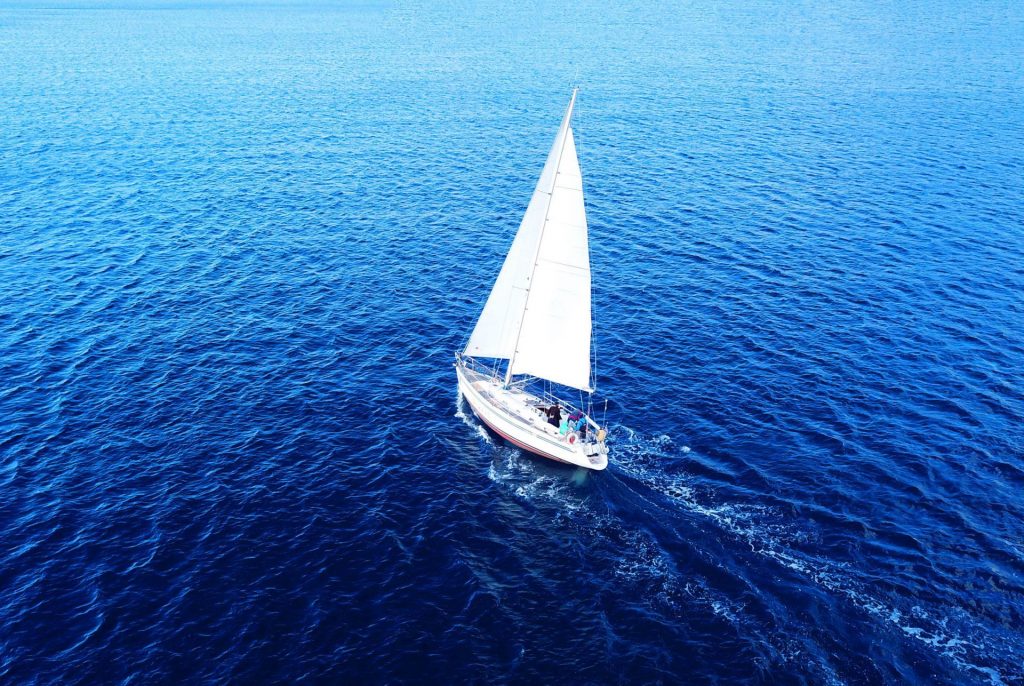
The basics of sailboat design play a significant role in the classification and function of these vessels. Hull shapes, keel types, and construction materials contribute to the speed, stability, and maneuverability of sailboats. Additionally, rigging and sails come in various shapes and sizes, which influence sailing performance and handling.
Key Takeaways
- Sailboats are classified by hull design, rigging, and sails that serve specific purposes.
- Designs and materials have a direct impact on the performance and handling of sailboats.
- A wide range of sailboat types exists, which cater to different needs and preferences.
Basics of Sailboat Design
Sailboats come in various shapes and sizes, designed for different purposes and sailing conditions. One can classify sailboats based on hull types, keel types, and mast configurations. This section will briefly discuss these basic components of sailboat design.
There are mainly two types of hulls: monohull and multihull.
- Monohull : This is the traditional and most common type of sailboat hull. It consists of a single hull, providing stability through the use of a keel or centerboard. Monohulls come in various shapes and sizes, suitable for various sailing conditions.
- Catamaran : Catamarans have two parallel hulls of equal size, offering increased stability and speed compared to monohulls. They are commonly used for cruising and racing.
- Trimaran : Trimarans have three hulls, with a larger central hull and two smaller outrigger hulls. This design offers even more stability and speed than catamarans.
The keel is an essential component in sailboat design, helping with stability and performance. There are various keel types, including:
- Full keel : This traditional design features a long and wide keel that extends along the boat's bottom. It offers good tracking and stability but sacrifices speed and maneuverability.
- Fin keel : Fin keels are shorter and deeper than full keels, providing a better combination of stability and maneuverability. These are common in modern monohull sailboats.
- Bulb keel : A bulb keel features a fin keel with a heavy bulb at the bottom, which concentrates the boat's weight, increasing stability and performance in rough conditions.
- Swing keel or centerboard : Swing keels and centerboards can be raised or lowered, allowing the boat to adapt to different water depths and sailing conditions. They are common in smaller boats and racing sailboats.
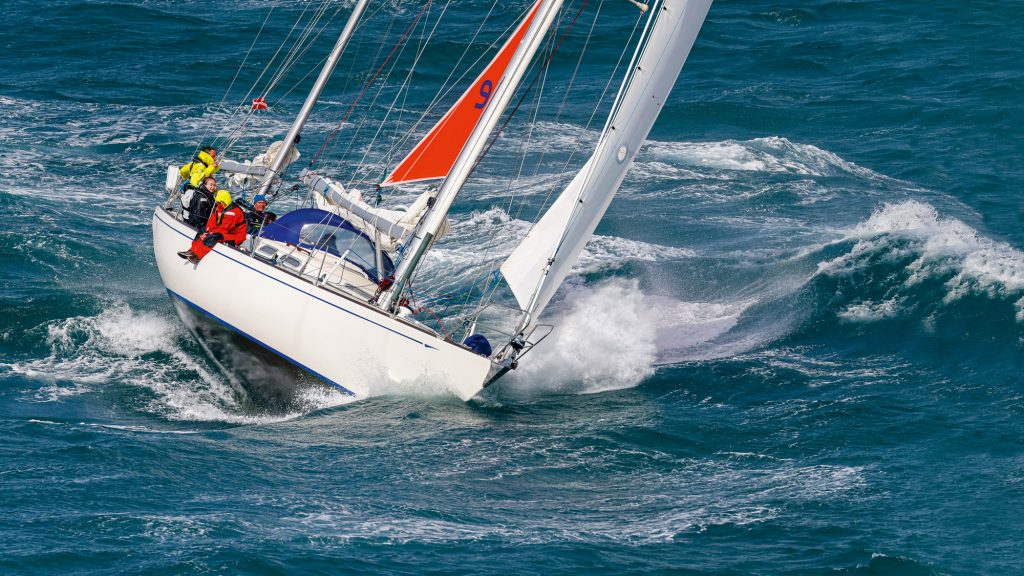
Mast Configuration
The mast configuration affects the sail plan and overall performance of a sailboat. Some common mast configurations include:
- Sloop : This is the most popular mast configuration and features a single mast with a mainsail and a headsail. The simple design makes it easy to handle and suitable for various sailing conditions.
- Cutter : Similar to the sloop, the cutter also has a single mast but carries two headsails, providing more sail area and better performance in heavy weather.
- Ketch : A ketch configuration has two masts: a taller main mast and a shorter mizzen mast. This design offers more flexibility in sail combinations and better balance in different sailing conditions.
- Yawl : Similar to a ketch, a yawl also features two masts but the mizzen is located further aft and is smaller. This design provides better balance and control, particularly in downwind sailing scenarios.
In conclusion, the basics of sailboat design involve selecting the appropriate hull type, keel type, and mast configuration for the desired sailing performance and conditions. Understanding these concepts can help sailors make informed decisions when choosing a sailboat or planning their sailing adventures.
Rigging and Sails
When it comes to sailboats, the rigging and sails play a crucial role in the boat's overall performance and capabilities. This section will briefly cover popular rig types and sail types seen on different sailboats.
There are several types of rigs commonly found on sailboats:
- Sloop : Sloops are the most common type of rig found on modern sailboats. They have a single mast with a mainsail and a single headsail, typically a genoa or jib.
- Ketch : Ketches have two masts, with the main mast taller than the mizzen mast situated aft. They carry a mainsail on the main mast and a mizzen sail on the mizzen mast. Ketches benefit from easier handling and reduced sail area under strong winds.
- Yawl : Similar to ketches, yawls have two masts, but the mizzen mast is smaller and sits further aft, behind the rudder post. Yawls are often chosen for their graceful appearance and improved balance.
- Schooner : Schooners have two or more masts, with the aft mast(s) typically taller than the forward mast(s). Schooners can handle more sails, offering increased sail area for better performance, especially downwind.
- Catboat : Catboats are single-masted sailboats with a single, large mainsail and no headsails. They have a wide beam, which provides stability and ample space for passengers.
- Cutter : Cutters are similar to sloops but carry two headsails, usually a jib and staysail. Cutters may have multiple headsails for increased versatility in various wind conditions.
In addition to the types of rigs, there are also several types of sails used on sailboats, including:
- Mainsail : The primary sail attached to the back of the main mast. It is typically raised on a track or luff groove and managed by a combination of halyard, sheet, and boom vang.
- Genoa : A large triangular sail that overlaps the mainsail, typically used in light winds to provide additional surface area for better performance.
- Jib : A smaller, non-overlapping triangular sail attached to the forestay. Jibs are easier to manage than genoas and are used in a variety of wind conditions.
- Spinnaker : A large, lightweight sail used primarily for downwind sailing . Spinnakers are often brightly colored and shaped like a parachute to catch wind efficiently.
- Staysail : A smaller sail typically used in cutter rigs, positioned between the main mast and the forestay. Staysails provide additional sail area and versatility in varied wind conditions.
Understanding the relationship between sail and rigging can help sailors optimize the performance of their sailboats. With various options for rig types and sail types, each sailboat can be configured to meet the unique needs of its skipper and crew.
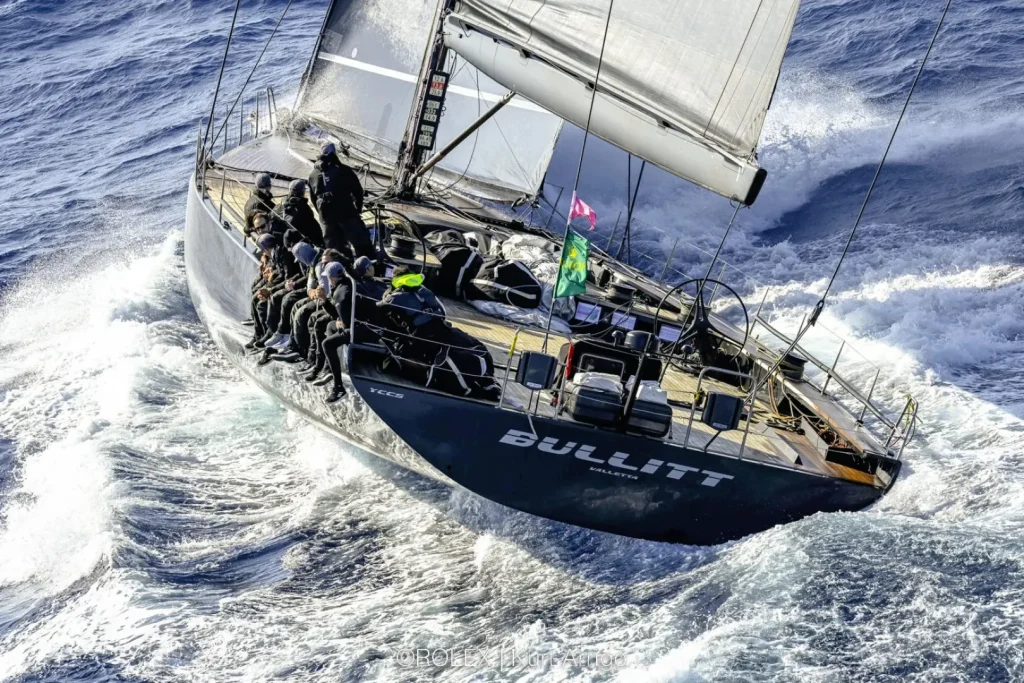
Classes and Types of Sailboats
Monohulls are the most common type of sailboats, consisting of a single hull that provides stability and balance. They come in various sizes and designs, depending on their intended use. Some popular monohull sailboats include the Optimist , Finn, and Sunfish, which are frequently used for racing and recreational sailing. Monohulls tend to have a deeper draft, requiring more water depth than their multi-hull counterparts.
Multihulls, also known as multi-hull sailboats, are a more modern innovation in sailing. They feature two or more hulls connected by a frame or bridgedeck. This design offers increased stability and speed over monohulls. Some common types of multihulls are catamarans (with two hulls) and trimarans (with three hulls). Due to their wider beam and shallower draft, multihulls are particularly suitable for cruising in shallow waters and provide more living space on board.
One-Design Sailboats
One-Design sailboats are a specific class of racing sailboats in which all boats are built to the same design specifications, ensuring that the competition focuses on the skill of the sailor rather than the design of the boat. These boats must adhere to strict rules and standards, with minimal variations allowed in terms of hull shape, sail area, and rigging. Some popular one-design sailboats include the Enterprise and the aforementioned Optimist and Finn sailboats.
Dinghies and Skiffs
Dinghies and skiffs are small, lightweight sailboats that are often used for sailing classes, short-distance racing, or as tenders to larger boats. Dinghies usually have a single mast with a mainsail and sometimes a small jib. Some popular types of sailing dinghies include the Optimist, which is specifically designed for children, and the versatile Sunfish sailboat. Skiffs, on the other hand, are high-performance sailboats primarily used for racing. They have a larger sail area relative to their size and typically include features such as trapezes and planing hulls, which allow for faster speeds and greater maneuverability.
In conclusion, there are various classes and types of sailboats, each with its own unique features and characteristics. From the simplicity of monohulls to the stability and speed of multihulls, and from the fair competition of one-design sailboats to the excitement of dinghies and skiffs, there is a sailboat to satisfy every sailor's preferences.
Sailboat Size and Use
When exploring the world of sailboats, it's important to understand their different sizes and purposes. Sailboats can be categorized into three main types, each with unique characteristics and uses: Day Sailers , Racing Sailboats, and Cruising Sailboats .
Day Sailers
Day Sailers are small sailboats typically ranging from 10 to 24 feet in length. These boats are perfect for short sailing trips and are easy to maneuver for beginners. They have limited accommodations on board, providing just enough seats for a small group of people. Some popular day sailer models include the Laser, Sunfish, and Flying Scot. Lightweight and agile, Day Sailers are often used for:
- Recreation: casual sailing or exploring nearby waters with family and friends
- Training: beginner sailing lessons or practicing sailing techniques
- Competition: local club races or interclub regattas
Racing Sailboats
Racing Sailboats are designed to provide maximum speed, maneuverability, and efficiency on the water. Sizes may vary greatly, from small dinghies to large yachts. Key features of racing sailboats include a sleek hull shape, high-performance sails, and minimalistic interiors to reduce weight.
Career racers and sailing enthusiasts alike participate in various types of racing events , such as:
- One-design racing: all boats have identical specifications, emphasizing crew skill
- Handicap racing: boats of different sizes and designs compete with time adjustments
- Offshore racing: long-distance racing from one point to another, often around islands or across oceans
Cruising Sailboats
Cruising Sailboats are designed for longer journeys and extended stays on the water. They typically range from 25 to 70 feet in length and provide comfortable accommodations such as sleeping cabins, a galley, and storage spaces for supplies and equipment. Sailing cruisers prioritize stability, comfort, and durability for their voyage.
Here are some common types of cruising sailboats:
- Cruiser-racers: These boats combine the speed of a racing sailboat with the comfort and amenities of a cruising sailboat. They are ideal for families or sailors who enjoy participating in racing events while still having the option for leisurely cruises.
- Bluewater cruisers: Designed for handling the world's most demanding ocean conditions, bluewater cruisers are built with a focus on sturdy, self-reliant sailboats that can withstand long-distance voyages and challenging weather conditions.
- Multihulls: Catamarans and trimarans are gaining popularity in the cruising world for their typically more spacious interiors and level sailing characteristics. With two or three hulls, multihulls offer high levels of stability and speed for a comfortable cruising experience.
Understanding the differences between various sailboat types will help potential sailors select the perfect vessel for their sailing goals, skills, and preferences. Day Sailers, Racing Sailboats, and Cruising Sailboats each have their unique features, catering to distinct uses and sailing experiences.
Advanced Sailboat Features
Sailboats have evolved over time, and many advanced features have been developed to enhance performance and safety. In this section, we will discuss some of the key advanced features in modern sailboats, focusing on performance enhancements and safety/navigation.
Performance Enhancements
One critical component that impacts a sailboat's performance is the type of keel it has, which affects stability, resistance, and maneuverability . There are several kinds of keels such as fin keel , wing keel , and bulb keel . Fin keels offer low drag and high efficiency, making them suitable for racing sailboats. On the other hand, wing keels provide better stability at low speeds, while bulb keels provide a lower center of gravity to enhance overall stability and comfort during long voyages.
Another feature that contributes to a sailboat's performance is its sails and rigging. The jib is a triangular sail at the front of the boat, which helps improve its upwind performance. More advanced sailboats use a combination of shrouds , which are the supporting cables running along the sides of the boat, and stays , the cables that help hold the mast in place, to create a stable and efficient rigging system.
A sailboat's performance can also be influenced by the presence of a centerboard or daggerboard , which can be adjusted to optimize stability, maneuverability, and speed. When racing or navigating in shallow waters, retractable centerboards and daggerboards are particularly useful as they provide better performance and versatility.
Safety and Navigation
Safety and navigation onboard a sailboat relies on a combination of advanced gear and equipment. A modern sailboat is usually equipped with:
- GPS and chartplotters to assist with navigation and planning routes
- VHF radios for communication with other vessels and authorities
- Radar to detect obstacles, weather systems, and other vessels
- AIS (Automatic Identification System) which helps monitor nearby vessel traffic
The design of a sailboat's hull, rigging, sails, and hardware also contribute to its safety. The boom , the horizontal pole that extends the sail, should be properly secured and designed to avoid accidents while sailing. The keel , whether it's a fin, wing, or bulb keel, plays a vital role in the overall stability and safety of the sailboat. The choice of keel should be based on the intended use of the sailboat and the prevailing sailing conditions.
In summary, advanced sailboat features significantly improve the performance, safety, and navigation capabilities of modern sailboats. Innovations in keel design, rigging systems, and onboard navigational equipment have undoubtedly contributed to the overall enjoyment and safety of sailing.
Sailboat Ownership
Buying Considerations
When considering buying a sailboat , it is important to understand the different types of sailboats available and the purpose each serves. Sailboats can be broadly categorized into three types:
- Racing sailboats: Designed for speed and performance, with minimalistic interiors and advanced sail systems.
- Cruising sailboats: Built for comfort and longer trips, featuring more spacious interiors and amenities.
- Daysailers: Smaller, easy-to-handle boats that are often used for short trips and recreational sailing.
Prospective boat owners should consider factors such as boat size, type, budget, and intended use (solo vs. family sailing, charter operations, etc.). It's also essential to evaluate the availability of necessary gear and the level of experience required to handle the chosen sailboat.
Maintenance and Upkeep
Sailboat ownership involves maintenance and upkeep to ensure the boat remains functional, safe, and holds its value. Some common maintenance tasks include:
- Hull cleaning and inspection: Regularly inspect the hull for damages and clean off any growth to maintain performance and fuel efficiency.
- Antifouling paint: Apply antifouling paint to prevent marine organisms from attaching to the hull, which can negatively impact the boat's performance.
- Engine maintenance: Check and replace engine oil, inspect cooling and fuel systems, and clean or replace air filters.
In addition to regular maintenance, sailboat owners should also be prepared to replace or repair critical systems and components, such as:
- Sails: Monitor the condition of your sails and replace them as needed to maintain performance and safety.
- Rigging: Regularly inspect and maintain the standing and running rigging, and replace worn or compromised parts.
- Electronics and instruments: Ensure navigation systems, radios, and other electronic equipment are functioning properly.
Taking proper care of a sailboat can be time-consuming, and some owners may choose to charter their boats when not in use as a way to offset ownership costs. Others may opt for hiring professionals to manage routine maintenance, particularly when sailing solo or with limited sailing experience.
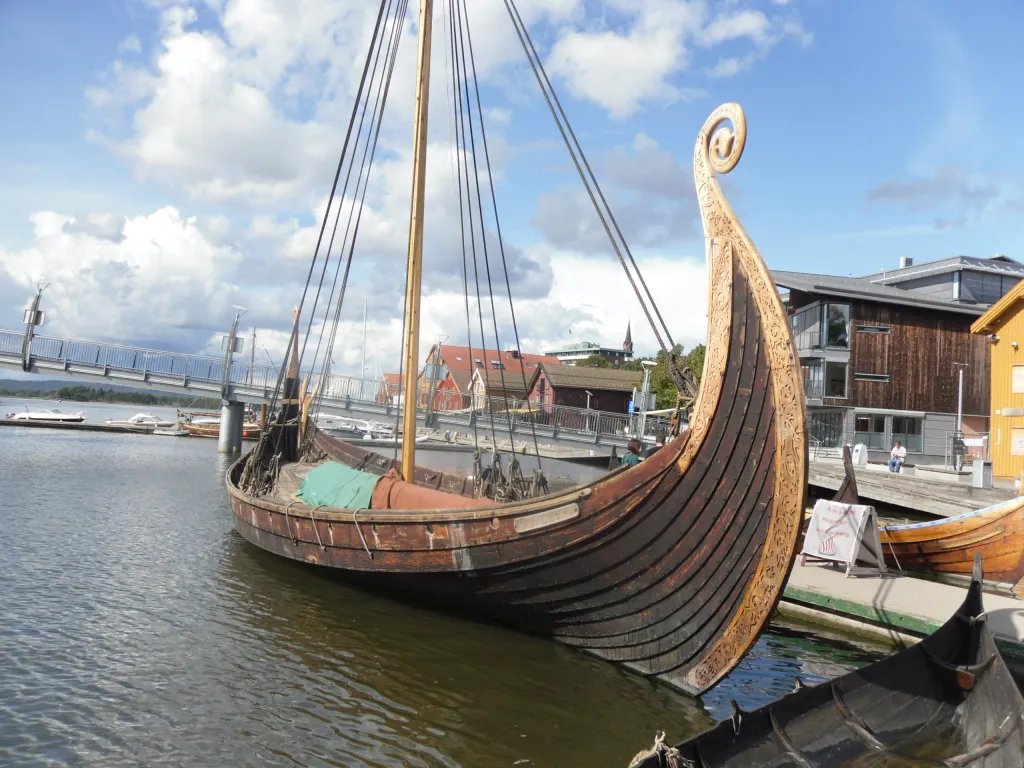
Historical and Special Sailboats
Tall ships and gaffers.
Tall Ships are large, traditionally rigged sailing vessels with multiple masts, typically square-rigged on at least one of their masts. Some examples of these ships include the clipper, brig, and square-rigged vessels. The clipper is a fast sailing ship known for its sleek hull and large sail area, while the brig features two square-rigged masts. Square-rigged ships were known for their impressive sail area and could cover large distances quickly.
Gaffers are a subset of historical sailing vessels with a gaff mainsail as their primary sail type. This gaff-rig is characterized by a spar (pole) that extends the top edge of the mainsail, giving it a quadrilateral shape to optimize wind coverage. Gaff mainsails were commonly used in England and influenced the development of other sailing vessels.
Classic and Antique Sailboats
Classic and antique sailboats refer to older, traditionally designed sailing vessels that have been preserved or restored. They often feature wooden construction and showcase a variety of rigging types, including gaff rigs and square rigs. These historical sailboats have unique designs, materials, and techniques that have since evolved or become rare.
Here are some examples of antique and classic sailboats:
- Sloop : A single-masted sailboat with a Bermuda rig and foresail
- Cutter : A single-masted vessel with a similar rig to the sloop, but with additional headsails for increased maneuverability
- Ketch : A two-masted sailboat with a smaller mizzen mast aft of the main mast
In summary, historical and special sailboats encompass a wide range of vessel types, from large, multi-masted tall ships to smaller, single-masted gaffers and classic sailboats. These vessels reflect the rich maritime history and the evolution of sailing techniques and designs over time.
Sailboat Culture and Lifestyle
Sailboat culture and lifestyle encompass a variety of aspects including racing events, leisurely cruising, and exploring new destinations. The main types of sailboats include racing yachts, cruising sailboats, and motorsailers, each offering a unique experience for sailors.
Regattas and Racing Circuits
A popular aspect of sailboat culture involves participating in regattas and racing circuits . These events create a competitive atmosphere and develop camaraderie among sailors. Racing sailboats are specifically designed for speed and agility , and sailors often team up to compete in prestigious races such as the Rolex Sydney Hobart Yacht Race or the America's Cup. Yacht clubs play an essential role in cultivating this competitive sailing environment.
Sailboat Charter and Tourism
Another facet of sailing culture is the sailboat charter and tourism industry, which allows people to experience the cruising lifestyle without owning a sailboat. Charters are offered for various types of sailboats, from family-sized cruising vessels to luxurious superyachts . Yacht sailing provides tourists with a unique travel experience, as they can explore diverse destinations, immerse themselves in local cultures, or simply relax on the open water.
Cruising sailboats are designed to provide comfortable living spaces and amenities, making them perfect for longer journeys or exploring remote destinations. Motorsailers, on the other hand, are equipped with both sails and engines, offering versatility and convenience for sailors.
Some popular sailing destinations include the Caribbean, Mediterranean Sea, and the South Pacific. These regions offer beautiful scenery, rich cultural experiences, and ideal sailing conditions.
The sailboat culture and lifestyle attract individuals who enjoy adventure, exploration, and camaraderie. From competitive racing events to leisurely cruising vacations, sailing offers diverse experiences that cater to a wide range of interests.
Frequently Asked Questions
What are the distinguishing features of different sailboat classes?
There are various sailboat classes, each with its own distinguishing features. Monohulls, for example, are the most common type of sailboat and have a single hull. Multihulls, such as catamarans and trimarans, have two or three hulls, respectively. These differences in hull design often affect the boat's stability, speed, and maneuverability.
Which sailboat types are best for novice sailors?
Novice sailors often benefit from starting with smaller, more manageable boats. Sailing dinghies and daysailers are popular choices due to their simple rigging and ease of handling. These boats typically have a single mast and a limited number of sails, making them ideal for beginners to learn sailing basics.
What are common types of small sailboats ideal for day sailing?
For day sailing, small sailboats such as sailing dinghies, day sailers, and pocket cruisers are ideal options. These boats usually range between 12 and 25 feet in length and offer simplicity, ease of handling, and portability. Examples of common day sailing boats include the Sunfish, Laser, and O'Day Mariner.
How do the purposes of various sailboat types vary?
Sailboats serve different purposes based on their design, size, and features. Daysailers and dinghies are ideal for short trips, sailing lessons, and casual outings. Racing sailboats, with their lighter weight and streamlined design, are built for speed and competition. Cruising sailboats, on the other hand, are designed for longer voyages and often include living quarters and additional amenities for comfortable onboard living.
What is considered the most popular class of sailboat for recreational use?
The most popular class of sailboat for recreational use often varies depending on individual preferences and local conditions. However, monohulls are commonly preferred due to their widespread availability, versatility, and affordability. Within the monohull class, boats like the Sunfish, Laser, and Catalina 22 are popular choices for their ease of use and adaptability to various sailing conditions.
Could you describe a sailing dinghy designed for two people?
A two-person sailing dinghy typically has a simple rig with a single mast and one or more sails, making it easy to handle for both experienced and novice sailors. The RS Venture , for example, is a popular choice for two-person sailing. It features a spacious cockpit, durable construction, and simplicity in its rigging and control systems. These characteristics make it an excellent option for recreational sailing, training, and even racing.
Related Articles
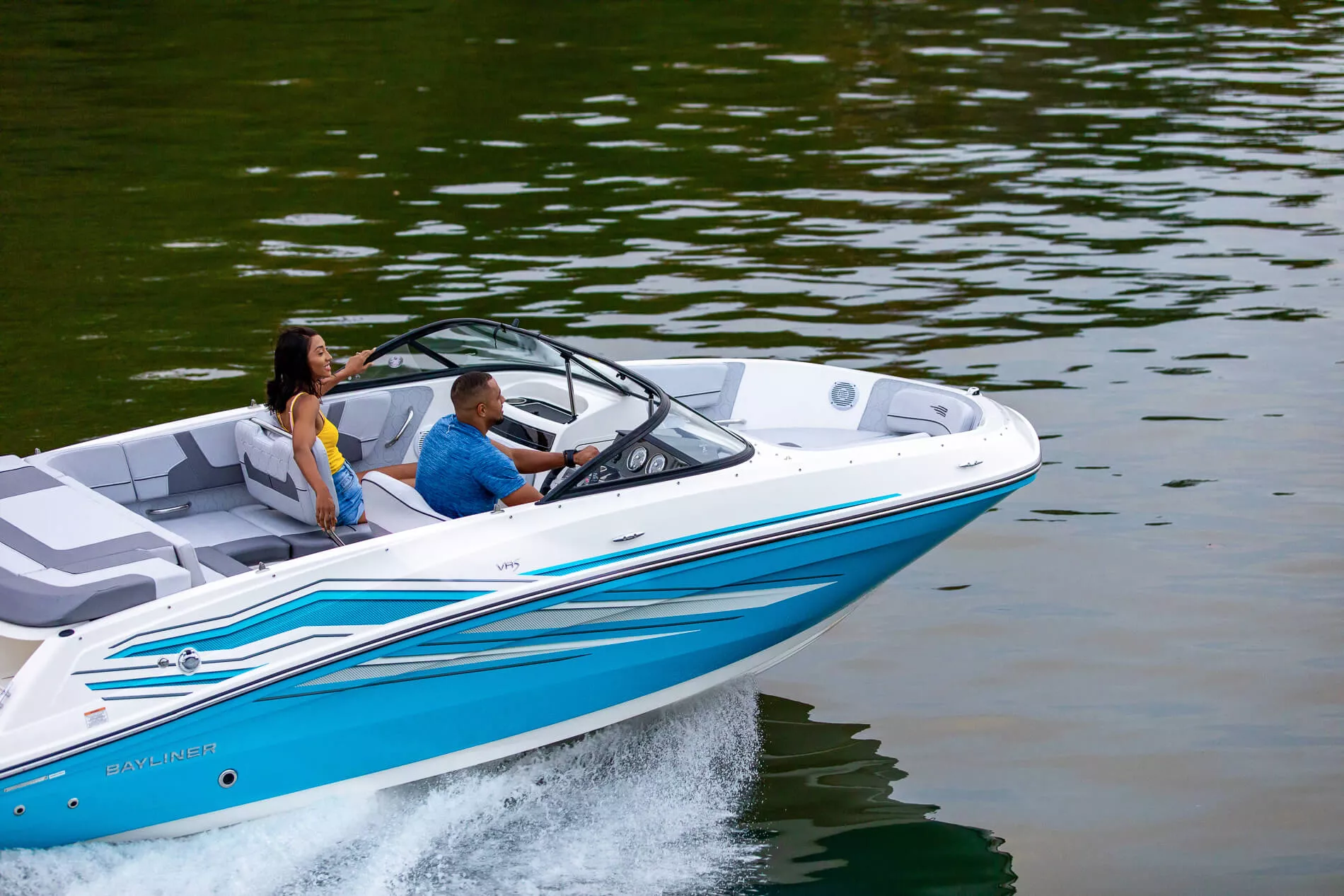
Bayliner Boats: Ultimate Guide to Models, Performance, and Features

Points of Sail: Mastering Wind Angles for Efficient Sailing
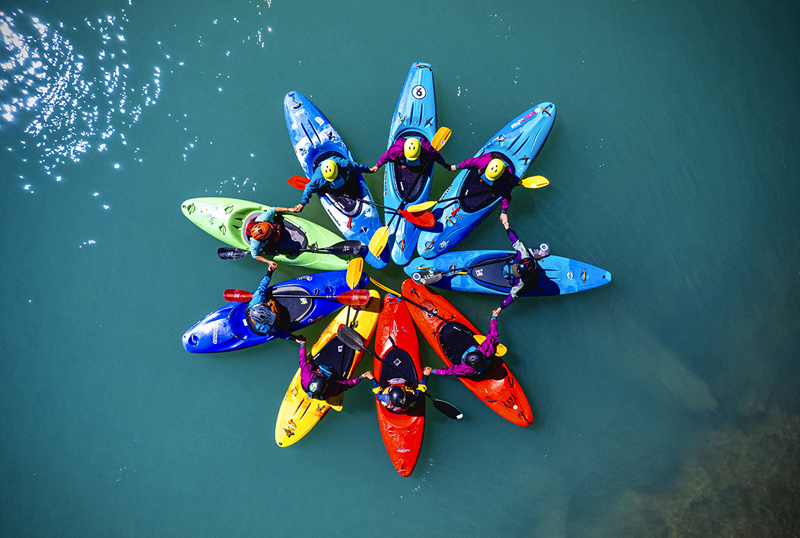
Used Kayaks for Sale: Top Picks and Buying Guide 2024
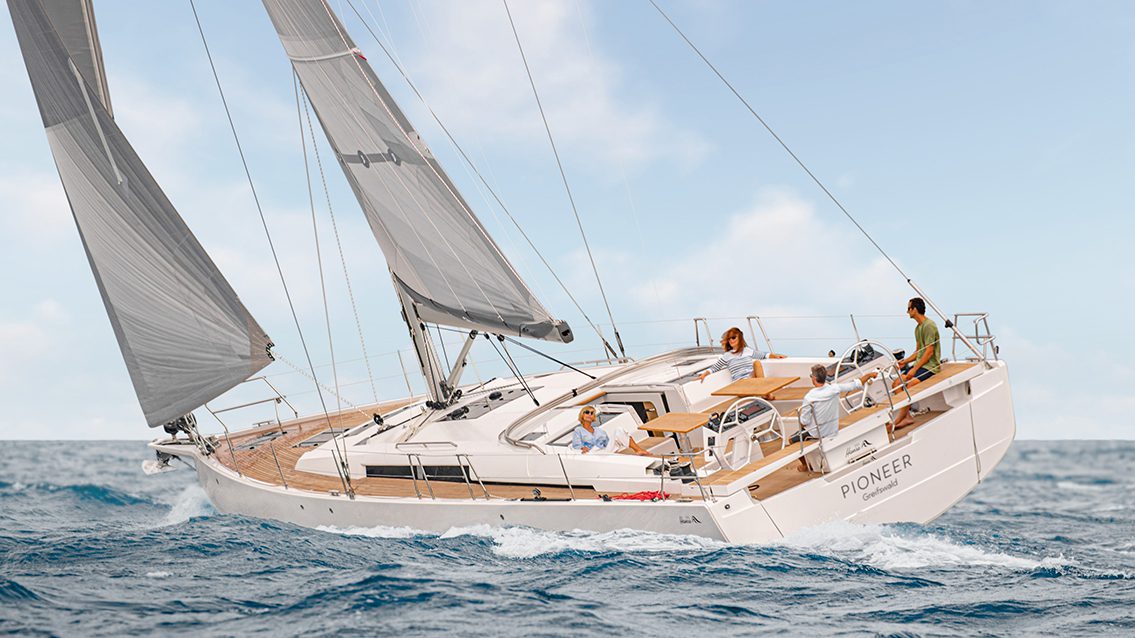
Parts of a Sailboat: Essential Components Explained

Top 10 Used Flats Boats for Sale in Texas: Best Deals for Coastal Anglers
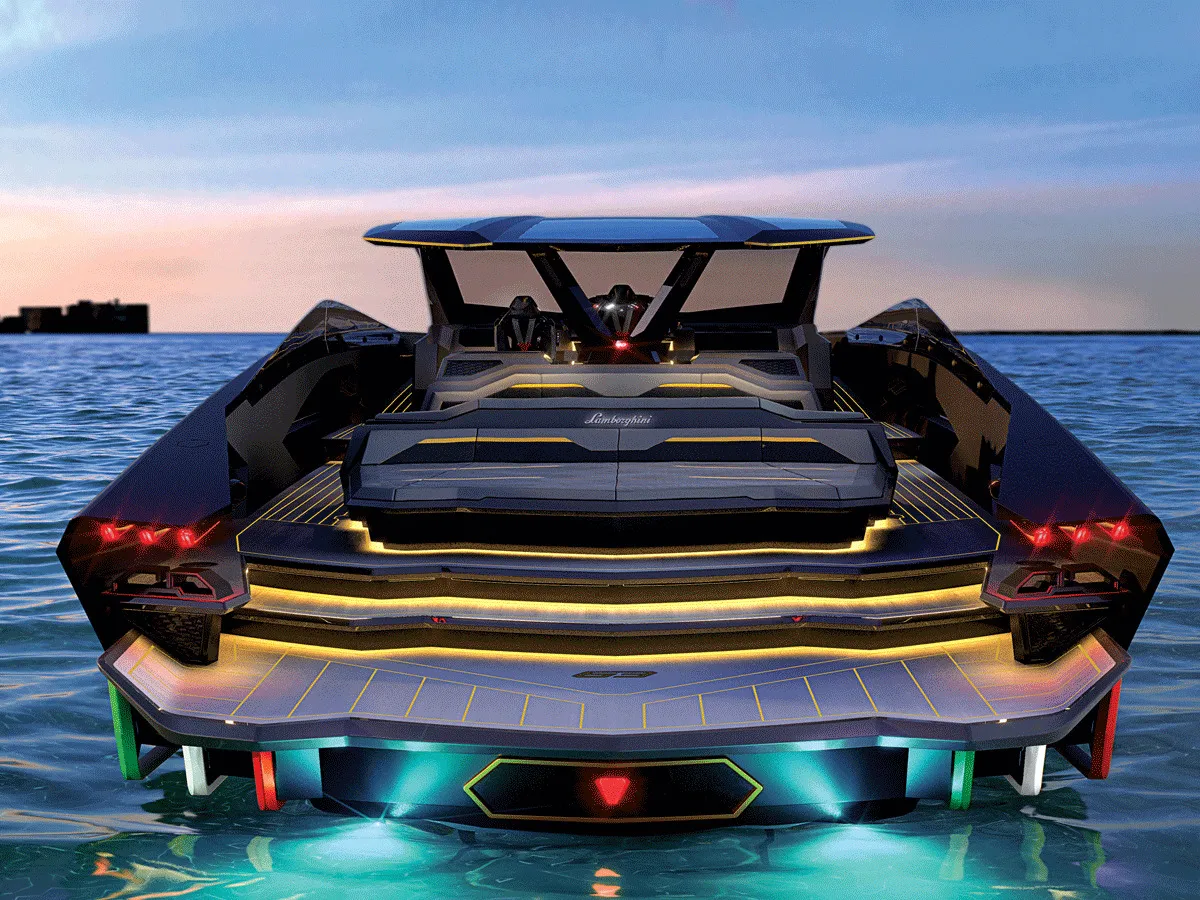
Lamborghini Yacht Price: Unveiling the Luxury Experience

How Should You Pass a Fishing Boat: Essential Tips for Safe Navigation
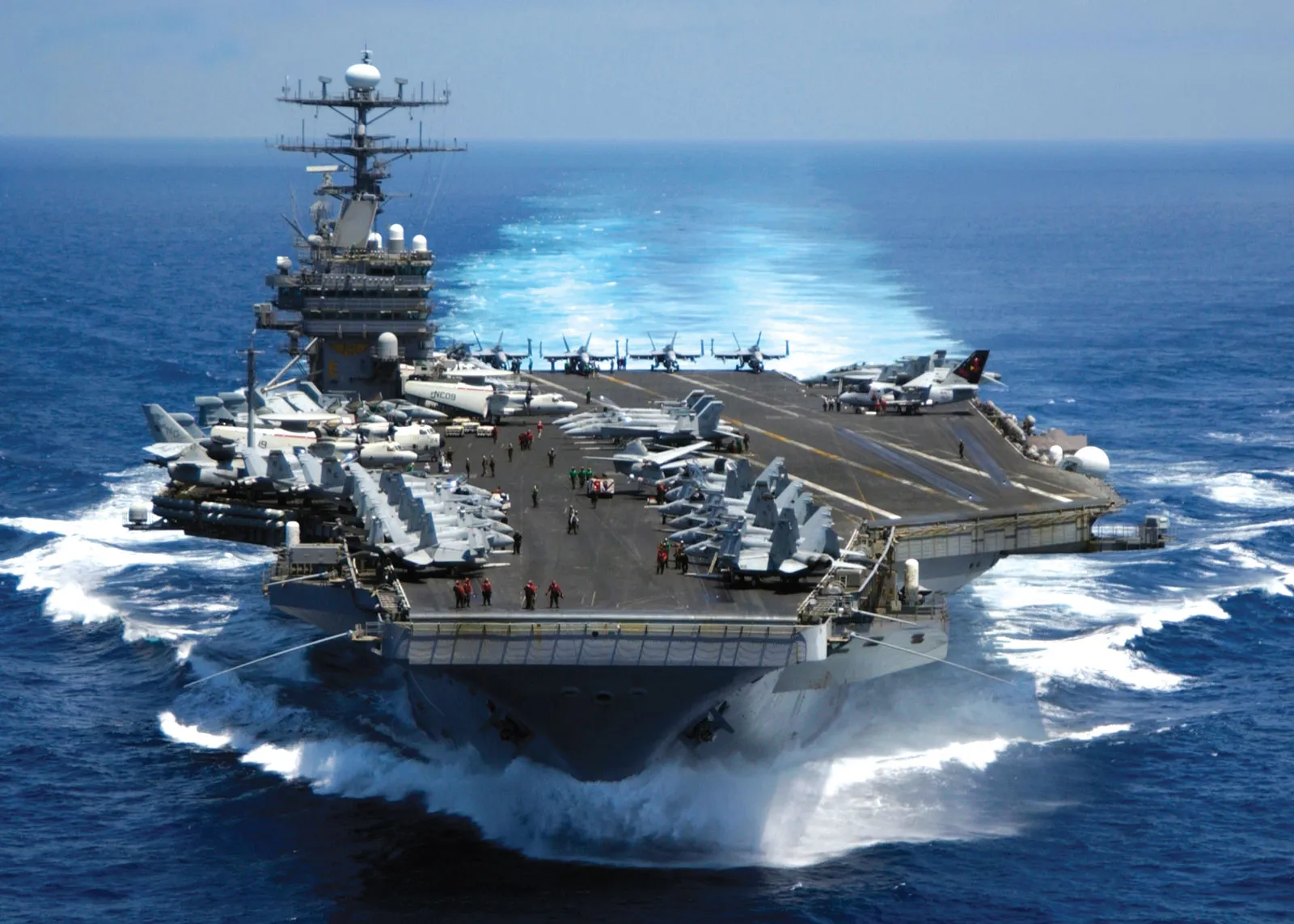
What Minimum Distance Must be Maintained from a U.S. Naval Vessel? Safety Guidelines Explained
The 15 Different Types Of Sailing Ships
The 15 types of sailing ships are listed below.
- The Schooner
- The Carrack
- The Brigantine
- The Barquentine
- The Clipper
- The Windjammer
- The Fully Rigged Ship
Throughout centuries, there have been many different types of sailing ships seen from harbors and coastlines around the world.
This article will show the various types of sailing vessels that have made their mark in maritime history and we showcase their purposes and why they are still remarkable feats of marine engineering.
The different sizes, shapes, and masts of the ships required different numbers of sailors to handle them and each type of ship was crafted with a different purpose in mind.
All ships are unique with no two types of ships being the same with each coming with its own experiences, features and requirements.
1. The Schooner
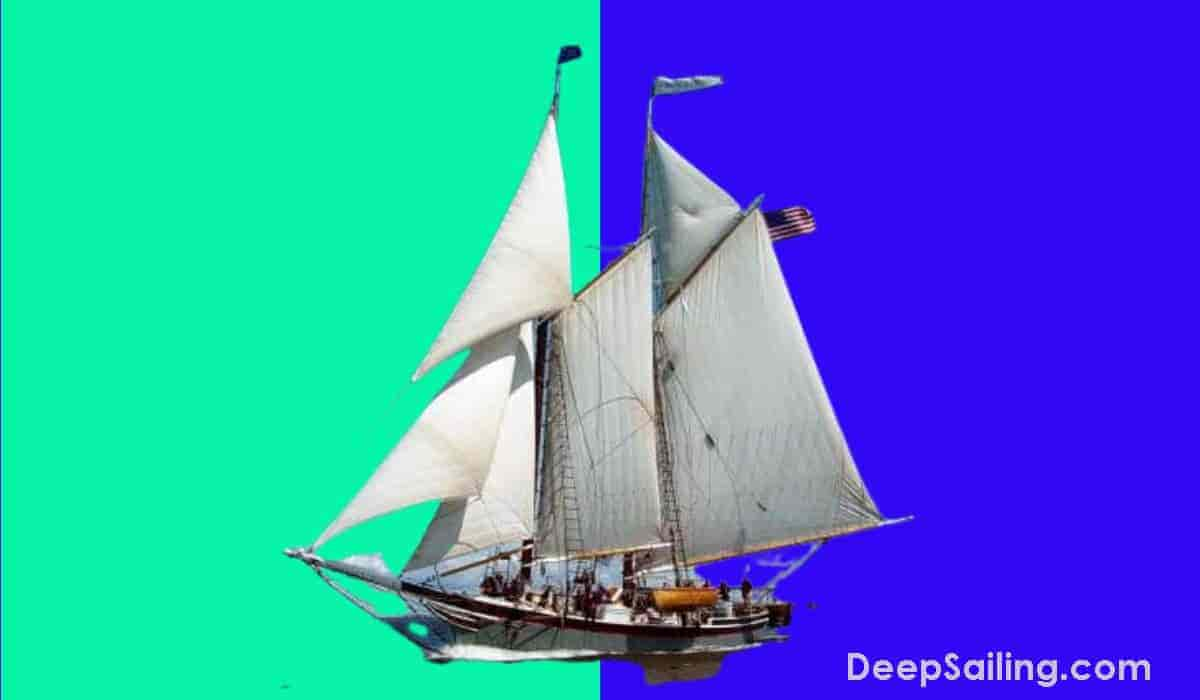
The Schooner sailing vessel, with an average size of 46m (152 feet) in length, was developed in the early 17th century and first used by the Dutch.
The ship came with fore and aft sails and they were created to operate in the toughest of wind and ocean conditions.
The Schooner was a multi-purpose sailing vessel used for transporting slaves to transporting cargo and it was used for fishing and racing too.
There are 5 different schooner types that are characterized by their rig configurations listed below.
- Tern schooner : This was a 3-masted schooner most popular between 1880 and 1920 capable of carrying up to 400 tons in cargo and it required a crew of 6-8 people
- 4-6 masts schooner : These schooners spread the sail area over smaller sails
- Grand Bank Fishing schooner : Similar to the famous Bluenose, it carries the main gaff topsail and a fisherman's staysail set between the masts.
- Square Topsail schooner : This was a combination of fore and aft sails and small square sails, most popularly used for coastal cargo transportation in the 1800s
- Coastal schooner : This was a coastal schooner sailing ship used for carrying goods and general cargo to nearby islands along the coast ( 1 )
The 19th Century schooner came with two or three masts, the one at the fore being shorter than the others.
Modern schooners, with Bermuda rigged sails, remain powerful, economical coastal liners traversing the Pacific.
Famous schooner sailing ships are listed below.
- America : The Schooner named " America " was designed for racing and it became the first winner of the America's Cup international sailing trophy ( 2 )
- Thomas W Lawson : The schooner “ Thomas W Lawson ” had a unique seven masts, with interchangeable sails and gear
- Wawona : The schooner " Wawona " was one of the largest lumber carriers and fishing vessels between 1897 and 1947
2. The Carrack
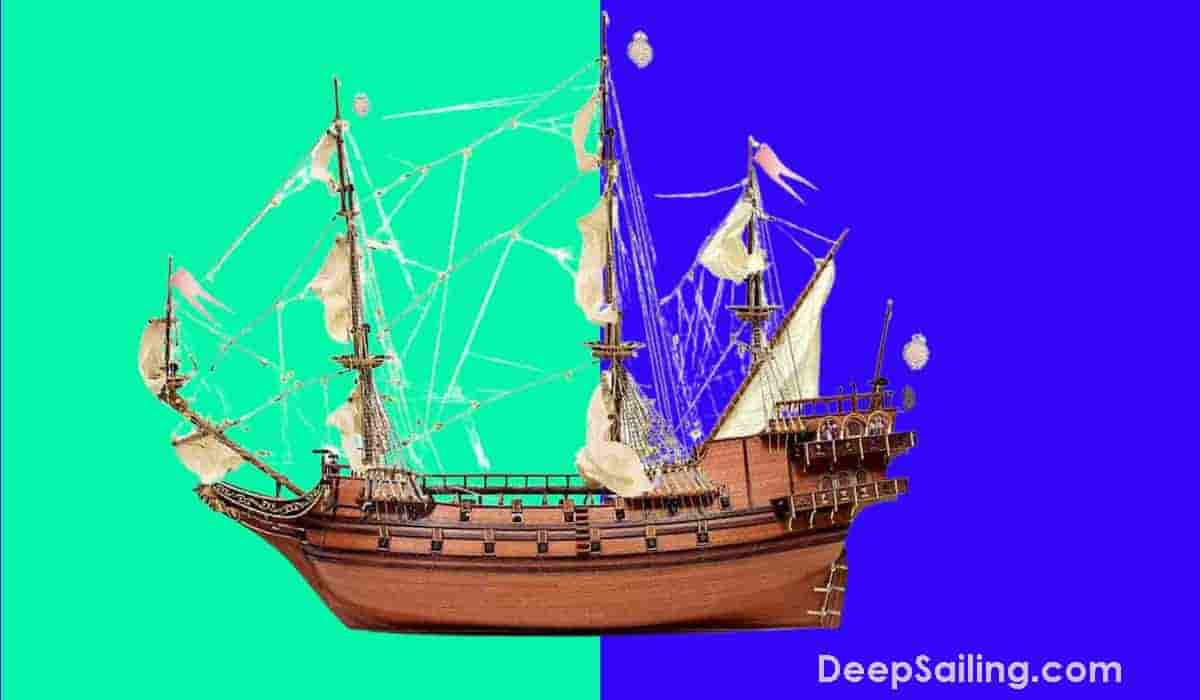
The Carrack, developed in the 14th and 15th centuries with the first built in Portugal, is a nautically-rigged wooden ship with three or four masts each having square sails or triangular sails and it was heavily used between the 14th to 15th Centuries and remained popular until the 18th Century. It is the sailing ship Christopher Columbus used to sail the world.
It was the largest ship in Europe with the Spanish Carrack being more than 1,000 tons in weight and 150 feet (45 meters) in length. More modern versions of the Carrack were developed by the Portuguese and they could hold up to 2,000 tons. ( 3 ).
The Carrack had 4 decks with the lower 2 used for cargo, the 3rd was for accommodation and the 4th was for cargo owned by the crew ( 4 ) and this bulky ship was the standard trading ship along the Baltic, Mediterranean, Asian, and Atlantic coasts in the mid-16th century useful for carrying cargo across seas.
The Carrack had a strange shape which made it cumbersome to sail close to the wind and after a lot of engineering experiments, parts of the ship were stripped off giving the ship a high stern and a low bow.
The modern Carrack features a square-rigged mainmast, foremast, and a latten-rigged Mizzen mast, along with a rounded stern, sizable bowsprit, forecastle, and aft castle.
This is a large ship, built to carry heavy freight for long-distance hauls since it was very steady even in the worst weather with the British Army calling it the “Great Ship” because of its highly-functional ship design.
Famous carrack shipping vessels are listed below.
- Santa Maria : This was the famous ship that Christopher Columbus used to sail and discover America in 1492
- Victoria : The first ship to circumnavigate the globe
- Grace Dieu : This was commissioned by King Henry V and it was one of the largest carrack ships in the world in 1418
- Cinco Chagas : This was presumed to be the richest ship at that time. it was sunk in battle in 1594 ( 5 )
3. The Brigantine
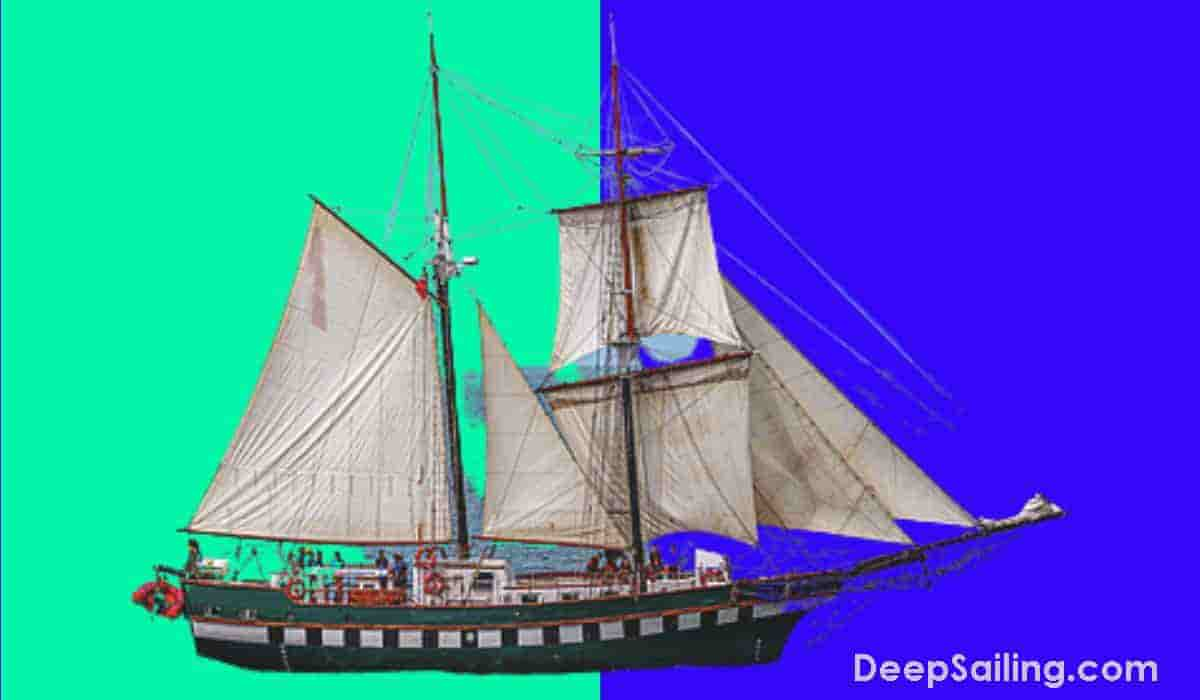
A Brigantine is a two-masted sailing ship with the main mast both a fore-and-aft main sail, a triangular type of sail and a square main topsail that came in various sizes ranging from 30 tons to 150 tons and it could carry a crew of up to 125 people but the shipping vessel could still be handled by a smaller crew if needed.
These ships were similar to the sailing vessel called the Brig as they both had top-gallant sails and were used by the Royal Navy to scout and monitor enemies on the high seas while also being popular amongst pirates as they were faster and easily maneuverable sailing vessels.
It is unclear when the ship was originally built with loose definitions date the ship back to the 13th century when it was originally referred to as the "sail and oar-driven war vessel" ( 6 ) and early academic definitions where the vessel was referred to as the "Brigantine" was first seen in books in the early to mid-16th century ( 7 ).
They would sail across the trade routes of the Baltics and Northern Europe, all the way from Germany to Scandinavia.
The mid-size ships had two sails on the-mainmast with a stripped-down fully-squared rig.
4. The Barquentine
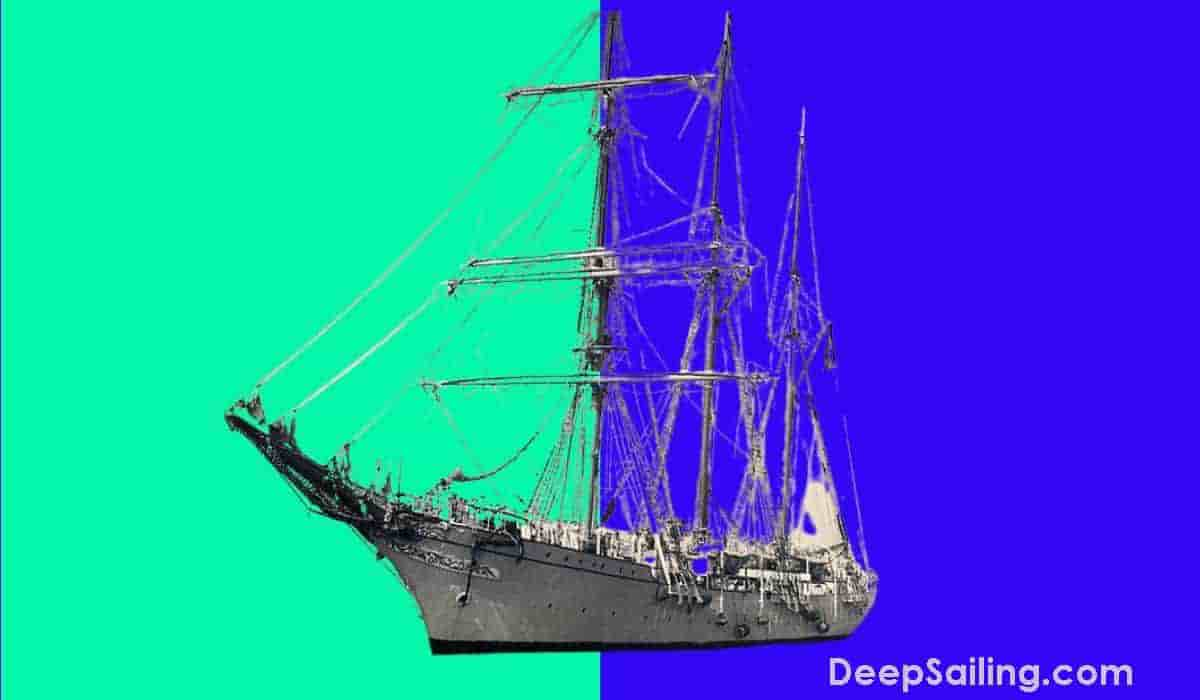
The Barquentine, first built in the 17th century and also referred to as a " schooner barque ", " barkentine " or " schooner bark ", is a sailing ship similar to a barque but with only the foremast square-rigged and the remaining masts rigged fore and aft ( 9 ). They weighed 250 to 500 tons.
The Barquentine has three or more masts and square sails on the fore and aft masts with the main mast had topmast and gaff sails and these had been stripped down to facilitate operation by a slimmer crew and basic rig.
The Barquentine sailed the waters of Northern Europe which were dominated by variable wind speeds and they were popularly used to carry lumber from Scandinavia and Germany to England and the Baltic Areas.
5. The Xebec
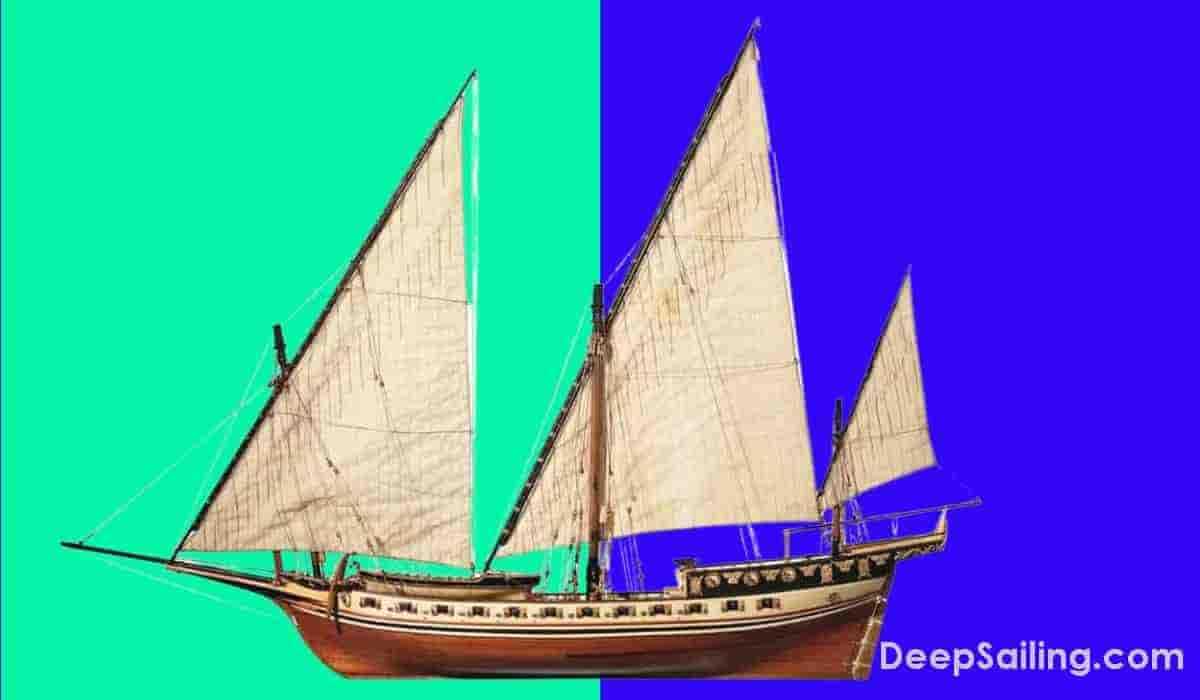
The Xebec, also known as " Zebec ", a name derived from the Arabic word for "Small Ship", was a sailing ship built in the 16th to mid-19th century that was used mainly for moving cargo.
The Xebec sailing vessel held between 90 and 400 crew and was 103ft 9 inches in length with a tonnage of between 200 - 300 tons ( 10 ) and they were very agile and popular with European navies.
The features of the Xebec are listed below.
- Long-prow bulkheads
- Narrow elongated hulls
- Huge lateen yards
- One aft-set mizzen mast
- 3 lateen-pillared masts, both raked forward and having a single triangular sail
Their shallow draft and lateen rig allowed for a closer pinch to the wind allowing them to flee quickly or turn around and fire a broadside volley quickly.
After a lot of engineering experiments, the Xebec gave rise to the Polacre-Xebec, which replaced the mizzen mast. The mainmast of the new derivative also had a square rig and these new vessels were light and could not carry a heavy load with the shallow draft and low free-board making them unsuitable for open-seas sailing.
6. The Barque
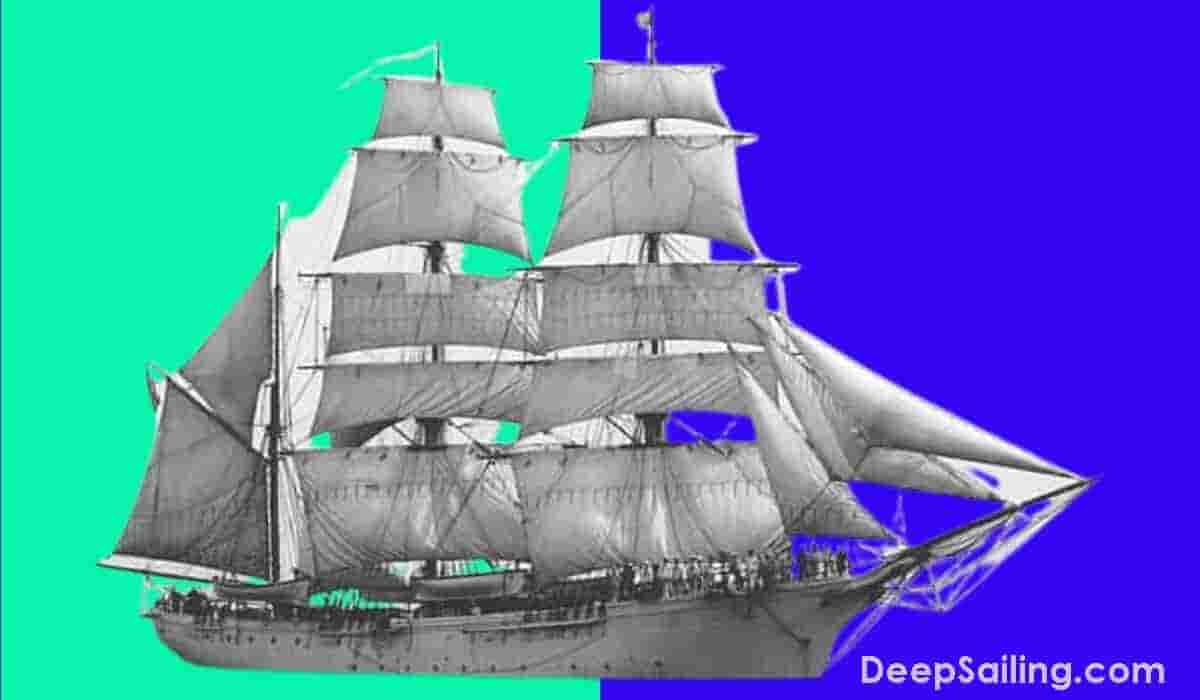
The barque, also referred to as " barc " or " bark ", is a sailing ship first introduced in the 15th century ( 11 ) with 3 or more masts with square sails on all masts, except the aft or mizzen mast. It could carry approximately 500 tons and could hold a crew of 100 people.
Although they are quite similar, the barque should not be confused with the Schooner Bark which is a different vessel.
The Barque ship was commonly used by traders to carry extremely high volumes of cargo from Australia to Europe with cargo mainly consisting of Nitrates and Guano destined for the Western South American coast and they were popular in the period prior to the start of World War II.
7. The Clipper
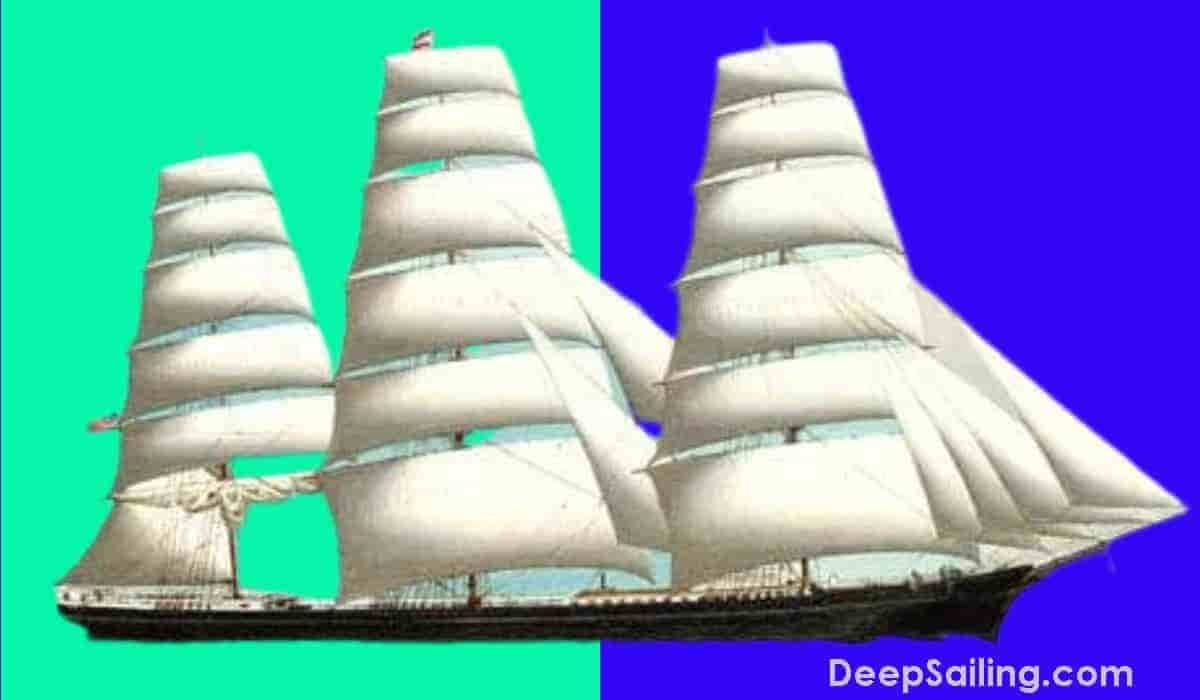
A clipper was a sailing vessel introduced in the mid-19th century that was mainly used as a merchant ship for transporting goods and it was designed for speed.
Clipper ships ranged in size from a few hundred tons to over 4000 tons ( 12 ) and they all had a narrow build, a protruding stern, 3 to 5 masts for speed, and a square rig.
They were most commonly used by British and American traders to ship goods from China to their countries and they were also used to ferry Gold and Tea back to Great Britain and the Americas.
Famous clipper ships are listed below.
- Cisne Branco : This is a steel-hulled built like the original clipper. It is used as a training vessel by the Brazilian navy to this day
- Race Horse : This clipper ship set the record of getting from New York to San Francisco in 109 days in 1850 which was a record at that time
- Marco Polo : This clipper vessel was the first boat of the time to make around trip between England & Australia in under 6 months in 1852
8. The Windjammer
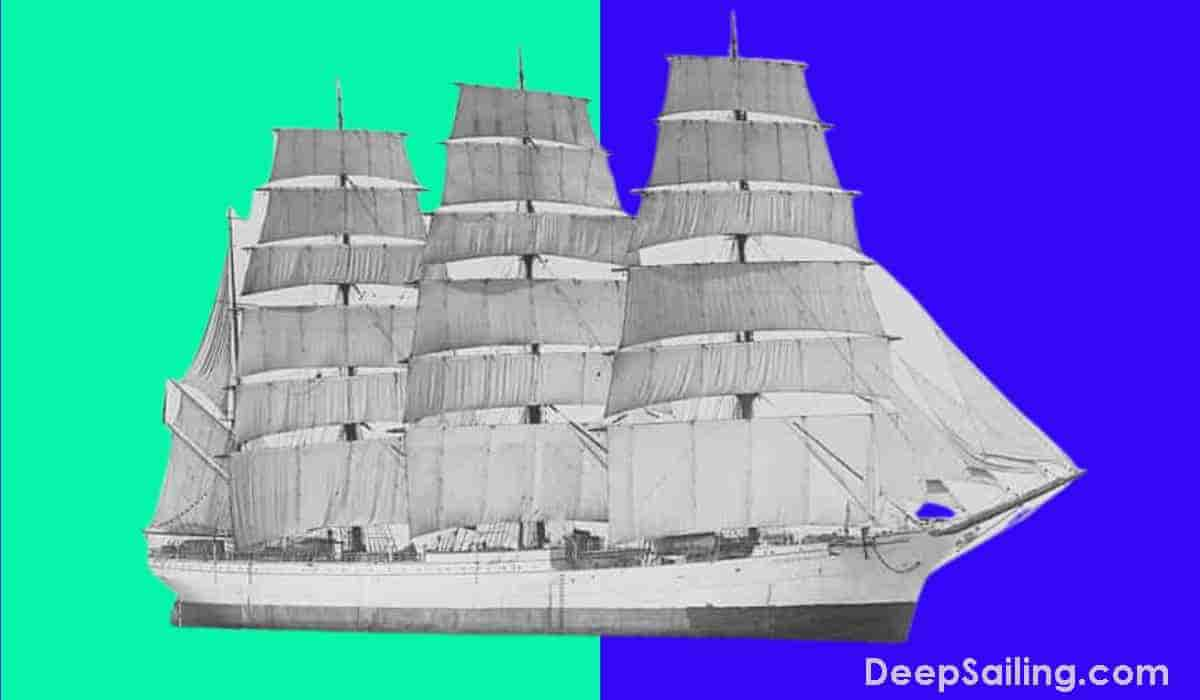
The Windjammer is a commercial sailing ship built in the 19th century with a capacity between 2,000 to 8,000 tons and the speed ranged from 14 to 21 knots ( 13 ).
It came with three to five square-rigged masts and it had a cost-effective extended hull that allowed for larger storage space.
It was a general-class merchant ship and was mainly used to transport bulky cargo and it ferried lumber, coal, and many other goods from one continent to another before evolving from carrying cargo to carrying passengers on cruises in later generations.
9. The Fluyt
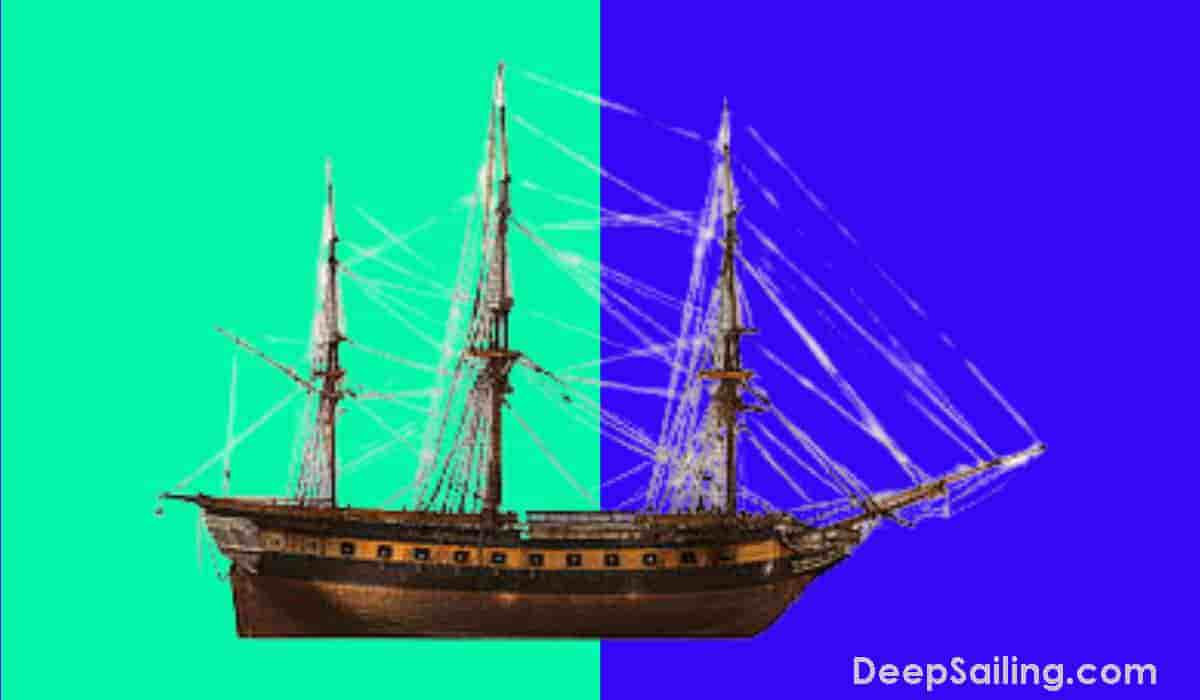
The Fluyt, also known as " fleut " or " fluit " is a sailing ship that originated in the 16th century in the Dutch Republic with a weight between 200 and 300 tons, approximately 80 feet (24 meters) in length, and a crew capacity of 12 - 15 people ( 14 ).
The Fluyt has three squared-rigged masts and was primarily used as a merchant ship to transport cargo.
It was lightly fortified, had a small stern and extended box-style structure, and was crafted using specialized tools to reduce the costs of production and make them affordable to merchants.
10. The Fully-Rigged Ship
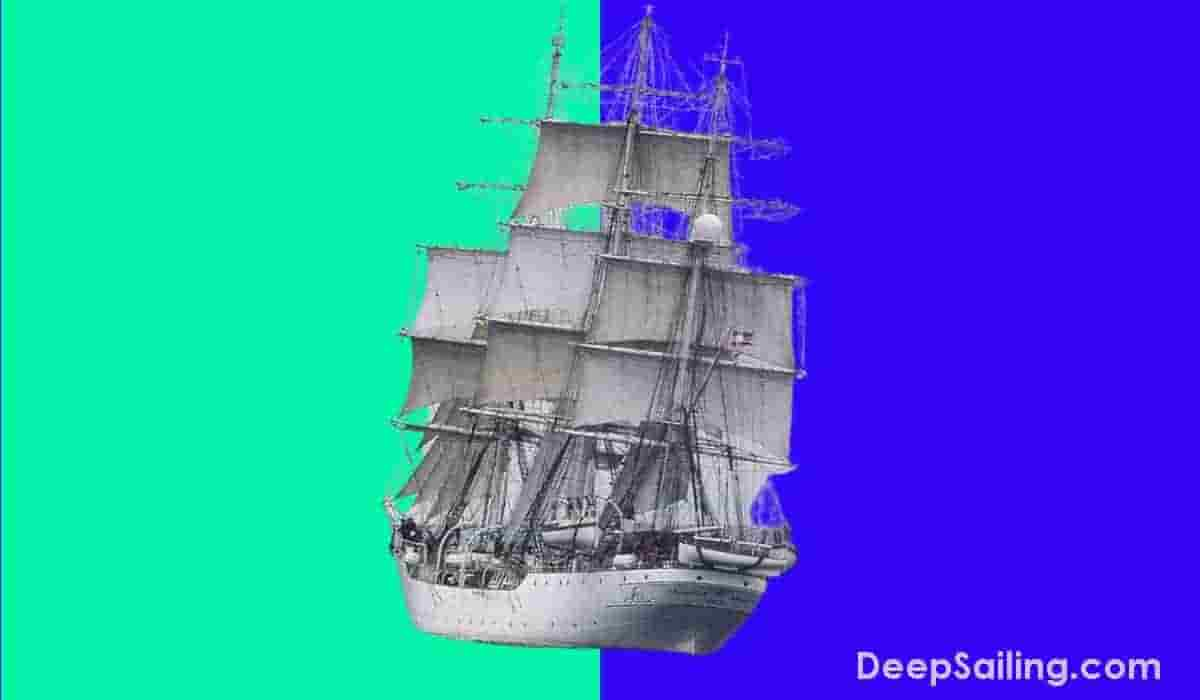
A fully rigged ship, also referred to as a "full-rigged ship", is a sailing ship with three or more masts, with all of the masts being square-rigged and the rig, hull, mast, and yards made of iron, wood, or steel.
A full-rigged ship weighed an average 325 tons and could carry a crew of up to 36 people and these ships required a larger crew because of their fully rigged construction ( 15 ).
During the 18th century, a full-rigged ship was also referred to as a " frigate " and they were mainly used for patrolling and for attacking.
A full-rigged ship weighed an average 325 tons and could carry a crew of up to 36 people ( 16 ).
However, towards the end of the 19th century, these ships were stripped down so they could be handled by a smaller crew which helped in easier handling of the sails during the monsoon period when winds would change speed and direction without any warning.
This helped in easier handling of the sails during the monsoon period when winds would change speed and direction without any warning.
A fully rigged ship masts from stern to bow consists of: ( 17 )
- Mainmast : This is the tallest mast on the ship
- Foremast : This is the second tallest mast on the ship
- Mizzenmast : This is the third tallest mast on the sailing vessel
- Jiggermast : If there is a 4th mast, it will be the jiggermast and will be the smallest mast on the ship
11. The Cutter
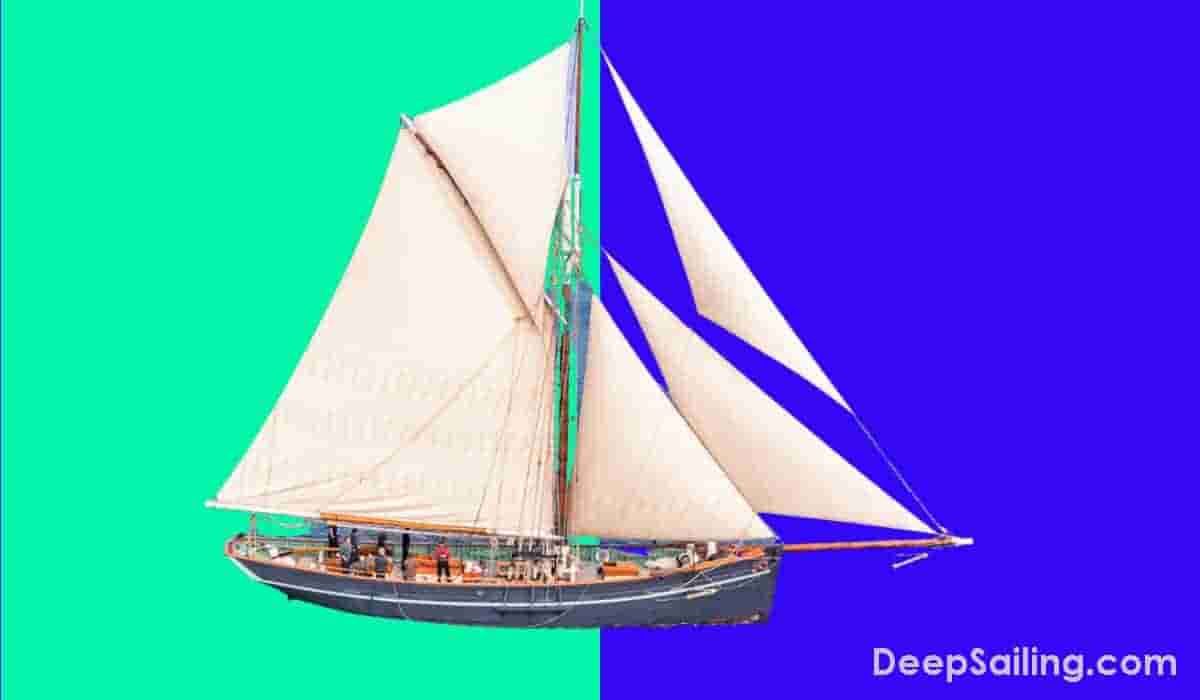
The cutter is a smaller sailing ship built in the early 18th century with a single mast rigged fore and aft and it varied in size from 20ft to 34 ft in length on average with a crew capacity of between 21 to 66 people ( 19 ).
A cutter sailing vessel features: ( 18 )
- Narrow hull
- 2 or more headsails
- Decked sailcraft
- Raking transom
- Vertical stem
- A gaff-rigged long bowsprit
This sailing ship was used for patrolling territorial waters and other enforcement activities during the 18th century and it was used to ferry soldiers and government officials because it was very fast and could outrun any enemy.
Modern-day cutters have a rugged appearance, are small and aptly fit into their intended purpose – speed and agility and the British Sailing Club still has open-oared cutters in their fleet of sailing ships.
12. The Yawl
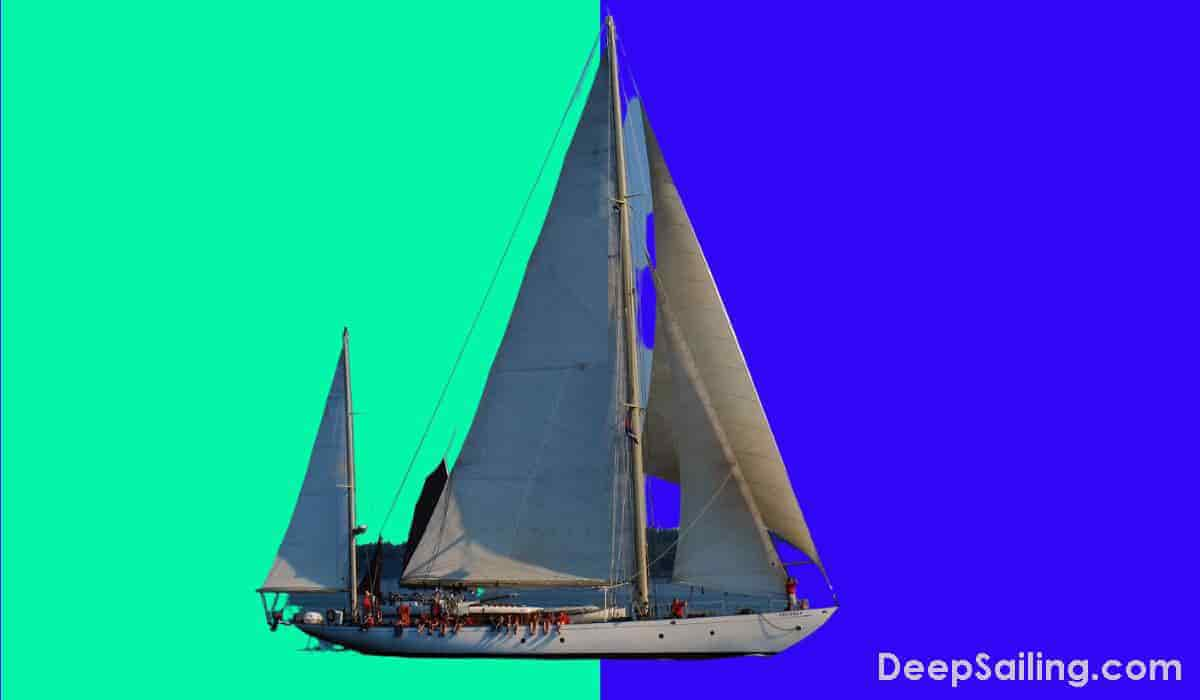
A Yawl is a sailing ship that was originally that was originally a dutch ship nicknamed " Dandy " or " Jol " in Dutch built in the 19th century with a speed range from 10-14 knots, an average crew size of 25 people and a ship size ranging from 30ft to 75ft in length with beam sizes ranging from 10ft to 12ft.
They bore two fully-equipped masts and a fore-and-aft sail, a smaller jigger-mast and a mizzen mast that leans towards the rudder post of the ship with the mizzen sail in this case purposely designed to aid in balancing and trimming the ship on rough waters.
One famous yawl sailing ship is the Islander which was a 34ft yawl that Harry Pidgeon sailed around the world on. He was the second person in 1918 to sail around the world at that time.
13. The Brig
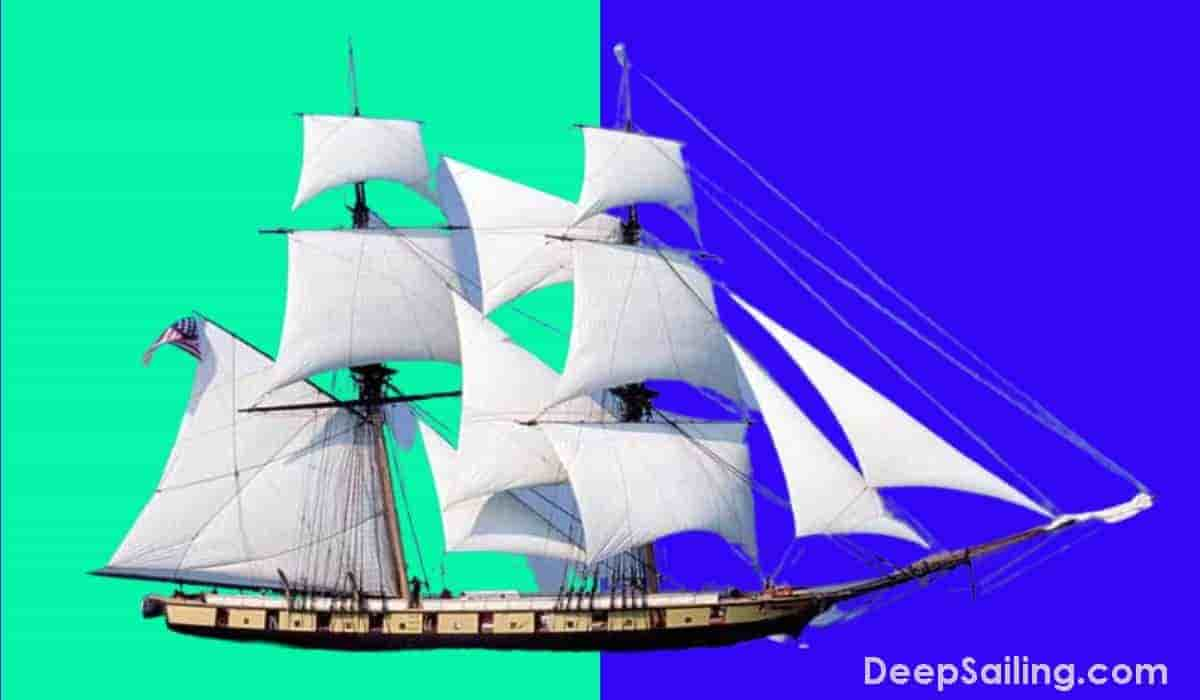
The brig is a two-masted sailing ship that was originally built in the 18th century with square rigging on both masts and sometimes had a spanker on the aft mast.
The length of a brig varied from 75ft to 165ft with tonnages up to 480 ith tonnages up to 480 and it needed a crew of 22 people ( 20 ).
The brig was used as a war vessel and a cargo ship for transporting goods and they were later used to ferry large cargo on the open seas since they could easily follow the direction of the prevailing winds.
It came with a berthing deck that had sleeping quarters for cabin crew and marine officials, storage areas, a sail bin, a wood-paneled stove room, guns, and carronades.
They would be brought into the harbor without using tugs and could maneuver well in small areas.
Famous brig ships are listed below.
- USS Argus : This was a United States Navy brig that fought in the First Barbary War, taking part in the blockage of Tripoli and the war of 1812
- USS Reprisal : This was the first ship of the United States Navy
- USS Somers : This was a brig in the United States Navy that became infamous for being the only US Navy ship to undergo a mutiny
14. The Ketch
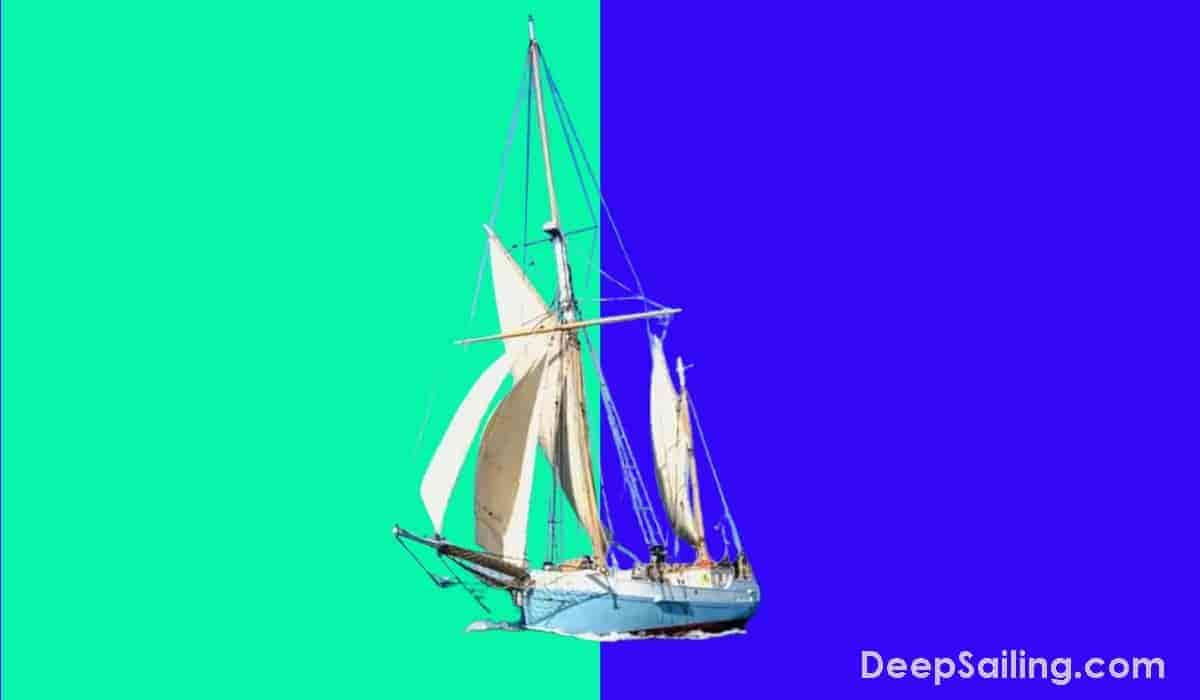
A ketch is a two-masted sailboat that originated in the 17th century with most ketch ships ranging from 40ft to over 120ft in size and weighing between 100 and 250 tons. A ketch ship needed a smaller crew of only 4 people to operate ( 21 ).
The ketch looked just like the Yawl and as stated had two masts each having a fore-and-aft rig with the difference between the two being that the ketch had a mizzen mast placed on the taller mainmast but at a position in front of the rudder post. The mizzen in this case aided in maneuvering the vessel.
A ketch ship was used for:
- Cargo Transportation
15. The Hulk
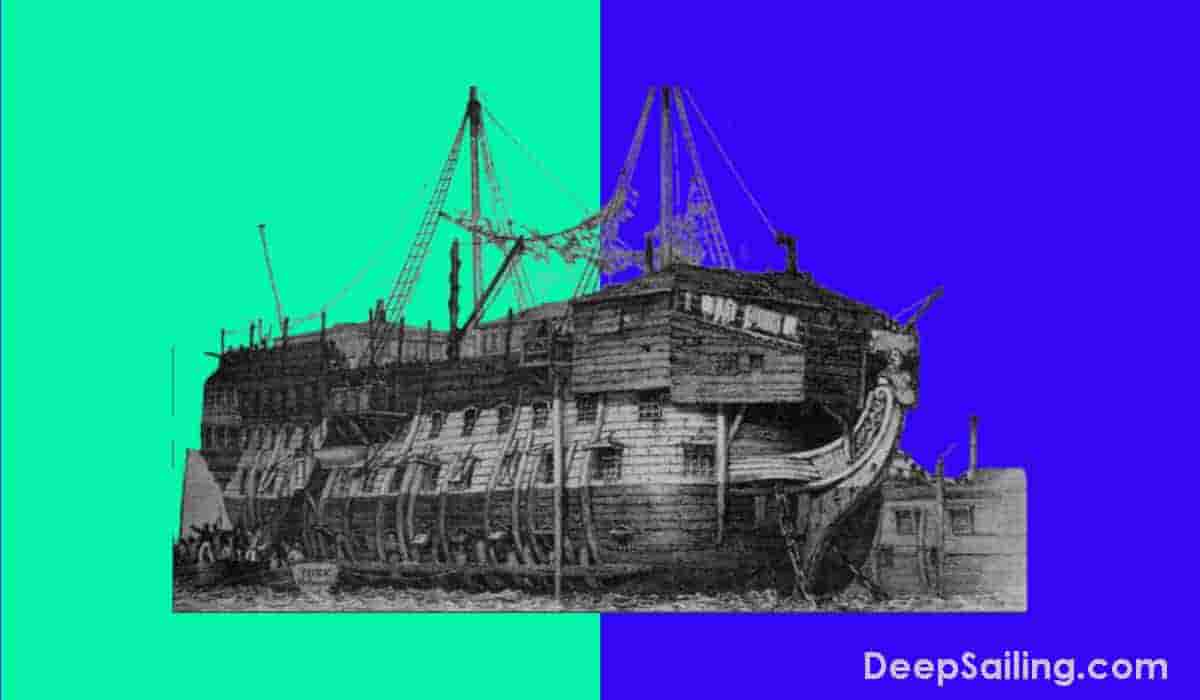
A hulk is an 18th-century ship that is a derivative of the Carrack with a weight of 400 tons that is afloat but incapable of going to sea. In maritime terms, the name "Hulk" was given to ships that were outdated, stripped down or unprofitable to run.
The bulk of the hulk fleet was comprised of abandoned ships, stripped down and therefore could not continue to ply across the Mediterranean Sea as cargo or transport ships.
They are stationary and kept for their buoyancy and were used as a prison, a place for gambling.
- Maritime Museum Of The Atlantic. " Sailing Ship Rigs ".
- The New York Times. " America's Cup Held Here Since 1851 ", PDF.
- World History Encyclopedia. " Carrack Definition ," Paragraph 3.
- Same As Reference 3
- Military History. " Carracks, Famous Carracks ," Paragraph 9.
- " Aken, tjalken en kraken " by Hans Haalmeijer & Dirk Adrianus Vuik, Page 12.
- Google Books Ngram Viewer. " Brigantine ".
- Gaspee Info. " Brigentines Described ," Paragraph 3.
- Wikipedia. " Barquentine ," Paragraph 1.
- " Ship: 5000 Years Of Maritime Adventure " by Brian Lavery, Page 137.
- Oxford English Dictionary (Online Edition). " Barque ".
- University of Houston. " No. 338 Clipper Ship ". Paragraph 2
- Marine Insights. " Windjammer Sailing Ships: From Past to Present ". Paragraph 8
- History Today. " Dutch Shipbuilding in the Golden Age ". Volume 34, No. 1
- " The Story Of The Sea, Volume 1 " by Arthur Quiller-Couch, Page 20.
- Whaling Museum. " Rigs Of Vessel, Ship ," Paragraph 1.
- " A Dictionary of Sea Terms " by Anstead, A, Page 96.
- Britannia. " Cutter, Sailing Craft ". Paragraph 1.
- " The Boats Of Men Of War " by William May & Simon Stephens
- Texas Navy Association. " Glossary Of Nautical Terms ". Page 1
- National Museum Of American History. " Ship Model, Ketch ". Paragraph 1

All You Need to Know: Explaining the Different Types of Sailboats
Sailboats are a type of watercraft that are powered by the wind. They come in a variety of shapes and sizes, each with its unique characteristics and features. Understanding the different types of sailboats and their uses can be helpful for those who are interested in sailing or looking to purchase a sailboat.
Several factors determine the types of sailboats, including the hull type , keel type , mast configuration, and sails and rigging . The hull is the boat’s body and can be either a monohull, catamaran , or trimaran .
The keel is the underwater part of the hull that provides stability and can be either a fin keel, wing keel, bilge keel, daggerboard, or centerboard. The mast configuration and sails determine how the boat is powered, and can be a sloop, fractional rig sloop, ketch, schooner, yawl, cutter, or cat.
Types of Sailboats
Sailboats come in many different shapes and sizes, each designed for a specific purpose. Here are the most common types of sailboats:
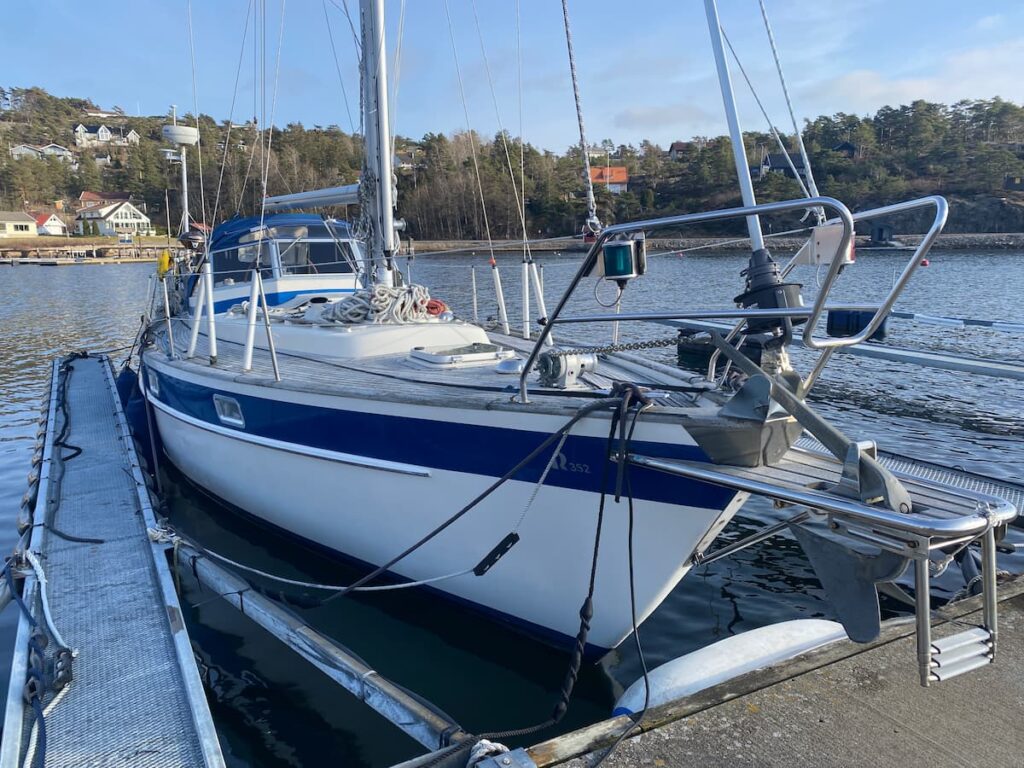
Cruising Sailboats
Cruising sailboats are designed for long-distance sailing and living aboard. They typically have a spacious interior with a galley, head, and sleeping quarters. They also have a large fuel and water capacity to allow for extended time at sea. Cruising sailboats come in many different sizes, from small pocket cruisers to large bluewater yachts.
Racing Sailboats
Racing sailboats are designed for speed and agility. They typically have a lightweight hull and a tall mast with a large sail area. Racing sailboats come in many classes , from dinghies to large offshore racing yachts. They are designed to be sailed by a skilled crew and require a high level of skill and experience to handle.
Daysailers are designed for short trips and day sailing. They typically have a simple interior with minimal accommodations. Daysailers come in many different sizes, from small dinghies to larger keelboats. They are easy to handle and are a great choice for beginners or for those who want to enjoy a day on the water without the hassle of a larger boat.
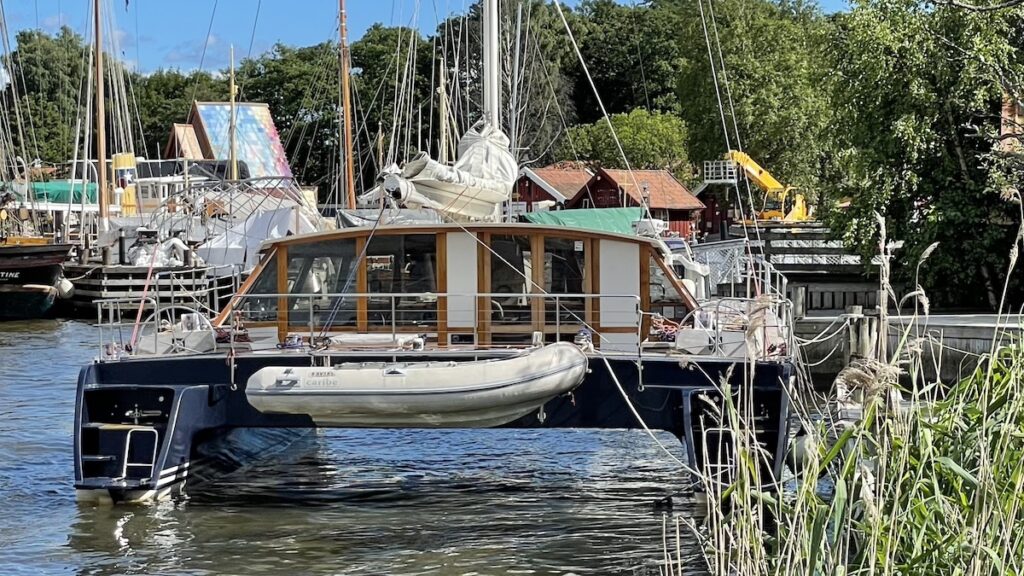
Catamarans are sailboats with two hulls. They are designed for stability and speed and are often used for cruising or racing. Catamarans have a spacious interior and a large deck area, making them a popular choice for those who want to live aboard or entertain guests. They are also popular for chartering and can be found in many popular sailing destinations around the world.
Trimarans are sailboats with three hulls. They are designed for speed and stability and are often used for racing or long-distance cruising. Trimarans have a narrow hull and a large sail area, making them incredibly fast and agile on the water. They are also popular for their spacious interior and large deck area, making them a great choice for those who want to live aboard or entertain guests.
Sailboat Hull Types
When it comes to sailboats, there are two main categories of hull types: monohull and multihull. Each has its unique characteristics and advantages.
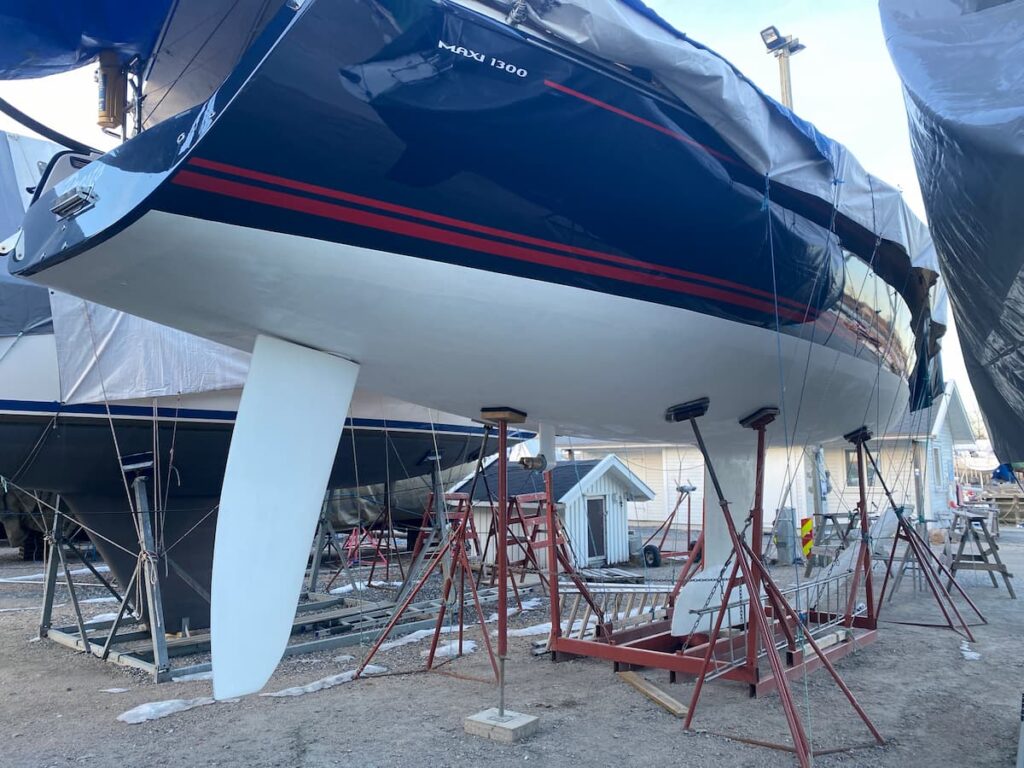
Monohull Sailboats
Monohull sailboats are the most common type of sailboat. They have a single hull, and the hull is typically long and narrow, which makes them more efficient when sailing upwind. Monohulls come in a variety of styles, including:
- Flat-bottom vessels
- Fin-keel racers
- Bulb and bilge keel cruisers
- Heavy semi-displacement sailboats
- Dense full-keel displacement cruisers
Each of these styles has its advantages and disadvantages. For example, flat-bottom vessels are the most stable, but they don’t work well in deep waters. Fin-keel racers are designed for speed and performance but may not be as comfortable for long-term cruising.
Multihull Sailboats
Multihull sailboats have two or more hulls. The most common types of multihulls are catamarans and trimarans. Multihulls have several advantages over monohulls, including:
- More stability
- Better performance in light winds
Catamarans have two hulls, which are connected by a deck. They are known for their stability and spaciousness. Trimarans have three hulls, which make them even more stable and faster than catamarans. However, they are not as spacious as catamarans.
Sailboat Rigging Types
When it comes to sailboat rigging types, there are several options to choose from. Each type of rig has its advantages and disadvantages, and choosing the right one will depend on a variety of factors, including the type of sailing you plan to do and the size of your boat . Some of the most common sailboat rigging types include:
The sloop rig is one of the most popular sailboat rigging types and is commonly used on boats ranging in size from small dinghies to large cruisers. It consists of a single mast with a mainsail and a jib or genoa. The mainsail is typically a triangular shape, while the jib or genoa is a smaller sail that is used to control the boat’s direction.
The cutter rig is similar to the sloop rig but with an additional headsail. This makes it a popular choice for sailors who want more control over their boat’s speed and direction. The mainsail is still triangular, but the headsail is typically smaller than the jib or genoa used in a sloop rig.
The ketch rig is a two-masted sailboat rigging type that is commonly used on larger boats. It consists of a main mast and a smaller mizzen mast located aft of the cockpit. The mainsail is typically triangular, while the mizzen sail is smaller and located behind the cockpit. The ketch rig is known for its versatility and is often used for long-distance cruising.
The yawl rig is similar to the ketch rig but with a smaller mizzen mast located further aft. This makes it a popular choice for sailors who want more control over their boat’s direction, especially in heavy winds. The yawl rig is also known for its ability to sail close to the wind, making it a popular choice for racing sailors.
Sailboat Sails
Several types of sails are commonly used on sailboats . Each sail has a specific purpose and is designed to work in different wind conditions. The main types of sails include mainsails, jibs, genoas, and spinnakers.
The mainsail is the largest sail on a sailboat and is typically located behind the mast. It is attached to the mast and boom and is used to capture the wind and propel the boat forward. The mainsail is the most important sail on the boat and is used in a wide range of wind conditions.
The mainsail can be adjusted in several ways to optimize its performance. The sail can be reefed, or reduced in size, to reduce the amount of sail exposed to the wind in high winds. The sail can also be twisted to adjust the shape of the sail and improve its performance in different wind conditions.
The jib is a smaller sail that is located in front of the mast. It is attached to the mast and forestay and is used to help balance the boat and improve its performance in light wind conditions. The jib is typically used in conjunction with the mainsail and can be adjusted to optimize its performance.
There are several types of jibs, including the working jib, the genoa jib, and the storm jib. The working jib is the most common type of jib and is used in moderate wind conditions. The genoa jib is a larger jib that is used in light wind conditions, while the storm jib is a smaller jib that is used in high wind conditions.
The genoa is a large jib that is used in light wind conditions. It is similar to the jib but is larger and overlaps the mainsail. The Genoa is attached to the mast and forestay and is used to capture as much wind as possible to propel the boat forward.
The Genoa is typically used in conjunction with the mainsail and can be adjusted to optimize its performance. It can be furled, or rolled up when not in use to reduce wind resistance and improve the boat’s performance.
The spinnaker is a large, balloon-shaped sail that is used for downwind sailing. It is typically used in light wind conditions and is attached to a spinnaker pole to keep it away from the boat’s mast and sails.
The spinnaker is used to capture as much wind as possible and propel the boat forward. It is typically used in conjunction with the mainsail and jib and can be adjusted to optimize its performance.

What factors determine the types of sailboats?
The factors that determine the types of sailboats include hull type, keel type, mast configuration, and sails and rigging.
What are the two main categories of sailboat hull types?
The two main categories of sailboat hull types are monohull and multihull.
What are some common sailboat rigging types?
Common sailboat rigging types include sloop rig, cutter rig, ketch rig, and yawl rig.
What are the main types of sails used on sailboats?
The main types of sails used on sailboats include mainsails, jibs, genoas, and spinnakers.
What are the differences between a catamaran and a trimaran?
A catamaran has two hulls connected by a deck, while a trimaran has three hulls. Trimarans are generally more stable and faster than catamarans, but they are not as spacious.
- Recent Posts
- The Role of Cargo Ships in Global Trade – August 22, 2024
- Report: Yang Ming’s YM Mobility Explosion at Ningbo-Zhoushan Port – August 9, 2024
- Understanding Drillships: Types, Key Features and Advancements – August 1, 2024
About the author
I worked as an officer in the deck department on various types of vessels, including oil and chemical tankers, LPG carriers, and even reefer and TSHD in the early years. Currently employed as Marine Surveyor carrying cargo, draft, bunker, and warranty survey.
Latest posts

The Role of Cargo Ships in Global Trade
Contents show Volume of Goods Transported by Sea Key Global Trade Routes Economic Impact of Maritime Shipping Types of Cargo Commonly Transported Environmental Considerations Conclusion Cargo ships are the lifeline […]

What Are AGVs? Automation Becoming Increasingly Common in Seaports
What are AGVs? Automated guided vehicles can minimize the troubles of manual operations and enhance seaport operations.
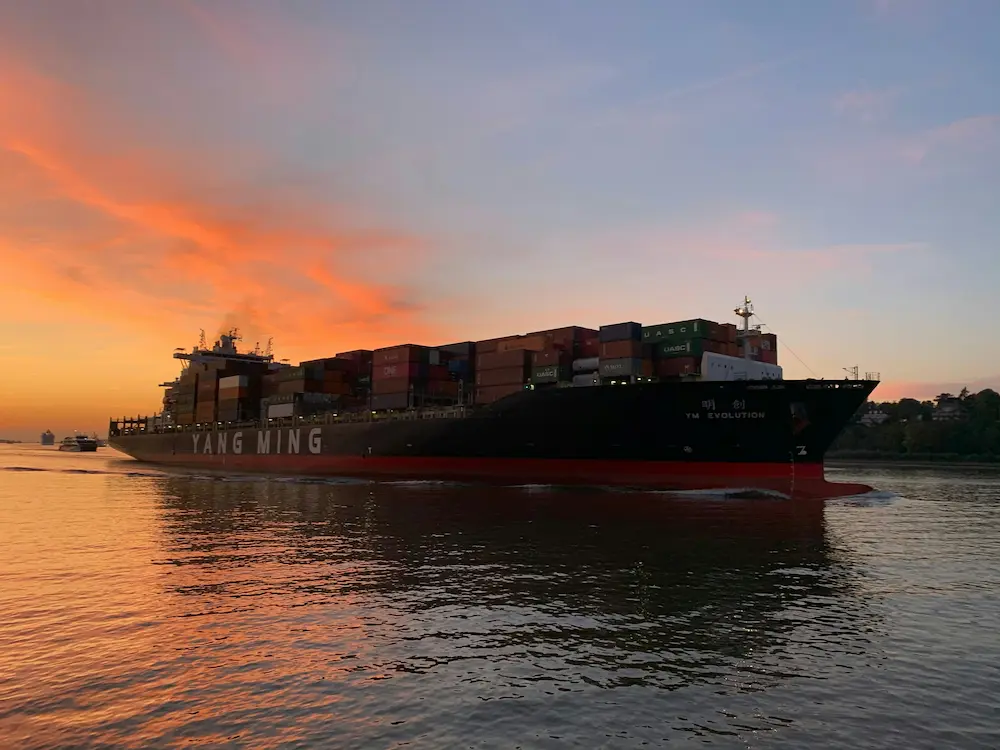
Report: Yang Ming’s YM Mobility Explosion at Ningbo-Zhoushan Port
A massive explosion occurred on the container ship YM Mobility while it was berthed at the Ningbo-Zhoushan Port in China

My Cruiser Life Magazine
Sailboat Types: Full-Guide
For generations, sailing has been a mode of essential transportation, a rewarding hobby, an active and competitive sport, and a lifestyle. Sailing appeals to all, and there are dozens and dozens of types of sailboats.
Small sailboats are perfect for kids to sail on, and massive sailboats are used to cross oceans in style. In between, there are daysailers, racers, and cruisers.
Table of Contents
- What Does a Sailboat Look Like?
Small Sailboats
Cruising boats, cruising catamarans, cruising trimarans, full keel boats, fin keel boats, centerboard keel.
- Hydrofoil Sailboats
A Purpose for Every Type of Sailboat
Faqs (frequently asked questions).
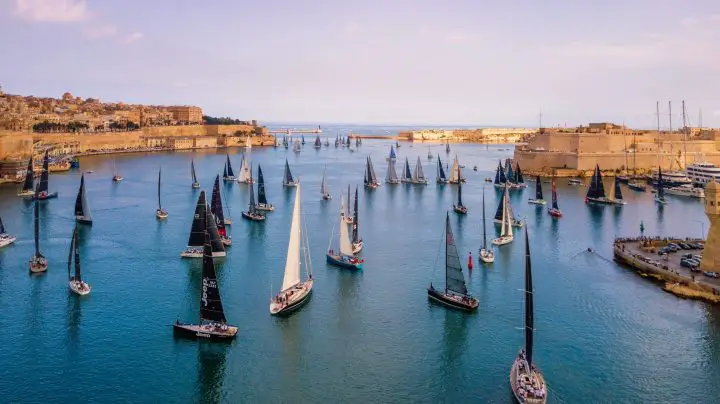
What Are Sailboat Types?
Sailboats are boats that are propelled by the wind. Sailboats use wind power instead of a motor or oars to move the boat. It should be noted, though, that nearly all modern sailboats have a motor as well. It comes in handy when docking in tight marinas and if the wind dies!
A sailboat has one, two, or three hulls. It has at least one mast, or tall vertical spar, that holds up one or more sails. The sails harness the power of the wind to move the boat forward.
To get started, here are some sailing boat types and terms to give you an idea of the sorts of boats that are out there.
- Dinghies — a small open boat, usually for only one or two people
- Daysailors — boats designed to go out for a day trip
- Cruising Sailboats — boats designed to travel long distances that have accommodations for their crew to live aboard a long term
- Sloop — the most common type of sailboat, with one mast and two sails (a jib and a mainsail)
- Ketch, yawl, or schooner — types of sailboats with two or more masts
- Monohull — a boat with only one hull
- Catamaran — a boat with two equal-sized hulls in the water that are connected together by a bridge deck
- Trimaran — a boat with three hulls in the water, the center of which is much larger than the outer two
What Does a Sailboat Look Like?
There are many different types of sailboats, so they look a little different from each other. The basics, however, are the same.
Each sailboat has at least one hull that sits in the water. Part of the hull is visible above the waterline. Part of the sailboat hull sits below the waterline.
The part beneath the waterline might be relatively small, or it can be quite large. The rudder, the mechanism used to steer the boat, is also underwater.
The cockpit is where the helmsperson sits and steers the boat. On small boats, the cockpit takes up the entire boat. Cruising boats have interior accommodations as well as a safe cockpit.
Sailboats have at least one mast and at least one mainsail. As you get to know the different types of sailboats, you’ll see many different hull and sail configurations.
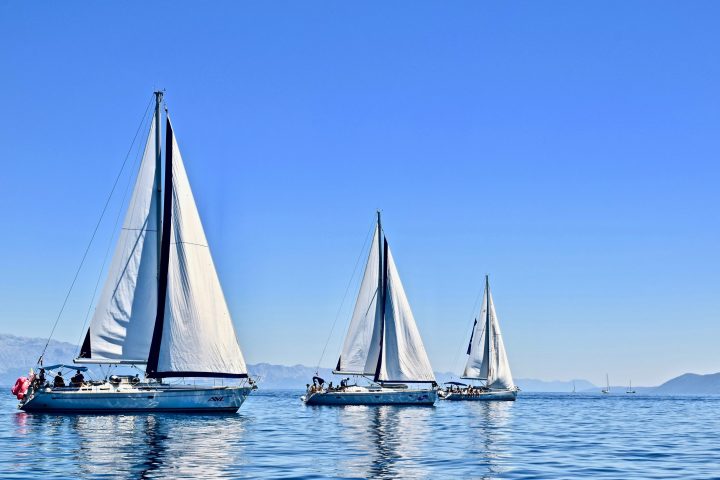
Different Types of Sail Boats
Sailboats come in all types of sailboat shapes and sailboat sizes . Sailboats can be classified by their hull shape, size, or sail plan. The sail plan is how many sails they carry on how many masts.
Hull shapes include monohulls, catamarans, trimarans, and sailing hydrofoils. A monohull has just one hull, a catamaran has two hulls, a trimaran has three hulls, and a hydrofoil lifts out of the water.
Sizes range from eight-foot sailboats to megayachts that are hundreds of feet long. Some sailboats are so small they are only suitable for one child who wants to go skimming across the lake. The largest pure sailing yacht in the world is the Black Pearl at 350 feet long (106.7 meters) long. Visit our Yacht vs Sailboat guide for a more definitive difference between the two and their sizes.
Sailboats also have different sail configurations or sail plans. For example, a sailboat with just one big sail on a forward-mounted mast is called a catboat. A boat with dozens of different sails on three masts is called a three-mast schooner.
Small sailboats are extremely popular and offer a lot of fun to the young and old. Most of the time, these boats are just used for daytime use in pleasant weather conditions. Kids often learn to sail in small monohull sailboats. Families might go for a picnic in a Hobie catamaran.
Yacht club members might race their 16-foot daysailors, while adventurous souls might take their 19-ft weekender and anchor in a calm cove for the weekend.
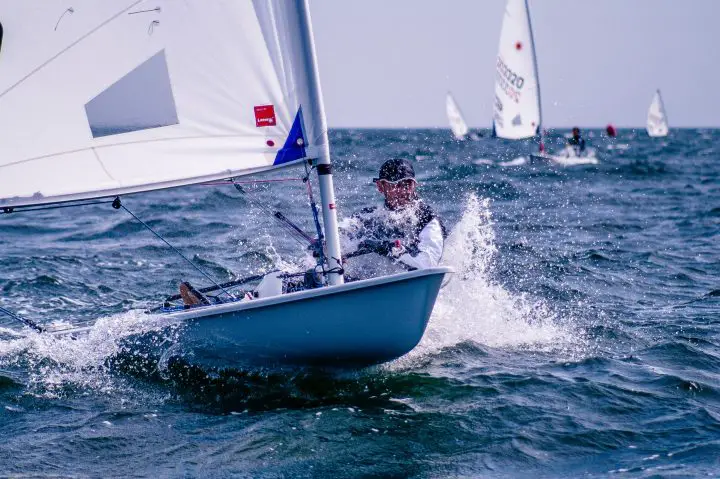
What is a Small Sailboat Called?
Small sailboats have different names, depending on the type of sailboat and the number of sail boat hulls. For example, the boat might be a monohull dinghy, small catboat, small catamaran, or daysailor.
Additionally, like every car on the road, every boat on the water is identified by its make and model. In small boats that are commonly raced, a certain make and model may set up a class of racing boats. Class racing means that all of the boats are identical, so the race is based solely on the skills of the skippers.
Sailing Dinghies
Kids and adults often learn to sail on sailing dinghies. Sailing dinghies can be as small as eight feet long. This small size makes it easy for kids to handle.
Some common sailing dinghies are Optis, Lasers, and Sunfish.
This size sailboat is also functional. They can be used to ferry sailors from their larger anchored boats to shore. The small size also helps sailors easily store their dinghy on larger boats. The word dinghy is often used to refer to any small boat used as a tender for a larger vessel, even if the tender is a motorboat.
Cat Rig Boats
A cat rig boat, or cat boat, is a type of sailboat that usually just has one large mainsail and a forward-mounted mast. Many smaller dinghies and training boats are catboats. A catboat has a free-standing mast with no standing rigging.
Small Catamarans
A catamaran is a boat with two hulls. The Hobie brand is synonymous with small catamarans, which are popular with families looking for a fun hobby. Hobie Cats are seen on the sand at beach resorts all over the world—they’re safe, fun, and fast.
Catamarans are faster than monohulls, and these boats are fun to race. Small catamarans are often used by families that live on the waterfront. Their lightweight makes them easy to drag to the waterfront and launch.
Small catamarans are also popular on beaches. Many beach resorts offer Hobie cats for rent. Small catamarans are between 12-20 feet in length. The hulls are joined only with spars and netting, so these fast and light open boats are not set up to carry a lot of people or supplies.
Daysailors are the ultimate fun boat. As the name implies, this type of sailing boat is used for day sailing. These boats are usually between 12 to 20 feet long. Some use these smaller boats for racing or overnight camping, but most sailors use daysailors for a leisurely sail.
Small Sailboats with Cabins
While most small sailboats just have a large open cockpit, several small yacht types have cabins. These cabins offer a chance for sailors to use a porta-potty or get out of the sun. Some small sailboats even have sleeping accommodations for overnight stays.
An excellent example of this is the Cape Dory Typhoon Weekender. This small sailboat is known as “America’s Littlest Yacht.” Down below, there are two small bunks for sleeping and enough space to have a small stove and a porta-potty. Most owners don’t stay aboard long-term, but the cabin is a useful place to stow items while sailing or to hide during a rainstorm.
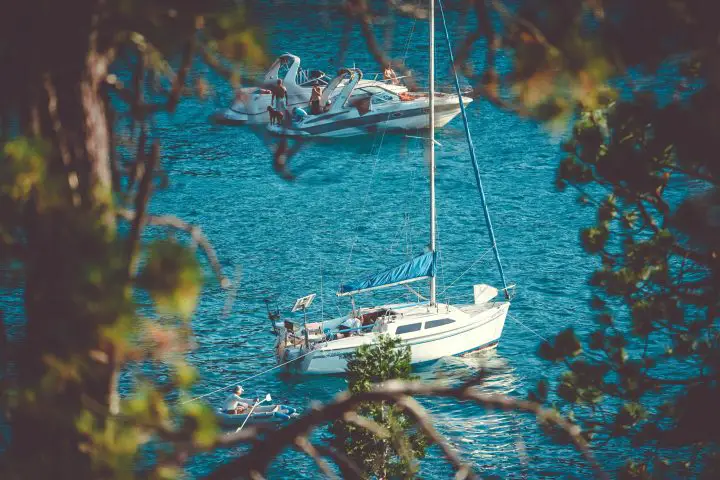
Cruising boats are boats that are capable of traveling long distances. Cruising boats have sleeping accommodations, cooking facilities, and bathroom facilities. These boats are like RVs for the waterway.
Cruising boats offer sailors the chance to live on their boats while sailing. Like RVs, cruising sailboats travel to different ports of call. Cruising sailboats are one of the more popular types of sailing boat. They offer adventurous sailors the chance to enjoy sailing as a sport while seeing new things.
Cruising boats are usually 30 to 50 feet long. Most cruising couples prefer a boat that is around 40 feet long since this provides enough space to live comfortably and enough storage space for all of their gear.
Monohulls are very popular cruising boats. These boats offer good storage, are safe, and are easy for a couple to handle together. Monohulls have different types of sail configurations.
Cruising Bermuda Rigged Sloops
Most monohulls are Bermuda rig sloops. This sail plan features one mast with a mainsail and a headsail. Bermuda rig sloops are easy to single-hand and very versatile. How many sails does a sloop have? A Bermuda sloop flies two sails at a time, which are the mainsail and a headsail.
However, the boat might have other sails onboard. For example, the captain might take down the jib in light winds and use a bigger genoa to capture more wind power. During a downwind sail with light winds, the captain might rig a large spinnaker, which looks like a huge kite, to keep sailing even in little wind.
Even within the sloop category, there are many variations in the design. A masthead sloop is one whose forestay (headsail) goes all the way to the top of the mast. In contrast, a fractional sloop’s forestay connects at some point lower. So a 3/4 fractional rig has a headsail that only goes up three-quarters of the way to the top.
Riggers and boat designers have a lot of tools in their toolbox from which they can make a boat faster or more user-friendly. The type of rigging and sail plan a boat is equipped with offers it performance improvements as well as functionality.
Cruising Cutter
A cutter is a sailboat with one mast, one mainsail, and two sails forward of the mast. The sail at the front of the boat is the jib, genoa, or yankee depending on its size and cut. The next sail in, the inner headsail, is called the staysail. Island Packets are popular boats with this sail plan.
Cutters are popular choices as cruising and bluewater cruiser boats because the staysail provides the skipper with many different sail options. They could fly all three sails fully, or they could fly a small partial mainsail and just the staysail for heavy winds.
Cruising Ketch With Mizzen Sail
Some cruising monohulls are ketches. A ketch can be easily identified by its two masts. The forward mast is the main mast with a mainsail. The aft mizzen mast is shorter and has a mizzen sail. This sail plan can make it easier to carry a big sail area and configure the sails for various sailing conditions.
A boat with more than one mast is called a split rig because the rig is split between two shorter masts instead of all mounted on one tall one. The advantage of a split rig is that there are more sails, each of which is smaller. That makes them easier to handle, and important consideration when you are sailing alone or with only one other person.
Cruising Yawl
A yawl is similar to a ketch and has two masts. However, the mizzen mast on a yawl is aft of the rudder post, whereas it is forward of the rudder post on a ketch. This mizzen mast location is even further back than a ketch’s. Yawls are one of the less popular types of sailboats. However, like the ketch, they offer diverse sail options and can keep sailing in many different types of weather.
On both ketches and yawls, the mizzen mast is shorter than the main mast. If the two masts are of equal height, or the forward mast is shorter, then you are looking at a schooner.
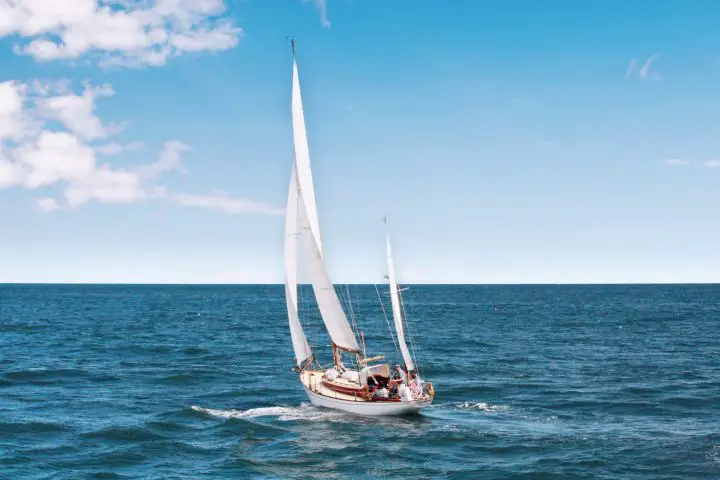
Cruising catamarans are one of the most popular classes of sailboats right now. This type of sailing boat has two hulls and offers sailors speed, space, and comfort. A cruising catamaran is usually between 40 and 60 feet long and 20 to 30 feet wide. The additional width offers cruise sailors huge amounts of space.
Cruising catamarans have excellent storage space and ample living accommodations if you intend to living on a boat . These boats are popular with couples and families and are often used to sail around the world on circumnavigations.
Cruising catamarans are usually fractional sloop rigs. They have one mast, a large mainsail, and a jib or genoa. In general, these boats are designed to be easy to sail and minimize complications.
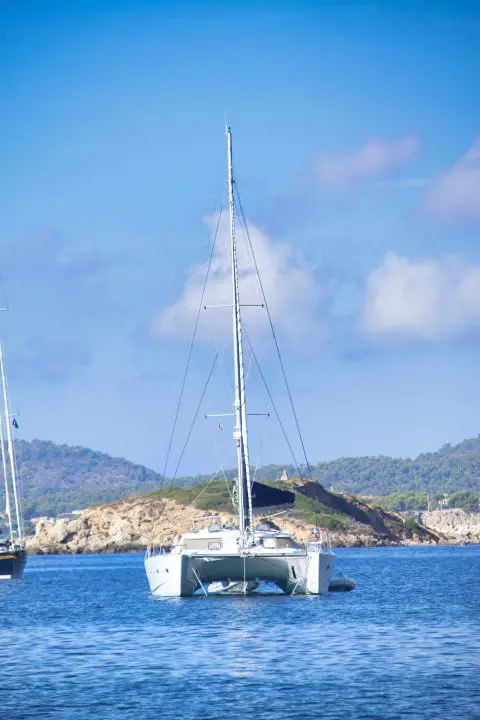
Trimarans are a type of sailboat with three hulls. Trimarans are known to be fast and are popular with racing sailors. However, they are also gaining popularity as cruising boats. These boats usually have fewer accommodations than cruising monohulls and catamarans. However, more modern trimarans like the Neel Trimaran have luxurious living spaces.
Types of Keel
Another way to classify the different types of sailing boats is by looking at the boat’s keel type. You can easily get an idea of different keel designs by walking around a boatyard. When a sailboat is in the water, it is hard to tell the shape of its keel.
The keel is the bottom part of the hull and is underwater. The keel is structurally essential. The keel’s weight helps the boat sail evenly and uprightly. The force created by the water moving over the keel counteracts the effects of the wind on the sails.
So a keel does two jobs for a sailboat. First, it provides a force that allows a sailboat to sail into the wind. Second, it provides stability. If storm-force weather conditions cause a monohull boat to roll, the weight in the keel will help the boat right itself.
Many older cruising boats had full keels. The keel shape runs the entire length of the boat. A full-keel boat is strong and easy to manufacture. Full-keel boats often have deeper drafts. The boat’s draft refers to the amount of water it needs to float. Full-keel boats can’t go into the shallow anchorages that catamarans or swing-keel boats can access.
Captains often report that full-keel boats are harder to maneuver in tight places such as marinas. Full-keel boats lack quick maneuverability. They have a reputation for being slower than more modern designs, but they make up for this by providing a very comfortable and safe ride in rough weather.
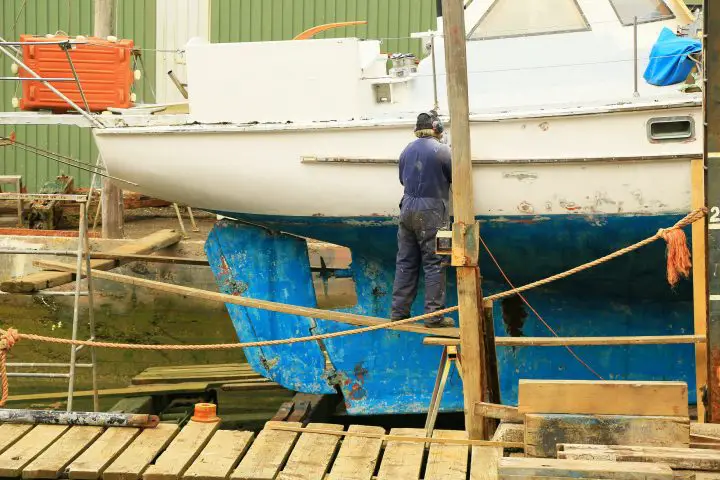
A boat with a fin keel has a smaller underwater profile than a boat with a full keel. This smaller keel resembles a fish fin. Captains find fin keel boats easier to maneuver. Fin keels use their shape to create very effective forces underwater. That makes them very good at countering the forces on the sails, meaning that fin keels sail upwind very well.
A boat with a bulb keel has a torpedo-shaped bulb on the bottom of a fin keel. Bulb keels offer improved stability. Bulb keels have shallower keels than a fin keel boat. The bulb also lowers the center of gravity in the boat, making it more stable overall.
A wing keel features a keel with a small wing on either side of the keel. Viewed from above, the keel looks like it has a set of small airplane wings.
Similar to a bulb keel, wing keel boats often have a shallower draft than fin-keel boats. However, the additional shape causes drag and can reduce sailing performance in some circumstances.
A centerboard is common on small daysailors that are launched and retrieved from trailers. Deep keels make getting those boats in and out of the water difficult. By chopping off the keel, you can make a sailboat as easy to launch as a powerboat.
Related: Best Trailerable Sailboats
But of course, a sailboat needs to have a keel. A centerboard is a simple swinging fin keel that can be raised or lowered. This provides some excellent benefits if the sailor on board likes to explore areas with shallow water.
Many bigger boats have centerboards, too. A boat with a centerboard can be seen as the best of both worlds. A centerboard boat has a fixed shallow draft keel. However, the captain can deploy the centerboard when sailing in deeper waters. The centerboard adds depth to the keel and offers increased stability and performance.
A modification of the centerboard is the swing keel — a ballasted keel that can be retracted like a centerboard . These are rare. They’re used on large cruising boats where the crews want the option of accessing shallow waters. In England, this type of boat is used and can be dried out when the tide goes out.
Racing Sailboats
Yacht racing is a popular sailing sport. It’s a great way to get out on the water while competing. In fact, racing is a great way for sailors to hone their sailing skills. Sailors have to pay close attention to weather conditions and manage their sails effectively to maximize their speed.
Sailors can race any boat with sails. Kids race sailing dinghies against each other. Club racers sail daysailors or catboats. Catamarans and trimarans are also popular race boats. Several classes of boat races in the Summer Olympics.
Hydrofoil Sailboats
A hydrofoil is a unique and modern type of racing sailboat. A hydrofoil can be a monohull, catamaran, or trimaran. A hydrofoil has wing-like foils on the hull’s underside.
As the sailboat speeds up, the hydrofoils lift the hull out of the water, and the hydrofoil sailboat almost appears to be flying above the water.
Because the hull is now out of the water, drag, and resistance are minimal, and the sailboat can sail even faster. For example, a dinghy that usually goes four knots can accelerate to 12 knots when fitted with a hydrofoil.
Most hydrofoil sailboats are catamarans and trimarans. The added width of these multihull sailboats gives the hydrofoil sailboat more stability.
Traditional Sailboats
Traditional sailboats are the type of sailboats used to transport people and goods before modern transportation options were available. Before the railway, cars, and airplanes, a tall ship sailboat was used to ship cargo and people across oceans and from port to port.
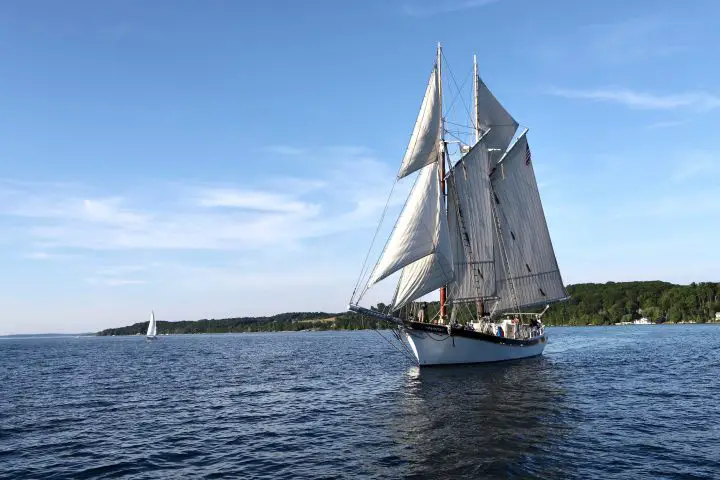
A gaff rig refers to the gaff, which is the upper spar on a square-shaped sail. Gaff rigs can be used with any mast configuration, but this feature is usually seen on traditional boats like a catboat, tall ship, or schooner.
A schooner has at least two masts. They are different from other mast configuration designs with two spars in that both masts are equal in height, or the forward mast is shorter. Schooners are faster than most traditional boats and were often used to transport perishable goods such as fruit.
Schooners were also popular race boats in the early 20th century. For example, first America’s Cup races were won by schooners.
Today, schooners are usually used as charters for vacations or youth sail training programs. But there are a few cruising boats out there that feature schooner rigs.
Any way you divvy it up, there are tons of different types of sailboats out there. With a little research and a little looking, you’re sure to find one that suits your style and boating plans.
What are the classes of sailboats?
Sailboat styles can be classified by hull type, use, or sail plan. The types of sailboat hulls include monohulls, catamarans, and trimarans. You can also categorize the kinds of sailboats by their use. For example, sailors use their boats for daysailing, cruising, and racing. Finally, different kinds of sailboats have different sail plans. A sailboat might be a sloop, ketch, yawl, catboat, or schooner. The term “classes” has a particular meaning in sailing, however. Class racing is the competitive racing between boats of the same make and model—boats of the same “class” or of “one design.” There are hundreds of different classes of sailboats out there. Some of the most popular classes include the Laser and Sunfish classes.
What is a small 2 person sailboat called?
A small two-person sailboat is a dinghy. These small boats are fun to sail on protected waters. Many kids learn to sail in a sailing dinghy. There are dozens of makes and models of sailing dinghies available, some are used in Olympic sailing racing while others are just rowboats with sail rigs attached.
Matt has been boating around Florida for over 25 years in everything from small powerboats to large cruising catamarans. He currently lives aboard a 38-foot Cabo Rico sailboat with his wife Lucy and adventure dog Chelsea. Together, they cruise between winters in The Bahamas and summers in the Chesapeake Bay.
Leave a comment
Your email address will not be published. Required fields are marked *
Save my name, email, and website in this browser for the next time I comment.

- Aug 14, 2023
A Breakdown of the Different Types of Sailboats and Their Uses
Updated: Jan 8
To the untrained eye, all sailboats are pretty much the same (some are just bigger than others). They’re essentially floating vessels with a mast, a set of sails, and the ability to navigate the waters by harnessing wind power. But if you dive a bit deeper, you’ll see there are drastic differences in the designs, capabilities, and uses of each type of sailboat.
Whether you’re new to sailboats or already an American Sailing Association (ASA) certified skipper, knowing the difference between the different types of vessels is essential. We’ll provide you with a basic understanding of the different types of sailboats, the advantages of each, and which type of voyage they’re best used for.
Sailboat Rigging Types
When you start sailing, one of the first things you’ll notice is how complicated the rigging seems. The rigging system includes ropes, furling jibs, booms, winches, cables, chains, masts, and much more. It takes time to identify and understand each one, but each type of sailboat has a distinct rigging system. A few of the main types of rigging you can expect to see on the water include:
Sloop: The sloop is arguably the most common rigging system. With one mast and two sails (mainsail & headsail), this type of rigging is simple, but efficient and prepared for all types of situations.
Cutter: If you squint, you could easily mistake a cutter for a slope, but there are slight differences. A cutter has a smaller headsail and an additional staysail between the mast and forestay of the vessel. The extra sail allows for more stability and control in heavy winds.
Ketch and Yawl: Both the ketch and yawl rigging types have two masts. However, what makes them different is in a ketch rigging, the aft mast (mizzen) is taller than the one on a yawl. Also, it’s positioned in front of the rudder post. These riggings are known for their excellent balance and flexibility in most conditions.
Schooner: If you have ever toured older wooden ships built to sail around the world and explore the ocean, then you have probably been aboard a Schooner. This configuration can have two or more masts and the aft mast is taller than the forward one(s). These vessels are powerful and equipped for the long haul.
Types of Sailboats and Their Uses
There are many types of sailboats (not to be confused with rigging types), each with its own pros, cons, and uses. Here’s a look at five of the most popular sailboats and why sailors use them.

When most people think of sailboats, they think of sailing dinghies. These small sailboats are less than 15-feet long and can be sailed by one person or a small crew. In most cases, they have small sloop rigs, are monohulls, and are excellent as a first sailboat. Dinghies are also great for racing or using as a lifeboat for bigger vessels.
Pros of a dinghy: Easily managed, relatively inexpensive, and great for beginners.
Cons of a dinghy: Not much space, only designed for short trips, and not recommended for rough waters or harsh weather conditions.

A daysailer is like the dinghy’s older brother. It’s usually about 14-20 feet in length and sloop-rigged. As the name suggests, they’re best for day trips on the ocean. In most cases, daysailers have a small cabin or open cockpit. They’re designed more for fun rather than long distances.
Pros of daysailers: Easy handling, stable, and great for outings with family or friends.
Cons of daysailers: Assmaller boats, they aren’t designed for overnight trips or long voyages.

The catamaran is where luxury on the sea begins. Its two parallel and equal-sized hulls make the vessel much more stable and comfortable than its single-hull counterparts. It’s a highly customizable boat that can be small and sporty or large and luxurious, depending on your needs.
More experienced sailors use these types of sailboats for longer trips and smaller charter trips .
Pros of the catamaran: A lot of space, fast, and perfect for cruising at sea.
Cons of the catamaran: Since they have such a wide beam, it can be a challenge to find places to dock or maneuver in tight marinas.

If you’re drawn to the size and stability of the catamaran, but yearn for more speed and power then you’ll love the trimaran. Instead of two hulls, this bigger boat has three: a main hull in the middle, and two smaller outrigger hulls on its sides. It’s an excellent sailboat for racing and cruising due to its stability and speed.
Pros of trimarans: Ability to be very fast, stable, and less likely to capsize in rough waters than smaller sailboats.
Cons of trimarans: They’re larger boats, so it can be difficult and more expensive to dock or store them in certain places.
Cruising Keelboat

Suppose you want to take an overnight cruise or even a trip across the Atlantic Ocean. In that case, a cruiser is your best bet. These large-sized sailboats (usually more than 30 feet long) are designed to be comfortable and self-sufficient, which makes them ideal for long voyages.
Pros of Cruising Keelboats: Well-suited to go on long-distance cruises for weeks or months with the ability to support multiple passengers.
Cons of Cruising Keelboats: You’ll not only have to invest in the sailboat (including storage and upkeep), but it also requires a large crew and an experienced captain.
Frequently Asked Questions (FAQs) About Sailboat Types
What is the most common type of sailboat.
Sloop-rigged sailboats (particularly daysailers and dinghies) are among the most popular types of sailboats. However, generally, the most commonly used sailboat depends on who’s using it. For example, a racer will have much different needs than someone who just wants the right boat for cruising.
What’s the difference between a sailboat and a yacht?
In the U.S., the determination between a sailboat and a yacht is that a sailboat only uses wind power, while a yacht can use wind, a motor, or a combination of both. However, internationally, sailboats and all other boats are usually considered “yachts.” Size can also be a determining factor. For example, some people consider any boat longer than 40 feet to be a yacht.
What’s the best beginner sailboat?
If you don’t have any sailing experience , the best sailboats are usually smaller, easy to maneuver, and less complicated than multihulls. Some of the best small sailboats for beginners have tiller steering and no winches.
This can include vessels like small dinghies, catamarans (though these are multihull boats), rotomolded boats, and those that can be easily trailered to different locations.
What is the safest type of sailboat?
In most cases, larger cruising keelboats are usually considered much safer than smaller dinghies and catamarans. That’s because they’re less likely to capsize and can handle adverse weather more safely, which is especially useful for new sailors. However, sailboat safety depends on the sailor, type of boat, and conditions.
What are the most popular sailboat brands?
There are countless high-quality sailboats on the market. Some of the most popular brands include Beneteau, Jeanneau, Hunter, Catalina, Dufour, Sunfish, Hobie, and many others. These brands have built a reputation of trust and reliability over the years, making them prime choices for new and seasoned sailors alike.
Which type of boat is best for offshore cruising?
If you want to take your sailboat for an offshore cruise, you’ll need something sturdy, reliable, and able to handle harsh sea conditions. In most cases, a cruising keelboat is your best bet for casual offshore cruising as they’re comfortable and self-sufficient vessels. In regards to rigging, ketch, cutter, and schooner rigs are best for sailing offshore because they are adaptable to varying wind speeds.
Learn How to Sail From The Experts
Are you interested in learning more about sailing or getting certified ? First Reef Sailing is one of the top ASA sailing schools in the Boston area.
We can help you learn the basics of sailing so you can get out on the water with confidence. Our certification courses, such as the beginner ASA 101 and ASA 103 courses, will teach you how to sail everything from 20-foot keelboats to 50-foot catamarans.
Take a look at this timeline of how many of our students learn, gain sailing experience, and go on to buy their own sailboats.
Recent Posts
ASA 103 Overview: What to Expect From Basic Coastal Cruising
Acting Fast: What to Do if Someone Falls Overboard
(Article) Tenant Spotlight: First Reef Sailing
Take a look at a quick spotlight about the origins of First Reef Sailing, written by our friends at the Boston Harbor Shipyard and Marina. Read the article here
- Privacy Policy
Types of Sailboats: Know By Classification and Intended Use
- June 10, 2024
Embarking on the open waters is an exhilarating experience, and choosing the right sailboat can make all the difference. The world of sailboats is as vast as the oceans they navigate, offering a myriad of options tailored to various needs and preferences.
From sleek racing yachts that cut through waves like arrows to comfortable cruisers designed for leisurely journeys, the spectrum is vast and exciting. Understanding the different types of sailboats before making a decision is like finding the perfect wind for your sails – it ensures a smoother and more enjoyable ride.
Delving into the fascinating realm of sailboat varieties not only broadens your nautical knowledge but also helps you pinpoint the vessel that aligns seamlessly with your sailing ambitions. Whether you dream of competing in regattas, embarking on leisurely coastal cruises, or undertaking adventurous bluewater voyages, knowing your sailboat types is the compass that guides you towards maritime fulfillment.
So, join us as we unfurl the sails of discovery and explore the captivating universe of sailboat diversity. Ready to set sail? Let’s embark on this exciting voyage of exploration!
- 1 Thrill of Sailing in Sailboats
- 2.1 Monohulls
- 2.2 Catamarans
- 2.3 Trimarans
- 2.4 Sloops
- 2.5 Ketches
- 2.6 Schooners
- 3.1 Daysailers
- 3.2 Cruising Sailboats
- 3.3 Racing Sailboats
- 3.4 Performance Cruisers
- 3.5 Other Specialized Sailboats
- 4.1 Keel Configurations
- 4.2 Size & Capacity
- 4.3 Sailing Experience
- 5 Choosing Your Right Sailboat
- 6 Conclusion
Thrill of Sailing in Sailboats
Who wouldn’t want to sail into the captivating world of sailboats. You have the wind in your hair, the salty breeze on your face, and the open sea stretching out endlessly before you. It’s not just a boat ride; it’s an exhilarating dance with the elements.
Sailing is all about freedom and joy, harnessing the power of the wind, charting your course, and feeling the thrill of the open water. Whether you’re a seasoned sailor or just dipping your toes into this nautical adventure, there’s something truly special about the unique appeal of sailing.
The freedom you experience on a sailboat is unparalleled. You’re not confined to roads or tracks; you’re guided by the wind, able to explore hidden coves, secluded islands, and distant horizons. It’s a sense of liberation that only sailing can provide.
Now, let’s dive into the different types of sailboats that populate the seas. Just like there are various species in the animal kingdom, the sailing world boasts an array of vessels, each with its own personality and purpose.
Sailboat Classifications
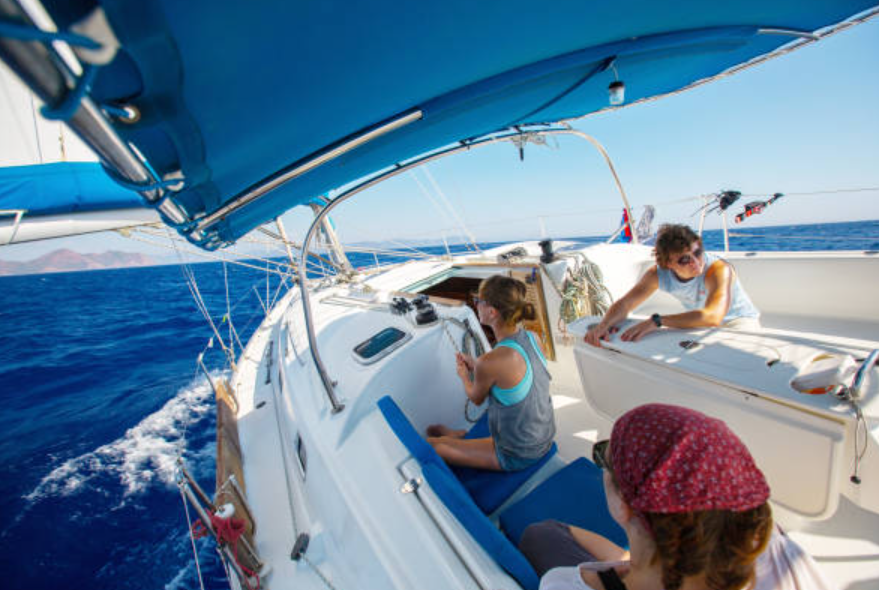
Ok, you want to set sail in your dreams, or maybe daydreamed about cruising crystal-clear waters on a sleek sailboat. Before you chart your course, you may want to explore the different types of sailboats and know its unique personalities and ideal uses.
By Hull Design

Monohulls
Think classic sailboats – these are the most common, offering stability and a variety of keel types. Imagine a deep keel slicing through waves, providing a smooth ride, or a shallow draft monohull skimming across shallow bays. These trusty vessels are the workhorses of the sea, offering stability that makes them a favorite among sailors. With various keel types to choose from, monohulls provide versatility for different sailing conditions. Whether you’re a seasoned sailor or just dipping your toes into the sailing world, monohulls are a reliable choice.
Catamarans
These boast two hulls, creating spacious decks and unmatched stability. Think luxurious floating apartments, perfect for island hopping or relaxing with friends. Catamarans are the spacious giants of the sea, offering a different kind of sailing experience. While they might be less maneuverable compared to monohulls, the extra room and stability make them perfect for leisurely cruises or entertaining your mates on board. Keep in mind, they’re not be as nimble as their single-hulled counterparts.
Trimarans
Craving speed and stability in rough waters? Trimarans have three hulls, slicing through waves effortlessly. They’re less common but perfect for adventurous sailors seeking exhilarating rides. Trimarans boast speed and stability, especially in choppy waters. Though less common, these three-hulled wonders are a sight to behold. If you’re seeking a vessel that can handle rough seas without sacrificing speed, a trimaran might just be your perfect match.
By Mast Configuration and Sails
The most popular choice, sloops have a single mast and are known for their simplicity and versatility. Whether you’re learning the ropes or racing across oceans, there’s a sloop rig for you. Simple, sleek, and ever-popular, the sloop is your go-to sailboat. With various rig types to suit your preference, it’s the ideal choice for those looking for an uncomplicated sailing experience.
Imagine two masts for double the sail area! Perfect for long-distance cruising, ketches handle winds well and offer generous storage space. Think self-sufficient adventures across distant horizons. Ketches provide more sail area for that long-distance adventure. With its two masts and ample sail configuration, it’s the go-to choice for sailors craving extended cruising. Imagine the wind in your sails as you gracefully navigate the open sea.
Schooners
See a classic scene with multiple masts rising majestically. Schooners, with their elegant design, perform particularly well in light winds and offer a unique sailing experience. Its timeless design shines, especially in light winds. If you fancy a nod to sailing’s rich history while enjoying a leisurely sail, the schooner is a top contender. Think historical charm meets modern comfort.
Beyond the basics: There’s a whole world of other mast configurations like catboats, yawls, and cutters, each with their own strengths and quirks. Explore further to find your perfect match!
Sailboats Types by Intended Use

Are you ready to set sail and navigate the open waters? Whether you’re a seasoned sailor or a novice eager to learn, understanding the different types of sailboats based on their intended use is a crucial first step. Let’s dive into the diverse world of sailboats and discover which one suits your sailing ambitions.
If you’re looking for a sailboat perfect for short excursions and skill-building, the daysailer is your go-to. Designed for ease of use, these boats are ideal for beginners and those who crave the simplicity of a quick day on the water. With straightforward rigging and a focus on maneuverability, daysailers make learning the ropes a breeze.
Cruising Sailboats
For the adventurers at heart, cruising sailboats are tailored for extended journeys and even living aboard. These boats offer a comfortable living space and ample storage, making them well-suited for those dreaming of exploring distant shores or embracing the liveaboard lifestyle. Set your sights on the horizon and let a cruising sailboat be your home on the water.
Racing Sailboats
Thrill-seekers and competitive spirits, look no further than racing sailboats. Crafted for speed and precision, these vessels are designed to slice through the water with agility. Join the excitement of regattas and harness the power of the wind as you compete against fellow sailors. Racing sailboats are the ultimate choice for those who crave the rush of the open sea and the thrill of competition.
Performance Cruisers
If you desire the best of both worlds – comfort and speed – a performance cruiser is your ticket to a balanced sailing experience. These sailboats combine the luxury of cruising vessels with the enhanced speed of racing boats. Experience the joy of sailing without compromising on comfort, making every journey an enjoyable and swift adventure.
Other Specialized Sailboats
Beyond the main categories, the world of sailboats offers a myriad of specialized vessels. Dinghies provide nimble handling, multihulls offer stability and speed, while classic boats exude timeless charm. Each has its unique features, catering to specific preferences and needs. Explore these options to find the sailboat that resonates with your sailing style.
Considerations in Type of Sailboats
You’re ready to explore the world under sail, but with an array of amazing sailboats out there, choosing the right one can feel like navigating a stormy sea itself. This guide will equip you with the knowledge to chart your course towards your ideal vessel.
Keel Configurations
Just like shoes, different keels suit different sailing styles. Here’s a quick rundown:
Fin keels: These deep, fixed fins slice through water efficiently, making them ideal for speed and long-distance cruising. Think stability and slicing through waves like a knife!
Wing keels: Imagine an airplane wing underwater. These thin, angled keels provide incredible stability and lift, perfect for choppy waters and sporty sailing. Hold on tight, these can get exciting!
Daggerboards and centerboards: These retractable keels allow you to explore shallow waters. Think playgrounds for exploring hidden coves and navigating tight spaces. Just remember to raise them before hitting deeper waters!
Size & Capacity
Imagine trying on clothes – a sailboat that’s too big can be overwhelming, while one that’s too small feels cramped. Here’s how to find your perfect fit:
Crew size: How many shipmates are joining your adventure? A cozy sailboat for two won’t cut it for a family of five. Remember, comfort matters!
Sailing goals: Weekend getaways or epic voyages? Daytime cruises or stargazing under the open sky? Matching your needs with the boat’s capabilities ensures smooth sailing (and sleeping! ).
Sailing Experience
Not everyone starts as a seasoned sail. Here’s how to choose a boat that matches your experience level:
Beginner’s bliss: Stable boats with simple rigs, like centerboard dinghies or small keelboats, are your training wheels. Think ease of handling and learning the ropes with confidence.
Intermediate island-hopper: Ready to graduate? Mid-sized keelboats with more complex sail plans offer exciting challenges and comfortable explorations. Think weekend adventures with a touch of spice.
Seasoned sailor: The sky’s the limit! From high-performance racing yachts to luxurious cruising vessels, the world is your oyster. Remember, experience and budget go hand-in-hand.
Choosing Your Right Sailboat
Now that you’ve got the basics down, it’s time to set sail on your research journey!
What’s your needs: Reflect on your experience, intended use, budget, and crew size. This forms your map.
Match your preferences: Explore different boat types and their characteristics. Think speed demons, cozy cruisers, or adventurous explorers. Find your match!
Research and choose: Dive deeper into specific models, read reviews, and compare features. This is where you fine-tune your course.
With this guide and a little research, you’ll be well on your way to setting sail on the perfect boat for your unique sailing adventure. Remember, the journey is just as exciting as the destination, so enjoy the exploration!
Embark on your sailing journey with a clear understanding of the diverse types of sailboats based on their intended use. Whether you’re seeking a leisurely day on the water, planning an extended cruise, craving the thrill of competition, or desiring a balanced experience, there’s a sailboat waiting to hoist its sails for you.
This is just a taste of the diverse world of sailboats. So, set sail and discover the type that speaks to your inner mariner. Happy sailing!
Leave a Reply Cancel reply
Your email address will not be published. Required fields are marked *
Save my name, email, and website in this browser for the next time I comment.

Panama Canal To Combat Future Drought With Larger Vessels & Expanded Reservoirs

India To Build A High Tech Ship & Submarine Testing Facility Similar To U.S Navy Facility In Memphis

Captain Of Mike Lynch’s Bayesian SuperYacht Under Probe For Potential Manslaughter

NASA’s Pegasus Barge To Transport The Largest SLS Component For Artemis II Mission

The Ultimate Guide to Different Types of Boats – Top 20
As we all know, a boat is a type of watercraft that has been specifically designed for navigating near-shore areas or inland waterways such as rivers and lakes.
What makes a boat different from a ship is its smaller size and lesser carrying capacity compared to the latter.
However, the definition of a boat –its size, shape and capacity-varies according to its purpose. To understand better, you might want to read about the major differences between boat and ship .
According to modern naval terms, a boat is defined as a watercraft that is small enough to be carried abroad a ship (some boats are measured up to 1000 feet in length).
Similarly, many boats are intended to provide service, not in near-shore areas but in the offshore environment.
Interestingly, contradicting the “ships can carry boats, but boats can’t carry ships” argument, even sometimes the US Navy submarines are called boats.
Historical evidence suggests that the boat has been used for transportation since pre-historic times. However, from the oldest known boat named dugouts, the evolution of the watercraft has now reached luxurious motor yachts.
Apart from recreational purposes, boats have also served an integral purpose in the modern commercial world by allowing active transportation of both passengers and cargo, wherever short distances are concerned.
Table of Contents
Types of Boats
Technically, there are several different types of boats, and it’s impossible to list down all the types. But, primarily, boats can be classified into three main sections as follows:
- Unpowered or man-powered boats (like rafts, gondolas, kayaks, etc.),
- Sailboats (sail-propelled)
- Motorboats (engine-powered)
Here we have a list of the major types of boats in the above-mentioned categories of vessels, along with boat pictures used around the world.
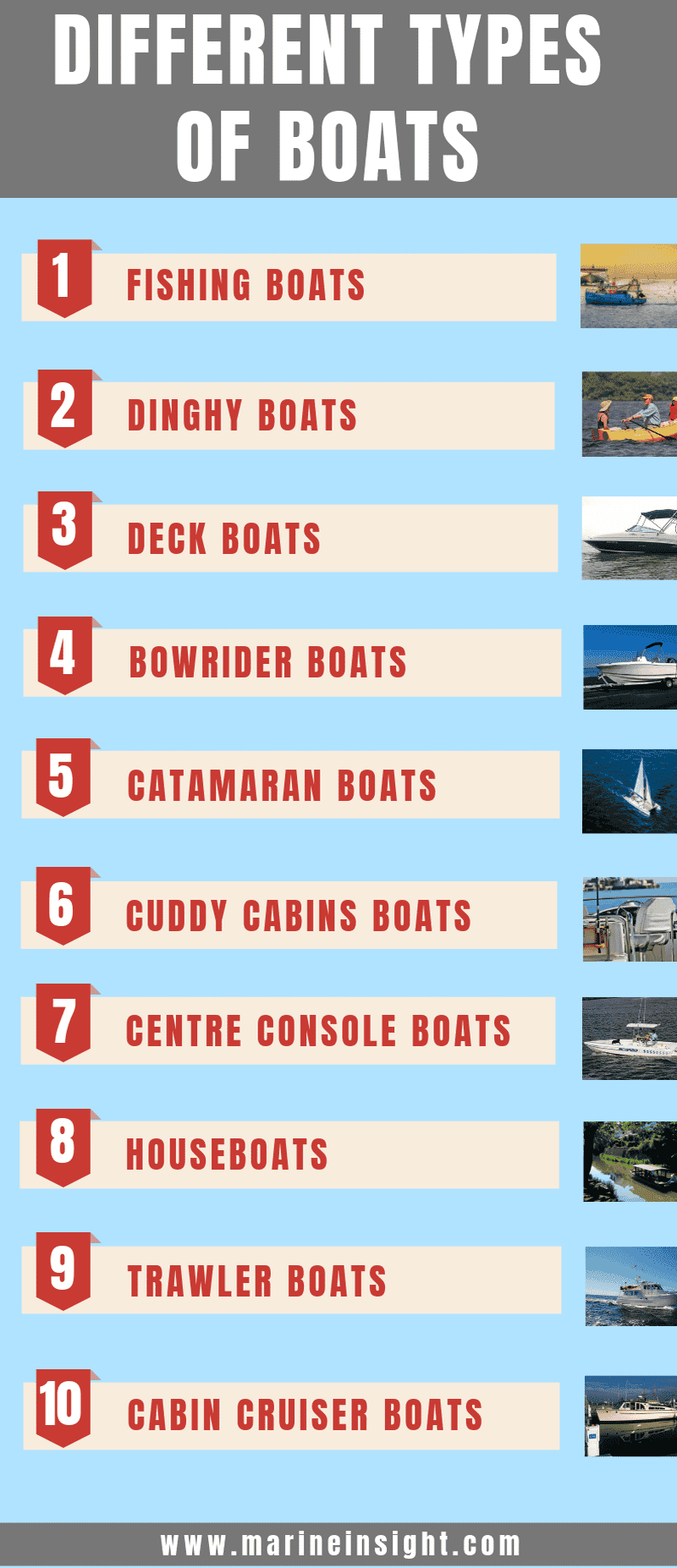
Related Read: 5 Biggest and Magnificent Sailing Ships of All Time
1. Fishing Boats
Built exclusively for fishing, fishing boats in different sizes are used on both salt and freshwater bodies. The immediate qualities of these boats include stability, strength, and durability to survive the fishing ventures across various kinds of waterways.
Fishing boats can be both manned and un-manned types. The all-purpose fishing boats generally include a front bow, rod lockers, a trolling motor system, an outboard power and live wells.
Compared to the boats meant for lakes and rivers, the boats fishing in the offshore environment will be taller in size and strong-built to withstand saltwater and harsher conditions.
On the other hand, the aluminium fishing boats weigh less and are highly durable. The bass boats designed with slim profiles, and consist of 2-3 anglers on board, are type of a boat used for fishing.

Related Read: Types of Fishing Vessels
2. Dinghy Boats
A dinghy can be a small inflatable boat usually made of rubber and comprises cross thwarts and rowlocks that act as seats and oars, respectively.
Commonly powered by sails, oars and small outboard engines, Dinghies are popularly known as sailboats, rowboats or simply inflatables.
These boats team up with more significant vessels and come in handy when the mothership cannot navigate in narrow areas. These rowboats can also be utilised as companion boats and are taken to camping expeditions or fishing in shallow waters.
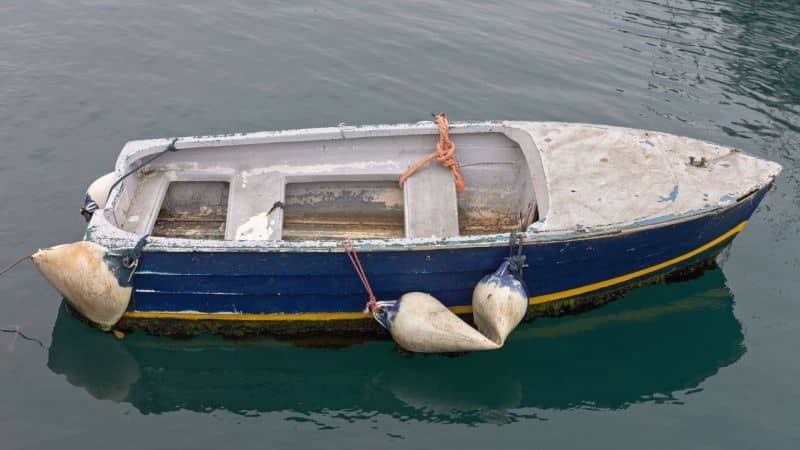
Related Read: Differences Between a Ship and a Boat
3. Deck Boats
As the name suggests, Deck Boats come with an open deck area that provides plenty of seating arrangements for a small group of people.
The boat features a V-shaped hull with a wide beam to accommodate more passengers than a pontoon boat. Usually measures 25-35 ft in length, they are provided with a stern power drive and are popularly used for recreational activities like swimming, water sports etc.
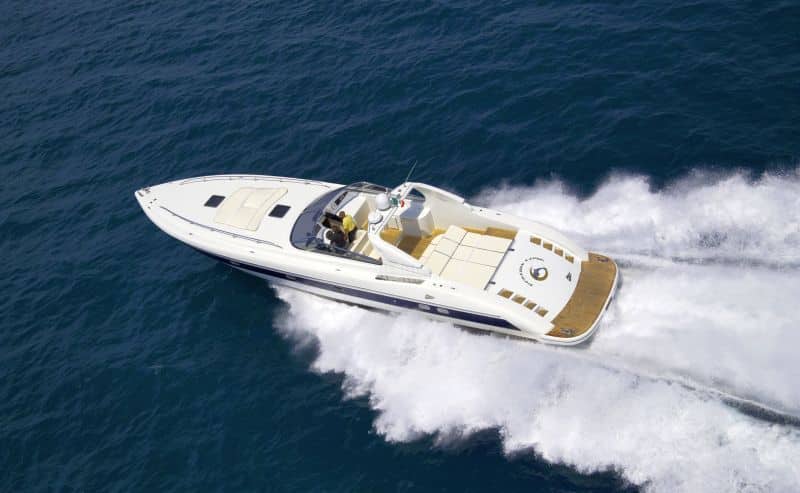
4. Bowrider Boats
Known as a quintessential family boat, Bowriders offer room for eight or more passengers across its cockpit, bow cockpit and helm. In addition, the bow area of these boats has been constructed in a unique way to allow a spacious seating arrangement.
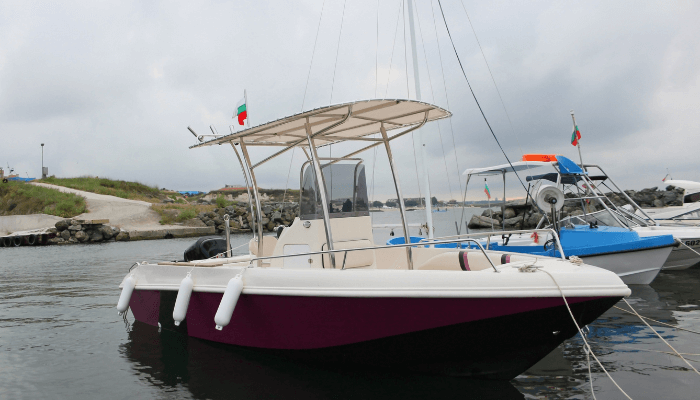
Moreover, these runabout-style vessels contain a swim platform for putting on wakeboards or for swimming activities feel-good leisure boating.
With its classic V-shaped bottom, Bowrider Boats offer a splendid ride across different water conditions. The usage of sterndrive power is the typical rule, but the demand for outboard engines is increasing rapidly.
4. Catamaran Boats
Unlike other boats, Catamaran is a multi-hulled watercraft that features two parallel hulls of equal size. Catamaran Boats feature less hull volume, shallower draft, and higher displacement than vessels with a single hull.
Excellent for fishing purposes and even for leisurely cruising abilities, Catamarans are being built for various purposes across the world.
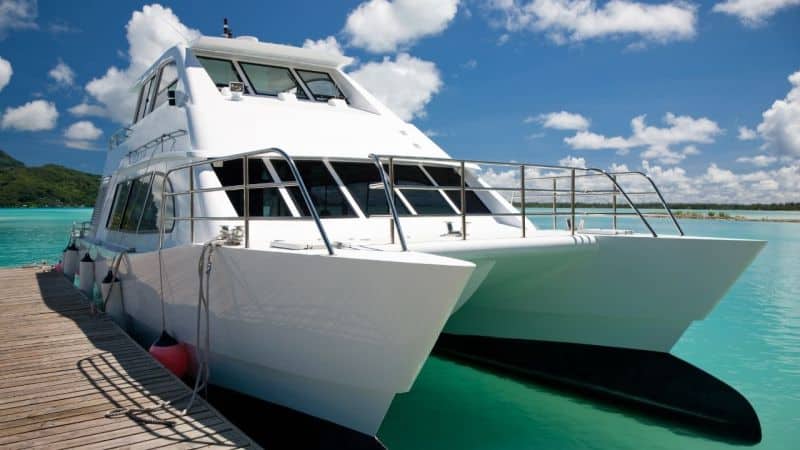
Related Read: Main Types of Catamarans Used in the Shipping World
6. Cuddy Cabins Boats
Well-suited for fishing, yachting, sailing and other water sports, Cuddy Cabins Boats is one of the most family-friendly vessels.
Featuring a closed deck over the boat’s bow, the boat allows a convenient storage space and easy navigation. The cuddy cabin boats are usually built of fibreglass and aluminium, and the minimum length is around 4.75 meters.
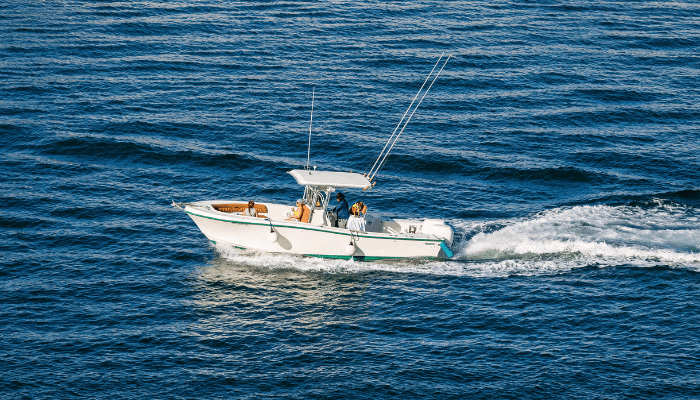
7. Centre Console Boats
Essentially a boat that features a hull with no cabin or foredeck and the helm station in the centre of the boat, Centre Consoles are great fishing platforms.
These boats are ideal for sports fishing and work in harsh offshore waterways with plenty of ocean fish. The essential equipment consists of bait wells, gunwale rod holders, fish lockers and outriggers, to name a few.
In addition, the deck provides a powerful insulation system for icing the fish storage.
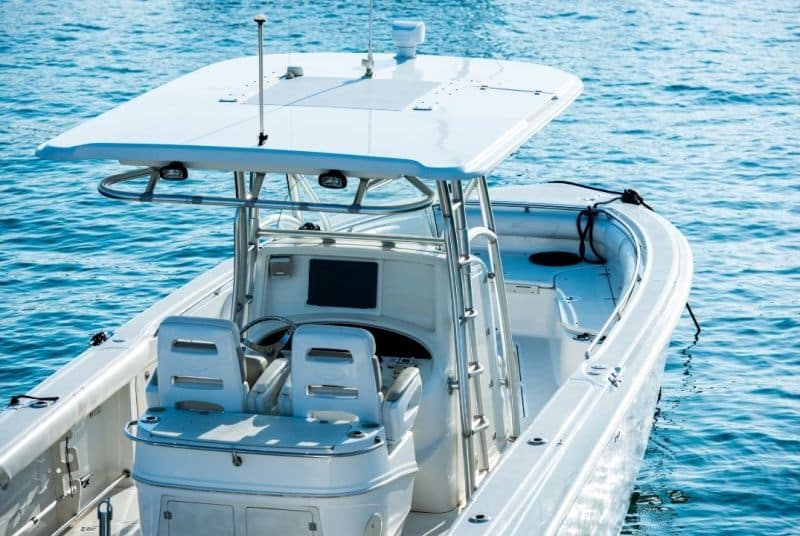
Related Read: Lafayette – The World’s Biggest Ship for Fish Processing
8. Houseboats
There are houseboats of different shapes and sizes worldwide, offering the luxury of living on water and providing excellent recreational and holiday accommodation facilities.
Houseboats, also known as Float house, incorporate broad flooring and modern amenities such as entertainment, fine dining, and proper sleeping arrangements.
The boats offer fun activities like relaxed cruising, water sports, family sailing etc. While most of the houseboats are motorized, there are boats incapable of operating under their own power since they are usually kept stationary at a location.
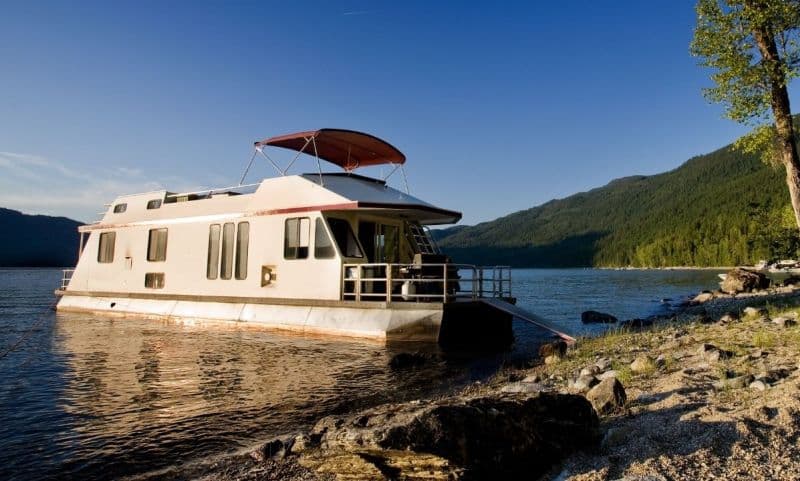
Related Read: Top 10 Largest Cruise Ships in 2017
9. Trawler Boats
With features including a displacement hull and fuel-efficient engines, trawlers are intended to smoothly manoeuvre through the water bodies without exhausting much horsepower or consuming excessive fuel.
This quality makes the trawler a brilliant option for long-range cruising activities, as all modern facilities can be found aboard the boat.
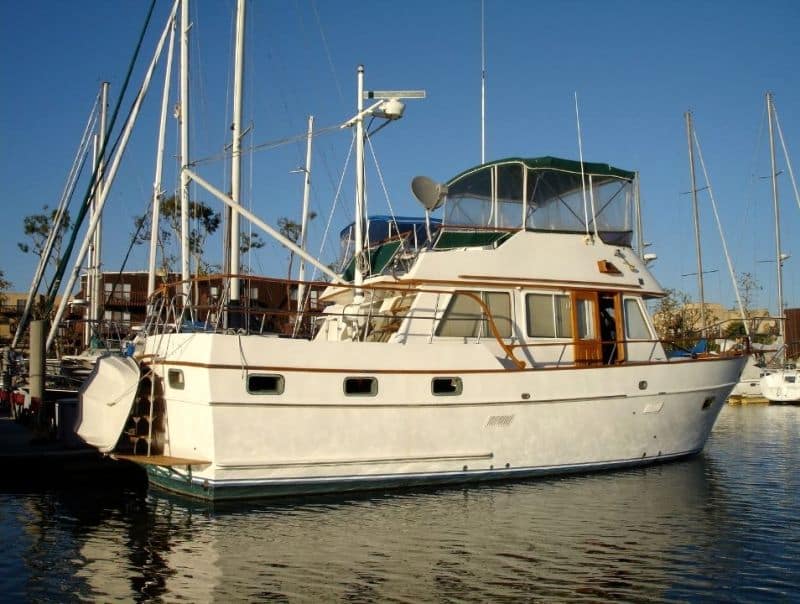
10. Cabin Cruiser Boats
Offering all the essential features of a home, Cabin Cruiser boats are great for relaxed sailing. Designed with a galley and a berth, these boats offer modern comforts like heaters, air conditioners, and power generators.
In addition to a deep-V bottom, the Cabin Cruisers employ a secure shaft drive mechanism plus rudder steering and therefore are mainly suited for movement in the salty water.
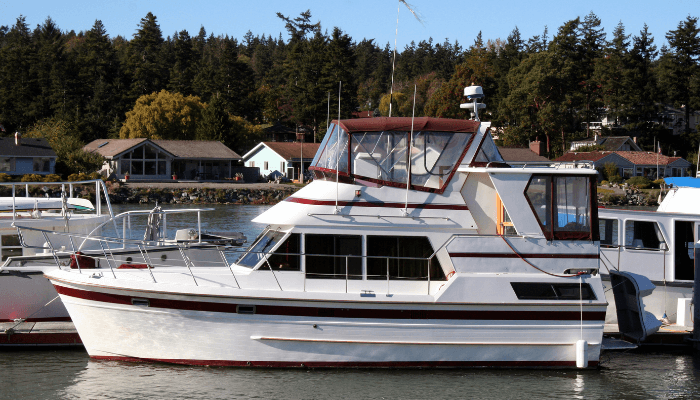
11. Game boats
Powered by diesel or petrol engines, these fibreglass boats are large in measurement and are useful for the game fish pursuit, especially pelagic fishes like tuna and marlin.
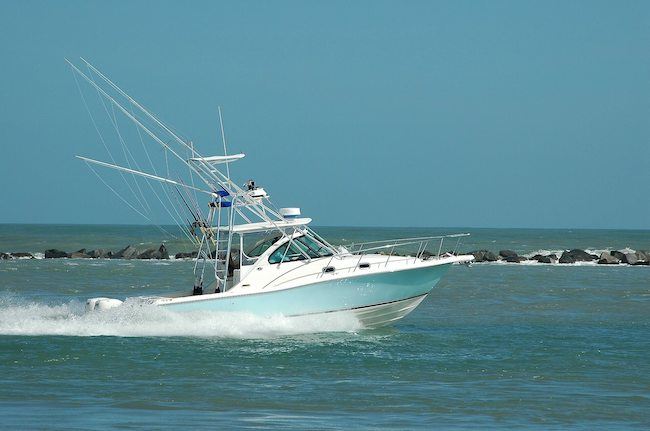
Equipped with sleeping berths, plumbing systems, and cooking galleys, these boats allow passengers to continue their activities for a couple of days or more.
12. Motor Yacht Boats
The latest design in the evolution of boats, the motor yacht, is a watercraft primarily used for leisure activities. The motor yacht has a standard length of 12m and above, with one or two diesel engines per navigation requirements in inland waters or the oceans.
The motor yacht can vouchsafe for an enjoyable family trip for a long period of time that it sails on the water. There are different types of yachts in the market, including day sailing yachts, weekender yachts, cruising yachts, luxury sailing yachts etc. to meet the various requirements.
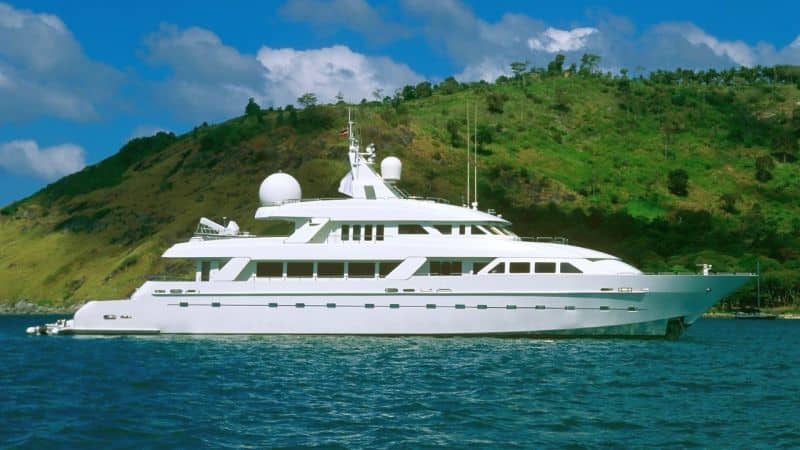
13. Personal Watercraft (PWC) Boats
The PWC boats, also known as water scooters and jetski, are customized boats for adventurous activities. This recreational watercraft allows individuals to explore the waters at their own ease and participate in games such as water-skiing and sports fishing, etc. There are two types of PWCs – “sit down” and “stand-up” models; while the former is intended for two or more people, the latter can only be used by a single rider.
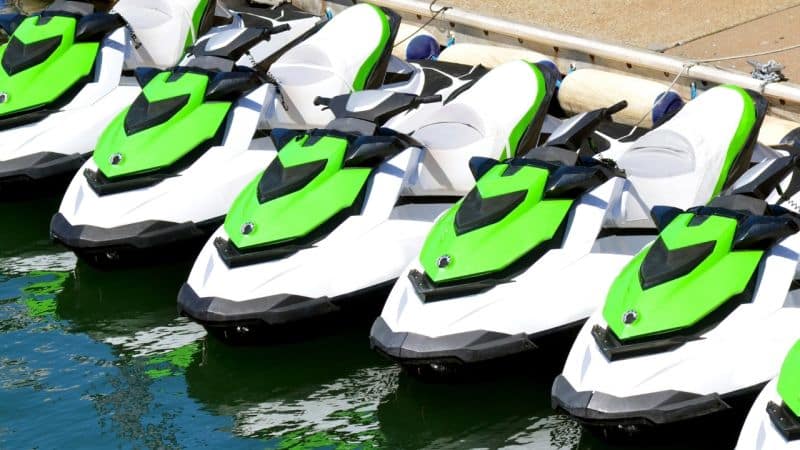
14. Runabout Boats
Capable of accommodating four and eight people, Runabout Boats are typically used in racing, fishing, water skiing, etc. The movement of these open boats is controlled by a steering wheel and forward controls, as located behind a windscreen. Runabouts are usually declared entry-level vessels for casual sports and boating activities.
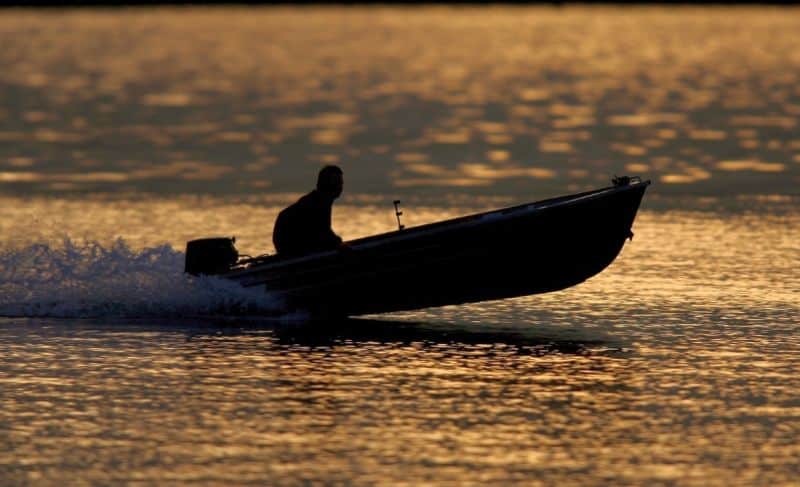
15. Jet Boats
Powered by a jet of water ejected from behind the vessel, Jet Boat is notable for its high manoeuvrability. The structure of a jet boat is quite similar to that of a bow-rider, as it offers a lot of seating areas and a swimming platform. In addition, the advanced propulsion system is securely enwrapped in the hull to protect it from any external damage.
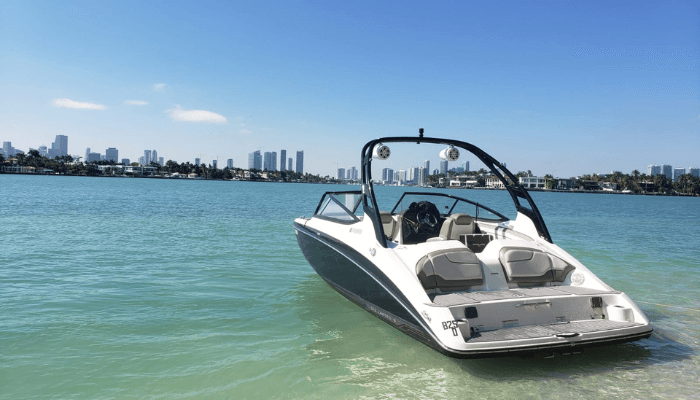
16. Wakeboard/ Ski Boats
The wakeboard boats and the ski boats look quite the same but differ in their fields of action. The inboard ski boats require a powerful range of acceleration, and the shape of the engine and propeller accentuates it. On the other hand, the inboard wakeboards feature a V drive engine system, deep hulls, and a huge wake to set in motion.
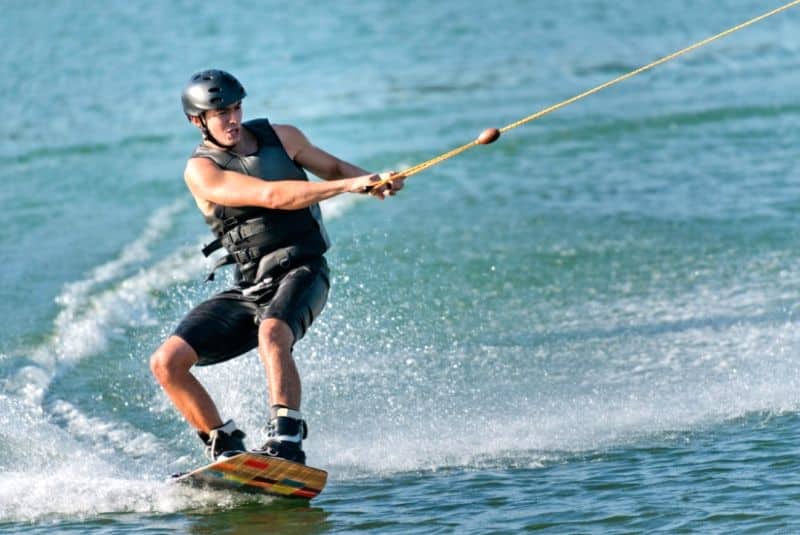
17. Banana Boats
A banana boat is a type of watercraft that is solely utilized for recreational activities and family entertainment. As the name suggests, it is a banana-shaped inflatable watercraft and easily floats on water. It does not have an inbuilt motor system. A banana boat has the capacity to seat around three to ten people. Interestingly, at the same, the vessels being used primarily for the transportation of bananas as cargo is also called Banana boats.
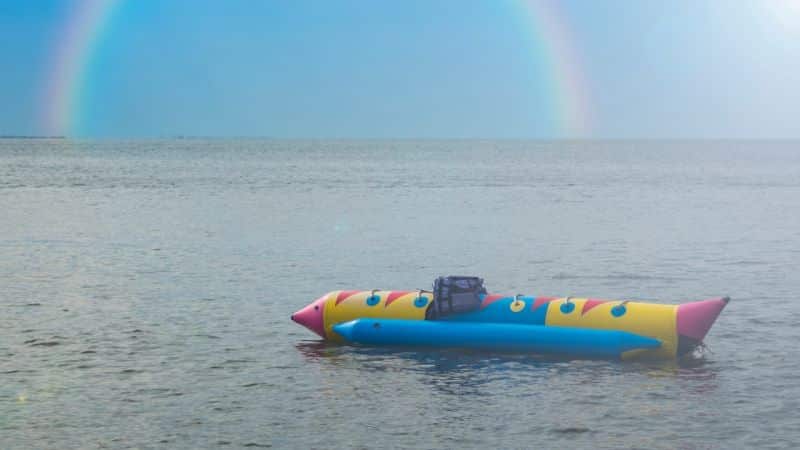
Related Read: Top 10 Most Expensive Private Yachts In The World
18. Lifeboats
In emergencies, lifeboats come to the rescue! The lifeboats are small watercraft attached to bigger vessels like cruises, and their main function is to carry passengers to a secure area if the concerned vessel is met with an accident. The lifeboats are well-equipped with immediate food and water supplies and other necessities to pacify the frightened voyagers in case of a shipwreck.
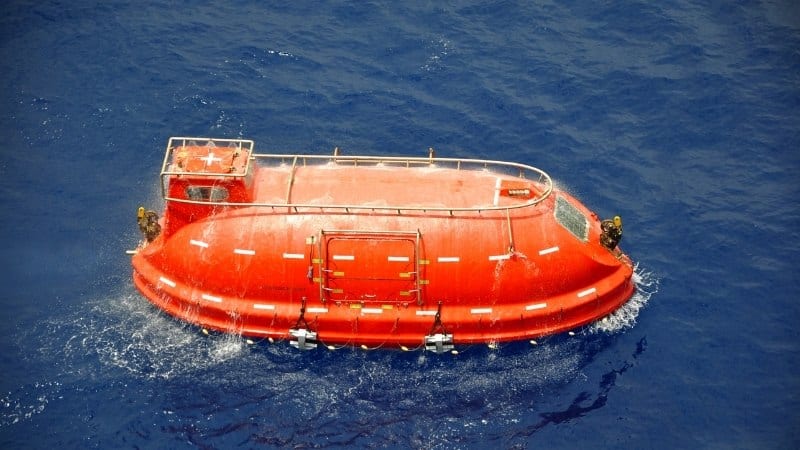
Related Read: Common Reasons for Ship’s Lifeboat Engine Starting Failure
19. Pontoon Boat
Used popularly for inland waters and other small water bodies, Pontoon boats are flattish in shape, relying on tubes (pontoons) to float on the water. Typically, the length of the Pontoon boat ranges from 15-30 ft with a shallow draft. It consists of multiple aluminium tubes supporting the broad platform providing excellent stability.
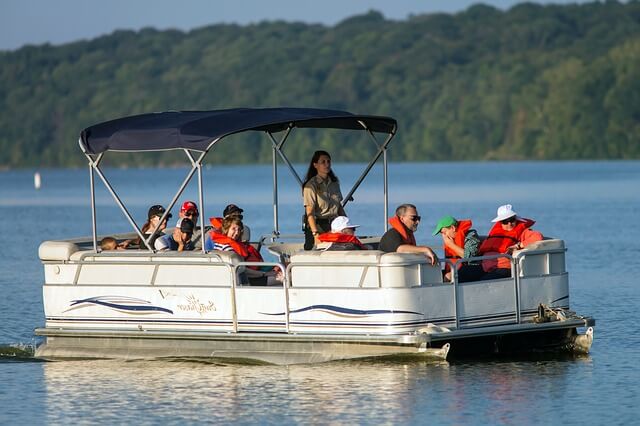
They are used for recreational activities like cruising and fishing etc. The shape of a Pontoon boat helps designers plan the seating arrangements and other facilities according to the requirements.
20. Sedan Bridge Boat
Typically ranging from about 35–65 feet in length, Sedan Bridge Boat by Sea Ray Company offers the pleasure of excellent visibility to the navigator. With an extended bridge area, the boat makes the passengers feel like a big ship bridge and offers accommodations down below to suit extended stays on the water.

Apart from the above-mentioned ones, several other types of boats are also available in the market.
The list of the boats continues with vessels such as Skiff or Jon Boats, Hydrofoil boats, Cigarette boats, Cuddy Boats, Tug Boats , High-Speed Crafts, Bumper Boats, Pilot Boat, Fire Boat, Well boats, Kayak, Bay or Flat Boats, All-Purpose fishing Boats, Deck Boats, High-Performance Boats, Rafts, Surfboats, Narrowboats, Folding Boats, Log Boats, Go-fast Boats, Catboats, Junk Boats, Ferry Boats, Canoe Boats, U-boats, Dory boats etc.
Over to you…
If you think any other type of boat should be added to this list, let’s know in the comments below.
You might also like to read:
- A Guide To Types of Ships
- Types of Sailboats: A Comprehensive Classification
- Different Types of Submarines and Underwater Vessels
- Different Types of Barges Used in the Shipping World
- LNG Tankers: Different Types And Dangers Involved
- What is Karadeniz Powership?
- Top 11 Books On Boating
Disclaimer : The information contained in this website is for general information purposes only. While we endeavour to keep the information up to date and correct, we make no representations or warranties of any kind, express or implied, about the completeness, accuracy, reliability, suitability or availability with respect to the website or the information, products, services, or related graphics contained on the website for any purpose. Any reliance you place on such information is therefore strictly at your own risk.
In no event will we be liable for any loss or damage including without limitation, indirect or consequential loss or damage, or any loss or damage whatsoever arising from loss of data or profits arising out of, or in connection with, the use of this website.

Do you have info to share with us ? Suggest a correction
Daily Maritime News, Straight To Your Inbox
Sign Up To Get Daily Newsletters
Join over 60k+ people who read our daily newsletters
By subscribing, you agree to our Privacy Policy and may receive occasional deal communications; you can unsubscribe anytime.

BE THE FIRST TO COMMENT
13 comments.
Though the personal watercraft boat seems like it would be an adventure, I’d prefer the classic fishing boat with an outboard power and live wells. I love fishing and this probably suits my needs just fine. It could also be that I don’t know how to swim either and this just seems safest.
Add another catergory Power Sailer. My Imexus 28 Trailer Sailer has a 180hp inboard whilst being generally sailing oriented. This catergory has some early examples like the Lancer 27, a big volume seller in the Macgregor 26Xand M and others like the Hunter X and Mackmam 28 All having large outboards fitted. Jimmy Buffett had one built I believe which was much bigger yacht again featuring a pair of 70 hp inboards I think. Just another catergory to add to the list. Regards Graeme
Well explained, I got some information about the bout on your article. I have shared it with my friend, who is planning to buy a boat. I am sure this post helps him to choose the right type of boat for him. He joined a yacht show in Thailand and like a boat from Boat Lagoon Yachting. Thanks for sharing.
@Johan: Glad the information came handy
I find it helpful that you made a list of boats with a detailed description of each. When I learned that a person can get a fishing boat so that they can be used to get saltwater and freshwater fish, my suggestion for boat buyers is to invest in a custom dock by a local contractor before buying one. Doing this will help them have a safe place to keep it safe while not in use.
Got any recommendations for a single man boat? I’m writing a character who likes the freedom of getting on his (modest) motor boat and taking off for the afternoon/evening. Below deck accommodations w/b great too. But I wouldn’t want to cost to be more than $20k. Any help is appreciated! Oh, and, he likes to go fast!
Nice post very informing. btw how do I know the difference between boats that are different that look the same?
I lovw boats so much! these are so cool! have you ever gone on a pizza boat they are the best things ever! carrbean pizza boats!!!!!!!!!!!!!!!!!!!!!!!!!!!!!!!!!!!!!!!!!!!!!!!!!!!!!!!!!!!!!!!!!!!!!!!!!!!!!!!!!!!!!!!!!!!!!!!!!!!!!!! i want to marry one one day. Lol.
This is really informative and i loved it i work with a marine company as a social media strategist and i was scouring the web for contents and i stumbled on this i thought i knew boats but now i know better thanks for the information btw i was wondering if you could give me permission to use some of these pictures for the content i’m creating. i’d love to hear from you soon. Regards
good information about boats
Banana Boats!! Seriously!!!
Leave a Reply
Your email address will not be published. Required fields are marked *
Subscribe to Marine Insight Daily Newsletter
" * " indicates required fields
Marine Engineering
Marine Engine Air Compressor Marine Boiler Oily Water Separator Marine Electrical Ship Generator Ship Stabilizer
Nautical Science
Mooring Bridge Watchkeeping Ship Manoeuvring Nautical Charts Anchoring Nautical Equipment Shipboard Guidelines
Explore
Free Maritime eBooks Premium Maritime eBooks Marine Safety Financial Planning Marine Careers Maritime Law Ship Dry Dock
Shipping News Maritime Reports Videos Maritime Piracy Offshore Safety Of Life At Sea (SOLAS) MARPOL
- BOAT OF THE YEAR
- Newsletters
- Sailboat Reviews
- Boating Safety
- Sails and Rigging
- Maintenance
- Sailing Totem
- Sailor & Galley
- Living Aboard
- Destinations
- Gear & Electronics
- Charter Resources
- Ultimate Boat Giveaway

40 Best Sailboats
- By Cruising World Editors
- Updated: May 24, 2024
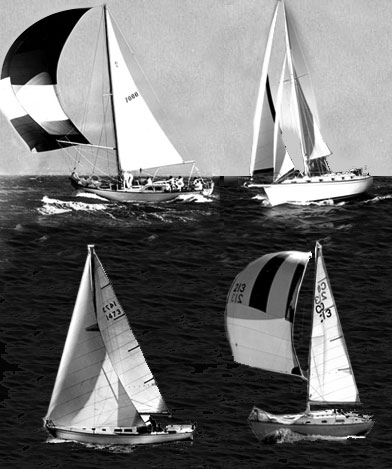
Sailors are certainly passionate about their boats, and if you doubt that bold statement, try posting an article dubbed “ 40 Best Sailboats ” and see what happens.
Barely had the list gone live, when one reader responded, “Where do I begin? So many glaring omissions!” Like scores of others, he listed a number of sailboats and brands that we were too stupid to think of, but unlike some, he did sign off on a somewhat upbeat note: “If it weren’t for the presence of the Bermuda 40 in Cruising World’s list, I wouldn’t even have bothered to vote.”
By vote, he means that he, like hundreds of other readers, took the time to click through to an accompanying page where we asked you to help us reshuffle our alphabetical listing of noteworthy production sailboats so that we could rank them instead by popularity. So we ask you to keep in mind that this list of the best sailboats was created by our readers.
The quest to building this list all began with such a simple question, one that’s probably been posed at one time or another in any bar where sailors meet to raise a glass or two: If you had to pick, what’re the best sailboats ever built?
In no time, a dozen or more from a variety of sailboat manufacturers were on the table and the debate was on. And so, having fun with it, we decided to put the same question to a handful of CW ‘s friends: writers and sailors and designers and builders whose opinions we value. Their favorites poured in and soon an inkling of a list began to take shape. To corral things a bit and avoid going all the way back to Joshua Slocum and his venerable Spray —Hell, to Noah and his infamous Ark —we decided to focus our concentration on production monohull sailboats, which literally opened up the sport to anyone who wanted to get out on the water. And since CW is on the verge or turning 40, we decided that would be a nice round number at which to draw the line and usher in our coming ruby anniversary.
If you enjoy scrolling through this list, which includes all types of sailboats, then perhaps you would also be interested in browsing our list of the Best Cruising Sailboats . Check it out and, of course, feel free to add your favorite boat, too. Here at Cruising World , we like nothing better than talking about boats, and it turns out, so do you.
– LEARN THE NAVIGATION RULES – Know the “Rules of the Road” that govern all boat traffic. Be courteous and never assume other boaters can see you. Safety Tip Provided by the U.S. Coast Guard
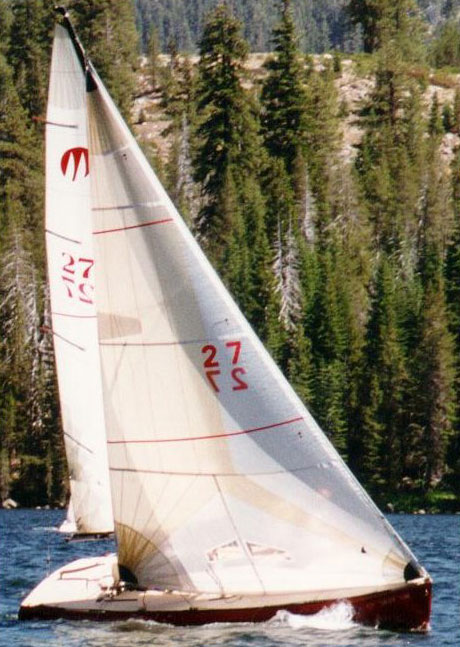
40. Moore 24
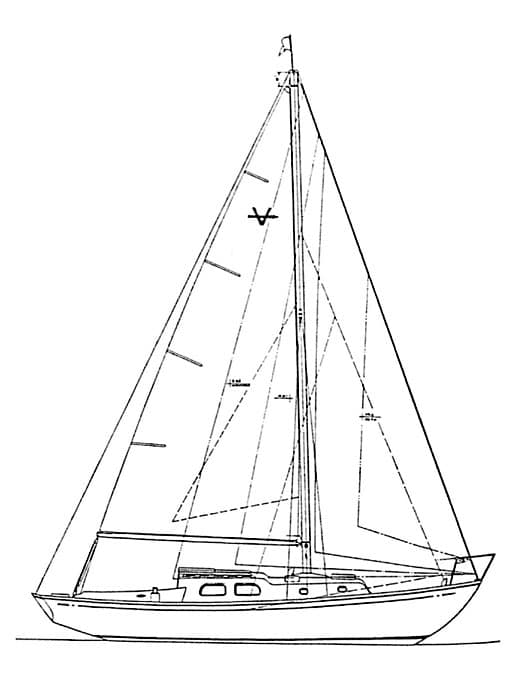
39. Pearson Vanguard
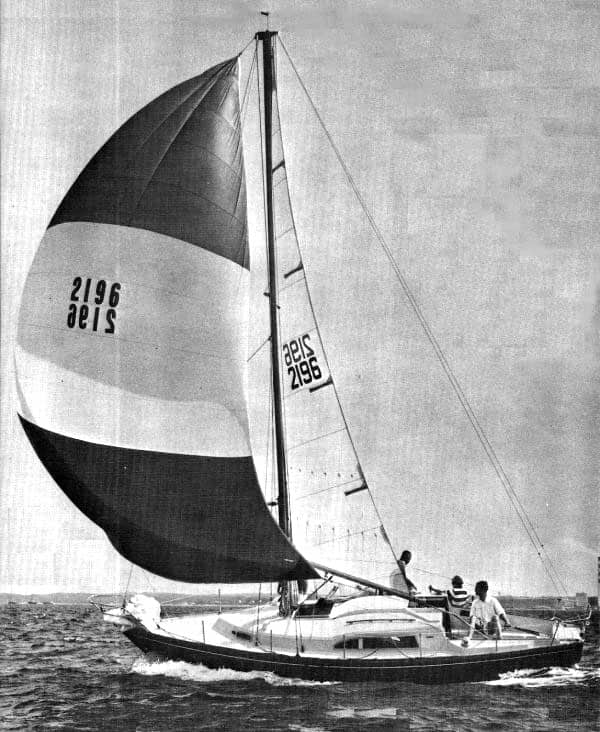
38. Dufour Arpege 30
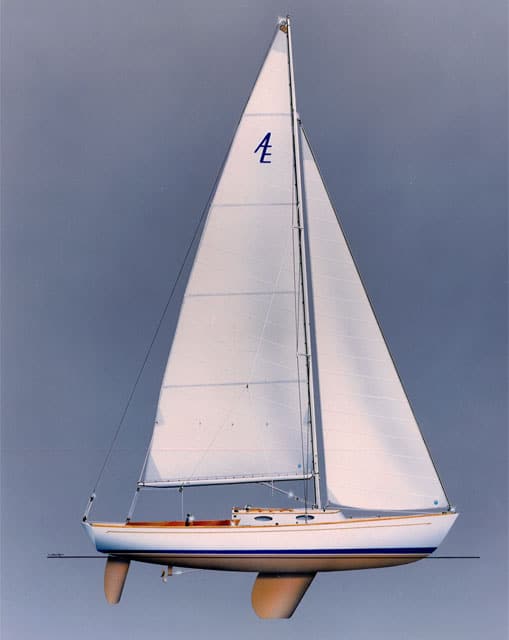
37. Alerion Express 28
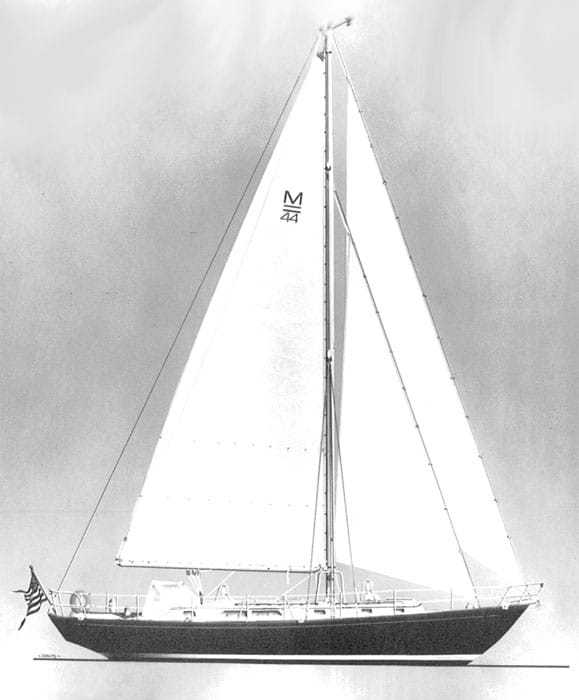
36. Mason 43/44
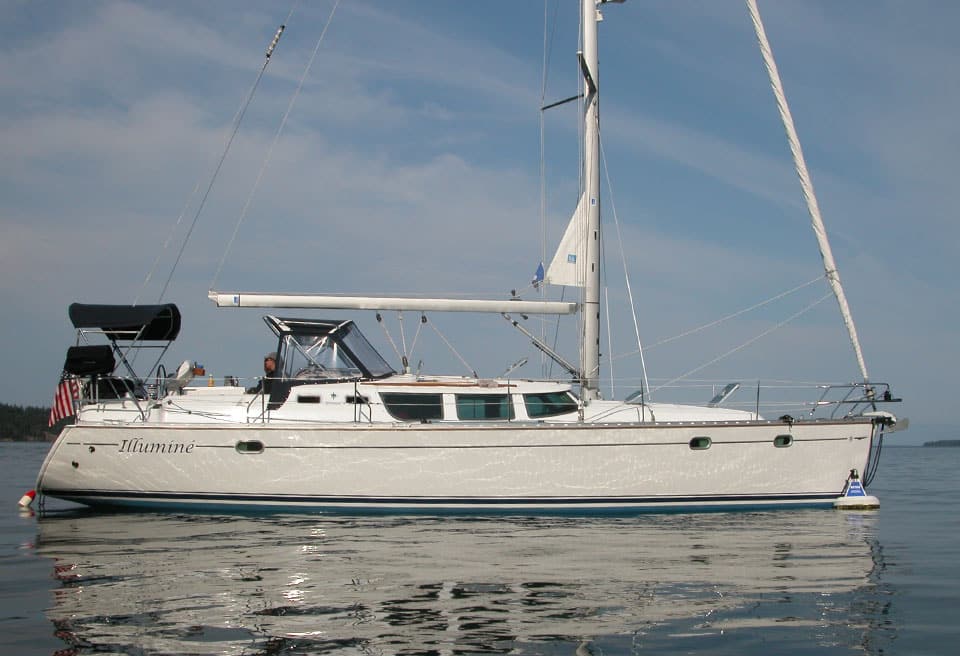
35. Jeanneau Sun Odyssey 43DS
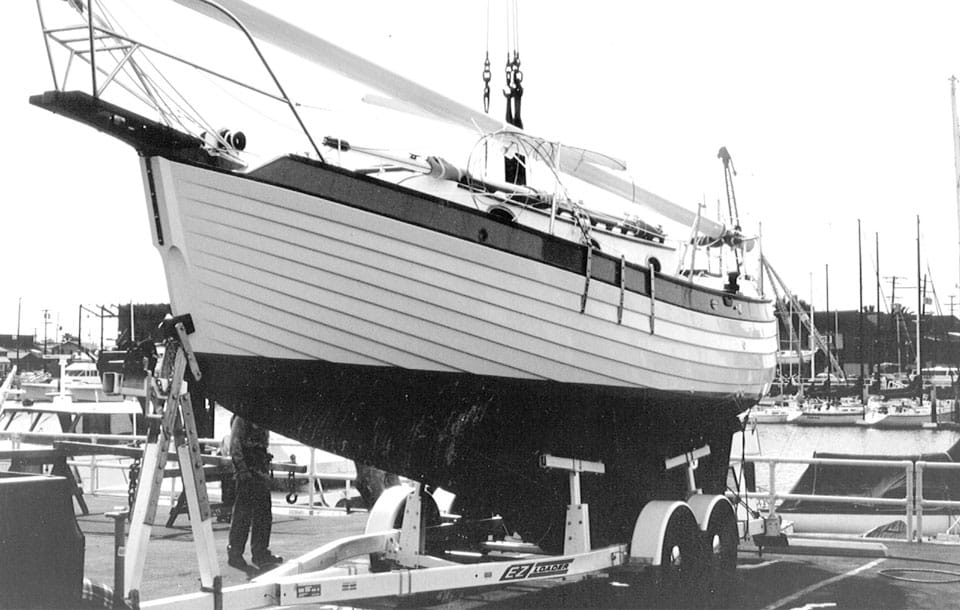
34. Nor’Sea 27
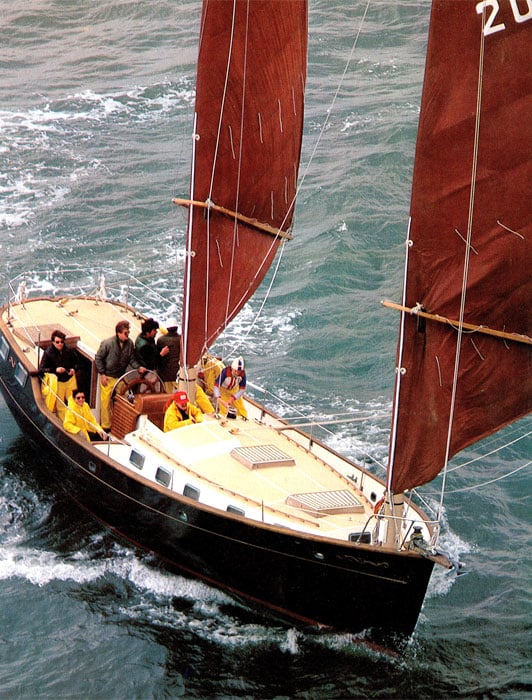
33. Freedom 40
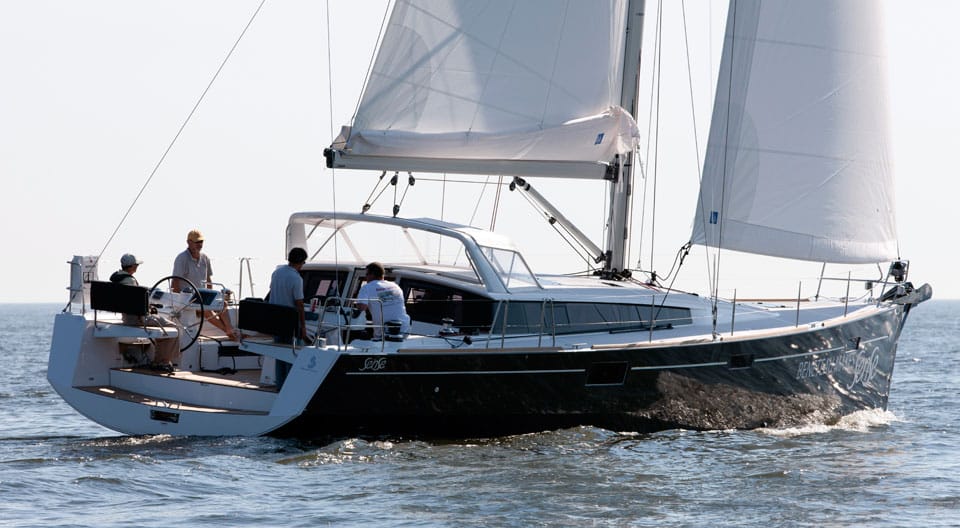
32. Beneteau Sense 50
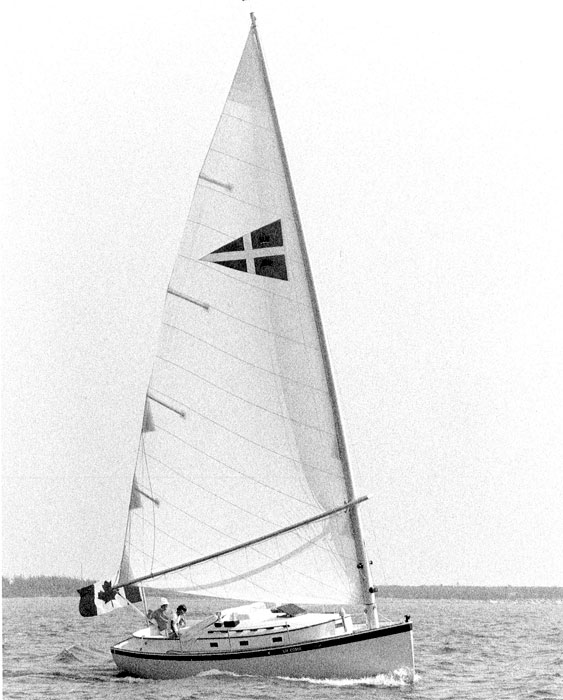
31. Nonsuch 30
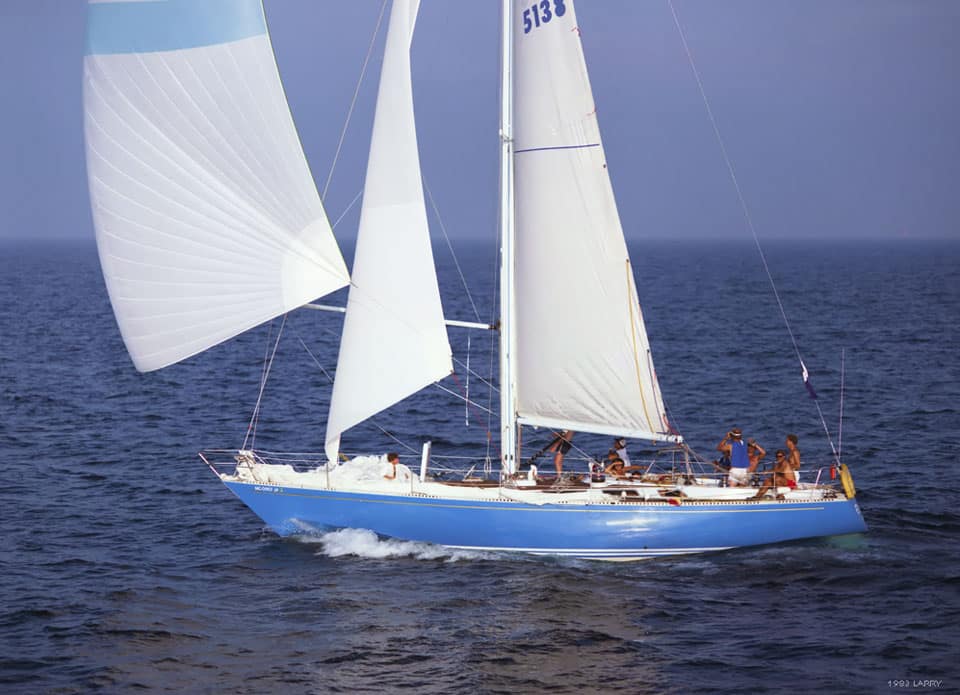
30. Swan 44
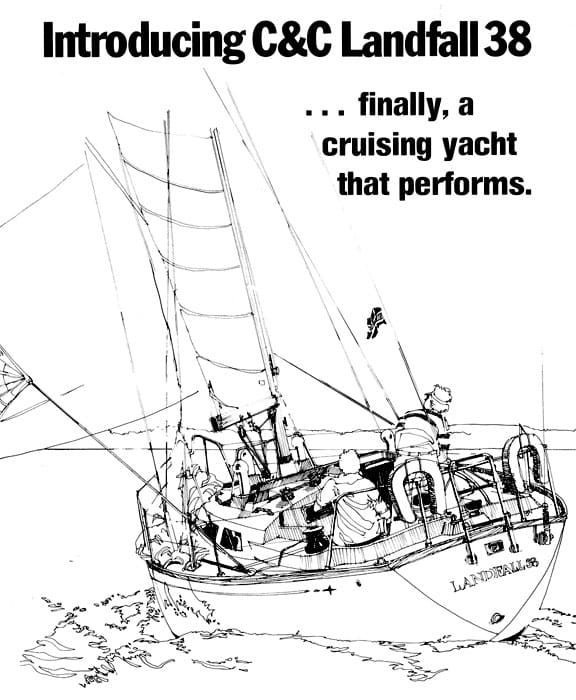
29. C&C Landfall 38
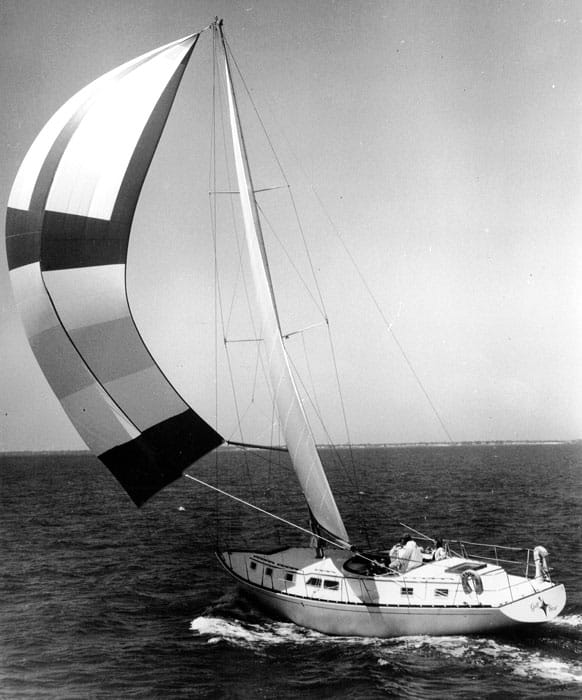
28. Gulfstar 50
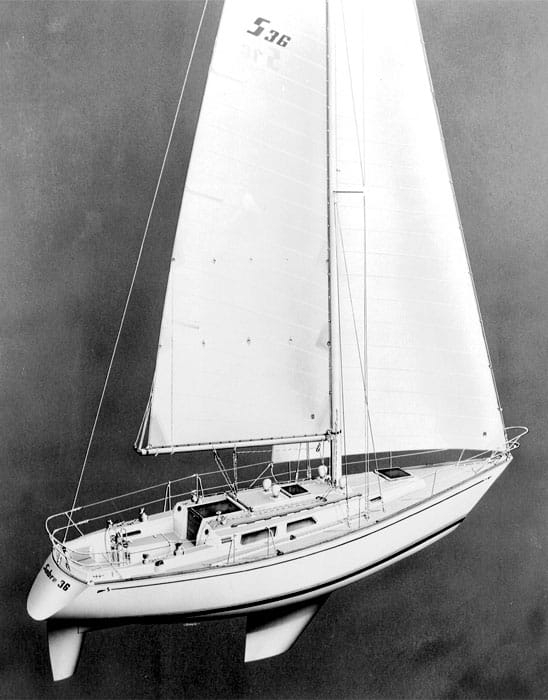
27. Sabre 36
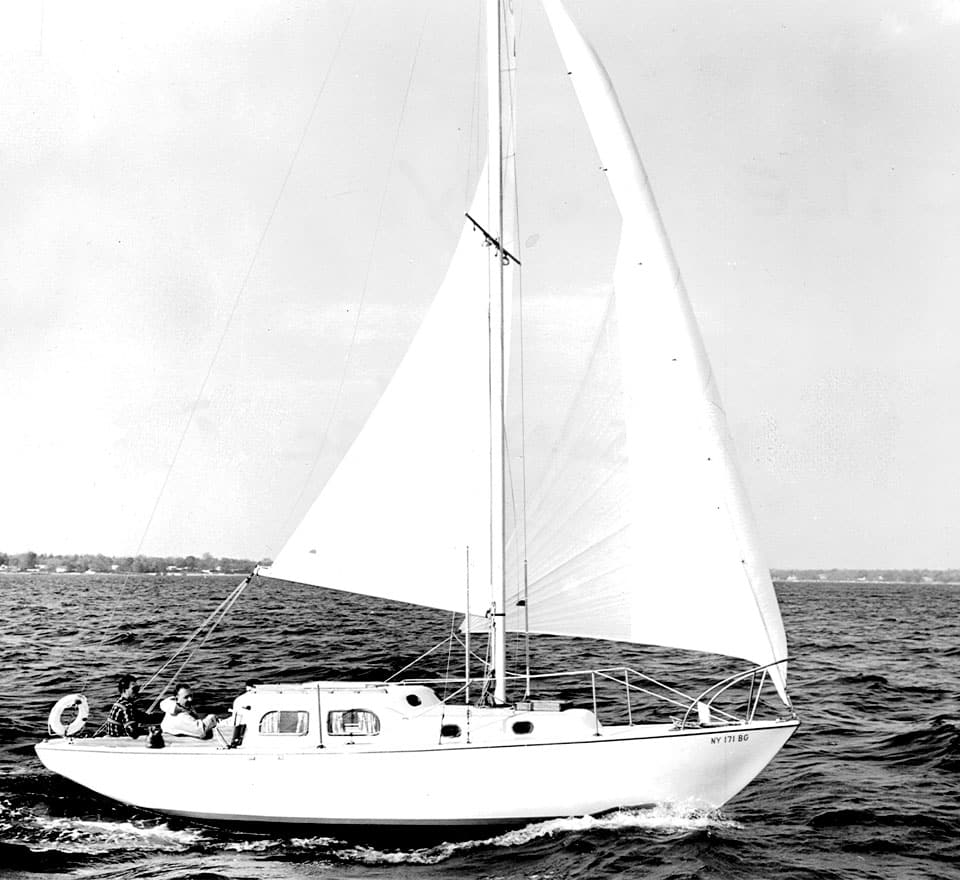
26. Pearson Triton
– CHECK THE FIT – Follow these guidelines to make sure your life jacket looks good, stays comfortable and works when you need it. Safety Tip Provided by the U.S. Coast Guard
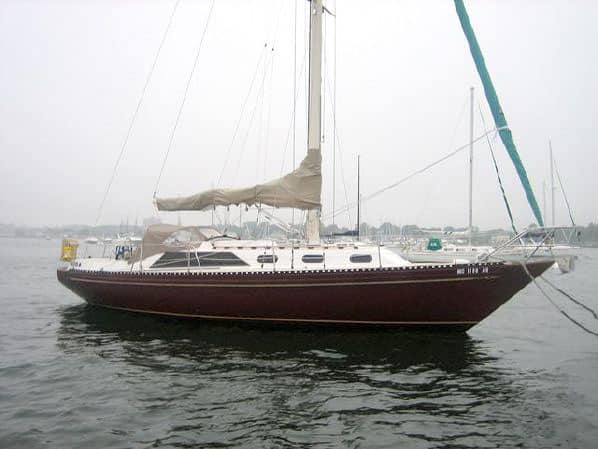
25. Islander 36
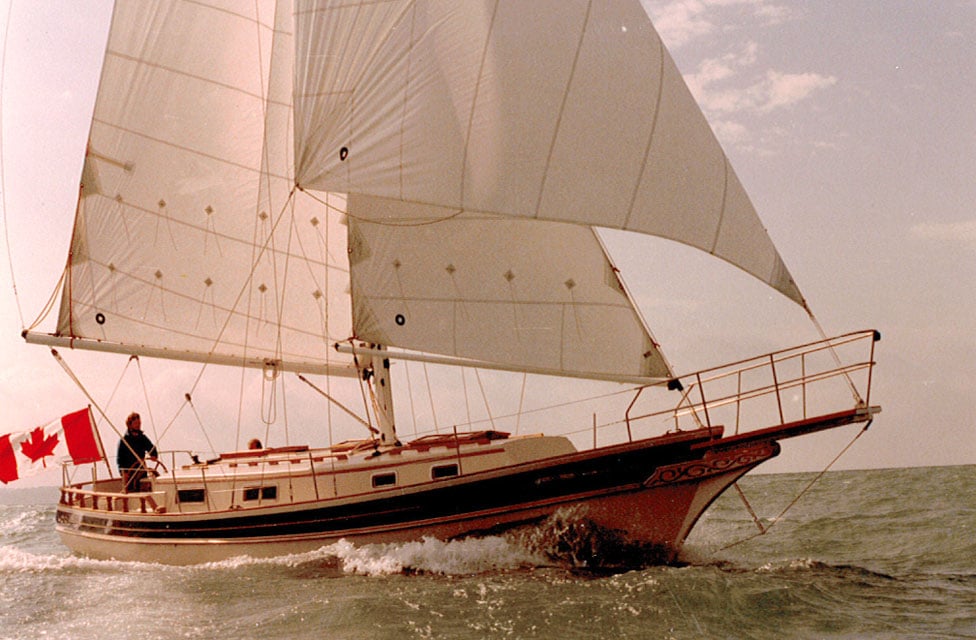
24. Gozzard 36
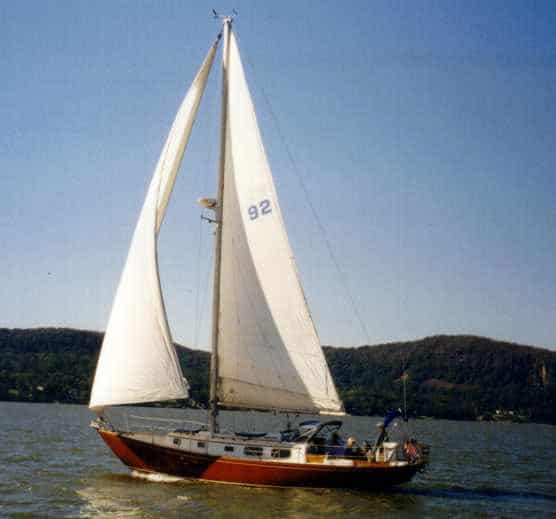
23. Bristol 40
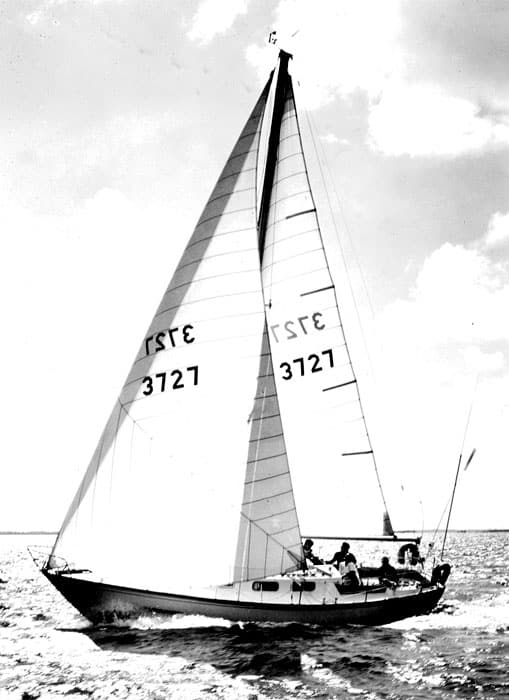
22. Tartan 34
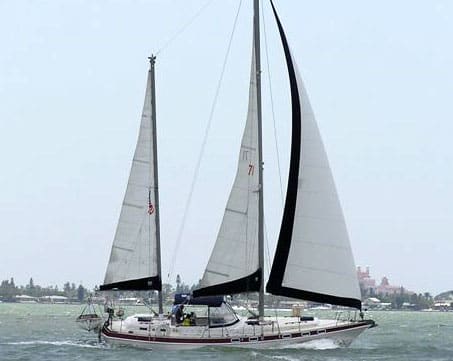
21. Morgan Out Island 41
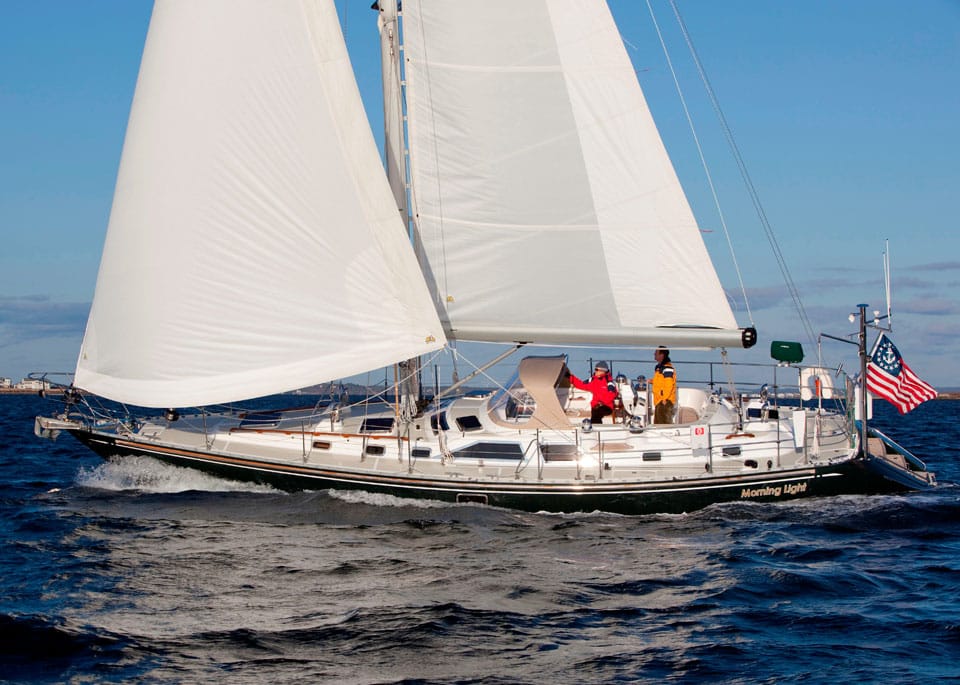
20. Hylas 49
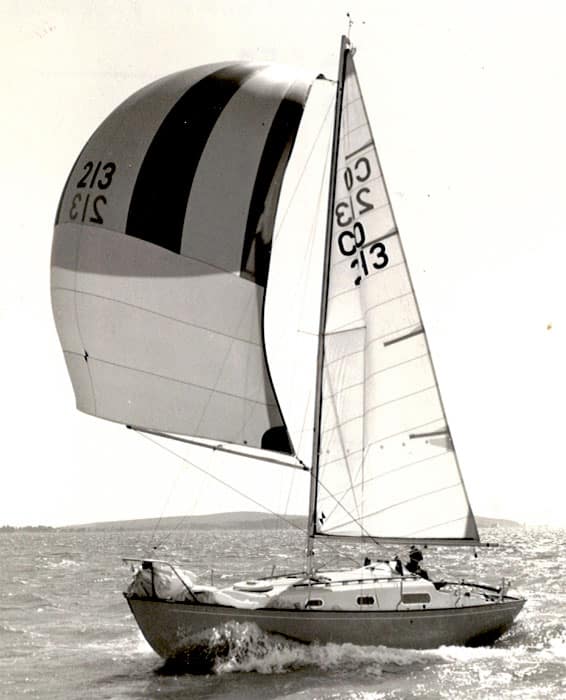
19. Contessa 26
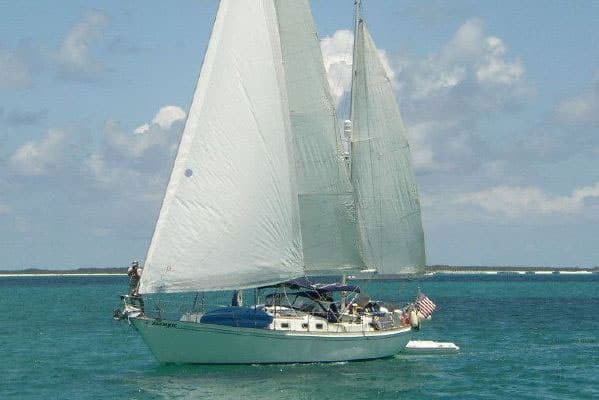
18. Whitby 42
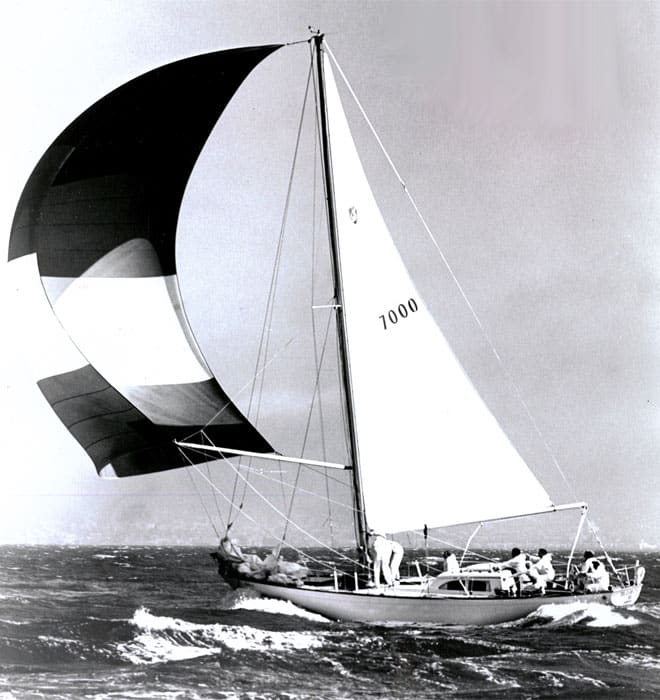
17. Columbia 50
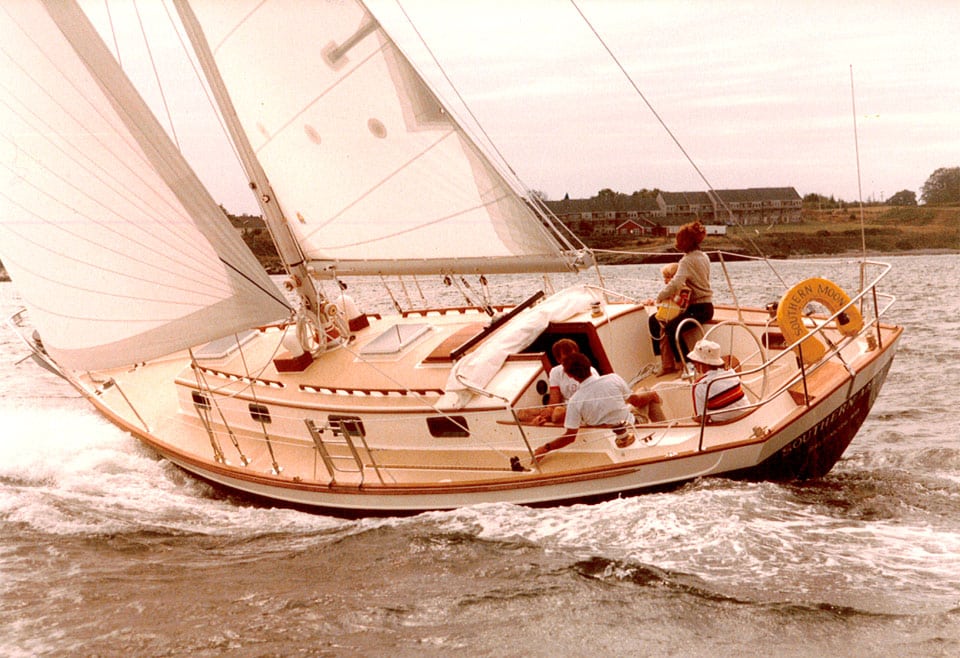
16. Morris 36
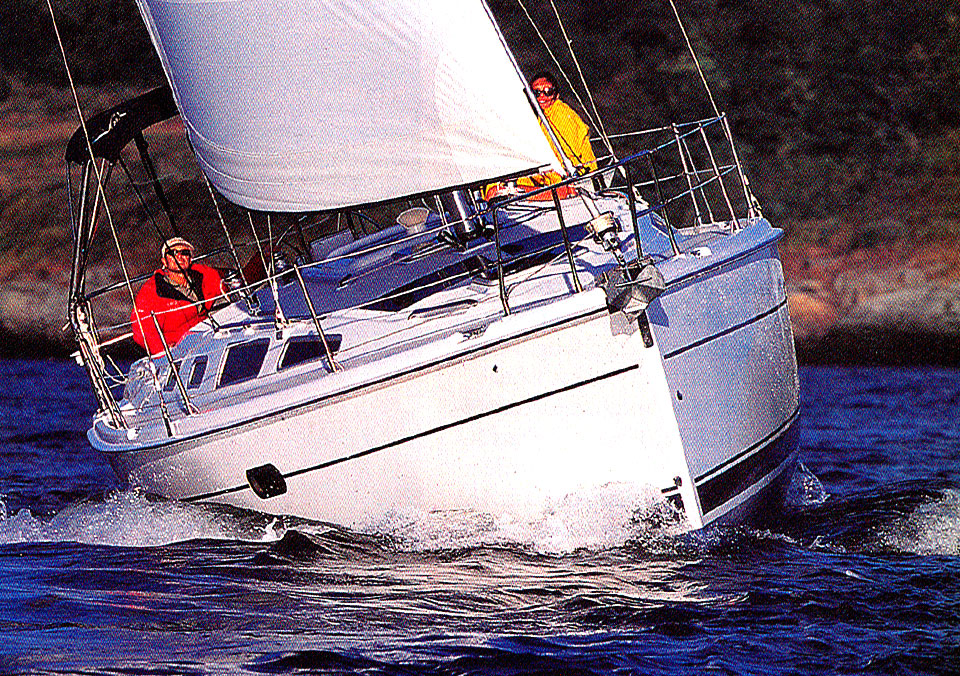
15. Hunter 356
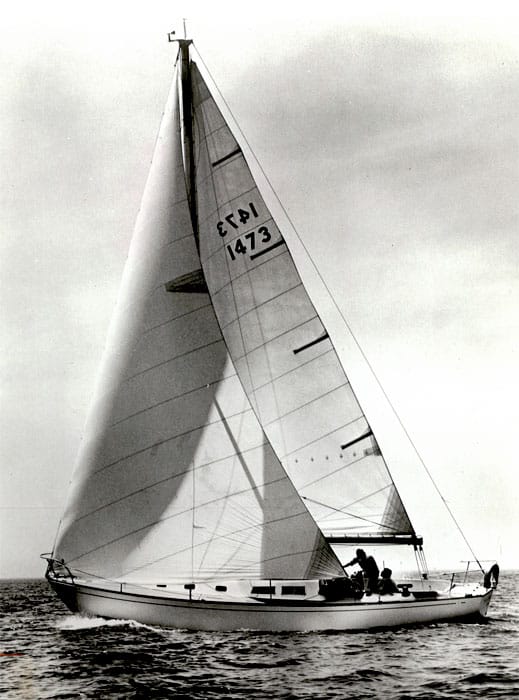
13. Beneteau 423
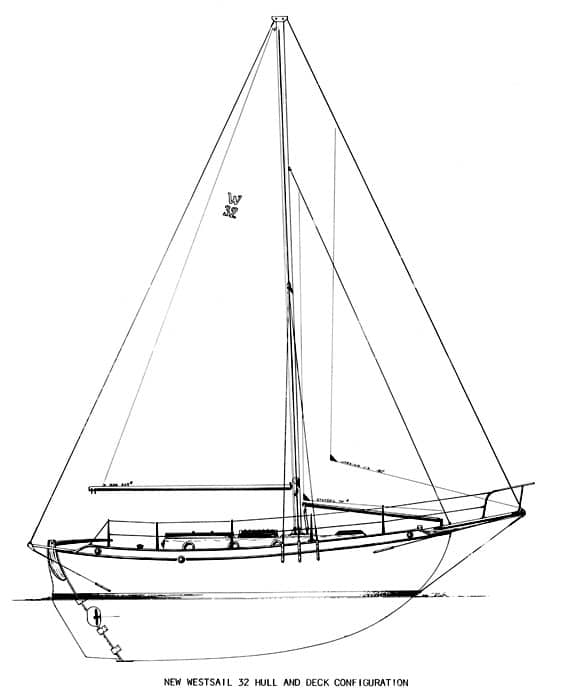
12. Westsail 32
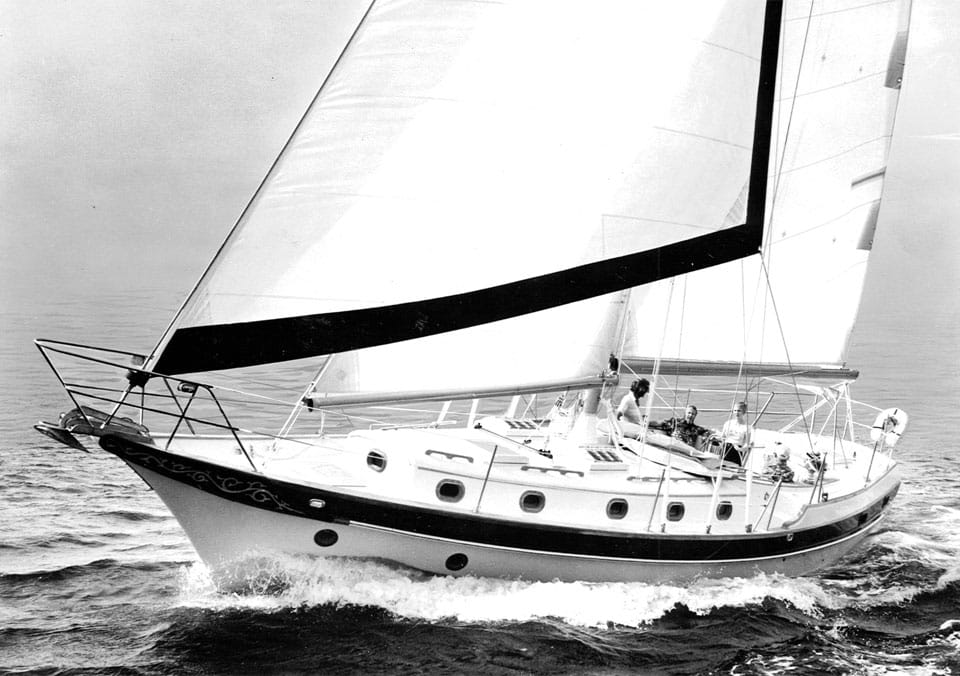
– CHECK THE WEATHER – The weather changes all the time. Always check the forecast and prepare for the worst case. Safety Tip Provided by the U.S. Coast Guard
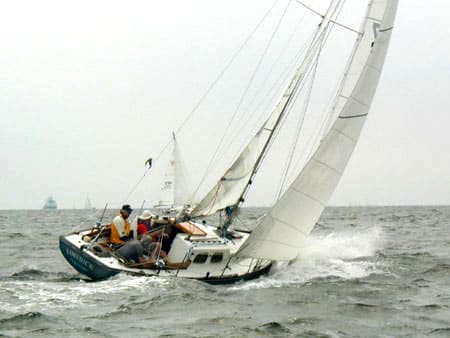
10. Alberg 30
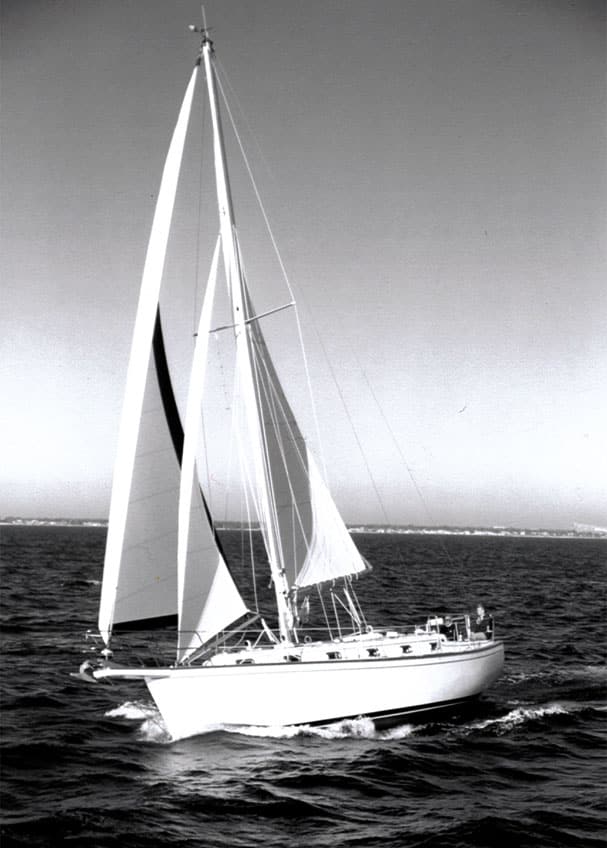
9. Island Packet 38
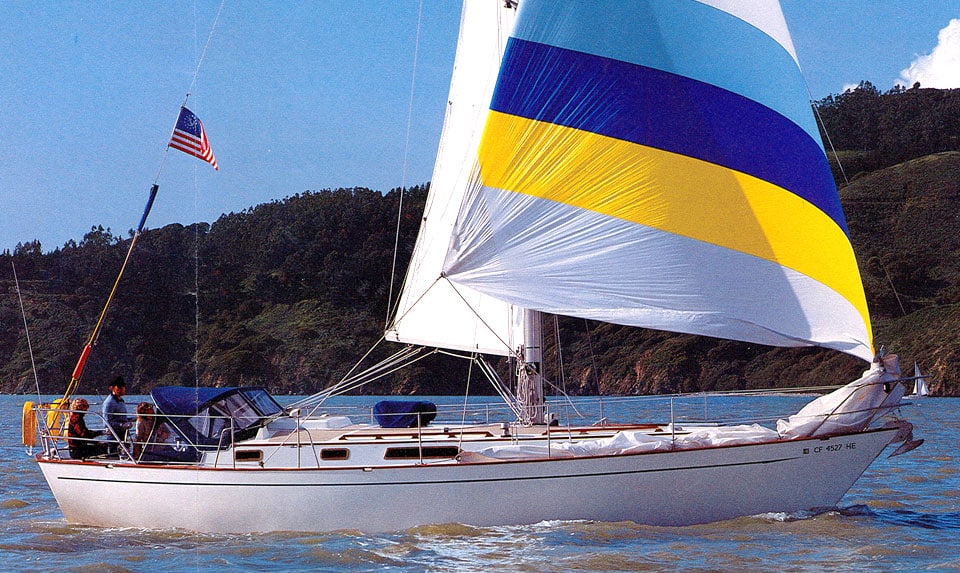
8. Passport 40
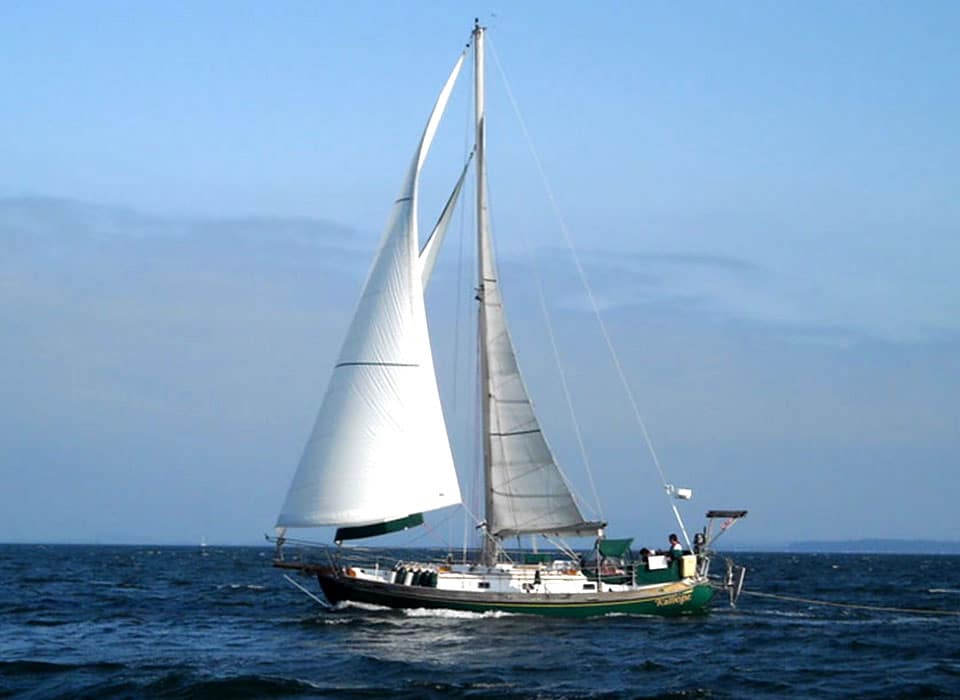
7. Tayana 37
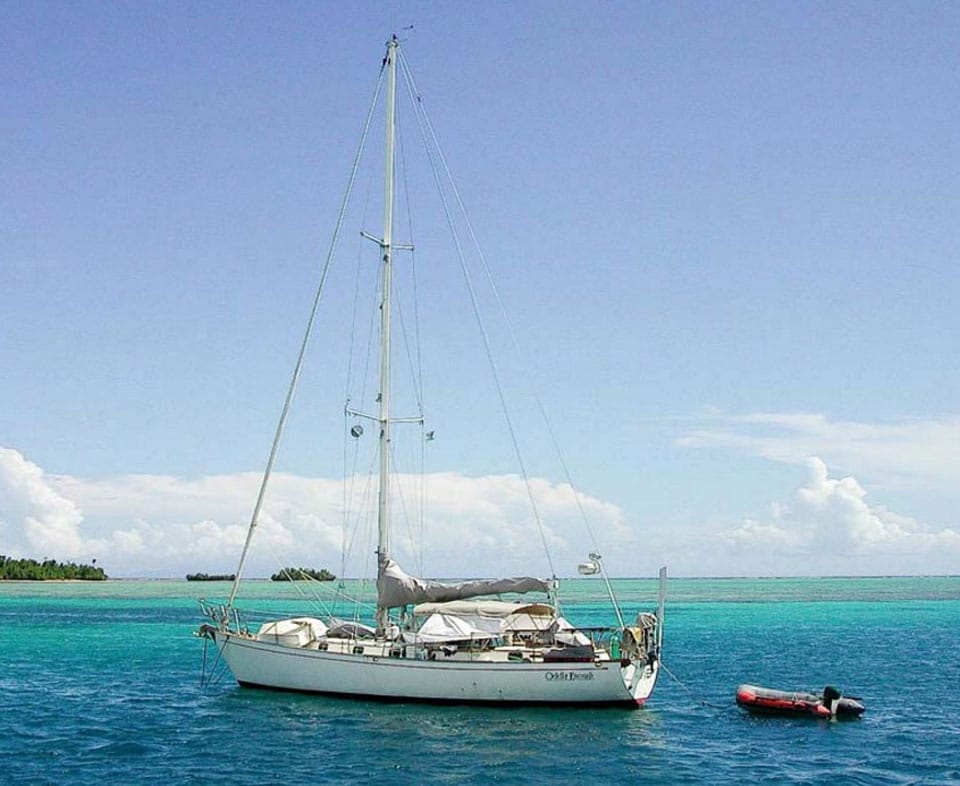
6. Peterson 44
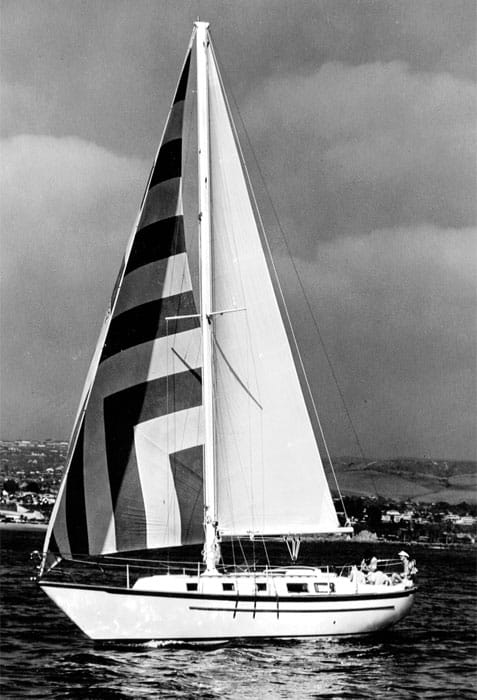
5. Pacific Seacraft 37
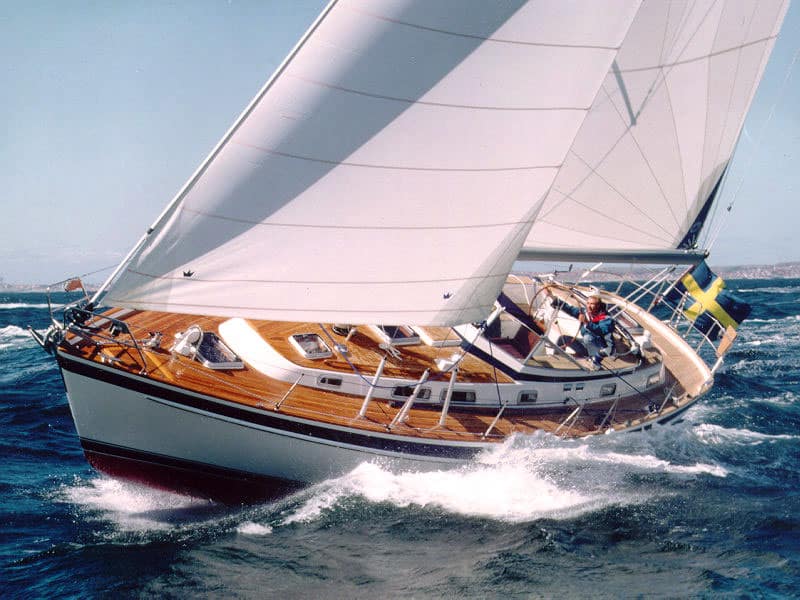
4. Hallberg-Rassy 42
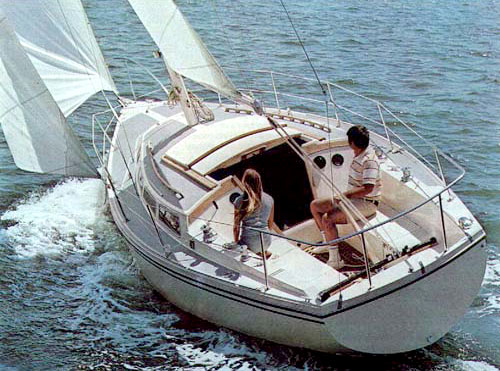
3. Catalina 30
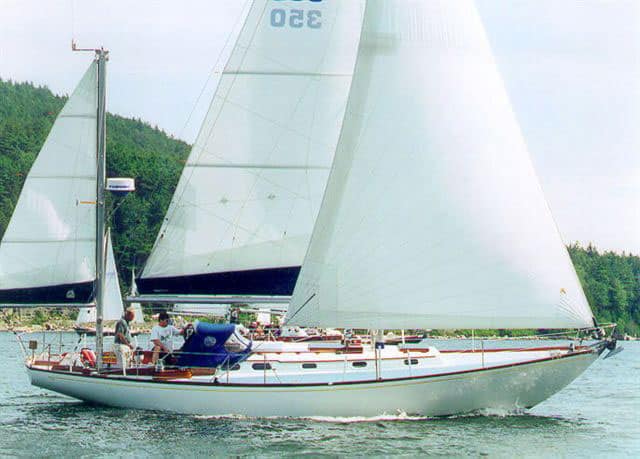
2. Hinckley Bermuda 40
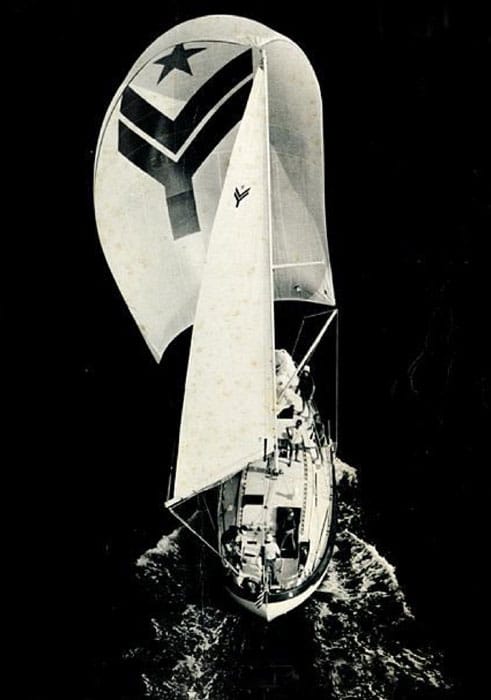
1. Valiant 40
- More: monohull , Sailboats
- More Sailboats

Sailboat Preview: Elan GT6 Explorer

For Sale: 1984 Camper & Nicholsons 58

Alubat Updates OVNI Models

For Sale: Little Harbor 63 Ketch

From Paradise to Medical Emergency: A Bahamas Nightmare Turns Lesson Learned

Free Medical Advice: The Unwarranted, Unprofessional Edition

Gatekeepers of the Waterway

Rigging Redo: Our Switch to Synthetic
- Digital Edition
- Customer Service
- Privacy Policy
- Terms of Use
- Email Newsletters
- Cruising World
- Sailing World
- Salt Water Sportsman
- Sport Fishing
- Wakeboarding
Pontoon Boats
- Personal Watercraft
- nauticalknowhow
- Nautical Knots
- Tools and Calculators
45 Types of Boats
There are literally hundreds of different types of boats in the world. For some, the difference between them is very little. For instance, a pontoon and a tritoon are the same boat save for the addition of a single extra pontoon tube. Other boats are highly specialized like a crane boat which may be used for lifting freighters out of the water. And yet others are mostly lost to history, like the boita vessels of the Kalinga region of India.
Let’s take a look at some of the more common boats you’re apt to see in the world today, and maybe a few less common ones.
Banana Boat
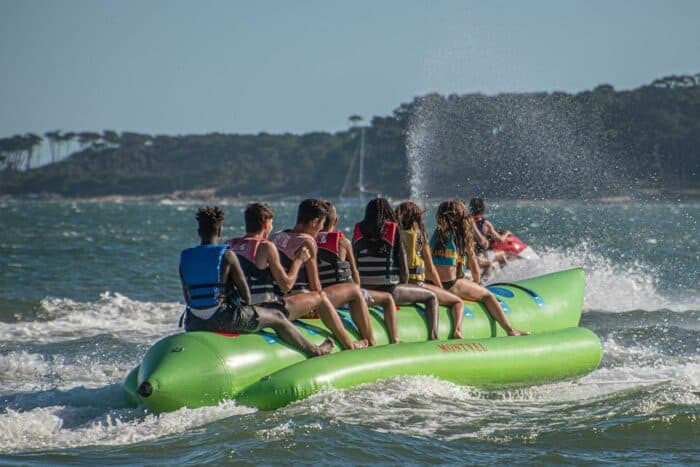
Historically there are actually two kinds of vessels known as banana boats. The less common version in the modern world is the banana boat transport ship which carried bananas as freight from their tropical origins to ports in Europe and North America.
In the modern parlance, a banana boat is a long, banana-shaped inflatable craft used for recreation. They can seat as many as 10 people and they are towed behind other boats similar to water skiing or tubing.
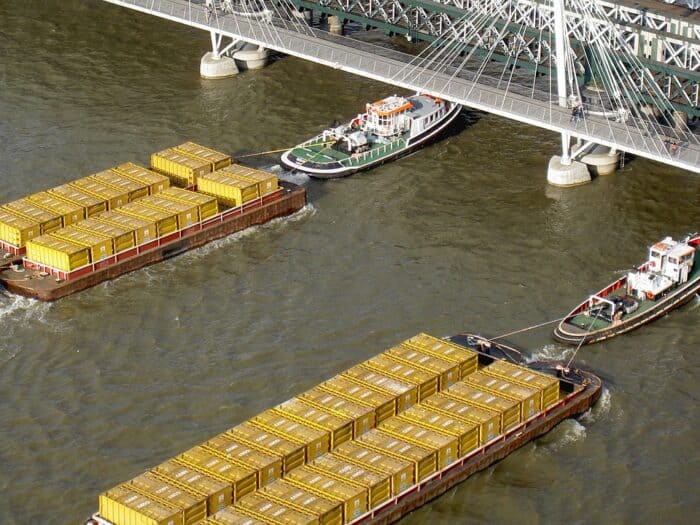
Barges are flat bottomed boats that are used in rivers, canals and other inland waterways. Usually these are just used to carry freight and cargo and sometimes they are not even able to do so under their own power, rather they are pushed or pulled by tugs.
Bass Fishing Boat
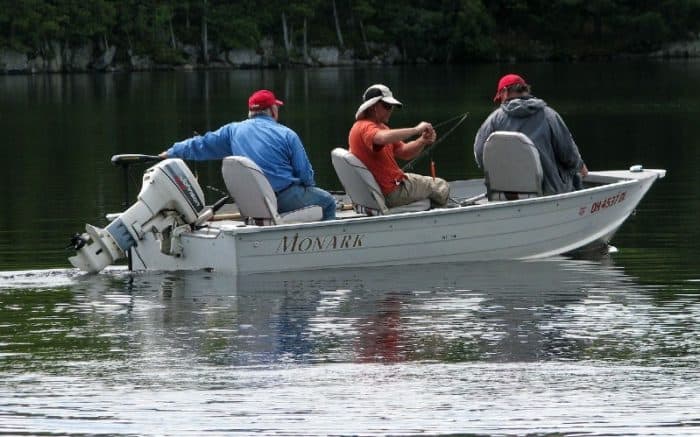
A bass boat is a small motor boat for use in freshwater specifically for freshwater fishing and, in particular, bass fishing. They often feature livewells for holding fish as well as flat decks and room for several anglers. The seats in bass boats actually swivel to allow you to shift from one side of the boat to the other very easily. There will also be more storage for fishing gear and rods than you’ll find on the average boat.
A bass boat will be powered by an outboard motor but it should also have a trolling motor for maneuvering as well.
Bowrider Boat
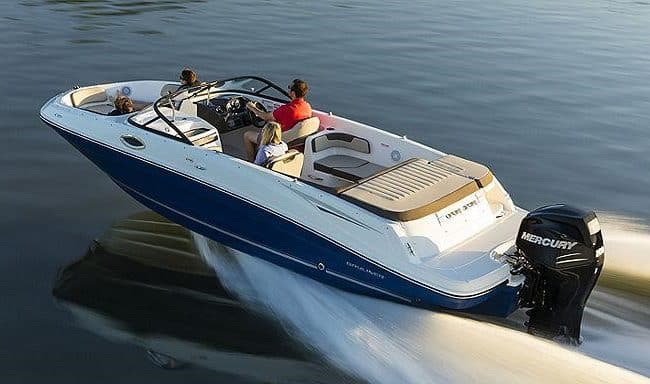
Bowrider boats have an open bow area to allow for additional seating. Bowriders are often lumped under the umbrella of runabouts but while a bowrider is a runabout not all runabouts are bowriders, obviously. Most bowriders are between 20 and 35 feet. They typically have sterndrive or outboard motors and can offer seating for around 6 to 10 passengers. They will have a deep v-shaped hull and are good boats for things like water skiing and cruising.
Cabin Cruiser Boats
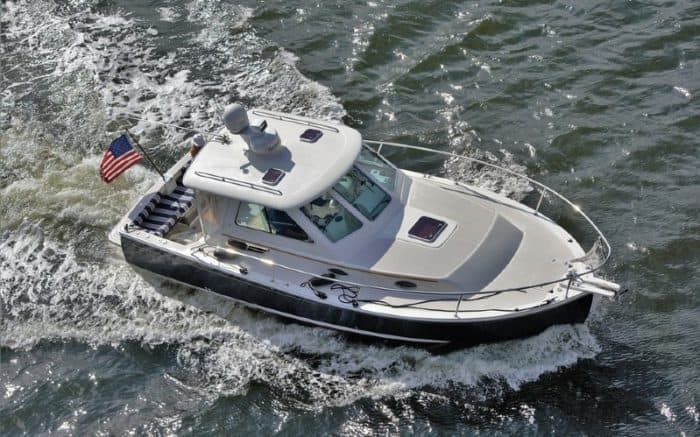
A cabin cruiser is a power boat that features a cabin on the vessel so that crew or passengers can spend the night on the boat. Typically these accommodations are larger and more well-appointed than what you’ll find in a cuddy cabin, but definitely not as luxurious as a yacht or a houseboat. A good-sized cabin cruiser over 40 feet should have private staterooms, a head and a cooking and dining area. You can comfortably sleep half a dozen people in most cabin cruisers and many more in larger ones.
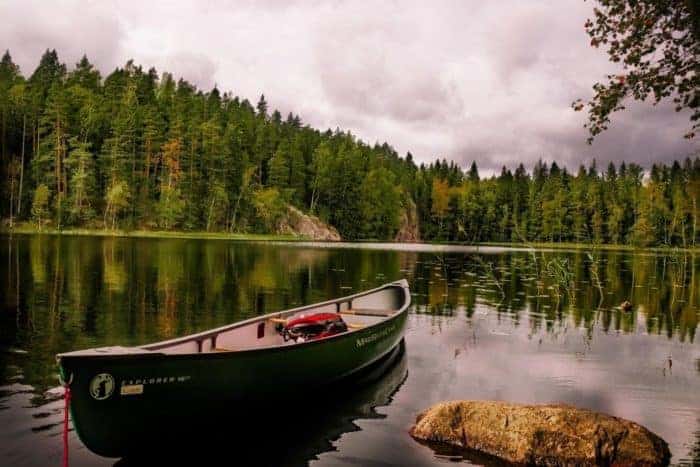
One of the oldest and most recognizable kinds of boats, a canoe is a long, narrow craft which is paddled by the boater. A single bladed paddle can be used by one or more passengers. Canoes are pointed at the bow and after and can come in a variety of lengths such that they have room for one or many passengers inside.
Canoes can be made from wood, fiberglass or aluminum and are typically lightweight enough to allow them to be carried, or portaged, from one body of water to another if necessary. They are ideal for rivers, lakes and coastal waters and can be used for fishing and cruising.
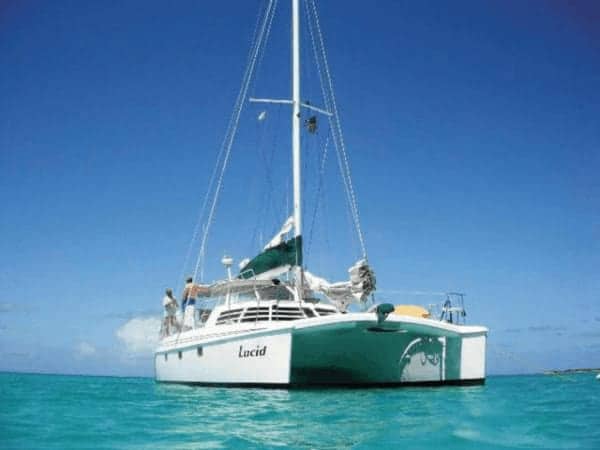
A catamaran is a boat with two distinct but equal sized hulls. The hulls are connected by a bridge deck between them. They are known for offering a stable ride and can be powered by engines or wind.
Center Console Boats
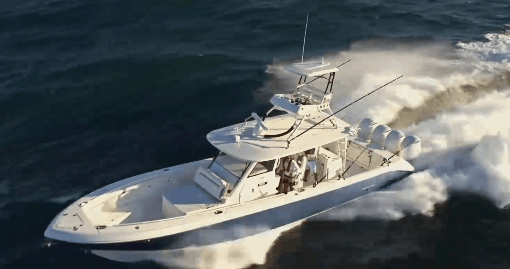
As the name suggests, a center console boat features the helm control is the center of the boat. If the boat is large enough it may feature a cabin or a berth inside, but smaller center consoles will not. A center console is an ideal boat for fishing because, with the console located in the middle, the rest of the boat is open in a full 360 degrees for visibility and moving around. Combined with a good amount of deck space they are easy to use and offer space for gear storage.
Cigarette Boat
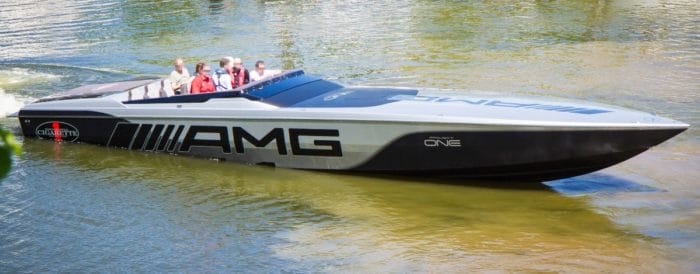
Cigarette boats are also known as cigar boats , rum runners and, more generically, go-fast boats. The names cigar and cigarette come from the fact they are similarly shaped, which is to say long and thin. Cigarette boat is actually a brand name for a go-fast boat.
Because of their long, sleek shape and design, these boats were ideal for smuggling as well as racing.
Cuddy Cabin Boats
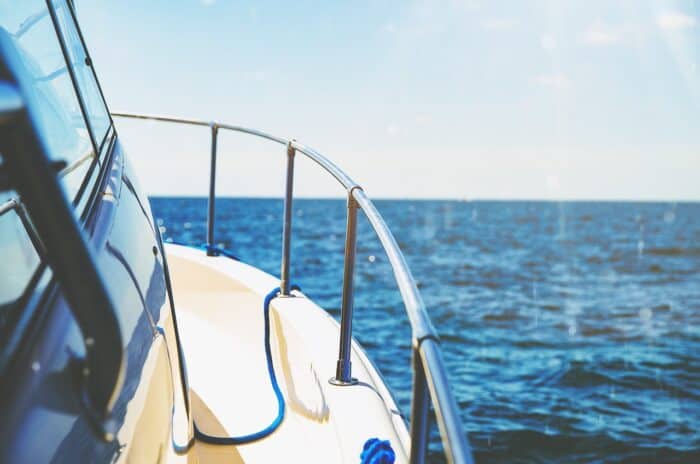
A cuddy cabin boat, or a walkaround cuddy , is usually somewhere between 18 and 25 feet. They can be used as fishing boats or cruisers and will have cabin space to allow for overnight trips as well, which is what the term “cuddy” refers to. In this case, a cuddy is a berth in the V of the boat’s bow that will also have a small head and maybe a sink. Sometimes the cuddy is simply used for storage though it can easily be used for sleeping.
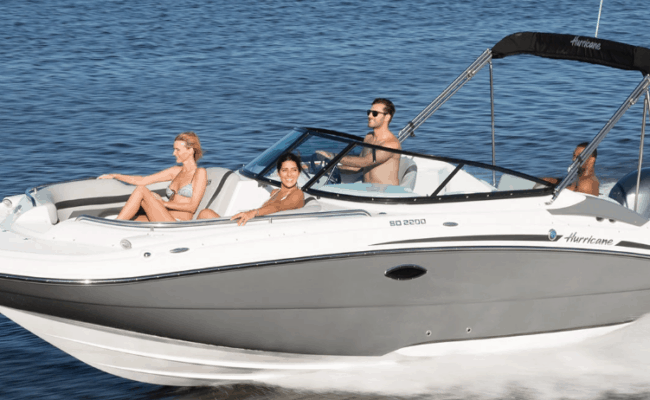
Deck boats have wide bows which allow for larger deck space, hence the name. The hull is a v-shaped but more flared with a typical boat to allow for that extra space. Deck boats are often compared to pontoon boats but the traditional hull of a deck boat means they will not generally have the same amount of space as a pontoon.
Dragon Boat
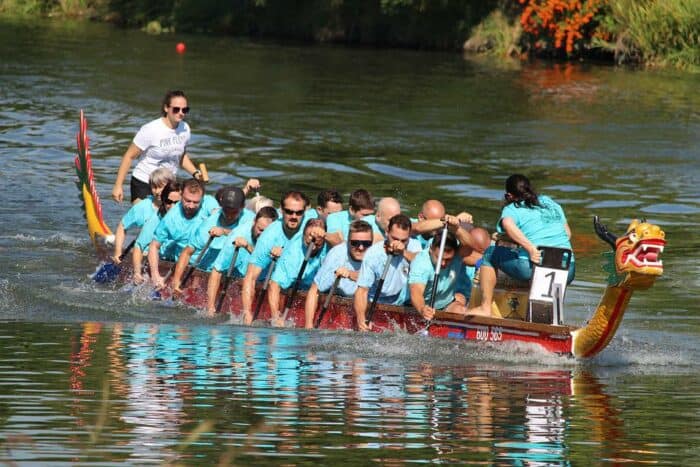
Dragon boats originate in China and are used for racing these days. Similar to canoes in design, they are generally about 40 feet long and are powered by 16 to 20 paddlers split evenly between the two sides of the boat paddling with oars to propel the boat forward. There will be a steersperson at the front of the boat and also a drummer at the back to maintain a pace for the rowers.
The boats are made of wood traditionally and have been used for over 2000 years. The ends of the boat are usually decorated with dragon heads and tails to complete the look.
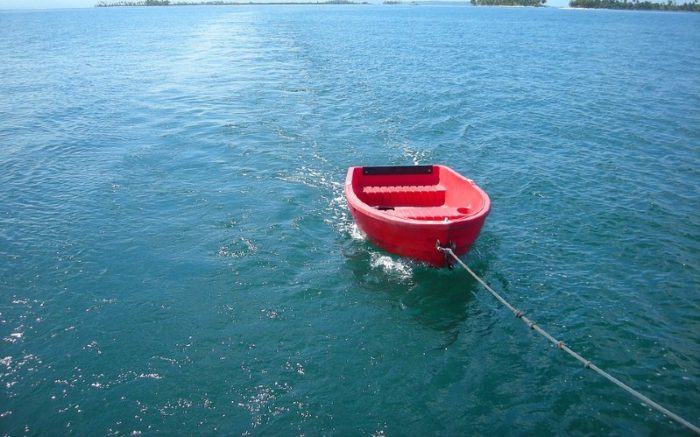
Dinghy is another general, catchall term for a number of very small boats. Typically a dinghy will only have room for one or two passengers. They can be rowed with oars or sailed with small sails. Some feature small outboard motors as well. Dinghies are frequently carried by or towed by larger boats for the purpose of allowing crew to leave the larger vessel and take the dinghy ashore.

Also called an airboat, a fan boat looks similar to a hovercraft but does not have the air cushion beneath it. Instead they will have a rigid, flat bottom hull design that is usually aluminum. Airboats are most often used in swamp and marsh areas where a propeller engine would not be practical due to shallow waters and numerous hazards that would get caught in the props. With a very shallow draft and a powerful fan engine, the fan boat is able to skin across the surface of shallow areas.
Ferry Boats
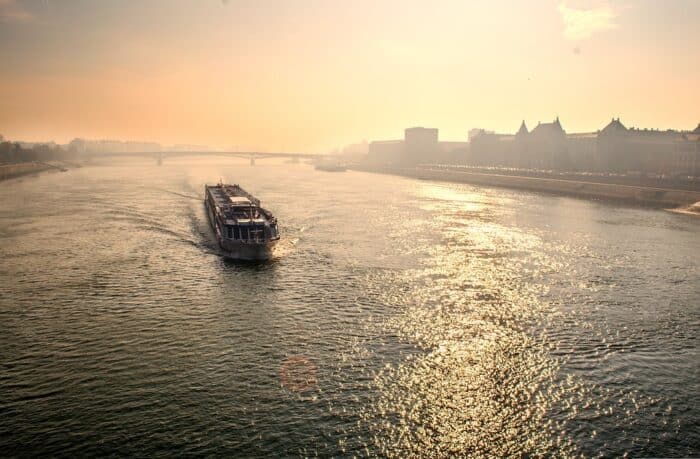
A ferry is a passenger vessel that usually runs a scheduled route between two points. Small ferries may simply offer transports for people while larger ferries can accommodate vehicles as well. Ferries generally operate in one of two ways. They bring people to and from specific destinations which can only be accessed by boat or they provide tours such as the Maid of the Mist ferry which allows passengers to get a closer look at Niagara Falls.
Fishing Boats
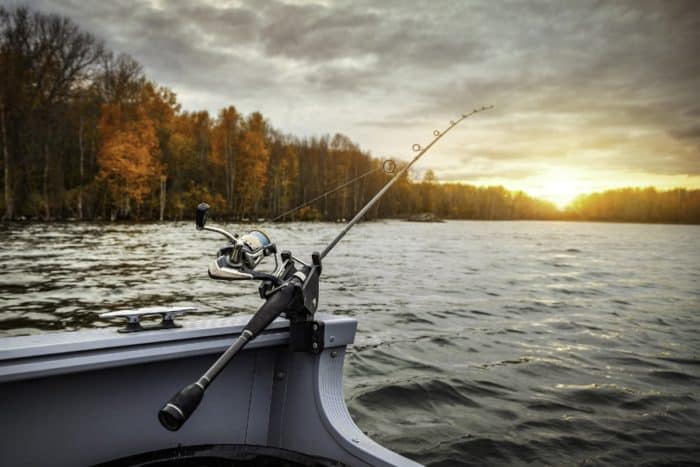
Fishing boat s are one of the most loosely defined boat types. It’s a catchall term for really any boat that is used for fishing and, as such, can take on countless forms. From large commercial vessels to a simple aluminum fishing boat or a sport fishing boat , as long as you can fish from the boat it qualifies as a fishing boat.
Most people, when referring to fishing boats, mean smaller vessels which can still vary greatly between freshwater and saltwater use.
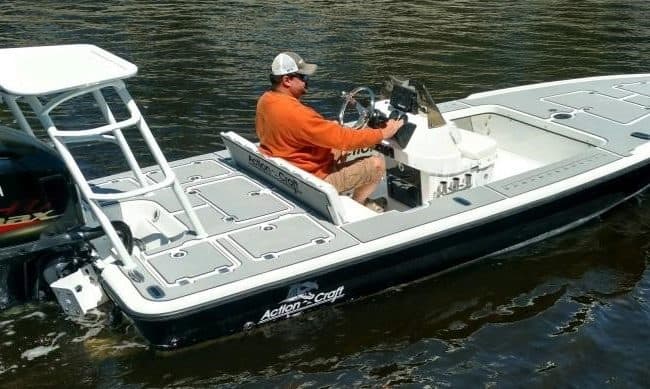
When you’re in a shallow part of the water with a flat bottom most people will call that a “flats.” Flats boats are small fishing boats with a very shallow draft perfect for fishing in flats and can handle water less than a foot deep. Usually these are coastal waters and sometimes in bays which is why flats boats are also called bay boats sometimes.
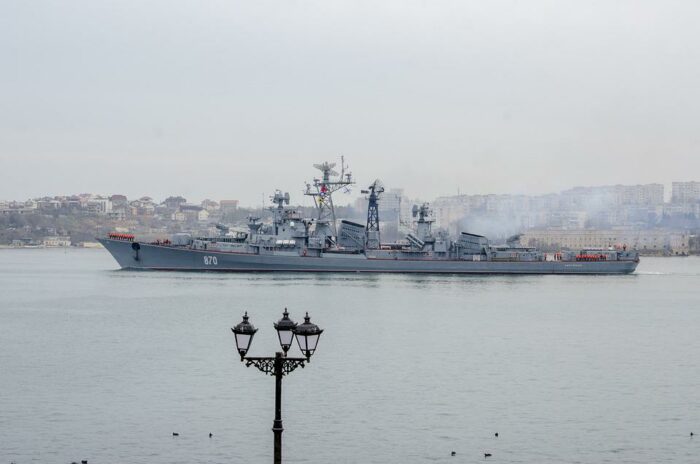
A frigate is likely something you won’t be coming across in your travels but you may still hear the name. Frigates are military vessels. Once upon a time they were three-masted warships and today they are still ships of war through noticeably without sails. They tend to be smaller than Destroyers but serve much the same purpose in warfare.
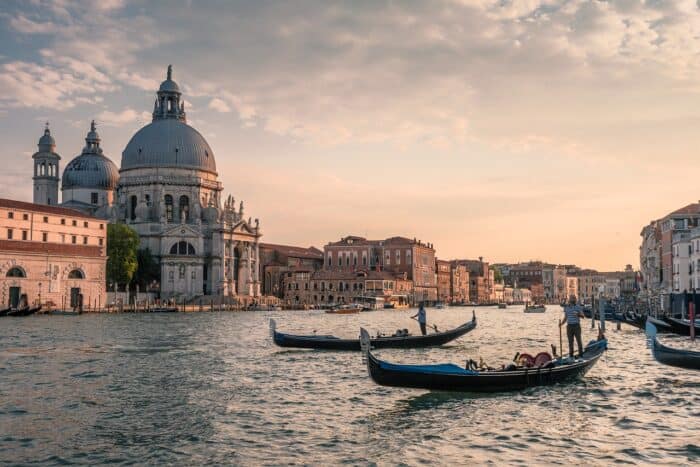
Gondolas are flat bottomed rowing boats similar to long, narrow canoes. They are most famously found in the canals of Venice in Italy although they are also prominent in some Asian countries for navigating along rivers and canals as well. You can also find gondolas in places like New Orleans and Boston. A gondola is usually a passenger vessel operated by a gondolier who will stand at the bow of the vessel and use a long oar to maneuver the boat.
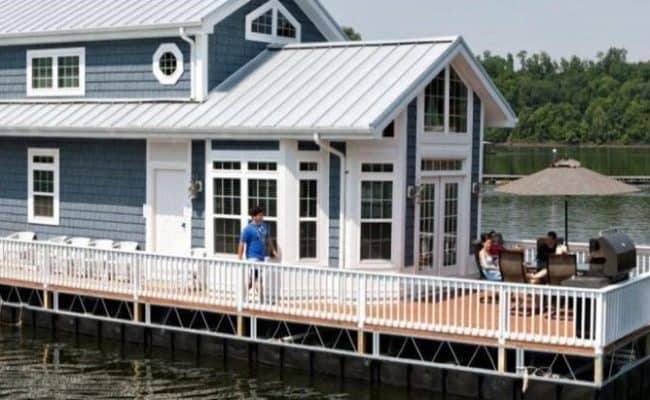
A houseboat is a boat that serves as a full time residence and therefore contains all the amenities you would expect in an actual house including multiple bedrooms, bathrooms, fully functional kitchens and so on. A houseboat can be operated and taken out for cruising or fishing but most are permanently moored in a place that will serve as a residence. This allows for the boat to be connected to utilities such as electricity from a land-based source, as well as having access to clean water.
Some houseboats can get incredibly extravagant with multiple floors, indoor swimming pools, wine cellars and more.
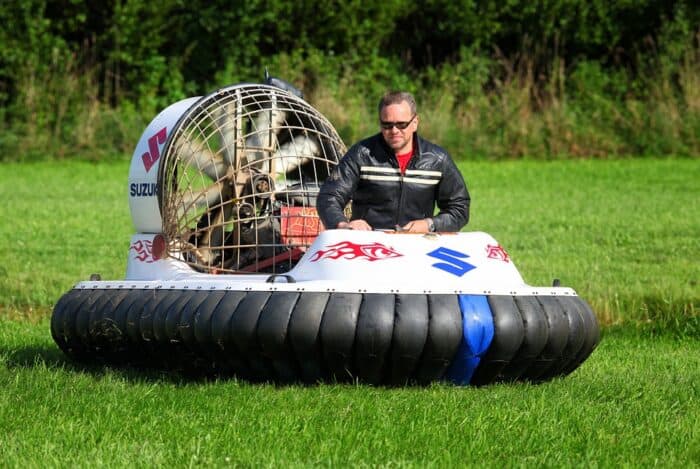
A hovercraft is able to travel over both water and land and is sometimes called an air cushion vehicle or ACV. Air fills a skirt or cushion beneath the vessel’s hull to provide lift. Unlike some other boats that use air to achieve lift, like a hydrofoil, the design of a hovercraft means they can take advantage of the lift even while not in motion. As well, they are not limited to operating solely on the water. Many hovercraft designs also include a large fan in the rear for propulsion.
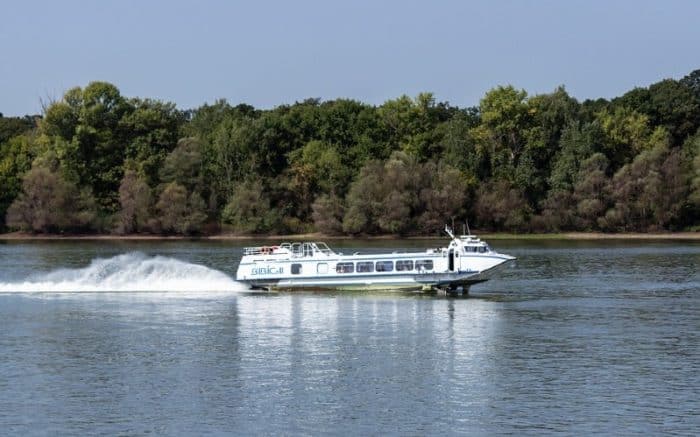
A hydrofoil boat uses a hydrofoil, sometimes just called a foil, to provide lift to the boat as it reaches speeds. These foils look like feet that extend under the boat into the water. They are fully submerged when the boat is at rest or moving slowly and cause the boat to have a deep draft which means they cannot be used safely in shallow water.
As a hydrofoil gains speed, the foils will lift the hull of the boat out of the water. This cuts back on drag and allows the boat to travel faster and operate far more efficiently. The ride is often more comfortable for passengers as well.
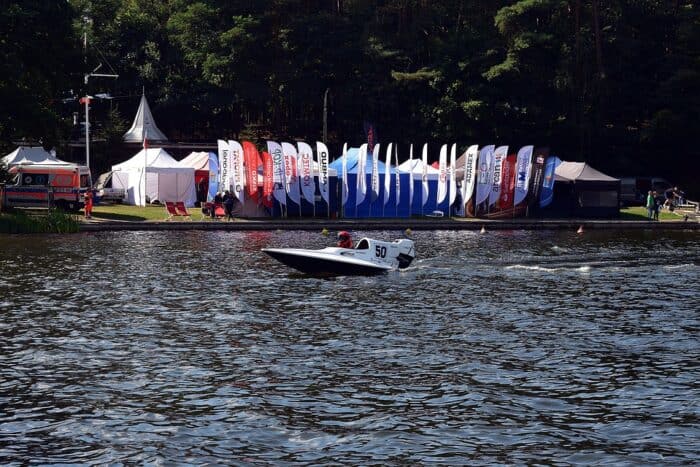
A hydroplane, sometimes called a thunderboat, is a racing boat that often looks like some kind of wingless jet or spacecraft on the water. They are designed so that, at high speeds, they plane on the water to stay afloat rather than having to rely on the buoyancy of the hull. That means hydrodynamic lift keeps the boat above the water, in much the same way a stone will skip across the surface of the water when thrown properly.
Inflatable Boats
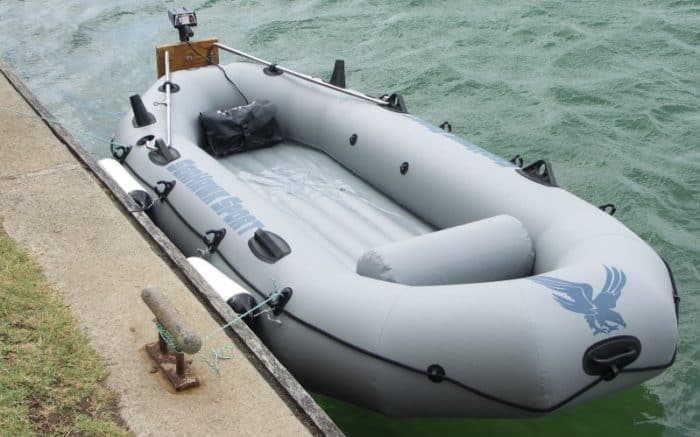
An inflatable boat can take several forms and may include anything from a dinghy to a liferaft and even inflatable pontoon boats. Any lightweight boat that has a hull made entirely from flexible tubes or supported by those flexible tubes that can be filled with pressurized air to provide buoyancy and structure to the boat can be considered an inflatable.
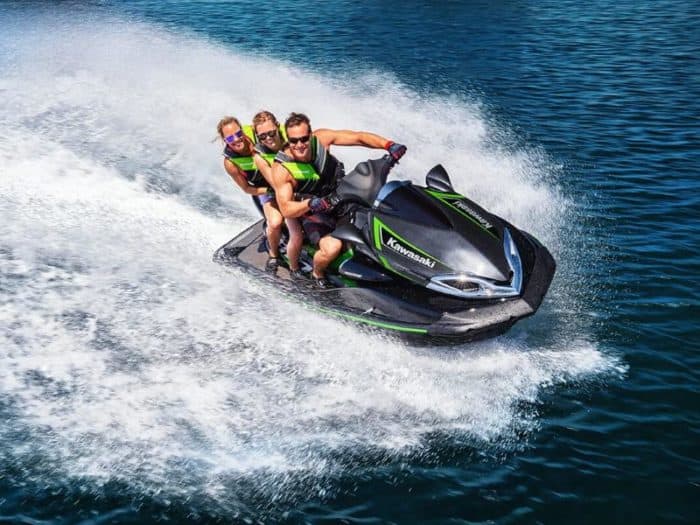
Any boat that moves thanks to jet drive propulsion qualifies as a jet boat . This would also include personal watercraft, strictly by this definition. A jet drive differs from an outboard or even inboard motor which uses a propeller to rotate through the water and push the boat forward. A jet drive draws water inside with an impeller and then expels the water with force out of the rear of the vessel. The pushing out of a jet of water forces the boat to move forward. Some jet boats produce a massive jet of water from the rear known as a rooster tail.
The fastest boats in the world are jet boats with those outfitted for racing able to reach speeds well over 300 mph.

A jon boat is a very basic, flat-bottom vessel usually reserved for fishing or cruising. It may have one to three benches inside for seating and little else. Hulls are typically aluminum and sometimes fiberglass and should not exceed 24 feet. Because they have an extremely shallow draft they are ideal for use in rivers, swamps and other shallow water areas. Jon boats typically use an outboard or trolling motor to maneuver around. They’re considered good boats for newcomers to boating and are not difficult to control.
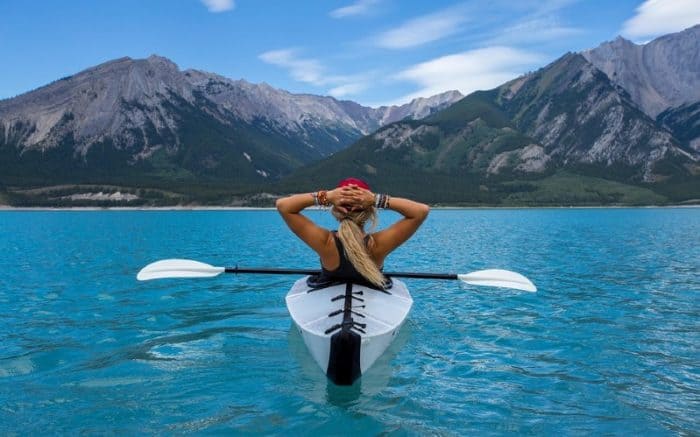
Similar to a canoe but with a covered deck and dual paddles. Kayak the word comes from an Inuit language and the boats are Inuit in origin where they were used for hunting and fishing in lakes, rivers and coastal waters. There have been numerous modifications to this original kayak design including kayaks that seat several passengers, ones you sit on top of, sailing kayaks and even motorized kayaks.
Optimist Boat
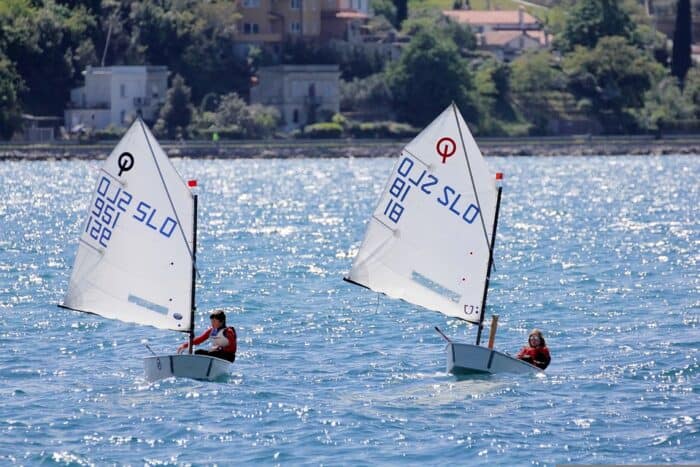
An optimist boat or optimist dinghy is usually used by children. It is a sailing vessel with room for just a single occupant. Today they are often used for racing and official races require that the boats are registered and meet some fairly strict requirements to qualify as “real” optimist boats.
Outrigger Canoe
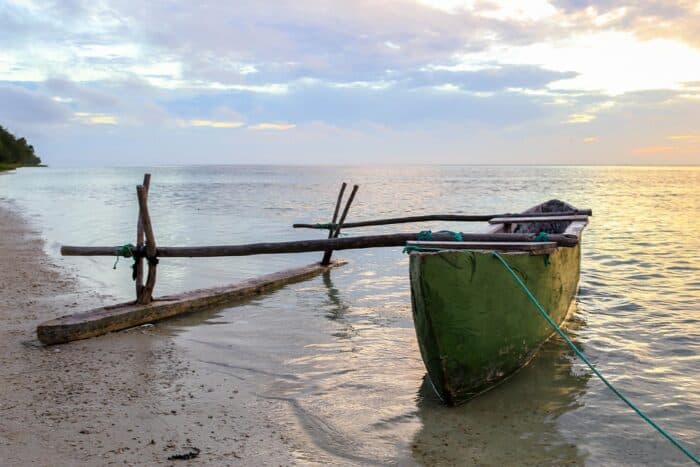
An outrigger canoe is a traditional canoe that has been outfitted with an additional one or even two buoyancy supports. Often a single outrigger will extend from one side or the other of the canoe’s hull. The outrigger can be similar to a pontoon or even just a log in very simple designs. Anything that offers buoyancy and stability to the main vessel. An outrigger can be affixed to both sides producing a look similar to a trimaran.
Paddle Boat
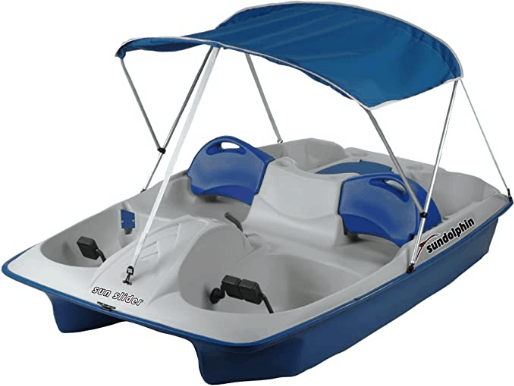
Also called a pedalo, a paddle boat requires human power rather than wind or a motor to move it. The operator and/or passenger pedals in a similar fashion to a bicycle which in turn rotates a paddle wheel to provide propulsion. These are typically used in ponds or calm river stretches. Steer is usually limited to a very simple rudder control that will allow for very slow and simple turns while the paddle itself provides propulsion only as powerful as your legs can manage.

A pontoon boat uses aluminum or inflatable tubes, called pontoons, to keep the hull above the water. This provides good stability and buoyancy. Some boats have a third pontoon and may be called tritoon boats. They offer more deck space than typical v-shaped hull boats but tend to be slower overall. Pontoon boats are ideal fishing and cruising boats, and their large deck space makes them ideal boats for families. They are not well suited for open waters and rough seas, however.
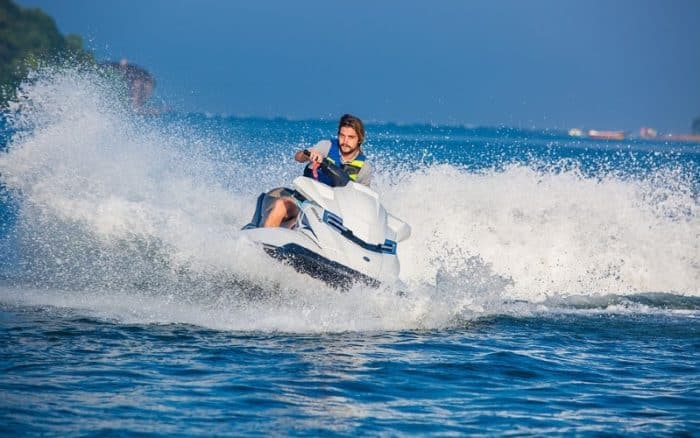
A PWC or personal watercraft is often called a Sea Doo or jetski. These recreational craft are usually used by just one person but some have room for passengers. They are operated by sitting or standing on them rather than in them as you would a boat. PWC are powered by outboard jet drive propulsion. In addition to recreation activities, PWC are often used by lifeguards because of their speed and maneuverability. Most states have additional laws for boaters using PWCs that need to be followed.
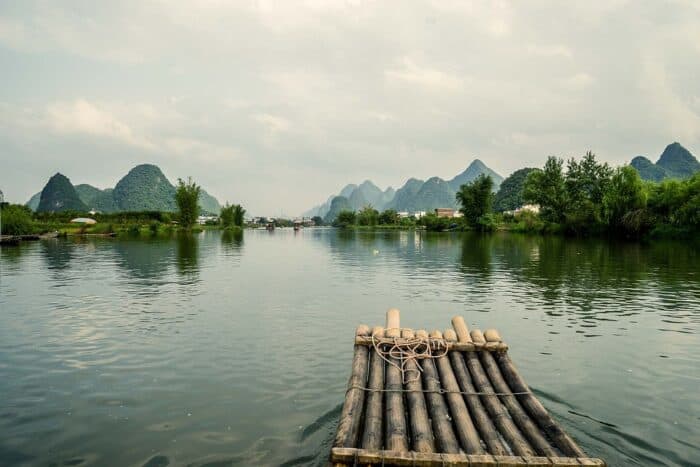
A raft is one of the simplest and most basic structures that can qualify as a boat. It is a flat structure devoid of sides and may be as simple as boards, branches or logs lashed together to provide a surface that can hold a passenger. Their buoyancy comes from the materials, such as wood, rather than any kind of strategic hull design. That said, pontoon rafts can also be easily made even from simple materials like air-filled barrels.
Rigid-Hull Inflatable
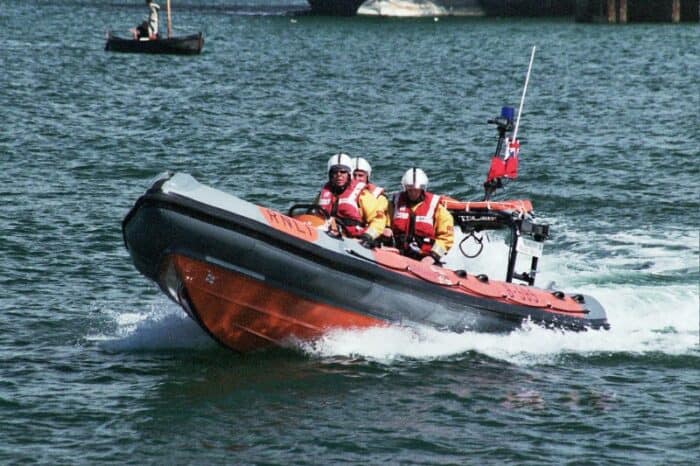
Also called a RIB, a rigid-hull inflatable boat has a rigid bottom made of something like aluminum, with inflatable tubes making up the sides to give structure and buoyancy. Life boats and dinghies will often be rigid-hull inflatables.
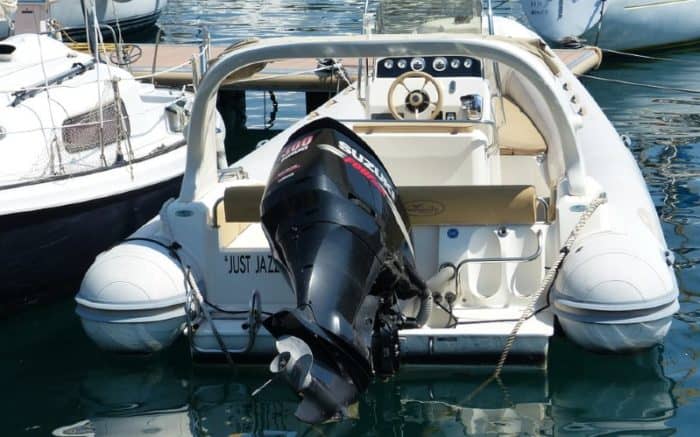
Runabout is a general term that can apply to several specific kinds of boats. In general, a runabout is a motorboat that can be used for fishing, cruising, or watersports. It seats several people, around a half dozen or so, and is usually between 20 feet and 35 feet. The steering is located at the front and there’s probably a windshield as well. Runabouts are fairly basic boats that are well-suited to newcomers.
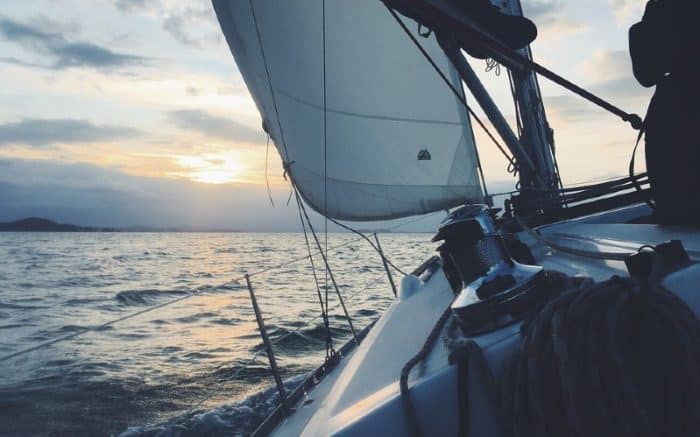
Any boat propelled by the power of the wind acting on sails is a sailboat . Within that definition there can be different types of sailboats including schooners, cutters, sloops, ketches, catamarans and many others. These are historically some of the oldest boats in the world dating back thousands of years. Sail boats can be small enough to hold just a single passenger or massive enough to accommodate hundreds. With the advent of motorized travel, most sailboats only exist as recreational vessels.
Modern sailboats are recreational craft used for fishing, racing and cruising.
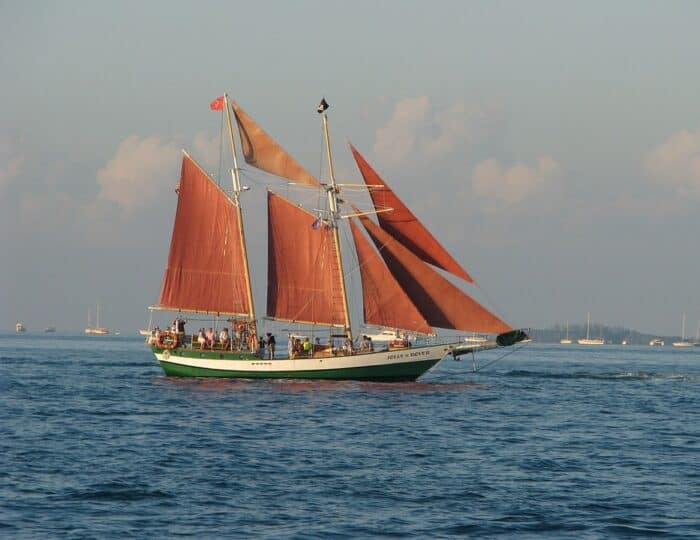
A schooner is a sailboat with at last two masts. To qualify as a schooner the after mast or masts have to be as big or bigger than the foremast. Technically you would only use the word “schooner” to describe such a boat with two masts and if it had four masts, for instance, you would call it a four-masted schooner.
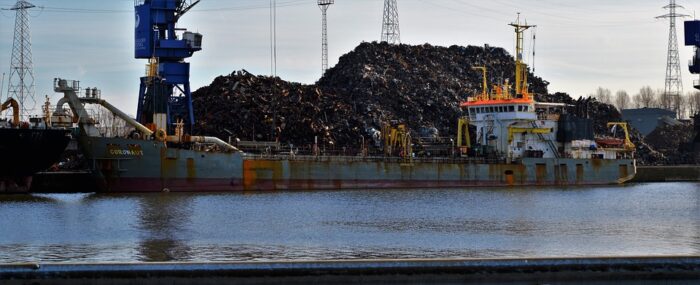
A scow is a large, flat bottomed boat like a barge but not as big. The ends are squared off and the purpose of the vessel is generally for transportation. Arguably the most well known type of scow is a garbage scow which, as the name suggests, transports large quantities of trash.
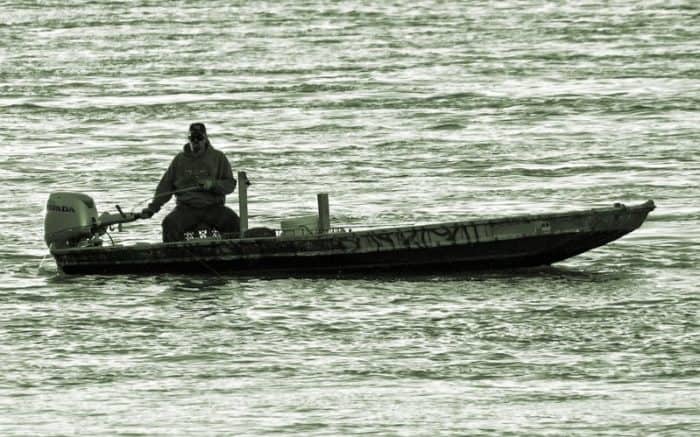
A skiff is not a specific type of boat. Any small, flat-bottomed boat with a squared off aft section and a pointed bow would likely qualify as a skiff. These are usually used for things like river fishing and can be operated with lower horsepower outboard engines.
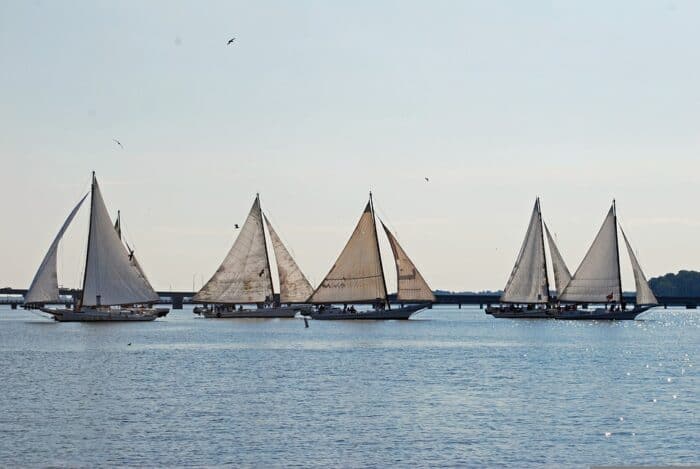
This is the state boat of Maryland and was traditionally the boat used in the Chesapeake Bay for oyster dredging. They are two-masted sailboats with what they call a leg-o-mutton sail, which means triangular fore and aft sails behind the mast which is raked, or angled.
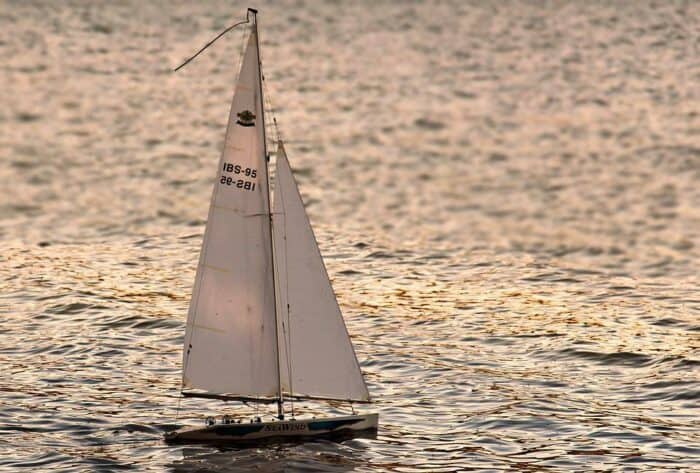
A sloop is a sailboat that has a single mast. It should only have two sails – a headsail and a mainsail. You may also see a sloop with a racing or cruising spinnaker.
Trawler Boats
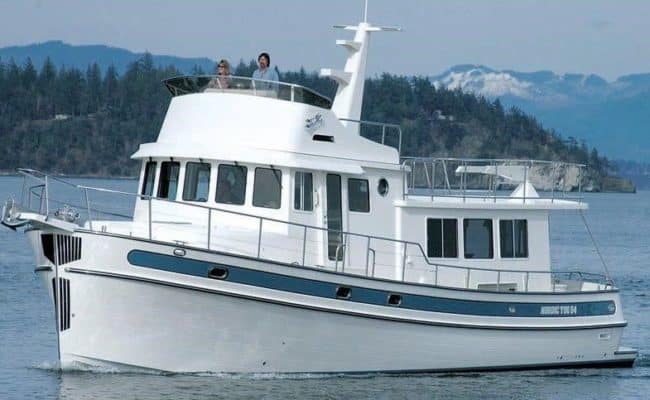
There are actually two kinds of boats called trawlers. Fishing trawlers are commercial fishing vessels that trawl for fish, which means they drag fishing nets behind them. Recreational trawlers are named after fishing trawlers and feature much the same design, they’re just not used for fishing, or not commercial fishing at least. Recreational trawlers feature cabins and creature comforts like you’d find in a cabin cruiser, a yacht, etc.
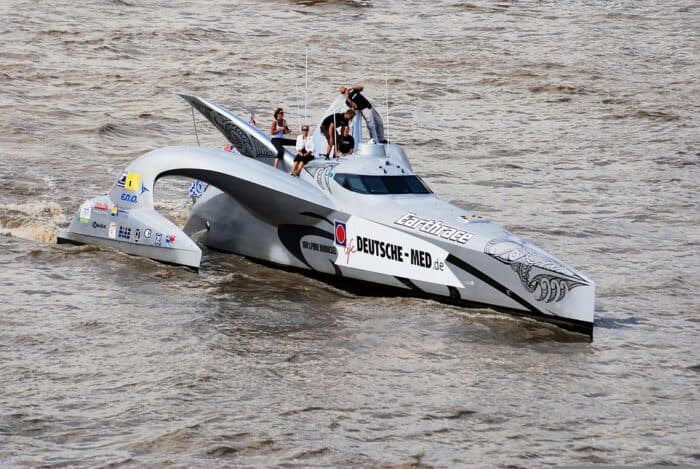
Similar to a catamaran, a trimaran has one central hull and then two smaller outriggers. While a catamaran may be more oriented to being a pleasure vessel, a trimaran is better equipped for speed. The outriggers ensure great stability even at speed and are adept at staying afloat even on very rough seas.

Tugboats are most often found in harbors or ports where they are used to help larger vessels maneuver in tight spaces. They are also deployed to tow damaged or incapacitated vessels. They can either pull another vessel with a tow line or pull it. Given the nature of their jobs, tugboats are surprisingly powerful despite their small size.
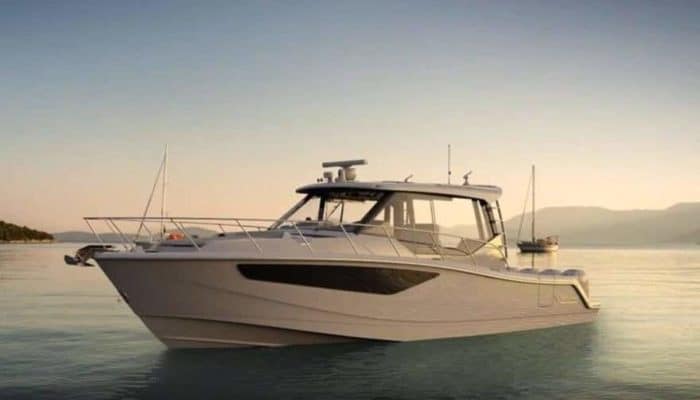
There is not actually a specific boat that qualifies as a yacht in the way a canoe must clearly be a canoe or a pontoon boat is clearly a pontoon boat. A yacht can be sail powered or engine powered, used for racing, fishing or cruising, and can be a variety of lengths. In general, however, a yacht has a cabin to allow for extended and overnight stays and will usually be at least 33 feet in length. Most people associate a yacht with at least some measure of luxury.
The Bottom Line
There are hundreds and hundreds of different kinds of boats and ships, including various subsets of boats such as is the case with things like sailboats, fishing boats and yachts. Other boats may be known by several different names interchangeably, like how canoe can refer to both a canoe or a kayak in the UK. If you’re ever unsure about what kind of boat someone is referring to, it never hurts to ask or check with your old friend Google.
My grandfather first took me fishing when I was too young to actually hold up a rod on my own. As an avid camper, hiker, and nature enthusiast I'm always looking for a new adventure.
Categories : Boats
Leave a Reply Cancel reply
Your email address will not be published. Required fields are marked *
Save my name, email, and website in this browser for the next time I comment.
More in Boats

What Is A Gunwale?

131 of the Best Hawaiian Boat Names

167 Patriotic Boat Names

The 138 Best Boat Names for Dog Lovers

The People’s Poncho Review and Ratings

Oru Lake Kayak Review

About Boatsafe
Established in 1998, BoatSafe is your independent guide into the world of boating, fishing, and watersports. We provide expert insights and detailed guides to help you find products tailored to your needs and budget.
Contact Boatsafe
- Address: 4021 West Walnut Street. Rogers, AR 72756
- Phone: (479)339-4795
- Email: [email protected]
Site Navigation
- How We Test
- Corrections Policy
- Privacy Policy
- Terms & Conditions
- Editorial Policy
- Affiliate Disclosure
Our Reviews

All content is © Copyright 2024. All rights reserved.
- Types of boats - Choosing the right one!
- Free Boating License Study Guide
With a wide array of boat options available, selecting the perfect vessel for your needs can be quite a challenging task. Deciding which one suits you best requires careful consideration. Explore the wide variety of boats listed below and discover the ideal one that fits your needs.
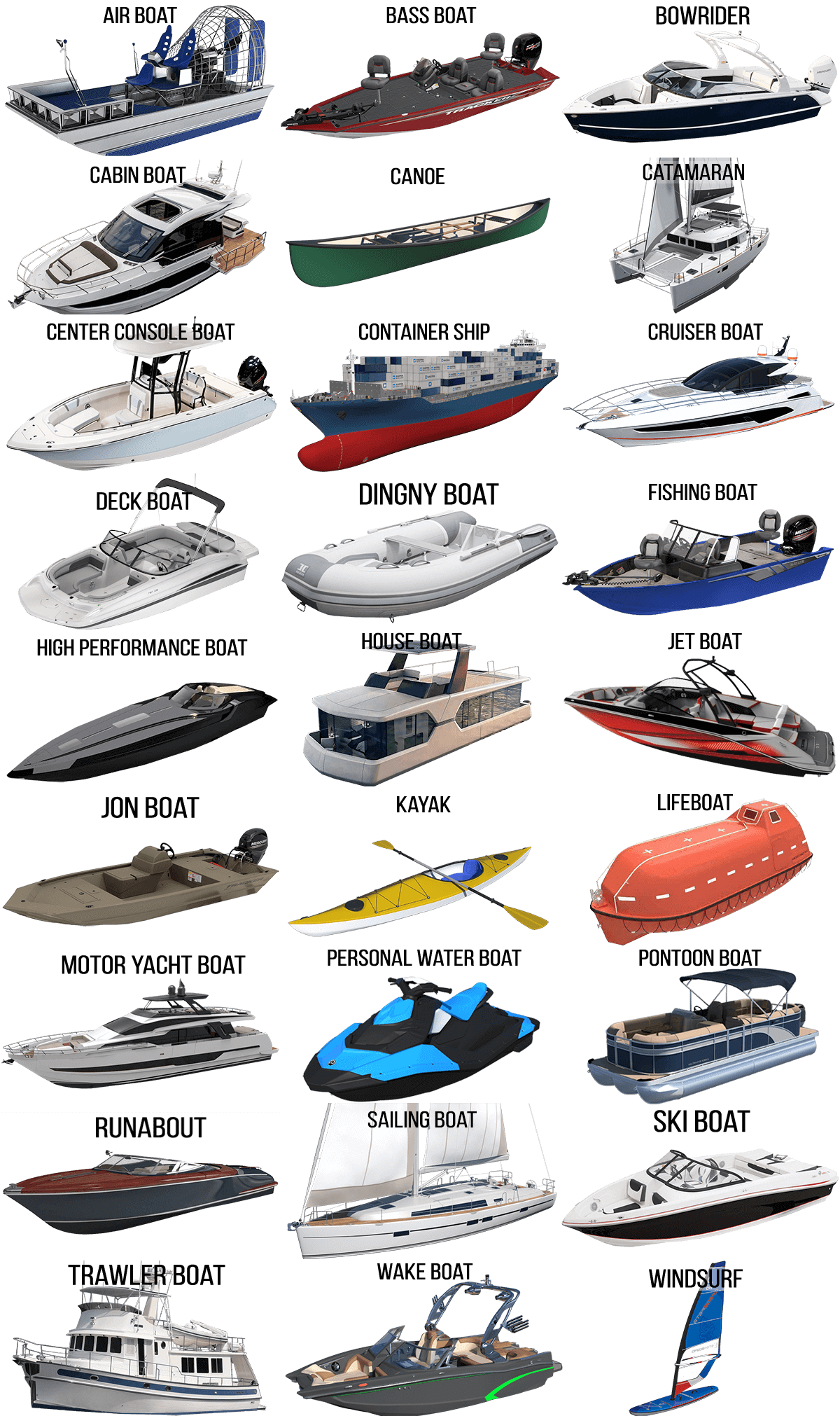
Which boat is right for you?
Fishing boats.
They are boats used to catch fish. The immediate qualities include stability, strength, and durability to survive the fishing ventures across various kinds of waterways.
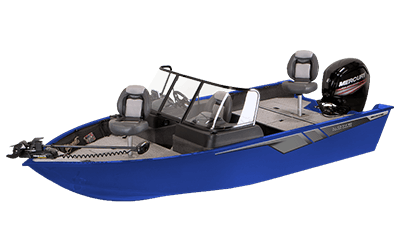
The bass boats are designed with slim profiles, and consist of 2-3 anglers on board, and are used for fishing. With plenty of horsepower, bass boats are the ultimate tool for the serious freshwater angler.

Bowrider boats
The bow area of these type of boats has been constructed in a unique way to allow a spacious seating arrangement. Moreover, these runabout-style vessels contain a swim platform for putting on wake-boards, or for swimming activities.
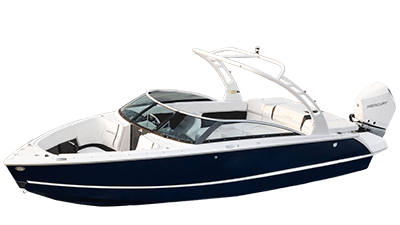
Cabin boats
This type of boat is well-suited for fishing, yachting, sailing and other water sports. Also, the presence of a closed deck over the boat’s bow allows a convenient storage space and easy navigation.
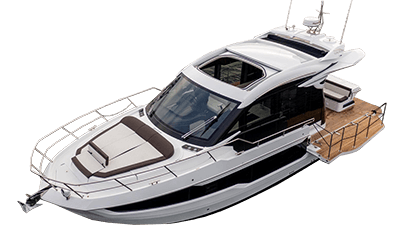
Center console boats
The Center Consoles are ideal for sports fishing and work in harsh offshore waterways where there is plenty of ocean fish.
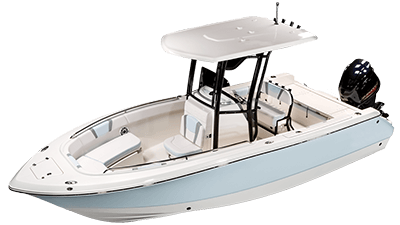
Dinghy boats
A dinghy is a small inflatable boat usually made of rubber and comprises of cross thwarts and rowlocks that act as seats and oars, respectively.
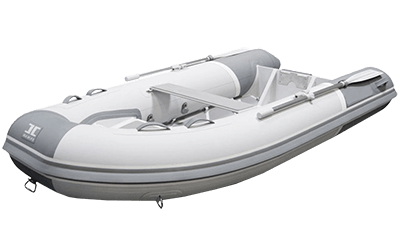
These boats offer the luxury of living on water and provide excellent recreational and holiday accommodation facilities. Houseboats incorporate broad flooring and modern amenities such as entertainment, fine dining, and proper sleeping arrangements.
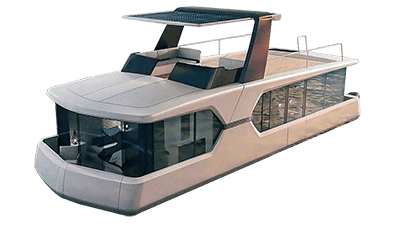
Trawler boats
The main advantage of trawlers is that the presence of a displacement hull allows them to smoothly maneuver through the water without exhausting much horsepower or consuming excessive fuel.
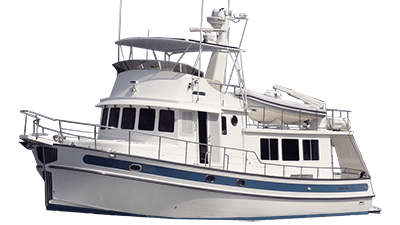
Cruiser boats
These boats are apt for relaxed sailing and include a galley and a berth. All modern comforts like heaters, air conditioners, and power generators are enclosed in the arrangement.
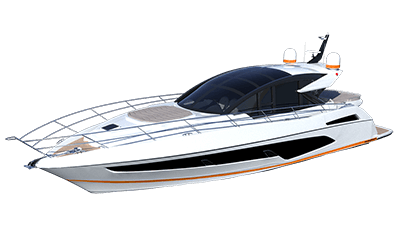
High performance boats
These long, sleek craft boats incredible power, often running a pair of high-horsepower sterndrives, inboards, or multiple outboard engines to propel them swiftly through the water. The classic high-performance boat features a long, enclosed front, or “bow”, with a relatively small main seating area.
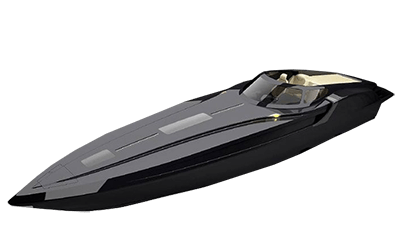
Motor yacht boats
The motor yacht has a standard length of 12m and above, with one or two diesel engines as per navigation requirement in the bigger river systems or the oceans.

Personal watercraft
Characterized by craft more similar to a snowmobile, featuring a saddle and handlebars and capable of hauling one-to-three passengers.

Runabout boats
The movement of these open boats is controlled by a steering wheel and forward controls, as located behind a windscreen. Cabin space is not required. Runabouts are usually declared entry-level vessels for casual sports and boating activities.
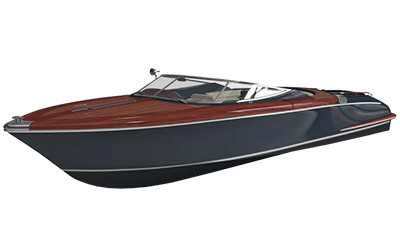
The structure of a jet boat is quite similar to that of a bow-rider, as it offers a lot of seating area along with a swimming platform. The advanced propulsion system is securely enwrapped in the hull, to protect it from any external damage. The jet boats are really fast, yet easy to manage.
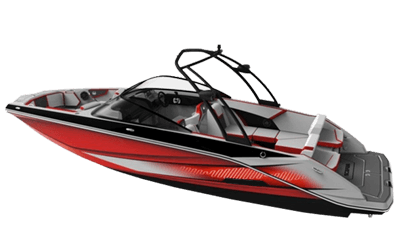
Ski boats also usually position the engine in the center of the boat. This combined with the shallow deadrise allow the boat to run at a level attitude. The result is strong acceleration and minimal wake size
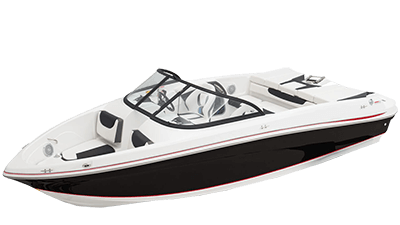
The inboard ski boats require a powerful range of acceleration and the shape of the engine and propeller accentuates it. Contrarily, the inboard wake boards need a V drive engine system, deep hulls, and a huge wake to set in motion. The boat’s running attitude is further altered with extra weight, also called “ballast”, or specially crafted tabs or hydrofoils, pumping those wakes up as large as possible and shaping them to create the perfect launch ramp for wakeboarders.
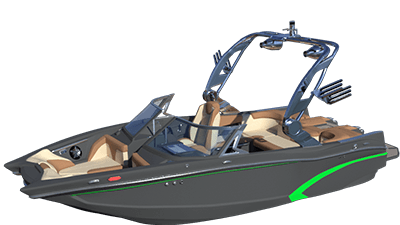
Pontoon boat
Used popularly for inland waters (lakes) and small water bodies, Pontoon boats length range from 15-30 ft with a shallow draft. It consists of multiple aluminum tubes supporting the broad platform providing excellent stability. They are used for recreational activities like cruising, fishing etc.
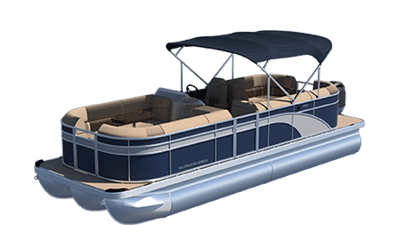
The names come from the open deck area it provides with plenty of seating arrangements for a group of people. It consists of a V shape hull with a wide beam to accommodate more passengers than a pontoon boat. Usually 25-35 ft in length, they are provided with a stern power drive, and popularly used for recreational activities like swimming, water sports etc.
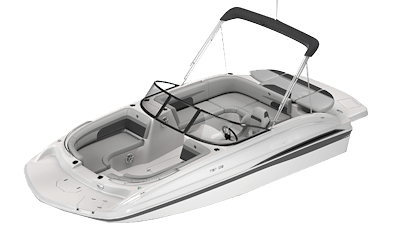
The Jon boat is another entry level boat, and a perfect choice for a novice boater as some of these boats are provided with steering console to get the feel of a mid-segment boat. They are used in shallow waters.
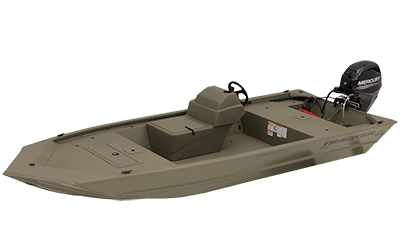
Airboats are boats that glides effortlessly across the surface, propelled by an airplane-style propeller.
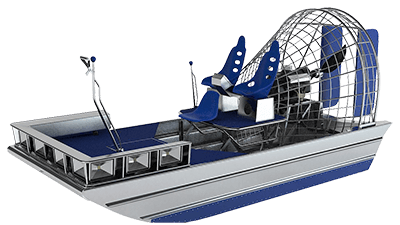
Container ships
Container ships are vessels that transports its entire cargo in large intermodal containers, ranging from 20 feet to 40 feet in length each.
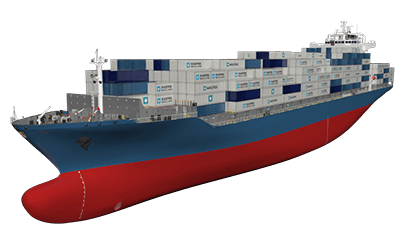
Sailing boats
Is a boat propelled partly or entirely by sails.

Catamaran
Catamarans have two parallel hulls of equal size. Catamarans typically have less hull volume, smaller displacement , and shallower draft than monohulls.

Windsurfing, a thrilling form of sailing, involves standing on a board while gripping a sail that is attached to the board.

Unpowered or man-powered boats
A narrow boat that is propelled with a double-ended paddle.
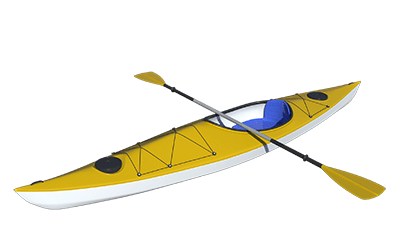
Long and narrow, a canoe is a watercraft with pointed ends and curved sides, designed to be propelled by someone using a paddle.

In emergency situations, lifeboats come to the rescue! These are mainly attached to bigger vessels like cruises and their main function is to carry passengers to a secure area if the concerned vessel is met with an accident.

What you need to know before buying a boat?
When choosing the right boat, you’ll need to consider what you’re going to use it for, how much time you’ll spend on the water, and how many people will be on the boat.
Just as you would not expect a small runabout to be able to cross the Atlantic, a large motor yacht would not be suitable to pull water skiers. Boats come in many sizes and configurations and each is designed with a particular use in mind. All boats that are propelled by propulsion machinery are considered motor boats.
A PWC such as a jet ski, is considered a motor boat and is subject to the same rules and regulations as any boat of its size and horsepower. In many states, additional regulations are in effect regarding personal watercraft.
Once you have decided what type of boat you want to buy, don't forget to take your online course to get the boating license if needed. Check the requirements in you State or Province to see if you need one to operate your boat.
What are the classification of boats by length?
According to federal and state regulations, it is essential to have specific safety equipment on your boat, which varies depending on its class.In order to identify the necessary safety equipment for your boat, it is absolutely vital to be aware of your boat's classification. Boat classes are primarily determined by the length of the vessel. So, let's take a closer look at the four distinct classes of recreational boats based on their length.
Class A: less than 16 feet.
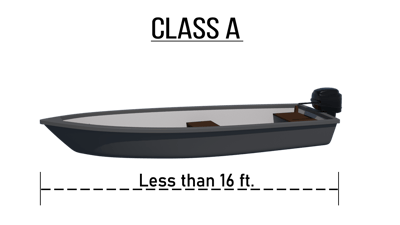
Class 1: 16 to less than 26 feet.

Class 2: 26 feet to less than 40 feet.

Class 3: 40 feet to less than 65 feet.

Now that you have an idea of the the different types of boats available, come discover with us all the other aspects of boating with our online boating safety course and obtain your boating license.
- Follow Ace Boater on YouTube
- Join Ace Boater on Facebook
- Contacts Us
Boating safety course and boating exam accredited in USA
The 5 tragic minutes that sank a superyacht
PORTICELLO, Italy — Survivors of a storm that sank a superyacht off Sicily recounted their ordeal to one of the doctors who rushed to their aid, with some saying it took mere minutes for the 180-foot ship to go down.
Dr. Fabio Genco, head of the Palermo Emergency Medical Services, told NBC News on the phone Thursday that he arrived in the seaside village of Porticello before dawn Monday, about an hour after the $40 million Bayesian sank in the violent and sudden storm.
Of the 22 people onboard, 15 survived despite storm conditions and darkness, climbing onto a lifeboat before being rescued by a nearby sailboat. The crew members have made no public statements so far, though some have been interviewed by investigators.
“They told me that it was all dark, that the yacht hoisted itself up and then went down,” Genco said, recounting what the survivors told him. “All the objects were falling on them. That’s why I immediately made sure, by asking them questions, if they had any internal injuries,” he said.
It appears they had just minutes to abandon the sinking ship, Genco said.
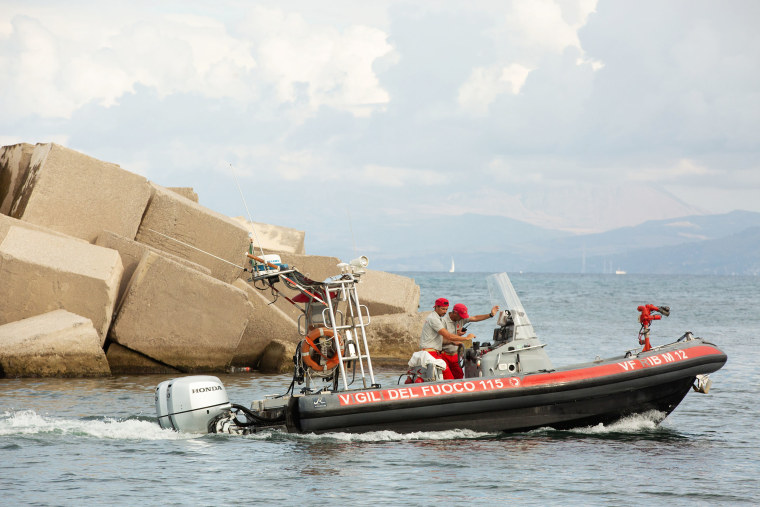
“They told me that suddenly they found themselves catapulted into the water without even understanding how they had got there,” he said, “And that the whole thing seems to have lasted from 3 to 5 minutes.”
Giovanni Costantino, CEO of The Italian Sea Group, which owns Perini Navi, the Bayesian's shipbuilder, told Sky News that there were no flaws with the design or construction of the yacht. He said their structure and keel made boats like that “unsinkable bodies.”
In an interview with the Italian newspaper Corriere della Sera, he disavowed responsibility, blaming instead the actions of the crew. “Mistakes were made,” he said.
Genco said one of his colleagues who arrived at the scene before him initially thought that only three people survived, but the coast guard reported there were other survivors and more emergency services were called in.
When Genco arrived, he found scenes of panic and despair.
“Unfortunately, we are used to such panic scenes because we are used to the shipwrecks that happen on Lampedusa ,” Genco said, referring to the island southwest of Sicily, where the wreckage of boats carrying migrants on the sea journey from North Africa to Italy are often found .
Six of the passengers were declared missing Monday, and by Thursday, the bodies of five had been recovered from the wreck , some 160 feet underwater.
Among those who survived is Angela Bacares, wife of the British tech mogul Mike Lynch , whose body was recovered Thursday.
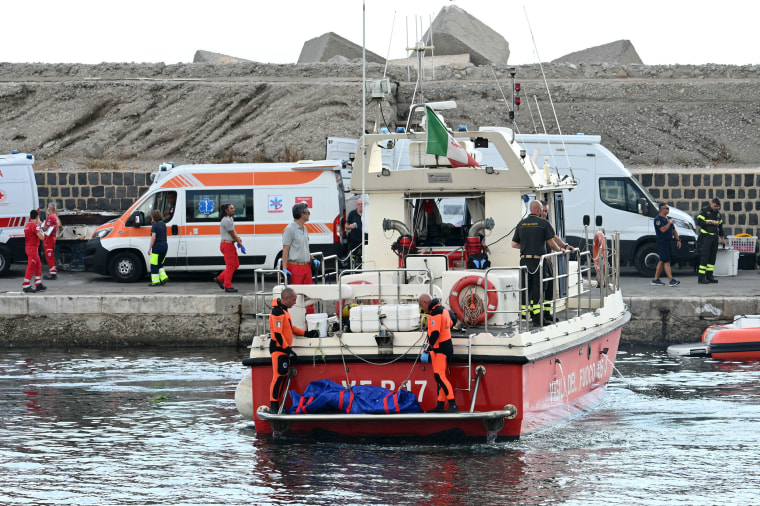
Another survivor has been identified as Charlotte Emsley, 35. She told the Italian news agency ANSA that she had momentarily lost hold of her year-old daughter, Sofia, in the water but managed to retrieve her and hold her over the waves until a lifeboat inflated and they were pulled into safety.
Dr. Domenico Cipolla at the Di Cristina Children’s Hospital in Palermo is also part of a team of medical professionals treating the shipwreck survivors. He told the BBC on Wednesday that Emsley and her daughter, as well as the father of the child, who Cipolla said also survived, are continuing to receive psychological help.
“Psychological support was constant and is constant even today, because basically it is the wounds of the soul that are the most in need of healing in these cases,” Cipolla said.
Genco also told NBC News that he was especially concerned about the child. “She did not understand anything. She was soaking wet and cold,” he said.
Karsten Borner, the Dutch captain of the Sir Robert Baden Powell, a yacht that was anchored near the Bayesian, said by phone Wednesday that he saw a thunderstorm come in at around 4 a.m. local time (10 p.m. ET) Monday, followed by what looked like a waterspout, a type of tornado that forms over water.
The International Centre for Waterspout Research noted on X that there was a “waterspout outbreak” off Italy on Monday, the day the Bayesian sank.
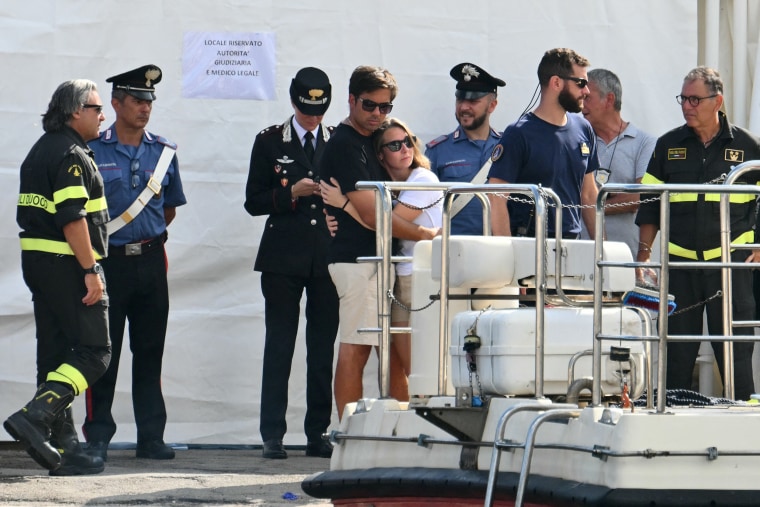
“I turned on the engine and made maneuvers so that we wouldn’t collide with the Bayesian, which was anchored about 100 meters from us,” Borner said. “Then all of a sudden it disappeared. Then the wind calmed down, we looked around and saw a red flare.”
Borner said he got into his boat’s tender and saw a life raft with 15 people on it. Members of the crew were administering first aid.
“I don’t know why it sank so quickly, but it may have something to do with the mast which was incredibly long,” he said. Questions have been raised about whether the mast was to blame for the accident as tall masts, even with the sails down, have more surface area exposed to the wind, which can contribute to tipping a vessel in a storm.
The CCTV footage that emerged Tuesday showed the yacht’s 250-foot mast, believed to be one of the tallest aluminum sailing masts in the world, lashed by the storm as it appears to tilt to one side before disappearing.
Claudia Rizzo is an Italy based journalist.
Claudio Lavanga is Rome-based foreign correspondent for NBC News.
Yuliya Talmazan is a reporter for NBC News Digital, based in London.
- Search Please fill out this field.
- Manage Your Subscription
- Give a Gift Subscription
- Newsletters
- Sweepstakes
:max_bytes(150000):strip_icc():format(webp)/Abby-Weiss-Paralyzed-Acroyoga-082724-4-0f792d03de694e43bd2b776ec5530f2c.jpg)
- Human Interest
- Real People
- Real People Tragedy
Everything We Know About the Final Moments of the Passengers Who Died in the Sicily Yacht Tragedy
Five of the seven victims had been "searching for air pockets" as the luxury yacht sank on Aug. 19, authorities said
:max_bytes(150000):strip_icc():format(webp)/baileyrichards-1d9c7834c65840fd9facfbf64f9a43e5.jpg)
PERINI NAVI PRESS OFFICE/HANDOUT/EPA-EFE/Shutterstock
The luxury yacht Bayesian that sank off the coast of Sicily on Monday, Aug. 19, resulted in the deaths of six passengers and one crew member.
Less than a week later, on Saturday, Aug. 24, Ambrogio Cartosio, the Chief Prosecutor of Termini Imerese, announced that Italian authorities were launching a manslaughter investigation into the sinking , and he identified all of the victims.
The seven victims who died in the tragic sinking were yacht chef Recaldo Thomas; British tech entrepreneur Mike Lynch and his daughter, Hannah Lynch; Christopher Morvillo and his wife, Neda ; and Morgan Stanley International chairman Jonathan Bloomer and his wife, Judy .
As authorities attempt to answer questions about what exactly led to the sinking of the 183-foot British-flagged vessel — which went down during a "violent storm,” the Italian Coast Guard previously told PEOPLE in a statement — here is what we currently know about the victims’ final moments.
FAMILY HANDOUT/EPA-EFE/Shutterstock
During the Aug. 24 press conference, Girolamo Bentivoglio Fiandra, head of the Palermo Fire Brigade, revealed that as the Bayesian began going down early Monday morning, “It was quite clear that people were trying to hide in the cabins.”
“In the left-hand side, we found the first 5 bodies in the left-hand side cabins, and the final body on the right-hand side,” Fiandra said. “We found them on the highest part of the ship, which was closer to the surface. The vessel had three cabins on each side.”
The five victims, who "took refuge” on the luxury yacht’s left side, had been "searching for air pockets" in a final attempt at survival," he added.
HANDOUT/Vigili del Fuoco/AFP via Getty
As for why the victims were in the cabins in the first place, Giovanni Costantino — who leads The Italian Sea Group, the company that now owns Perini Navi, which built the Bayesian back in 2008 — told CNN it was due to a “very long sum of errors."
"Everything that has been done reveals a very long sum of errors,” he said in his interview, translated from Italian. “The people should not have been in the cabins, the boat should not have been at anchor. And then why didn't the crew know about the incoming disturbance?”
Never miss a story — sign up for PEOPLE's free daily newsletter to stay up-to-date on the best of what PEOPLE has to offer, from celebrity news to compelling human interest stories.
Prior to the storm and subsequent sinking, some of the luxury yacht’s passengers were in celebration mode. They had been commemorating the recent acquittal of one of the victims, Lynch, 59, a source close to the survivors previously told PEOPLE.
Two months ago, Lynch was acquitted on all counts of a series of fraud and conspiracy charges he faced in the U.S. after a years-long legal battle dating back to 2018.
Patrick McMullan/Patrick McMullan via Getty
He celebrated the acquittal on the Bayesian with his daughter and his wife, Angela Bacare, who was rescued along with 14 others on board.
Also celebrating were Morvillo, 59, who represented Lynch in the case, and Bloomer, 70, who was a close friend of the tech entrepreneur.
Related Articles
Superyacht sinks latest: Investigators reveal where bodies were found as probe looks at 'crew's responsibility'
Italian officials revealed at a news conference there could be "a question of manslaughter" as they opened a shipwreck investigation and said the probe is also looking at the "crew's responsibility".
Saturday 24 August 2024 18:33, UK
- Superyacht sinking
Please use Chrome browser for a more accessible video player
- Prosecutor: There 'could be a question of manslaughter'
- Probe 'concentrating' on crew's responsibility
- Seven bodies recovered after five-day search of superyacht wreckage off Sicily
- Saturday's papers pay tribute to youngest victim Hannah Lynch
- Hannah's sister pays tribute to 'my little angel'
- Explained: Inside the superyacht | What challenges have faced divers?
- Eyewitness: Sombre scenes greet rescue teams as final body is brought ashore
- Live reporting by Niamh Lynch
We're ending our live coverage for this evening but here is a recap of what we know:
- Prosecutors have opened a manslaughter investigation into the Bayesian sinking;
- Officials have revealed more details on their investigation and the difficult five-day rescue mission;
- The six bodies found during the search in recent days were all in cabins on the left-hand - and highest - side of the ship. Five were found in the first cabin and the sixth was found in the third;
- Prosecutors said the six passengers were most likely asleep when the boat sank;
- The probe is now focusing on the crew and their responsibilities, with the captain set to undergo more questioning.
Monday 19 August
The Bayesian yacht, flying a British flag, sinks at around 5am local time when the area was hit by a tornado.
Fifteen people are rescued from the 56 metre vessel - including a mother and baby - but another seven remain missing.
One body, later confirmed to be the yacht's chef Recaldo Thomas, is found near the wreck.
It emerges that British technology tycoon Mike Lynch and his 18-year-old daughter Hannah are among six people that remain missing.
Tuesday 20 August
The search continues for the six tourists missing.
It is reported that among those missing are Morgan Stanley International chairman Jonathan Bloomer; his wife, Judy Bloomer; Clifford Chance lawyer Chris Morvillo; and his wife, Neda Morvillo.
Police divers try to reach the hull of the ship, resting at a depth of 50 metres.
Italy's fire brigade Vigili del Fuoco say early inspections of the wreck were "unsuccessful" because of limited access to the bridge and furniture obstructing passages.
The operation is later described as "complex", with divers limited to 12-minute underwater shifts.
Tributes pour in for Mr Thomas, with his friend Gareth Williams saying: "I can talk for everyone that knew him when I say he was a well-loved, kind human being with a calm spirit."
Wednesday 21 August
The search for the six people unaccounted for enters a third day, with crews carrying out inspections of the yacht's internal hull.
A team of four British inspectors from the Marine Accident Investigation Branch (MAIB) arrive in Porticello to look at the site of the sinking.
A helicopter is drafted in to help with the search effort and remotely controlled underwater vehicles are being used, with naval units and cave divers also taking part in the search.
Five bodies are found inside the yacht on Wednesday afternoon. Only four of them are brought to shore.
Body bags are seen being taken to Porticello in the afternoon where dozens of emergency services staff wait.
Searches finish for the day just before 7.30pm.
Thursday 22 August
The search resumes for the remaining missing person.
The body of the fifth missing person, found but not recovered the previous day, is brought to shore.
A fire service boat with flashing blue lights returns with a blue body bag to the port of Porticello just after 8.45am local time on Thursday.
Tributes pour in for Mr Lynch and Mr and Mrs Bloomer after they are identified as having died.
The search is called off at around 8pm in Sicily, with divers expected to begin again at 6.30am on Friday.
Friday 23 August
The search continues for the final person missing from the wreck of the Bayesian, Hannah Lynch.
Vincenzo Zagarola, of the Italian Coastguard, says the search for Hannah has not been "easy or quick", comparing the sunken yacht to an "18-storey building full of water".
The coastguard confirms in the late morning that her body has been found.
A green body bag is brought to the port of Porticello from the site of the sinking.
A spokesperson announces on behalf of the Lynch family that they are "devastated" and "in shock" after the deaths of Mike and Hannah.
Hannah's sister Esme pays tribute to her "little angel".
Saturday 24 August
A press conference is held in the court of an Italian town, Termini Imerese.
Public prosecutor Ambrogio Cartosio tells reporters that his office has opened an initial investigation against unknown persons into manslaughter and negligent shipwreck.
As the focus now turns to the manslaughter investigation, here's another reminder of the seven victims of the sinking and the 15 people who survived.
A close friend of the Lynch family has added to the chorus of tributes for British tech tycoon Mike Lynch, who died in Monday's superyacht sinking.
Susannah Gurdun, who lives in Suffolk, recalled being "daunted" when she first met Mr Lynch at a dinner party, before discovering he was "so much more than the corporate cliche".
"He was riveting. He was funny, and kind, and endlessly interesting; capable of talking about anything and everything," she said.
Ms Gardun said the businessman also had a "thrilling ability" to make complicated subjects "accessible to those of us less blessed with a science acumen".
"In particular, he was wonderful with children. I will never forget hearing him explain to a group of them - including our ten year old son - the physics of why the sky went pink at sunset," she said.
She went on describe Mr Lynch as a "true genius" and "phenomenal creative".
Ms Gardun said his daughter Hannah was also showing "serious literary promise", and added that it was "beyond tragic that we will never know where her own particular brilliance might have led".
"I still feel blessed to have shared that time with them in Spain. Not just because I witnessed Mike’s incredible storytelling; but because I was given a chance of understanding what that moment said about all four of them as a united vibrant loving family," she said.
"He was an extraordinary human being and it was - truly - a privilege to have known him."
A yacht crew member who survived the sinking has paid tribute to Hannah Lynch, calling her a "diamond in a sea of stars".
Sasha Murray, chief stewardess of the Bayesian, has released a statement after divers recovered the final missing body from the wreckage, which is believed to be 18-year-old Hannah.
"Those who knew her will know that Hannah was a diamond in a sea of stars," she said.
"Bright, beautiful and always shining. What most people may not have seen was the extraordinarily strong, deep and loving relationship she shared with her parents, whom she adored more than anything.
"While swimming with them she often said, if anything ever happened she would save them.
"I have no doubt that the Irish, Latina fire that burns in her soul kept that spirited determination alive."
Ms Murray's statement comes as a new image of Hannah Lynch and her father Mike Lynch is released:
Prosecutors announced in this morning's news conference that they have opened a manslaughter and negligent shipwreck investigation.
Officials were unable to answer several queries from the media, saying they needed time to establish the facts, but what are the key questions facing prosecutors?
Why weren't passengers who remained on board the vessel warned about escaping from the yacht?
The prosecutor in charge of the case, Raffaele Cammarano, suggested that some passengers may have been asleep when others were awake.
Asked why they were not woken up or alerted, he said that is something investigators are trying to work out from the statements of the survivors.
He called it an "essential" part of the inquiry.
Why were several of the passengers in one cabin?
The press conference heard several bodies onboard the sunken yacht were found in a single cabin which was not theirs.
Mr Cammarano said investigators currently do not know the reason for them being discovered in the same cabin.
The chief of the Palermo fire service, Bentivoglio Fiandra, said the yacht pinned to the right and suggested people tried to go on the other side, taking refuge in cabins in the higher part of the wreck.
Why did the boat sink?
The vessel had been deemed "unsinkable" by its manufacturer - Italian shipyard Perini Navi.
The Bayesian was hit by a downburst, according to Mr Cammarano, which are powerful winds that descend from a thunderstorm and spread out quickly once they hit the ground.
Officials will look into the safety equipment on the sunken vessel.
Mr Cammarano was asked about whether there is a black box and if the hatches were left open.
He said investigators do not have exact information about the black box and that the first phase of the inquiry will look into it.
Why were nearby vessels not similarly affected?
Another yacht, the Sir Robert BP, was about 150 to 200 metres from the Bayesian when extreme weather hit.
Its crew helped to rescue 15 people from the stricken vessel.
Italian officials said they would be looking at how the downburst could affect one vehicle and not other nearby vessels.
What weather warnings was the Bayesian alerted to?
Maritime director of western Sicily, Rear Admiral Raffaele Macauda, said the weather at the time of the yacht's sinking was abnormal and there was nothing to suggest such an extreme situation would arise.
He said there were forecasts of winds and a storm alert, but there was no warning of a tornado.
"Given that the conditions were such, there wasn't anything to suggest there could be an extreme situation arising," he said.
"There are vessels that can monitor, after all, these events and one would have thought that the captain had taken precautions."
How long will it take to recover the sailing vessel?
Mr Macauda could not confirm how long it would take to retrieve the shipwreck of the sunken yacht.
"Everything depends on the availability of the owners and the timeframe of the retrieval of the wreck and of course all that has to be submitted to the port authorities and in parallel of course there will be the inquiry results and it's only really then that we will be able to authorise the operation," he said.
"I can't say, like some experts who have already spoken on the subject, [said] that it will be eight weeks."
He made clear that the owners will bear the full cost of retrieval, although he could not estimate the figure.
Italian authorities detailed the challenging and meticulous rescue operation to recover the six missing people from the Bayesian wreck (see 9.18am post).
But why was the five-day search so difficult?
Read more below...
More on this morning's press conference.
One of the main updates from prosecutors was that they have opened manslaughter and shipwreck investigations after the deaths of seven people in the Bayesian sinking.
Watch the announcement below...
Prosecutors have given a lengthy news conference this morning on their investigation into the sinking of the Bayesian.
Read the full report on the prosecutors' probe below...
Marine investigator James Wilkes has been speaking to Sky News after this morning's press conference.
"Naturally, there are more questions than there are substantive answers at the moment - that's the nature of investigative work.
"Something forced that yacht to roll beyond its nominal stability limits, such that it wasn't able to right itself with the ingress of a certain amount of seawater that was coming into the yacht.
"So the investigators are going to ask themselves one initial question - what must the conditions have been for this to happen?
"Then they are going to look at the contributing factors to the yacht, sinking, and, and the unfortunate loss of life."
Prosecutors said this morning that the future of the investigation is reliant on recovering the wreck.
Mr Wilkes said the yacht is a "major piece of physical evidence in and of itself."
"It's lying at 50 metres, which is a recoverable depth.
"If it was significantly deeper, then I'm not sure they'd be considering salvage at this stage or certainly, the salvage question would be a lot more complicated to answer.
"But if there was the ability to raise that yacht in one piece safely, then it gives the investigators physically more to look at."
Mr Wilkes said he was unsure if the yacht would have a "black box" - called a voyage data recorder in shipping.
"It would record things like GPS position, heading speed, engine telemetry, whether the radars were on, what they were recording, alarms, communications from the yacht itself, any audio on the bridge.
"But more often than not, these are on merchant ships. The yacht was a commercial yacht in the sense that it could be chartered out so it's quite possible it has a voyage data recorder on, but I'm not sure that it does. I don't know that as a matter of fact," he said.
Be the first to get Breaking News
Install the Sky News app for free

Advertisement
Supported by
Lynch Yacht Sinking Off Sicily Proves as Baffling as It Is Tragic
As bodies were recovered, the authorities and experts wondered how a $40 million, stable and secure vessel could have sunk so quickly.
- Share full article

By Emma Bubola and Michael J. de la Merced
Emma Bubola reported from Porticello, Italy, and Michael J. de la Merced from London.
Two months after being cleared in a bruising legal battle over fraud charges, the British tech mogul Mike Lynch celebrated his freedom with a cruise. He invited his family, friends and part of his legal team on board his luxury sailing yacht, a majestic 180-foot vessel named Bayesian after the mathematical theorem around which he had built his empire.
On Sunday night, after a tour of the Gulf of Naples, including Capri, and volcanic islands in the Eolian archipelago, the boat anchored half a mile off the Sicilian coast in Porticello, Italy. It chose a stretch of water favored by the Phoenicians thousands of years ago for its protection from the mistral wind and, in more recent times, by the yachts of tech billionaires. The boat was lit “like a Christmas tree,” local residents said, standing out against the full moon.
But about 4 a.m., calamity unfolded. A violent and fast storm hit the area with some of the strongest winds locals said they had ever felt. Fabio Cefalù, a fisherman, said he saw a flare pierce the darkness shortly after 4.
Minutes later, the yacht was underwater. Only dozens of cushions from the boat’s deck and a gigantic radar from its mast floated on the surface of the sea, fishermen said.
In all, 22 people were on board, 15 of whom were rescued. Six bodies — five passengers and the ship’s cook — had been recovered by Thursday afternoon, including that of Mr. Lynch, an Italian government official said, adding that the search was continuing for his daughter.
It was a tragic and mystifying turn of events for Mr. Lynch, 59, who had spent years seeking to clear his name and was finally inaugurating a new chapter in his life. Experts wondered how a $40 million yacht, so robust and stable could have been sunk by a storm near a port within minutes.
“It drives me insane,” said Giovanni Costantino, the chief executive of the Italian Sea Group, which in 2022 bought the company, Perini, that made the Bayesian. “Following all the proper procedures, that boat is unsinkable.”
The aura of misfortune only deepened when it emerged that Stephen Chamberlain, 52, a former vice president of finance for Mr. Lynch’s former company and a co-defendant in the fraud case, was killed two days earlier, when he was hit by a car while jogging near his house in England.
Since June, the two men had been in a jubilant mood. A jury in San Francisco had acquitted both on fraud charges that could have sent them to prison for two decades. There were hugs and tears, and they and their legal teams went for a celebratory dinner party at a restaurant in the city, said Gary S. Lincenberg, a lawyer for Mr. Chamberlain.
The sea excursion was meant as a thank-you by Mr. Lynch to those who had helped him in his legal travails. Among the guests was Christopher J. Morvillo, 59, a scion of a prominent New York family of lawyers who had represented Mr. Lynch for 12 years. He and his wife, Neda, 57, were among the missing.
So, too, was Jonathan Bloomer, 70, a veteran British insurance executive who chaired Morgan Stanley International and the insurer Hiscox.
The body of the ship’s cook, Recaldo Thomas, was recovered. All the other crew members survived. Among them was Leo Eppel, 19, of South Africa, who was on his first yacht voyage working as a deck steward, said a friend, who asked not to be identified.
Since the sinking, the recovery effort and investigation have turned the tiny port town of Porticello, a quiet enclave where older men sit bare-chested on balconies, into what feels like the set of a movie.
Helicopters have flown overhead. Ambulances have sped by with the sirens blaring. The Coast Guard has patrolled the waters off shore, within sight of a cordoned-off dock that had been turned into an emergency headquarters.
On Wednesday afternoon, a church bell tolled after the first body bag was loaded into an ambulance, a crowd watching in silence.
The survivors were sheltering in a sprawling resort near Porticello, with a view of the shipwreck spot, and had so far declined to comment.
Attilio Di Diodato, director of the Italian Air Force’s Center for Aerospace Meteorology and Climatology, said that the yacht had most likely been hit by a fierce “down burst” — when air generated within a thunderstorm descends rapidly — or by a waterspout , similar to a tornado over water.
He added that his agency had put out rough-sea warnings the previous evening, alerting sailors about storms and strong winds. Locals said the winds “felt like an earthquake.”
Mr. Costantino, the boat executive, said the yacht had been specifically designed for having a tall mast — the second-tallest aluminum mast in the world. He said the Bayesian was an extremely safe and secure boat that could list even to 75 degrees without capsizing.
But he said that if some of the hatches on the side and in the stern, or some of the deck doors, had been open, the boat could have taken on water and sunk. Standard procedure in such storms, he said, is to switch on the engine, lift the anchor and turn the boat into the wind, lowering the keel for extra stability, closing doors and gathering the guests in the main hall inside the deck.

12 guests occupied the yacht’s six cabins. There were also 10 crew members.
Open hatches, doors and cabin windows could have let in water during a storm, according to the manufacturer.

Open hatches, doors and
cabin windows could
have let in water
during a storm,
according to the
manufacturer.
Source: Superyacht Times, YachtCharterFleet, MarineTraffic
By Veronica Penney
The New York Times attempted to reach the captain, James Cutfield, who had survived, for comment through social media, his brother and the management company of the yacht (which did not hire the crew), but did not make contact.
So far none of the surviving crew members have made a public statement about what happened that night.
Fabio Genco, the director of Palermo’s emergency services, who treated some of the survivors, said that the victims had recounted feeling as if the boat was being lifted, then suddenly dropped, with objects from the cabins falling on them.
The Italian Coast Guard said it had deployed a remotely operated vehicle that can prowl underwater for up to seven hours at a depth of more than 980 feet and record videos and images that they hoped would help them reconstruct the dynamics of the sinking. Such devices were used during the search and rescue operations of the Titan vessel that is believed to have imploded last summer near the wreckage of the Titanic.
After rescuers broke inside the yacht, they struggled to navigate the ropes and many pieces of furniture cluttering the vessel, said Luca Cari, a spokesman for Italy’s national firefighter corps.
Finally, as of Thursday morning, they had managed to retrieve all but one of the missing bodies, and hopes of finding the missing person alive were thin. “Can a human being be underwater for two days?” Mr. Cari asked.
What was certain was that Mr. Lynch’s death was yet another cruel twist of fate for a man who had spent years seeking to clear his name.
He earned a fortune in technology and was nicknamed Britain’s Bill Gates. But for more than a decade, he had been treated as anything but a respected tech leader.
He was accused by Hewlett-Packard, the American technological pioneer that had bought his software company, Autonomy, for $11 billion, of misleading it about his company’s worth. (Hewlett-Packard wrote down the value of the transaction by about $8.8 billion, and critics called it one of the worst deals of all time .) He had been increasingly shunned by the British establishment that he sought to break into after growing up working-class outside London.
He was extradited to San Francisco to face criminal charges, and confined to house arrest and 24-hour surveillance on his dime. In a townhouse in the Pacific Heights neighborhood — with security people he jokingly told associates were his “roommates” — he spent his mornings talking with researchers whom he funded personally on new applications for artificial intelligence. Afterward, he devoted hours to discussing legal strategy with his team.
Despite his persistent claims of innocence, even those close to Mr. Lynch had believed his odds of victory were slim. Autonomy’s chief financial officer, Sushovan Hussain, was convicted in 2018 of similar fraud charges and spent five years in prison.
During Mr. Lynch’s house arrest, his brother and mother died. His wife, Angela Bacares, frequently flew over from England, and she became a constant presence in the San Francisco courtroom during the trial.
After he was finally acquitted, Mr. Lynch had his eye on the future. “I am looking forward to returning to the U.K. and getting back to what I love most: my family and innovating in my field,” he said.
Elisabetta Povoledo contributed reporting from Pallanza, Italy.
Emma Bubola is a Times reporter based in Rome. More about Emma Bubola
Michael J. de la Merced has covered global business and finance news for The Times since 2006. More about Michael J. de la Merced
Sail Names: Explained for Beginners (With 15 Examples)
In sailing, everything has it's own peculiar name, and the sail names are no exception. To clear things up, I'll explain the most common sail names in this article.
Sailing is exciting. Getting swamped with all the sailing terms less so. Especially since some of these terms date back to prehistoric times and are kept around for the sole purpose of elitism. So to help you navigate this world for which you often need a dictionary, here is one. These are sail names explained for beginners.
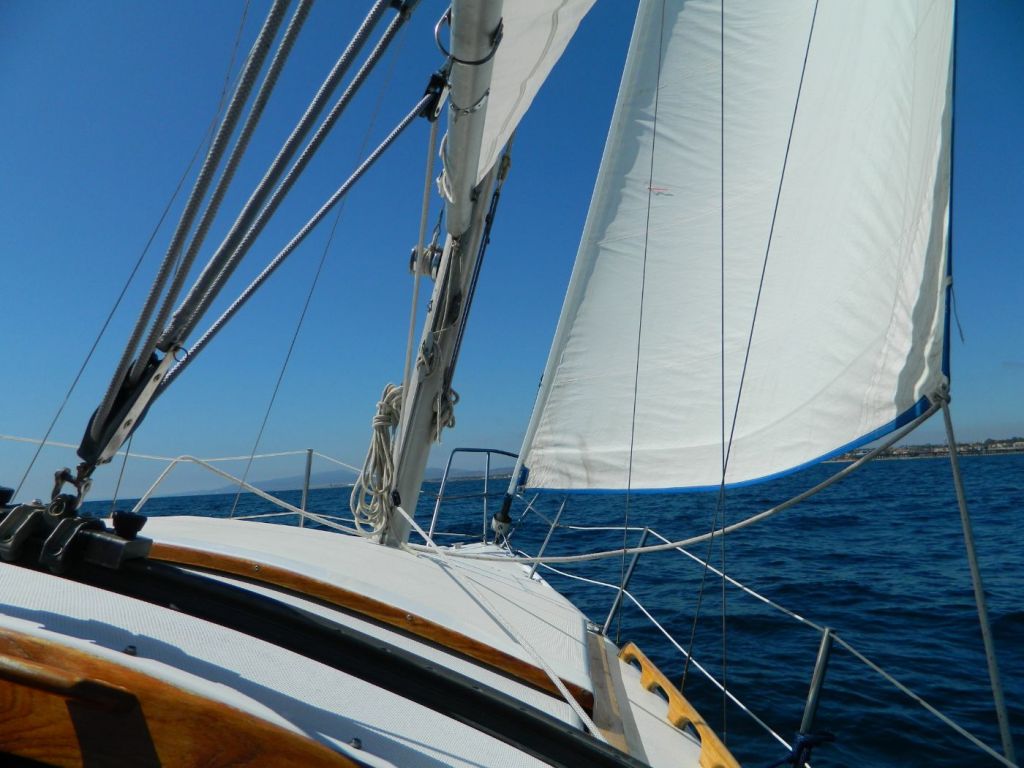
Here are the 15 most common sails:
What a bunch of odd names! Let's see what these mean.
We are starting with the more common types and will go all the way into names you can forget without feeling too guilty about it.
These days, only five or six types are used in the majority of sailboats, with the rest being nothing more than a nice-to-know party trick.
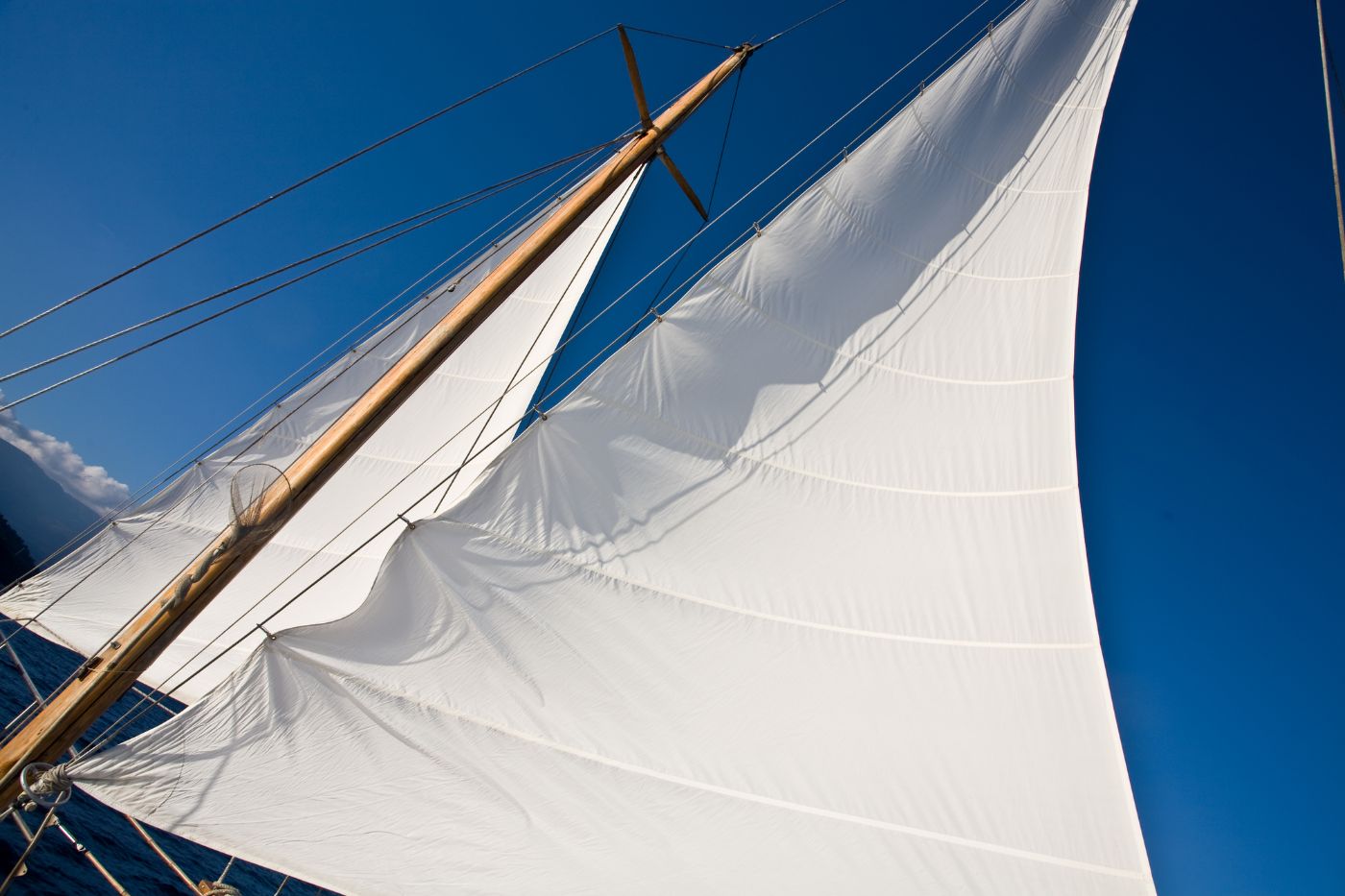
This one is easy. On the most common sailboat type, which has one mast, the mainsail is the one that goes from the mast to the back, attached to the boom on the bottom.
It is usually the largest one. When furled in, they are either stored in the mast, inside of the boom, or they sit right on top of the boom.
Their biggest advantage, and the reason why they are the most prevalent type all-around, is that, thanks to their design, they allow you to go anywhere, regardless of where the wind is coming from. Except for the ninety or so degree angle into the wind.
Just to make this complete, on older, classical ships with square sails and several masts (the ones you see in Pirates Of The Caribbean), mainsails are the bottom back ones. Nothing complicated here. Let's move on.
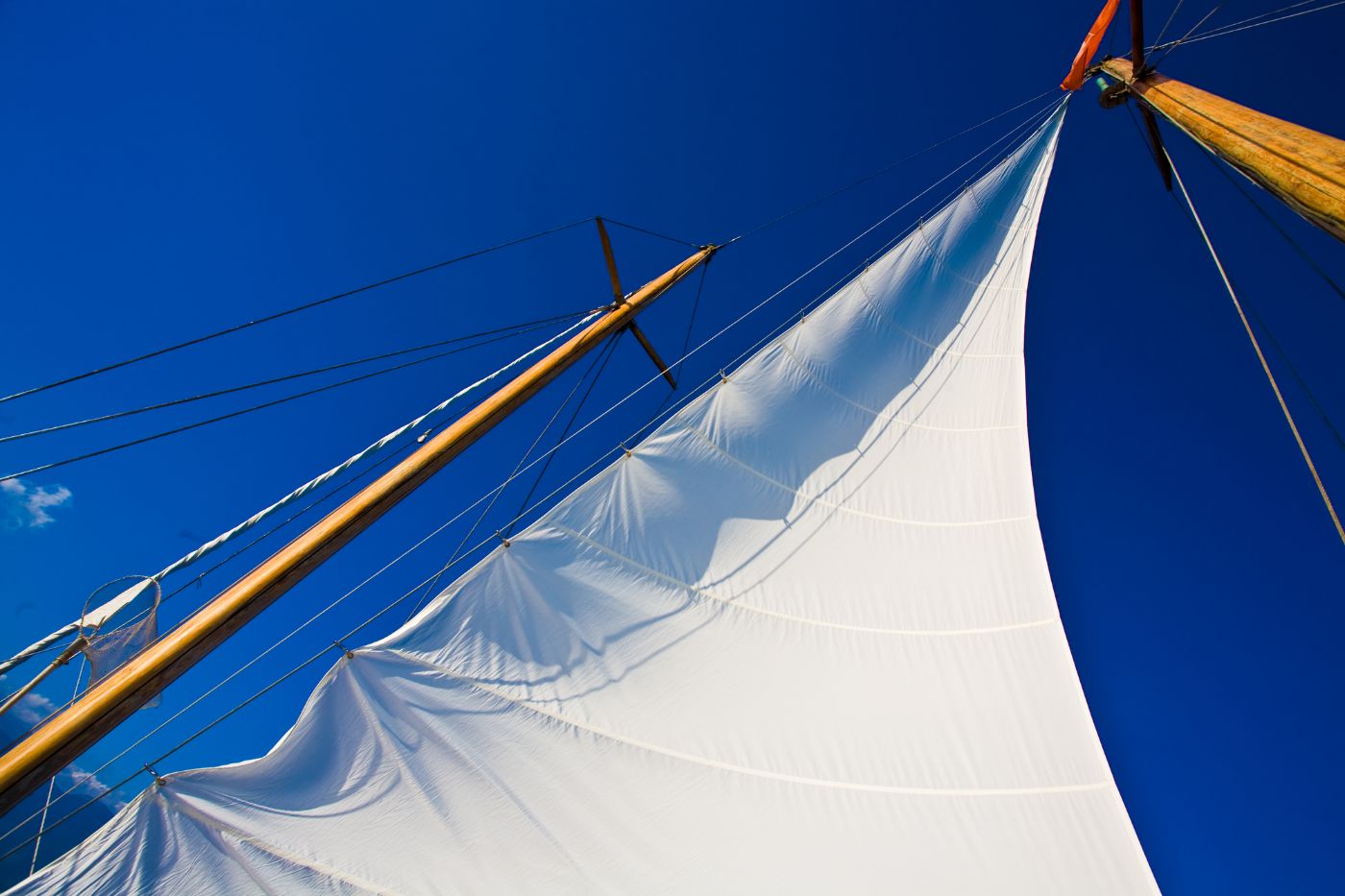
Again, you will see this one around a lot. On the most common sailboats, the term foresail refers to the front sail, which is attached to the boat's bow and mast.
It is usually rolled in the roller furling or attached to the forestay via little snaps called 'hank-ons.'
If you stumble upon the term 'headsail' or simply 'front sail,' know it is just a different name for the same thing. Oh, and on the aforementioned pirate kind of ships, the foresail would be the bottom front one, rectangle-shaped.
Foresails tend to be smaller than the mainsail, but the size isn't necessarily a disadvantage - if you find yourself too overpowered by the wind and you have already trimmed your mainsail, the foresail's smaller surface area can come in handy since the wind won't impact it as much.
You can even sail with just the foresail up. And if you aren't using hank-ons, but a roller furling, trimming it is quite effortless.
Foresails come in various shapes and sizes according to what type of a foresail it is - let's see what these are called.
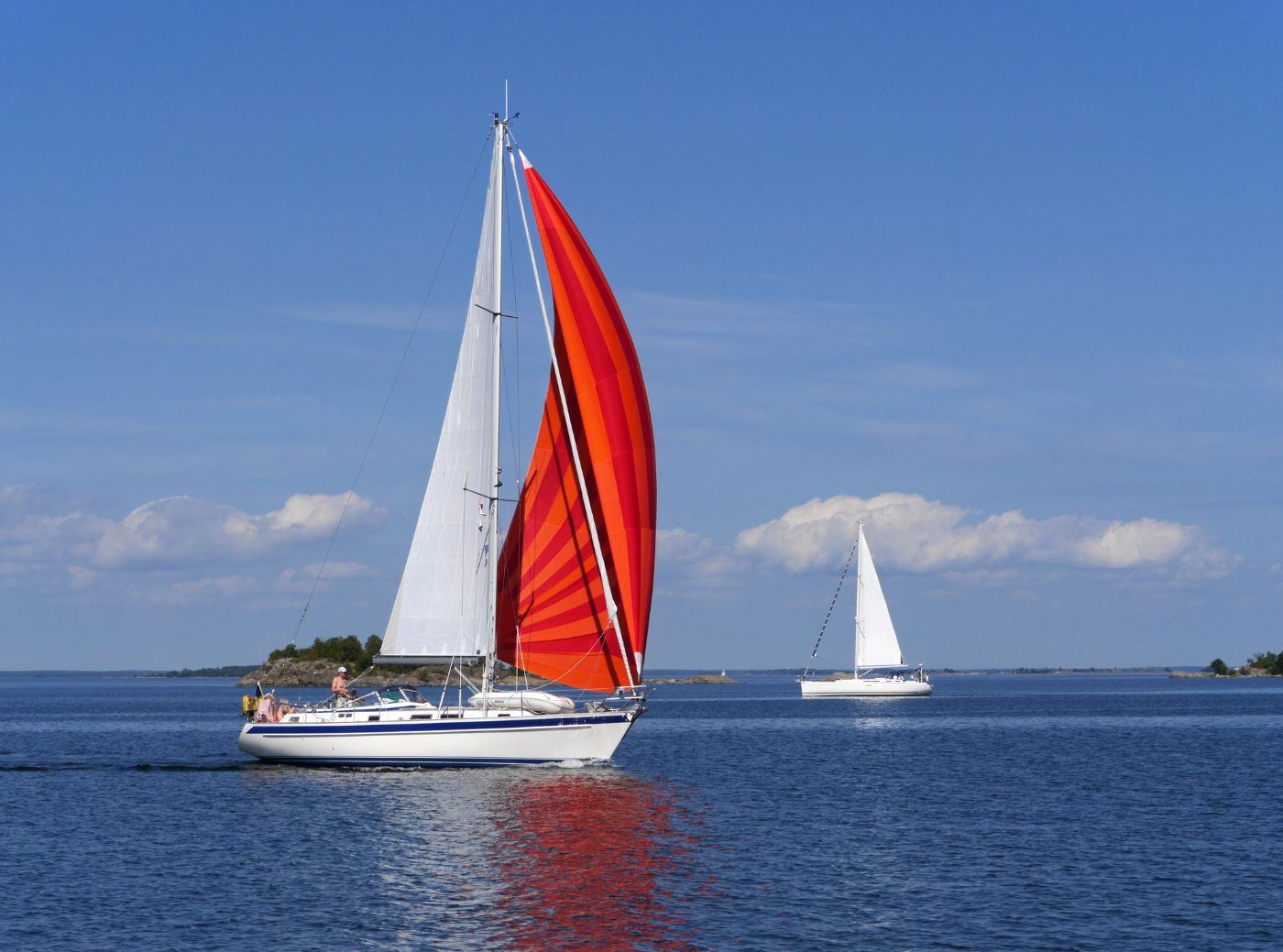
This is a foresail that extends beyond the mast. Meaning its bottom side starts all the way at the boat's bow and ends behind the mast. This gives it a larger sail area, resulting in more speed, that's why these are popular with racers.
But tacking with a genoa can be a bit annoying since you have to drag it across the mast. And it tends to get stuck in the most inconvenient of moments. Having to climb to the mast right as the boat starts to heel from one side to the other and the foresail is flapping around like hell isn't fun, I could tell you stories.
Now, how much the genoa extends behind the mast differs, from a common 110% type (meaning circa 10% of the genoa is behind the mast), which you would find on many cruisers, all the way to the 180% type. The latter is quite uncommon, though, because around 150%, the genoa starts to be in the mainsail's wind shadow.
An alternative name for a genoa is an 'overlapping jib', so if you stumble upon that word, know it refers to the same thing.
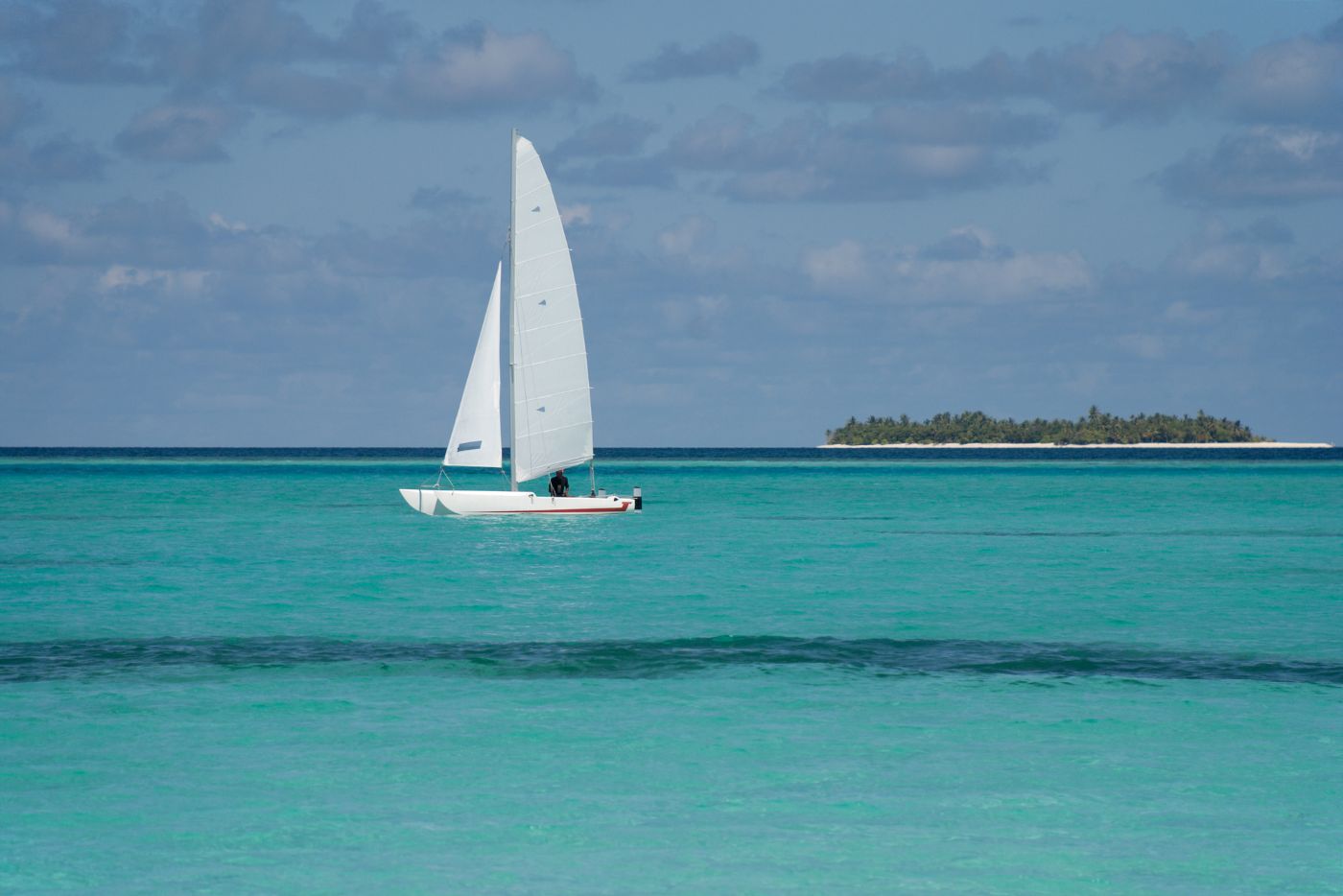
Imagine the jib as a genoa, but smaller, meaning it doesn't overlap the mast as genoa does. You will, of course, get less performance out of this setup, but the handling is easier, and since when tacking, the sail doesn't touch the mast, you can have a self-tacking system, a great thing for short-handed trips.
Speaking about performance, interestingly enough, it doesn't add as much in terms of propulsion as you would expect, but rather helps the airflow around the mainsail, helping it to function more effectively.
They are quite prevalent on modern holiday cruisers that prefer convenience and ease of use over the few knots of speed you would get from a large foresail.
You might come across the name 'windseeker', which is basically a very tall and very narrow jib, made from a light fabric - very useable in lighter winds since it can help you pick up speed even if the breeze isn't as strong.
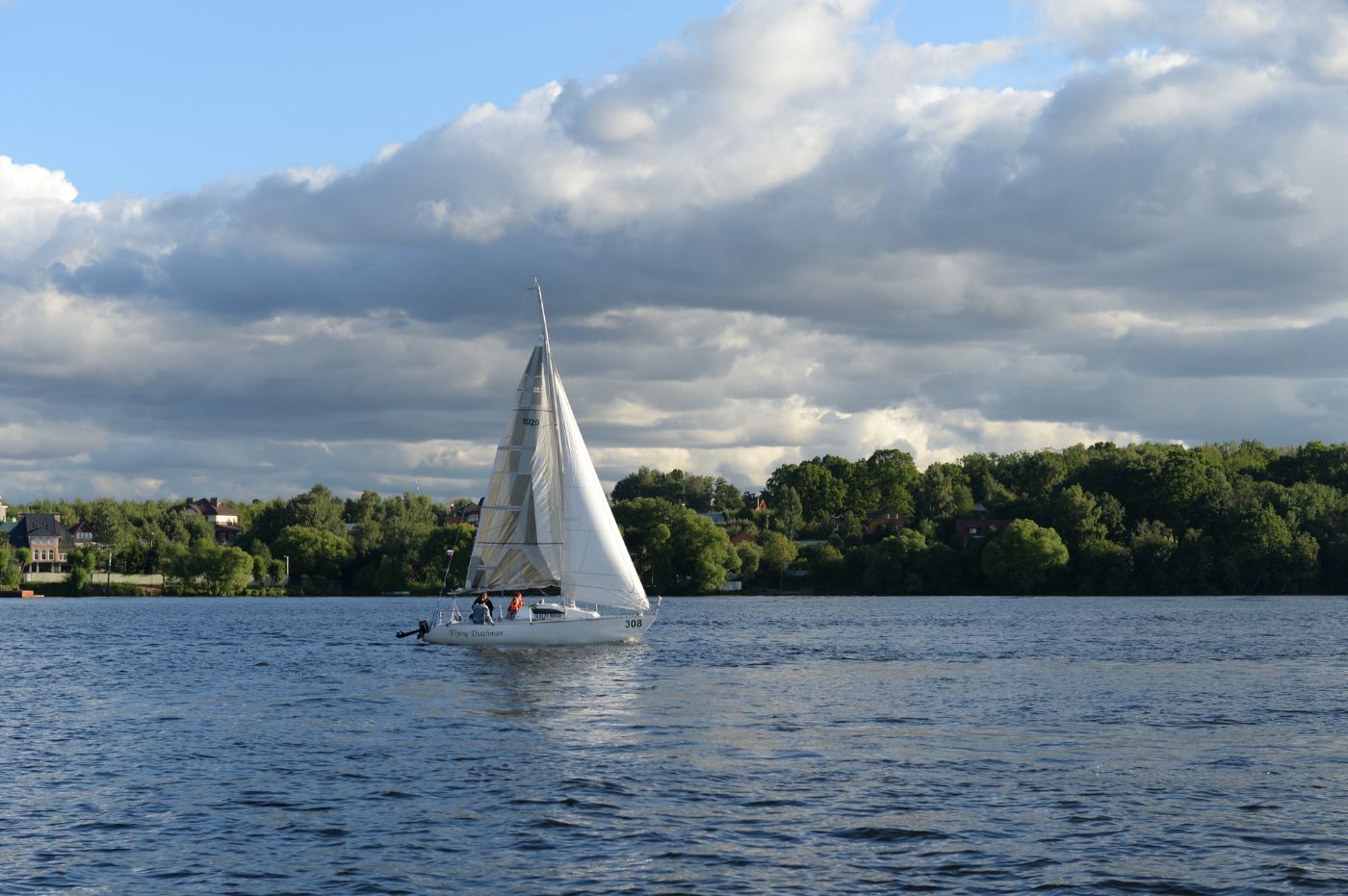
This one's a bit tricky - the term staysail refers to a bunch of different sails, usually such that complement the already existing system. This could, for instance, be a forestaysail, a smaller jib positioned closer to the mast, not as tall as the foresail.
Having two sails in the front like that gets you more speed and having one closer to the mast helps to maneuver it in heavy weather since you don't have to go as far.
That is convenient, especially in rougher seas, where the very front of the deck gets hit by waves often, and so having to go all the way there to tweak a sail can present challenges.
Also, just as was the case with the jib, staysails are sometimes used to help the airflow around the mainsail, rather than generate speed on their own.

Spinnakers are really pretty. They are humongous, parachute looking sheets used mostly for when the wind blows from generally the back. Their large area allows them to pick up a lot of wind, and so can add a lot to your speed, even in light winds.
There are symmetric spinnakers, that are, well, symmetrical in shape, used for the aforementioned back winds, and then there are asymmetrical ones, used more like a genoa, generating lift, for different wind angles.
And by the way, remember that rule saying you can't capsize a boat with sails only? Because the steeper the angle, the less the wind power and the boat will then correct itself?
Well, with spinnakers, forget that. If not manipulated with caution, they can have you go down quite easily. Use them with lighter winds.
Don't know how to use a spinnaker? Read our guide on how to set up and rig a spinnaker here.
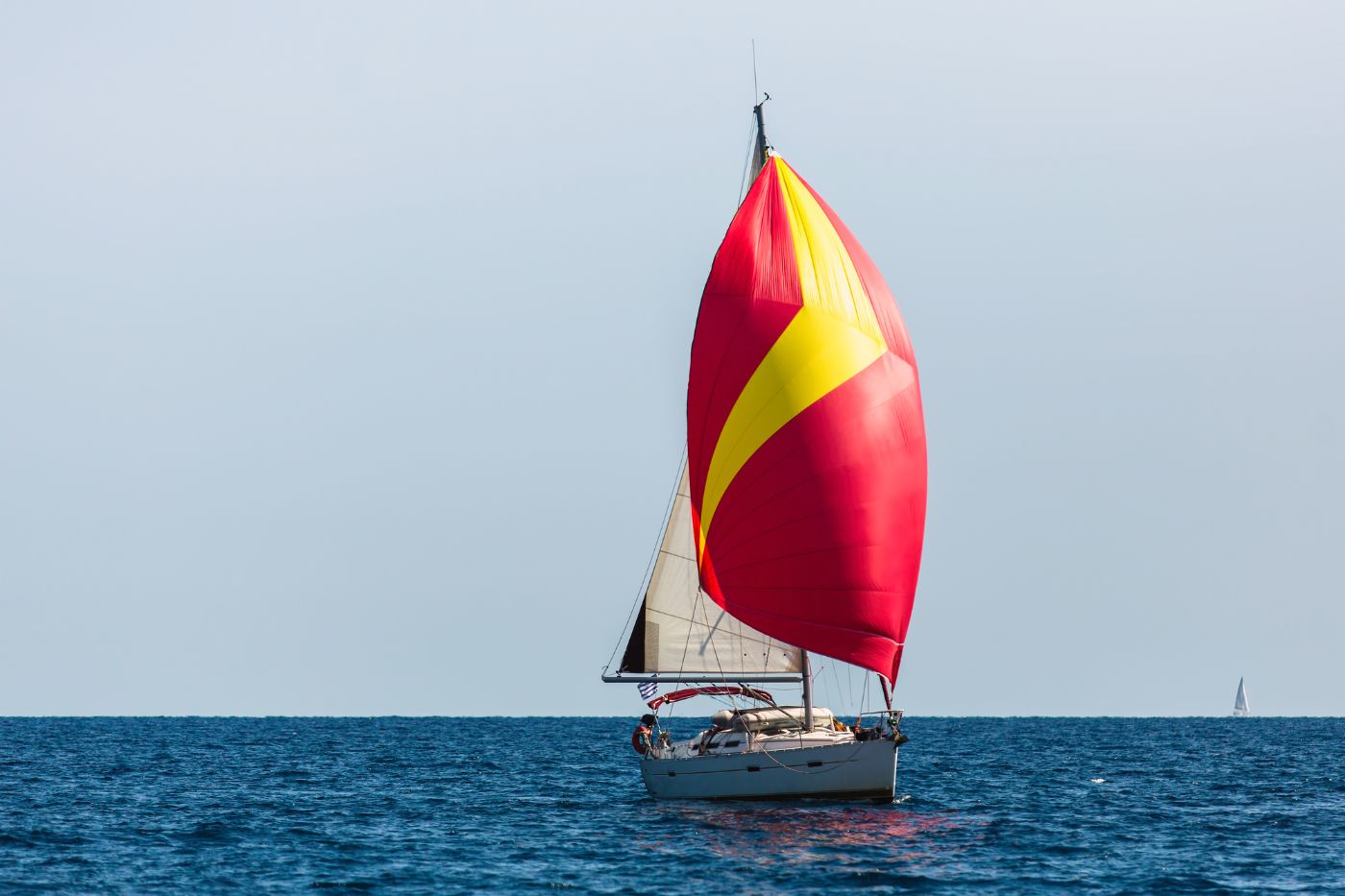
You might also come across its more badass name 'code zero', which is a sort of a mix between genoa and a spinnaker, used for close reaching. It's a relatively new invention, thought into existence in the 1990s.
Its asymmetric geometry makes it more immune to collapsing than a classical spinnaker, of course, for the price of less volume. You will find this one mostly on racers. For a cruiser, this would generally be an overkill.
Read more on the exact differences between the Gennaker and the Spinnaker here.
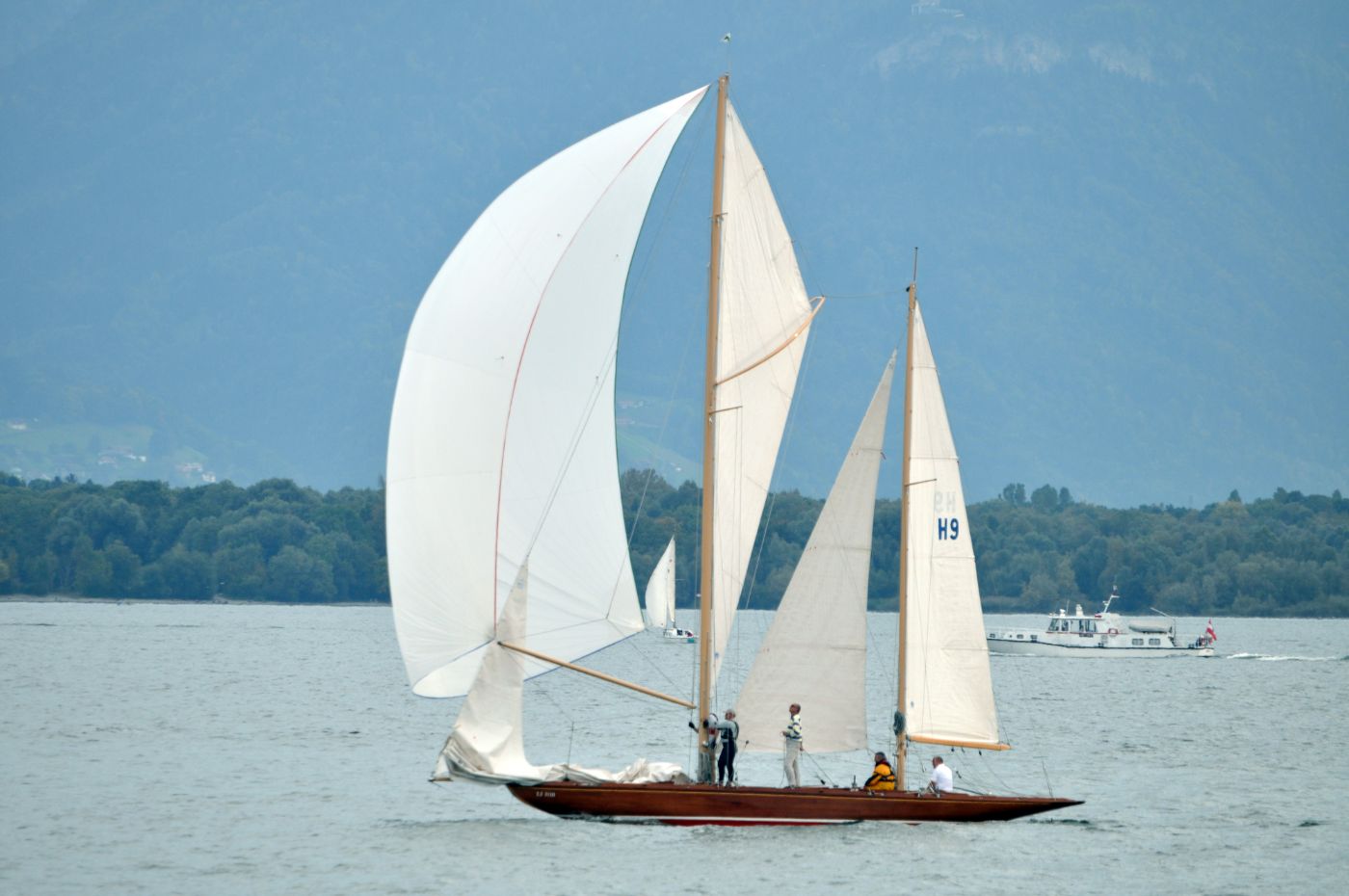
These aren't as common. The term doesn't refer to a specific shape or placement of a sail, but rather generally to smaller sails that are found at the boat's stern, behind the mainsail. So you won't find it on sloops (the most classical sailboat type), but you will on ketches (two-masted sailboats).
The reasons for its existence are multifold.
Firstly, it allows for a smaller headsail while keeping the overall sail area. The smaller headsail is easier to operate, so this is a matter of convenience.
Secondly, a sail in this position can serve as a sort of wind rudder, helping the boat keep its direction. Some people even keep them up when anchored, to make sure the boat keeps pointing in the same direction.
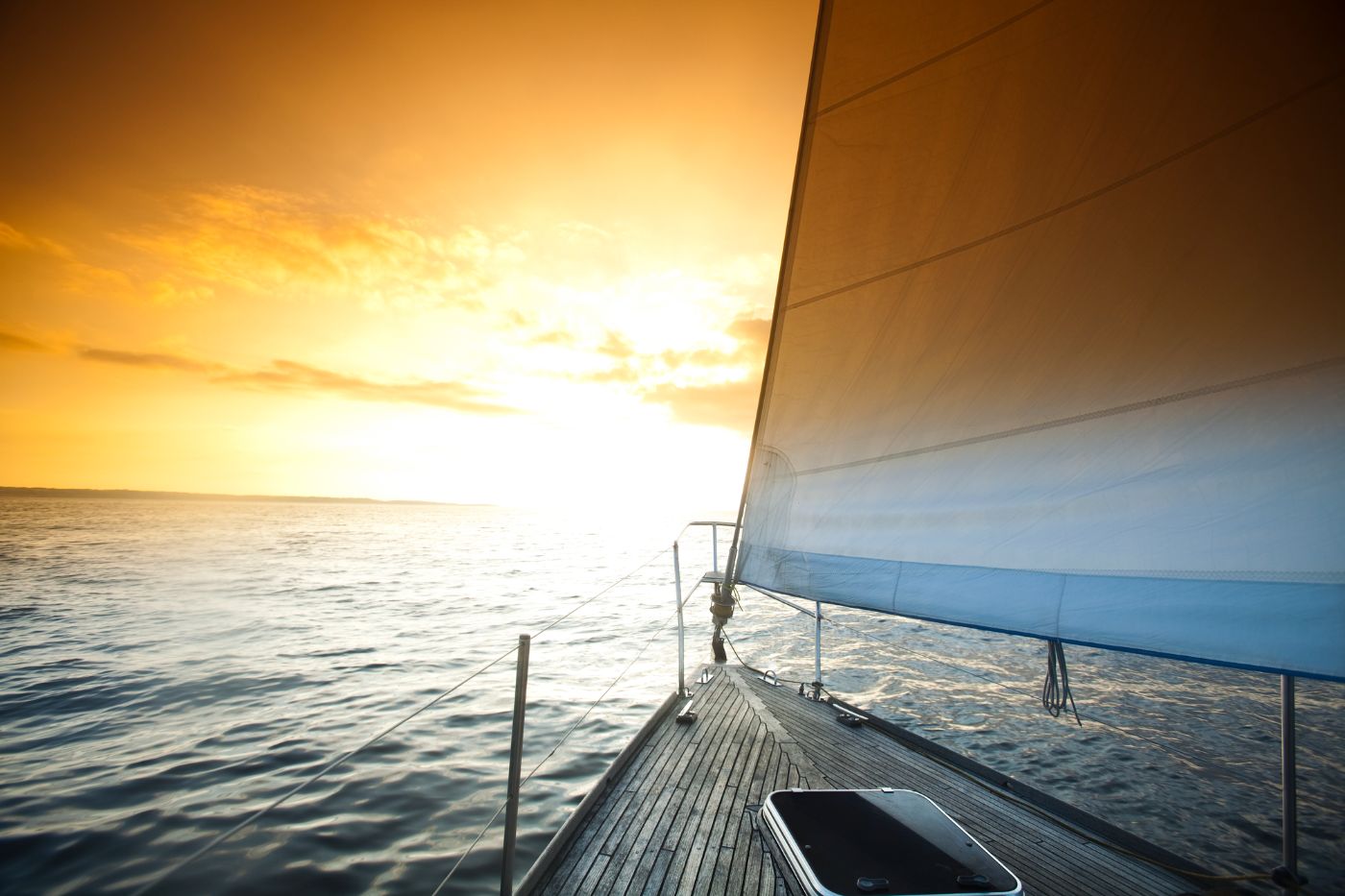
This is a weird one. Lugsails are sails that hang from a sort of a boom, called a 'yard'. Smart people thought of these as an upgrade from the classical traditional square sails - lugsails are easier to angle and thus perform better windward.
You remember those small fishing boats with a mast, boom up top, making it look like a cross and the sail being attached to it? That's the one I mean. These sails had their prime time around the eighteenth century (give or take one) and, fun fact, given their good performance, were popular among smugglers.
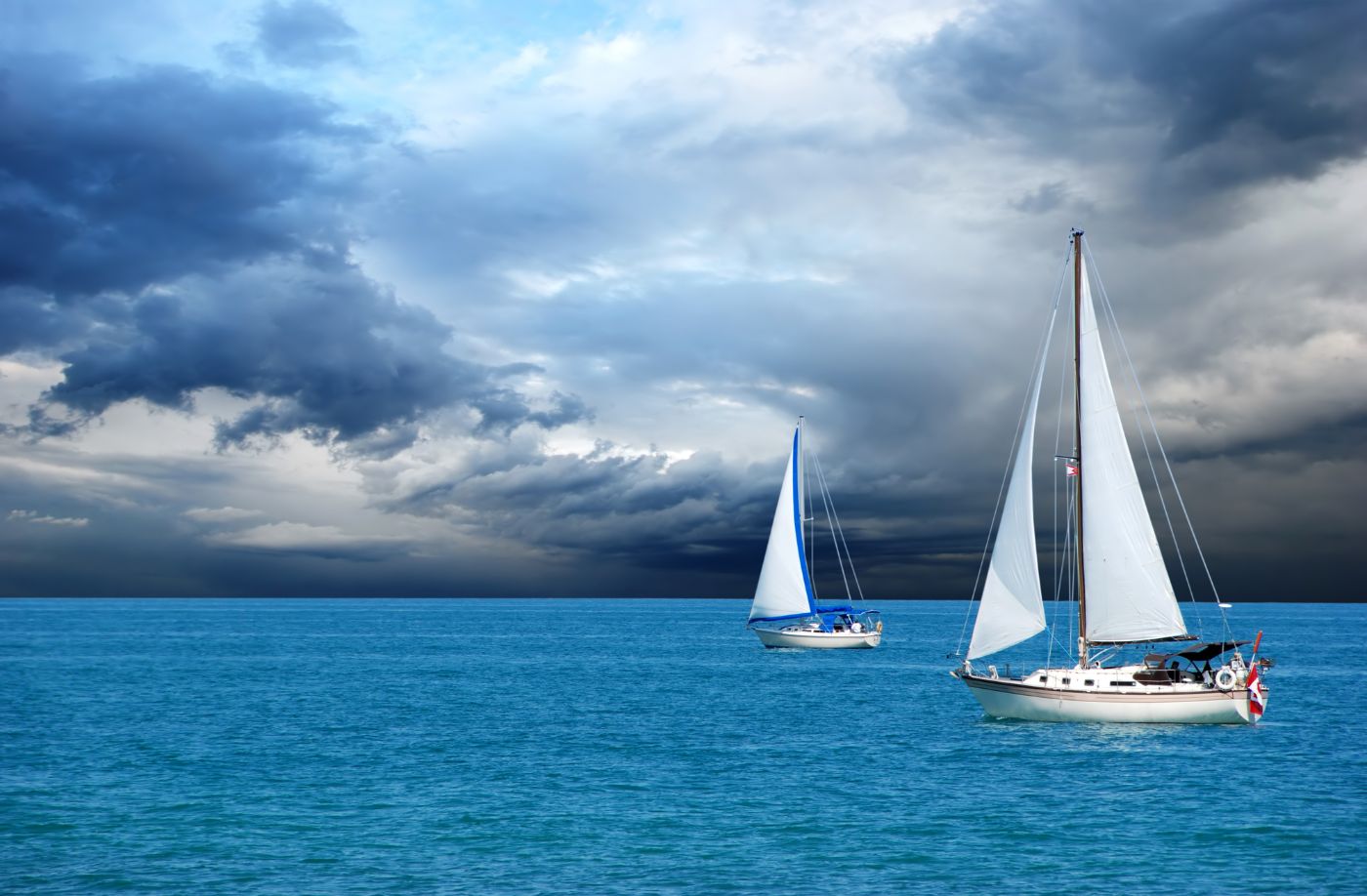
As the name suggests, these are used for storms. There is a storm jib (storm version of the front sail) and trysail (storm version of the mainsail). In essence, they look quite similar to your normal sails but are smaller. Way smaller. When in a storm, you want to keep the sail area quite tiny to cope with the strong winds.
Now, why not just reef your normal sails and keep on going, you might say? Well, you could. Up to some 30 knots, this would work. Not very well - there will be a lot of draft in the sail, and you will heel a lot - but it does the trick.
However, above 30 knots or so, you are risking damaging your sheets. Classical sails are made out of rather light fabrics that aren't likely to withstand a proper blow, unlike the tough storm sails.
They are also brightly colored so that you can see them better and are positioned higher, to keep away from the sea.
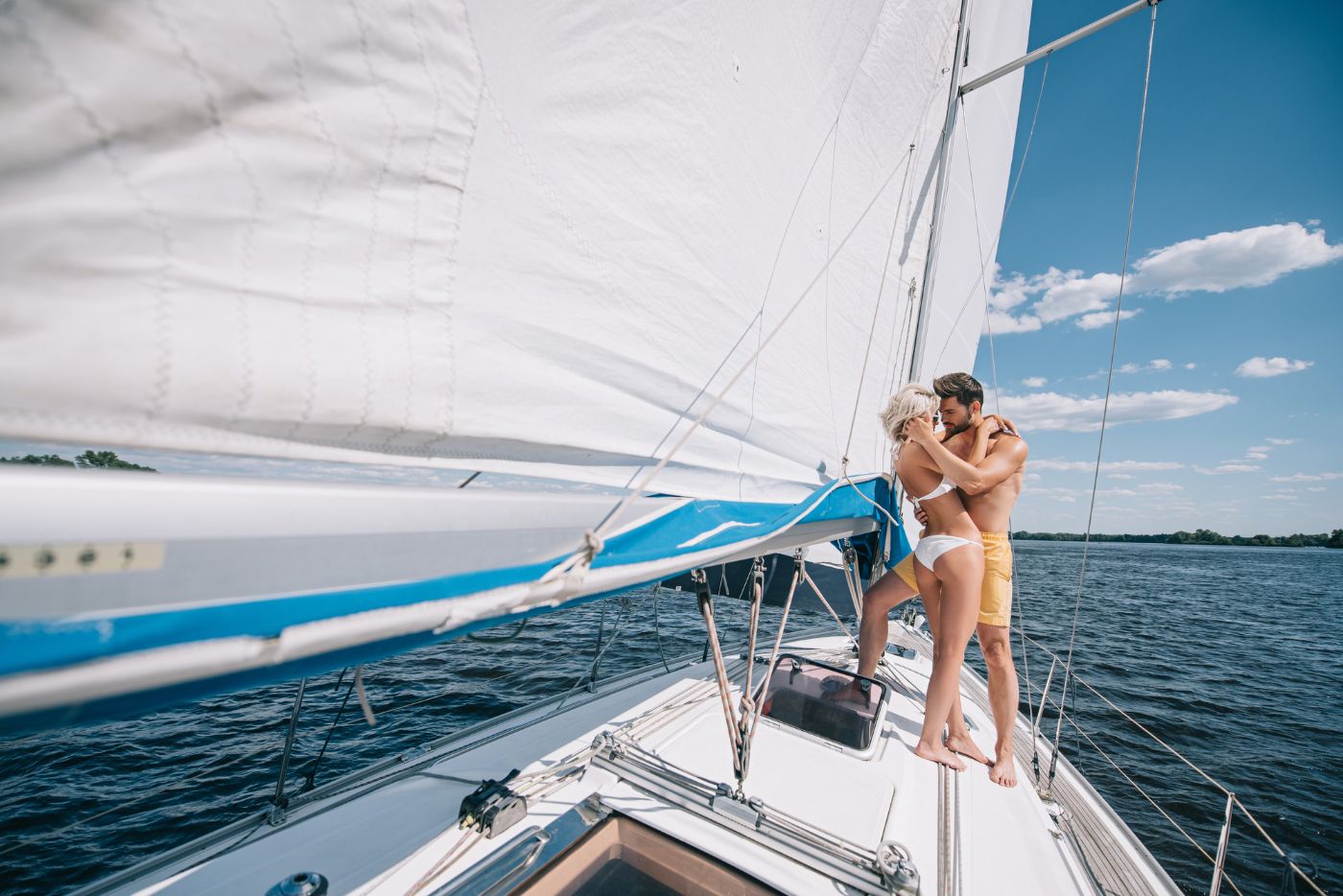
As old as the second century BC, spritsails are four-sided sheets that are supported by a diagonal boom of sorts, called sprit. Why this odd shape? For one, it is a great concept for cargo ships.
The sail's design doesn't obstruct whatever you have onboard, even if it is stacked quite high.
Spritsails are a feature of older, traditional boats, so you won't likely see them around these days much, except for some smaller dinghies, who may still use them.
They have been surpassed by more convenient designs. But if you do happen to stumble upon one, take it in, you are witnessing an important historical chapter.

Back to the Pirates of the Caribbean ships - the four following sails are those found on the old, classical ships. They are the four (although sometimes you see even six) square sails set above each other, getting progressively smaller, the higher you go.
Let's start with a topsail. It is, unlike what you would expect from the name, not the one on the top. Rather it is the second or the third one from the deck.
These once used to be the most important sails on a ship. This is because they were quite high above the deck, so the wind up there was likely to be more constant than below (especially with larger waves) and also because of their large size.
In fact, sometimes boats would just have the topsails opened, sailing with them alone.

Royals were usually set above the topsails. They were smaller and made for rather light winds. Because such a setup required a tall mast, you would find these on big ships. Not much more to say here.
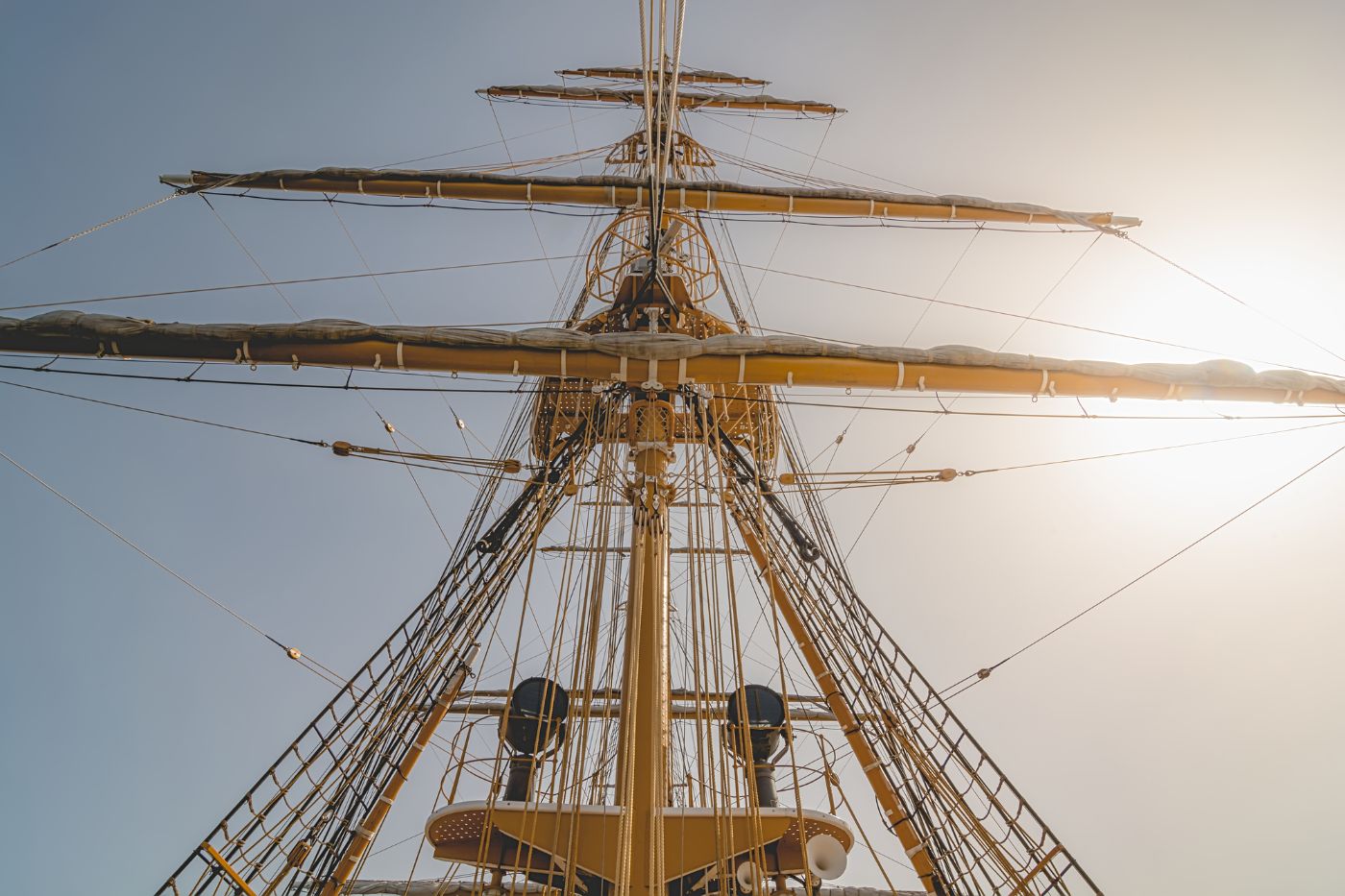
Again, a misleading name. You would expect it to be on top, but it usually sat right above the royal. And just as royal, it would be used in lighter winds.
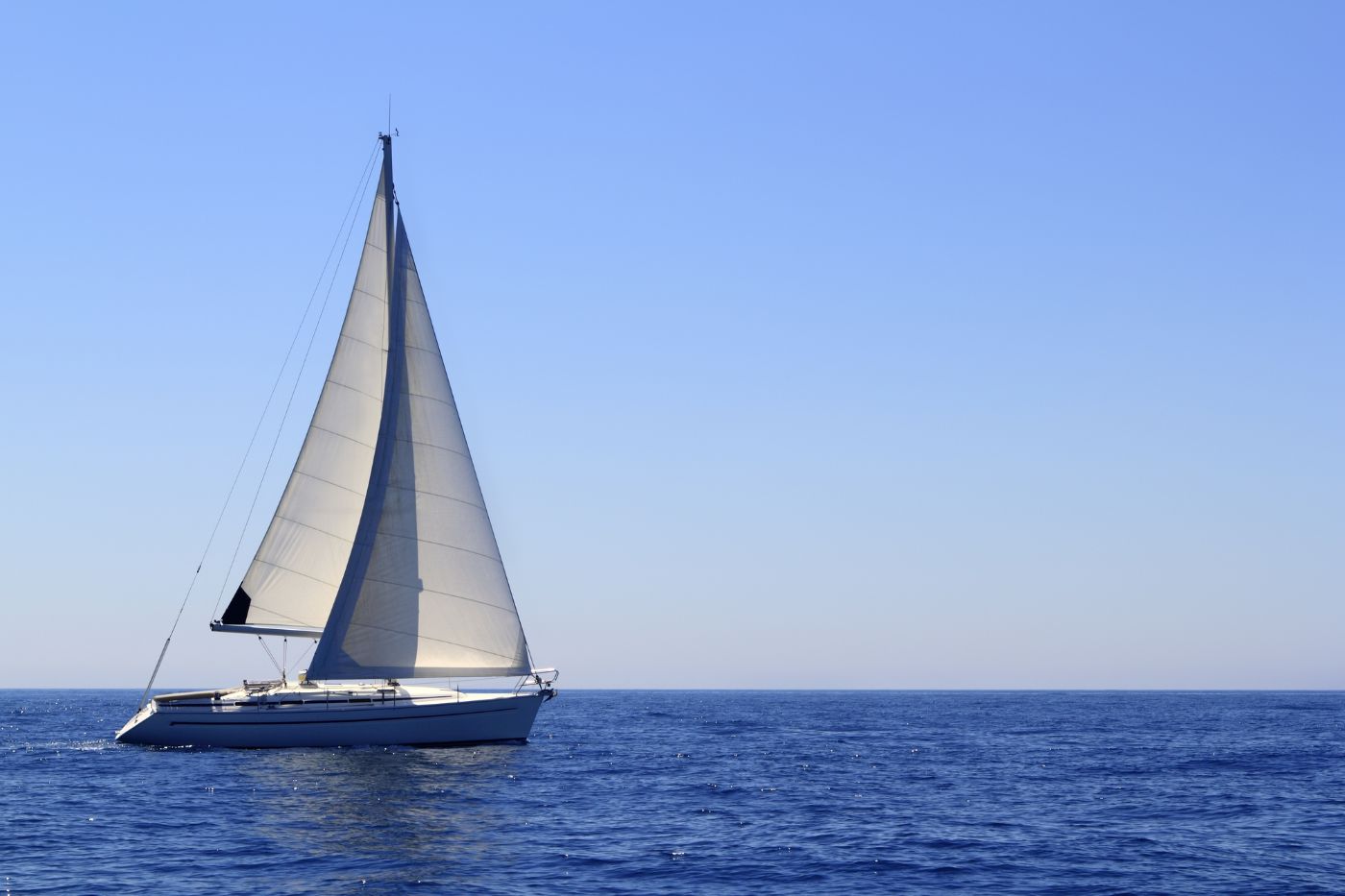
This is the top one. Moonraker was the smallest in size of the square sails and was sitting at the uppermost point of the mast. It was not that prevalent, since only boats designed for speed featured these. On rigs featuring triangular sails, it would be called a skyscraper.
So there you go. I hope I haven't confused your minds more than they were getting into this article. If you want me to make things easier for you, let me be honest - know that for most sailors, mainsail, genoa, and jib, with the occasional spinnaker, is all you need. I know, I know, many of you are now rolling their eyes - but let's be frank here - go into most marinas around the world, and these four are all you will see.
Fair winds!
Tom Schlosser
Well done, matey.
—Tom SCHLOSSER “All I need is a tall ship and a star to sail her by.” John Mansfield’s poem “ Sea Fever ”
Leave a comment

IMAGES
COMMENTS
Ever wondered what type of sailboat you're looking at? Identifying sailboats isn't hard, you just have to know what to look for. In this article, I'll help you.
List of sailing boat types. A Windmill sailing dinghy. The following is a partial list of sailboat types and sailing classes, including keelboats, dinghies, and multihull ( catamarans and trimarans ).
Distinguishing Types of Sailboats In this article, we'll distinguish sailboats by traits such as their hull type, rig, and general configuration. Some sailboats share multiple characteristics with other boats but fall into a completely different category.
The term sailboat includes many different sizes, shapes, and hull types. Here's how to identify most of the common ones.
This observation alone will enable you to identify the five main types of sailboats — sloops, cutters, ketches, yawls and schooners - all of which are described here. But apart from the various rig types, you can describe types of sailboats from a different viewpoint - sailing dinghies, dayboats, motorsailors, monohulls, catamarans and ...
Discover the different types of sails and rigs, how they work, and what they are used for. This guide includes pictures and examples of sailboats from around the world.
Types of Sailboats: Essential Guide for Every Sailor Sailboats have been an essential part of human history, contributing to exploration, trade, and leisure. With a myriad of designs and sizes, these versatile vessels cater to various purposes and preferences. The defining characteristics of sailboats come from their rigging, sails, and hull design.
Sailboats can be divided into three basic types based on their hulls (catamaran, monohull or multihull), their keel and their rigging, and then further subdivided from there. The result is that there are actually well over a dozen different kinds of sailboats out there. Sailboat Hull Types There are three…
Sailboats come in a vast variety of shapes and sizes and the uses for each different kind can be confusing. The word "sailboat" doesn't really describe a type of boat but rather the inclination to move with the power of the wind and experience a freedom that's not always present with other kinds of boating.
The hull is the body shape of the boat: the part that floats in or on top of the water surface and provides the boat's buoyancy. While most sailboats use the same hull design, there are many different types, all with different properties. The type of hull affects your boat's performance, handling, stability, and safety.
Throughout centuries, there have been many different types of sailing ships seen from harbors and coastlines around the world.
Discover cruising and racing sailboats, catamarans, trimarans, and more. Learn hull and rigging types, sail configurations, and unique features.
Small sailboats have different names, depending on the type of sailboat and the number of sail boat hulls. For example, the boat might be a monohull dinghy, small catboat, small catamaran, or daysailor.
Whether you're new to sailboats or already an American Sailing Association (ASA) certified skipper, knowing the difference between the different types of vessels is essential. We'll provide you with a basic understanding of the different types of sailboats, the advantages of each, and which type of voyage they're best used for.
The types of keels commonly associated with sailboats are as follows: full-length keel, fin keel, centreboard keel, bilge keel, bulb keel and wing keel. As the name suggests, full-length keels have keels that extend in the form of a long fin below the main structure of the ship.
List of boat types This is a list of boat types. For sailing ships, see: List of sailing boat types Contents A B C D E F G H I J K L M N O P Q R S T U V W X Y Z See ...
Embarking on the open waters is an exhilarating experience, and choosing the right sailboat can make all the difference. The world of sailboats is as vast as the oceans they navigate, offering a myriad of options tailored to various needs and preferences. From sleek racing yachts that cut through waves like arrows to comfortable cruisers… Read More »Types of Sailboats: Know By ...
The Ultimate Guide to Different Types of Boats - Top 20 As we all know, a boat is a type of watercraft that has been specifically designed for navigating near-shore areas or inland waterways such as rivers and lakes.
Looking for a used sailboat? Start with this list for the best sailboats that hold value. All summer readers cast votes for their favorites on CW's 40 greatest production monohulls of all time list, now you can see how the fleet stacks up.
Any boat propelled by the power of the wind acting on sails is a sailboat. Within that definition there can be different types of sailboats including schooners, cutters, sloops, ketches, catamarans and many others. These are historically some of the oldest boats in the world dating back thousands of years.
List of different boat types - All kinds of boat - Watercraft types - Boat types names. Choosing the right boat for the right purpose...
A small waterspout - a type of tornado - spun over the Mediterranean island early Monday, likely capsizing the sailing boat amid lashings of rain and strong thunderstorms.
Karsten Borner, the Dutch captain of the Sir Robert Baden Powell, a yacht that was anchored near the Bayesian, said by phone Wednesday that he saw a thunderstorm come in at around 4 a.m. local ...
The most common rig types on sailboats To give you an idea of the most-used sail rigs, I'll quickly summarize some sail plans below and mention the three things that make up their sail plan.
The Bayesian luxury yacht sank off of the coast of Sicily on Aug. 19, 2024, killing seven people — six passengers and one crew member. Here is everything we know about the victims' final moments.
One man has died and six people are missing after a luxury yacht sank in freak weather conditions off the coast of Sicily. The 56m British-flagged Bayesian was carrying 22 people - 12 passengers ...
A fire service boat with flashing blue lights returns with a blue body bag to the port of Porticello just after 8.45am local time on Thursday. Tributes pour in for Mr Lynch and Mr and Mrs Bloomer ...
Only dozens of cushions from the boat's deck and a gigantic radar from its mast floated on the surface of the sea, fishermen said. In all, 22 people were on board, 15 of whom were rescued.
So to help you navigate this world for which you often need a dictionary, here is one. These are sail names explained for beginners. Here are the 15 most common sails: Mainsail. Foresail. Genoa. Jib. Staysail. Spinnaker.
James Cutfield, 51, was the head of crew aboard the 56-meter (184-foot) sailing boat when it capsized in the throes of a ferocious storm last Monday, killing six passengers, including British ...